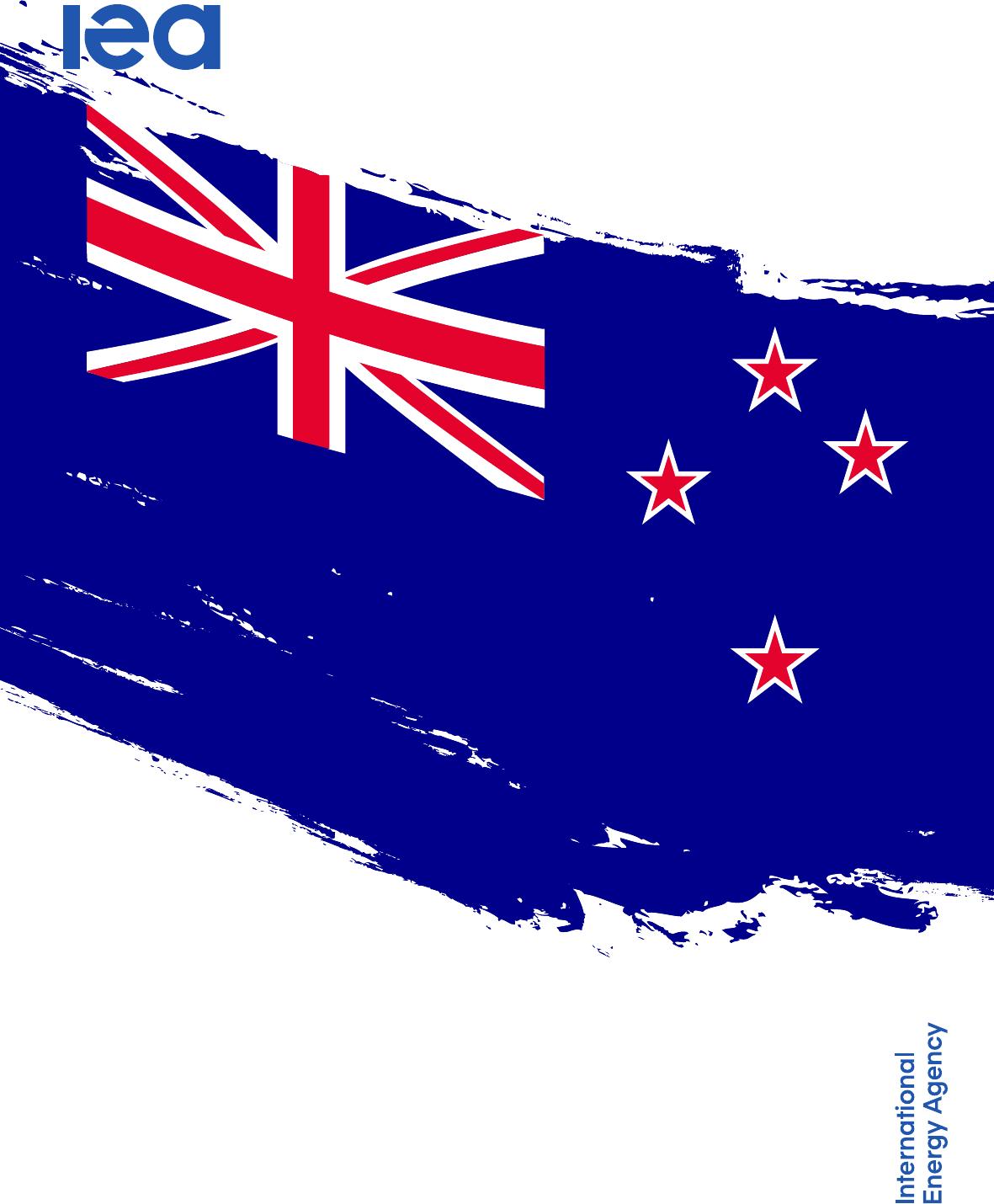EnergyPolicyReviewNewZealand2023TheIEAexaminesthefullspectrumofenergyissuesincludingoil,gasandcoalsupplyanddemand,renewableenergytechnologies,electricitymarkets,energyefficiency,accesstoenergy,demandsidemanagementandmuchmore.Throughitswork,theIEAadvocatespoliciesthatwillenhancethereliability,affordabilityandsustainabilityofenergyinits31membercountries,11associationcountriesandbeyond.Pleasenotethatthispublicationissubjecttospecificrestrictionsthatlimititsuseanddistribution.Thetermsandconditionsareavailableonlineatwww.iea.org/t&c/Thispublicationandanymapincludedhereinarewithoutprejudicetothestatusoforsovereigntyoveranyterritory,tothedelimitationofinternationalfrontiersandboundariesandtothenameofanyterritory,cityorarea.Source:IEA.Allrightsreserved.InternationalEnergyAgencyWebsite:www.iea.orgIEAmembercountries:AustraliaAustriaBelgiumCanadaCzechRepublicDenmarkEstoniaFinlandFranceGermanyGreeceHungaryIrelandItalyJapanKoreaLithuaniaLuxembourgMexicoNetherlandsNewZealandNorwayPolandPortugalSlovakRepublicSpainSwedenSwitzerlandRepublicofTürkiyeUnitedKingdomUnitedStatesTheEuropeanCommissionalsoparticipatesintheworkoftheIEAIEAassociationcountries:INTERNATIONALENERGYAGENCYArgentinaBrazilChinaEgyptIndiaIndonesiaMoroccoSingaporeSouthAfricaThailandUkraine3FOREWORDForewordThemissionoftheInternationalEnergyAgency(IEA)istoshapeasecureandsustainableenergyfutureforall.Weworkwithcountriesaroundtheworldonstrengtheningenergysecurityandreachingnetzeroemissions.Ourin-depthreviewsareanessentialIEAtoolforprovidinginsightandadvicetogovernmentsonhowtobestachievetheirenergyandclimategoals.UndertheleadershipofMinisterofEnergyandResourcesDrMeganWoods,NewZealandhasmadeconsiderableprogressinaddressingclimatechangeandhasincreaseditssupportforglobaleffortsoncleanenergytransitions.IamgratefultoDrWoodsforhermultilateralengagementthroughIEAwork,includingasamemberofourGlobalCommissionforUrgentActiononEnergyEfficiency.NewZealandhassetambitioustargetsforreducingdomesticgreenhousegasemissions,includingbringingthemdowntonetzeroby2050.NewZealandisstartingfromastrongpositionwithitslow-emissionselectricitysysteminwhichover80%ofelectricitycomesfromrenewablesources.ThetaskforNewZealandnowistoleverageitsrenewables-basedelectricitysystemtodecarboniseothersectors,notablytransportandindustry.Notonlywillthisrequiresizeableinvestmentsintechnology,butitwillalsoentailaconsiderablebuildoutofadditionalrenewablegenerationcapacity,alongwithnewinvestmentsingridsandstorage.Majorenergyefficiencyupgradeswillalsobeneededtodecarbonisethebuildingssector.NewZealandhasalreadymadeprogresstoenablethisenergysystemtransformation.Itsdomesticclimatelegislationrequiresthegovernmenttosetemissionsbudgetsunderpinnedbyemissionsreductionplansthatincludecomprehensivemeasuresacrossalleconomicsectors.Suchstrategicplanningforenergyandclimatepolicywillhelpprovidelong-terminvestmentsignalstotheenergysector.Thegovernmenthasalsocommittedtodevelopingalong-termenergystrategyby2024toestablishsectoralpathwaysforshiftingNewZealand’senergysystemawayfromfossilfuelstowardlow-emissionsalternatives.Therefore,themostpressingtaskistofinalisethesepolicydecisionsandproceedwithimplementation.NewZealand’senergytransitionofferslessonsforothercountriesfacingsimilarissues.Inparticular,theNZBatteryProjectwillprovideinsightintotheviabilityofalarge-scalepumpedhydrosolutiontobalanceapowergridbasedheavilyonrenewablesandledbyhydropower,whichisvulnerabletodryweatherchallenges.Government-backedeffortstodecarboniseheatforindustrialprocessescanalsohelpunlockimportantdecarbonisationsolutionsfortheworld.IhopethattherecommendationsproposedinthisreportwillhelpinformkeypoliciesinNewZealand,includingitsaspirationtoreach100%renewablesinelectricityandtheupcominglong-termEnergyStrategy.Dr.FatihBirolExecutiveDirectorInternationalEnergyAgencyIEA.CCBY4.0.5TABLEOFCONTENTSENERGYINSIGHTS1.Executivesummary.......................................................................................................9Overview..............................................................................................................................9Climatechangepolicies.....................................................................................................10Energystrategy.................................................................................................................10Electricityintheenergytransition......................................................................................11Phasingoutfossilfuels......................................................................................................12Keyrecommendations.......................................................................................................122.Generalenergypolicy.................................................................................................15Countryoverview...............................................................................................................15Energyproduction,supplyanddemand............................................................................16Keyinstitutionsandenergyplayers..................................................................................19Keyenergyandclimatepolicies........................................................................................19Assessment.......................................................................................................................27Keyrecommendations.......................................................................................................30ENERGYSYSTEMTRANSFORMATION3.Energyandclimatechange........................................................................................33Overview............................................................................................................................33Energy-relatedgreenhousegasemissions.......................................................................34Emissiondriversandcarbonintensity...............................................................................35Emissionstargetsandpolicies..........................................................................................36Assessment.......................................................................................................................44Recommendations.............................................................................................................484.Energyefficiency.........................................................................................................51Overview............................................................................................................................51Industry..............................................................................................................................53Buildings............................................................................................................................55Transport...........................................................................................................................58Assessment.......................................................................................................................62Recommendations.............................................................................................................665.Renewableenergy.......................................................................................................69Overview............................................................................................................................69Renewableelectricitygeneration......................................................................................70IEA.CCBY4.0.TABLEOFCONTENTS6Renewableenergypolicies...............................................................................................71Assessment.......................................................................................................................78Recommendations.............................................................................................................836.Energyresearch,developmentandinnovation.......................................................85Overview............................................................................................................................85Keyactorsintheenergyinnovationecosystem................................................................86Energyinnovationprioritiesandguidingdocuments........................................................86Resourcepush..................................................................................................................88Monitoring,evaluationandtrackingofresults...................................................................91Knowledgemanagement...................................................................................................92Assessment.......................................................................................................................93Recommendations.............................................................................................................94ENERGYSECURITY7.Electricity......................................................................................................................97Overview............................................................................................................................97Electricitygeneration.........................................................................................................98Electricitygenerationcapacity...........................................................................................98Electricitytrade..................................................................................................................99Electricitydemand.............................................................................................................99Electricitymarketstructureandoperation......................................................................100Electricitypolicy..............................................................................................................107Electricityretailpricesandtaxes....................................................................................112Electricitysecurity...........................................................................................................114Assessment....................................................................................................................116Recommendations..........................................................................................................1218.Coal............................................................................................................................123Overview.........................................................................................................................123Coalsupplyanddemand................................................................................................124Coalpolicy......................................................................................................................125Assessment....................................................................................................................127Recommendations..........................................................................................................1289.Naturalgas................................................................................................................129Overview.........................................................................................................................129Naturalgassupplyanddemand.....................................................................................130Naturalgasindustrystructure........................................................................................131IEA.CCBY4.0.TABLEOFCONTENTS7TABLEOFCONTENTSNaturalgasregulationandpolicy...................................................................................133Naturalgasinfrastructure...............................................................................................134Storage...........................................................................................................................137Gasemergencypolicy....................................................................................................137Assessment....................................................................................................................139Recommendations..........................................................................................................14110.Oil.............................................................................................................................143Overview.........................................................................................................................143Oilsupplyanddemand...................................................................................................144Oilpolicyandinstitutions................................................................................................147Marketstructure..............................................................................................................148Oilinfrastructure.............................................................................................................151Oilemergencypolicyandstockholding..........................................................................152Emergencyoilreserves..................................................................................................154Assessment....................................................................................................................154Recommendations..........................................................................................................156ANNEXESANNEXA:Reviewteamandsupportingstakeholders............................................157ANNEXB:Energybalancesandkeystatisticaldata...............................................160ANNEXC:Glossaryandlistofabbreviations...........................................................164LISTOFFIGURES,TABLESANDBOXESFiguresFigure2.1OverviewofNewZealand’senergyproduction,supplyanddemand,2021.16Figure2.2TotalenergysupplybysourceinNewZealand,2005-2021.........................17Figure2.3TotalfinalconsumptionbysourceinNewZealand,2005-2021...................18Figure2.4Energydemandpersectorandperfuel,andelectricitygenerationbyfuelinNewZealand,2021........................................................................................18Figure2.5QuarterlyenergypricesinNewZealand,June2013toMarch2022............24Figure3.1GreenhousegasemissionsbysectorinNewZealand,1990-2020andtargets.......................................................................................................................34Figure3.2Energy-relatedgreenhousegasemissionsbysectorinNewZealand,2005-2021...............................................................................................................35Figure3.3Energy-relatedgreenhousegasemissionsbyenergysourceinNewZealand,2005-2021......................................................................................................35Figure3.4Energy-relatedgreenhousegasemissionsandmaindriversinNewZealand,2005-2021......................................................................................................36IEA.CCBY4.0.TABLEOFCONTENTS8Figure4.1EnergydemandanddriversinNewZealand,2005-2021.............................51Figure4.2TotalfinalconsumptionbysectorinNewZealand,2005-2021......................52Figure4.3TotalfinalconsumptioninindustrybysourceinNewZealand,2005-2021.53Figure4.4TotalfinalconsumptioninthebuildingssectorbysourceinNewZealand,2005-2021......................................................................................................55Figure4.5TotalfinalconsumptionintransportbyenergysourceinNewZealand,2005-2021...............................................................................................................59Figure4.6RegisteredelectricvehiclesandpublicchargingpointsinNewZealand,2012-2022...............................................................................................................59Figure5.1RenewableenergyintotalfinalconsumptioninNewZealand,2005-2021..69Figure5.2RenewableenergybysectorinNewZealand,2021.....................................70Figure5.3RenewableenergyinelectricitygenerationinNewZealand,2005-2021.....71Figure6.1Energy-relatedpublicRD&IbudgetbysectorinNewZealand,2010-2020.88Figure6.2Energy-relatedpublicRD&IspendingperGDPinIEAcountries,2020.......89Figure6.3Averagenumberofpatentsinenvironment-relatedtechnologypercapitainIEAcountries,2010-2019..............................................................................91Figure7.1ElectricitygenerationbysourceinNewZealand,2005-2021.......................98Figure7.2ElectricitydemandbysectorinNewZealand,2005-2021............................99Figure7.3ElectricityinfrastructureinNewZealand....................................................105Figure7.4ElectricitypricesforindustryandhouseholdsinIEAcountries,2021........112Figure7.5ResidentialelectricitypricesbycomponentinNewZealand,June2013toJune2022...................................................................................................113Figure8.1ShareofcoalindifferentenergyflowsinNewZealand,2005-2021..........123Figure8.2CoalsupplybysourceinNewZealand,2005-2021...................................124Figure8.3CoaldemandbysectorinNewZealand,2005-2021.................................125Figure9.1SharesofnaturalgasinNewZealand’senergysystem,2000-2021.........130Figure9.2NaturalgasdemandbysectorinNewZealand,2005-2021......................131Figure9.3UpstreamgasproductioninNewZealand.................................................135Figure9.4NaturalgastransmissioninfrastructureinNewZealand............................136Figure10.1SharesofoilinNewZealand’senergysector,2005-2021.........................144Figure10.2OilproductsdemandbysectorinNewZealand,2005-2021.....................145Figure10.3OilproductsproductioninNewZealand,2005-2021.................................145Figure10.4NewZealand’snetimportsofoilproductsbycountry,2005-2021............146Figure10.5OilpricecomparisonsintheIEA,4Q2022.................................................150Figure10.6NewZealand’soilstoragelocations,2022.................................................152Figure10.7EmergencyoilstocksbytypeinNewZealand,January2018-November2022........................................................................................................................................154TablesTable3.1NewZealand’semissionsbudgets................................................................39IEA.CCBY4.0.9ENERGYINSIGHTS1.ExecutivesummaryOverviewNewZealandhasadiversifiedenergymix,withsignificantproductionofbothhydropowerandgeothermal.Asthecountryembarksonanambitiousenergytransition,ithasmanynaturaladvantages,includinganenviablerenewableresourcebase.Thekeychallengewillbetodecarboniseend-usesectorsthroughcleanpowerandsupportinvestmentsinnewtechnologiestoachievedeeperemissionscutsacrossallsectorsinthemosteconomicallyefficientway.NewZealandhassetambitioustargetsforreducinggreenhousegas(GHG)emissions,includingachievingnetzeroemissionsby2050.NewZealandalreadyhasalow-emissionselectricitysystem,withover80%ofelectricitycomingfromrenewablesourcesin2021.Andthissharecouldeasilyreachover90%basedonexistingpolicies.Elsewhere,thecountryhasmoreworktodotodecarboniseeconomicsectorsbeyondelectricity.Notably,thetransportsectoraccountsforthehighestshareofemissionsandisalmostentirelydependentonoilasafuelsource.IndustryisalsoamajorcontributortoNewZealand’sGHGemissionsandisheavilyreliantonfossilfuels.NewZealandhasanattractiveopportunitytoleverageitscleanelectricitysectortoadvanceelectrificationasadecarbonisationstrategyinothersectors.Thiswillrequirenotonlysizeabletechnologicalinvestmentstosupportelectrificationintransportandindustrybutwillalsonecessitateasizeablebuildoutofadditionalrenewablesgenerationcapacitytomeetacceleratedloadgrowth,alongwithadditionalgridandstorageinvestments.NewZealandshouldweighitsaspirationtoachieve100%renewableelectricityby2030againstthepotentiallyconsiderablecostsassociatedwithachievingthelast2-5%ofthetarget.NewZealanddoesnotyethavealong-termenergystrategyinplace.Whileworkisunderwayonastrategy,itisnotdueforreleaseuntiltheendof2024.Alackofclaritysurroundingthepathwaystomeetingambitiousclimatetargets(includingtherolesthatvariousfuelsandtechnologieswillplay)createsanuncertainpolicyenvironment,hamperingthesignificantinvestmentrequiredtomeetthegovernment’s2030targets.Overall,NewZealandhasthepotentialtoreachitsemissionsreductionandenergytargetsbasedonitsnaturalresourcesandpolicylevers.Butthetimeframestomeetthetargetsareveryambitious.Ifthetargetsaretobemet,theenergysectorwillneedaviablepolicyroadmapassoonaspossible.Delaysinprovidingpolicyclaritywilllikelyresultinthetargetsbeingmetmuchfurtherintothefuture.IEA.CCBY4.0.1.EXECUTIVESUMMARY10ClimatechangepoliciesNewZealand’supdatedclimatetargetundertheParisAgreementistoreducenetGHGemissionsby50%fromgross2005levelsby2030.ThemostrecentdomesticlegislationistheClimateChangeResponse(ZeroCarbon)AmendmentAct2019,whichsetsanetzeroGHGemissionstarget(exemptingbiogenicmethane,mostlyfromcattle)by2050.Italsoincludesatargettoreducebiogenicmethaneemissionsby10%from2017levelsby2030andby25-47%by2050.TheActalsoestablishedaClimateChangeCommissiontoprovideindependent,evidence-basedadviceontheactionsthegovernmentneedstotaketoaddressclimatechange.Inaddition,theActrequiresemissionsbudgetsandemissionsreductionplans(alongwithnationaladaptationplans).NewZealand’semissionsbudgetscover5-yearperiodsandareset10-15yearsinadvance,afterconsideringtherecommendationsoftheClimateChangeCommission.ThefirstthreeemissionsbudgetsweresetinMay2022fortheperiods2022-2025,2026-2030and2031-2035.Eachemissionsbudgetmustbesupportedbyanemissionsreductionplan(ERP)thatcontainspoliciesandstrategiesformeetingtheemissionsbudget.NewZealand’sfirstERPwaspublishedinMay2022.Thecountry’sprimaryemissionspricingtoolistheNewZealandEmissionsTradingScheme(NZETS).Thepointofobligationisupstream,sotheimpactismainlyfeltthroughfuelprices.ThegovernmentwillaligntheNZETScapwithdecreasingemissionsbudgets.TheNZETShascomprehensivecoverageacrosstheentireeconomy,exceptfortheagriculturalsectorandaportionofthewastesector.Toaddresscarbonleakage,freeallocationofallowancesisprovidedtoeligibleindustriesthatareemissions-intensiveandtrade-exposed.Theseallocationsareplannedtobephasedoutinthecomingdecades.EnergystrategyNewZealanddoesnothavealong-termenergystrategy.InitsMay2022ERP,thegovernmentcommittedtodevelopingsuchastrategytoachieveitsvisionfortheenergyandindustrysectors.TheenergystrategywilldriveNewZealand’spathwaysawayfromfossilfuelsandtowardsgreaterlevelsofrenewableelectricityandotherlow-emissionsalternatives.AscopingofwhatthenewEnergyStrategycouldlooklikeisunderway.ThegovernmentisworkingwithenergysystemstakeholderstodeveloptheEnergyStrategybytheendof2024.Simultaneously,thegovernmentisdevelopingseveralsectoralstrategiesthatwillserveaskeyinputstothelong-termEnergyStrategy.Theseinclude:aGasTransitionPlan(GTP),expectedtobecompletedbytheendof2023,whichwillestablishthepathwayforphasingoutnaturalgasinNewZealand’senergysysteminlinewithclimatetargets;anupdatedNewZealandEnergyEfficiencyandConservationStrategytoreplacetheexistingstrategy(thatexpiredinmid-2022)andbetteralignwiththegovernment’sclimategoals;andarenewableenergyworkprogramme,whichwillestablishplansforexpandingtheroleofrenewablesinNewZealand’senergysystem.IEA.CCBY4.0.1.EXECUTIVESUMMARY11ENERGYINSIGHTSElectricityintheenergytransitionNewZealand’selectricitysystemisthecornerstoneofthegovernment’sstrategyfordecarbonisingtheenergysector.Thegovernmentplanstopromotetheelectrificationofend-usesectorssuchasbuildings,transportandindustry,leveragingarenewables-basedelectricitysystem.TheNewZealandEnergyStrategy2011-2021setatargetfor90%renewableelectricityby2025.Subsequently,thegovernmentsetanaspirationalgoalof100%renewableelectricityby2030.Moreover,thefirstERPbuiltonthegovernment’saspirationalgoalinelectricityandsetatargetof50%oftotalfinalenergyconsumptionfromrenewablesby2035.Makingtheelectricitysystemfit-for-purposeisatoppriorityforthegovernment.NewZealandisfortunatetoalreadyhaveahighproportionofrenewableelectricity,whichiscurrentlyover80%ofelectricityproduction.However,duetotheelectricitysystem'sheavyrelianceonhydropower,itskeychallengeiscopingwitha“dryyear”,whenhydroinflowsarelow.Whena“dryyear”occurs,andexistinghydropowercatchmentsdonotreceiveenoughrainfall,backupiscurrentlyprovidedbyfossilfuelgeneration.Thisissuewillbecomeincreasinglysalientasthecountrystrivestoachievea100%renewables-basedpowergridandreliesmoreonelectricitytomeetitsdecarbonisationtargets.Inresponse,thegovernmentlaunchedtheNZBatteryProjectin2020.Theprojectwillprovidecomprehensiveadviceonthetechnical,environmentalandcommercialfeasibilityofpotentialenergystorageprojects,including,butnotlimitedto,theLakeOnslowpumpedhydroproject.Feasibilitystudiesfortheprojectareexpectedtobecompletedearlyin2023andsolutionstobeinplaceinthe2030s.Reachingtheaspirational100%targetforrenewablesinelectricityby2030andthe50%economy-widerenewablestargetby2035willrequireamassivebuildoutofnewrenewablesgenerationcapacity.Givenlimitedoptionsforlargenewhydrocapacityandmodestvolumesofeconomicallyfeasiblegeothermal,asizeableshareoftherequirednewcapacitywillneedtocomefromwindandsolar.InNewZealand,theResourceManagementAct1991(RMA)playsamajorroleindeterminingthetypeofelectricitygenerationthatgetsconsented.WhiletheRMAsetsnationaldirectiononavoiding,remedyingandmitigatingtheadverseeffectsofactivitiesontheenvironment,itallowscommunitiestodecidehowtomanagetheirownenvironmentthroughregionalanddistrictresourcemanagementplans.ThegovernmentplanstorepealtheRMAandreplaceitwiththreenewpiecesoflegislation.Theobjectivesofthisreformaretobettermeetenvironmentalprotections,climateadaptationneedsandMāoriprotectionswhilealsoimprovingtheefficiencyofsitingandreducingpermittingcomplexity.Followingpublicconsultations,theaimisforthemainreformstobepassedintolawbeforethe2023centralgovernmentelection.Thereisconsiderablepotentialinotherareasofrenewablesdevelopment,likeoffshorewindelectricitygeneration.Thereiscurrentlynotargetedregulatoryframeworkforoffshorewind,andthecountrydoesnotyethaveanyoffshorewindsitesordevelopments.However,aspecificoffshoreenergyregulatoryregimeisunderdevelopmentandisexpectedtobeinplaceby2024.Offshoreenergydevelopmentwillbeconsideredaspartofthe2022-2024processofcreatingalong-termEnergyStrategy.IEA.CCBY4.0.1.EXECUTIVESUMMARY12PhasingoutfossilfuelsAsasteptowardsaddressingclimatechangeandcreatingasustainablefutureforNewZealand,inApril2018,thegovernmentannouncedthatnoadditionaloffshoreoilandgasexplorationpermitswouldbegranted.NewZealand’smoreambitiousclimatetargetswillrequireloweremissionsfromfossilfuelsdrivenbysubstantialdeclinesinconsumption.Emissionsreductionsarelikelytooccurthroughbothreduceddemand(forexample,greaterenergyefficiencyandelectrification)andlowercarbonintensity(forexample,blendinginrenewablegasesorbiofuels).AmajorpartofthisstrategywillbeenactedthroughtheGovernmentInvestmentinDecarbonisingIndustry(GIDI)Fund,whichwasestablishedin2020aspartofthegovernment’sCovidResponseandRecoveryFund.TheaimwastoacceleratethedecarbonisationofindustrialprocessheatandcontributetotheCovid-19recoverybystimulatingthedomesticeconomyandsupportingemployment.InadditiontothepreviousGIDIFundtargetedatindustrialprocessheatprojects,fundingwillnowalsoincludesupportforreplacinginefficientindustrialandcommercialequipmentandhelpreplacefossilfuelsincommercialspaceandwaterheatingwithrenewableenergy.Thegovernmentisespeciallyworkingtoreducethedemandforcoalforprocessheatandelectricitygeneration.InadditiontoGIDI-backedprojects,thisincludesinvestigatingoptionstomanagethedry-yearriskthroughtheNewZealandBatteryProject(todisplacebackupfossilgeneration),aproposedbanonnewlow-andmedium-temperaturecoalboilers,aswellasphasingoutallexistingcoalboilersby2037.Currently,naturalgasplaysanimportantroleintheelectricitysectoralongsidecoal-firedgenerationinfirmingorbackinguphydroandvariablerenewablegeneration.Thepaceforphasingoutnaturalgasandthe“end-state”oftheelectricitysectoriscurrentlyuncertain.Theyaredependentonarangeoffactors,suchasemissionspricing,technologicaladaptationandothereconomicfactors.TheGTPwillhelptoestablishtransitionpathwaysfordecarbonisingthegassectorinlinewiththefirstthreeemissionsbudgetsdefinedintheERP.Toaddressoildemand,NewZealandalsohasanumberofpoliciestoincreasevehicleefficiencyandpromotethepenetrationofelectricvehicles(EVs)intoitstransportmix.KeyrecommendationsThegovernmentofNewZealandshould:Acceleratethedevelopmentofthelong-termEnergyStrategyandrelatedsectoralstrategiestoclarifythemacrolevelpolicysettingsandencouragenecessaryinvestmentsassoonaspossible.Assesstherelativecostofabatementacrossenergyend-usesectorswhendevelopingthelong-termEnergyStrategy,prioritisingoverallabatementoverthefulldecarbonisationofanyparticularsector.IEA.CCBY4.0.1.EXECUTIVESUMMARY13ENERGYINSIGHTSMovequicklytoclarifyregulatoryregimesforrenewablesgeneration,suchastheResourceManagementActandanoffshorewindframework,tojump-startinvestmentsinadditionalrenewablescapacity.Increasepolicyfocusonthetransportsector,especiallymeasuresthatwilldeliverstructuralchangetodieseldemand.IEA.CCBY4.0.15ENERGYINSIGHTS2.GeneralenergypolicyKeydata(2021)Totalenergysupply(TES):829.3PJ,+11%since2011TESbysource:oil34%,geothermal25%,naturalgas17%,hydro11%,coal7.6%,bioenergyandwaste4.9%,solarandwind1.4%Energyintensitypercapita(TES/capita):161.8GJ/capita(IEAaverage:166.7GJ/capita);-5%since2010EnergyintensityperGDP(TES/GDP):4.11MJper2015USDPPP(IEAaverage:3.74MJperUSD);-17%changesince2011Totalfinalconsumption(TFC):559.8PJ;+7%since2011TFCbysector:industry42%,transport36%,buildings22%Source:IEA(2022).CountryoverviewNewZealand(AotearoainMāori)islocatedinthesouth-westernPacificOcean,around2000kilometres(km)eastofAustralia.Itsterritoryexpandsover268021km²andiscomposedoftwomainislands,theNorthIslandandtheSouthIsland,whichareseparatedbytheCookStrait,aswellasothersmallislands.NewZealandislocatedontheRingofFireandiscrossedbytheAlpinefault,whichmakestheislandsvulnerabletoearthquakesandvolcanicactivity.Thecountry’sremotenessexplainsthehighnumberofendemicfaunaandfloraspecies.NewZealand’sExclusiveEconomicZone,15timesitslandarea,isoneofthelargestintheworld.NewZealand’spopulationwas5.1millionin2022,16%higherthanin2012(StatsNZ,2022).Annualpopulationgrowthhasbeensteady,ataround2%since2014,butdroppedsharplyin2021toreach0.6%.With19peoplepersquarekilometre,NewZealandhasarelativelylowpopulationdensity.Eighty-threepercentofthepopulationlivesinurbanareas.ThemaincitiesareWellington(thecapital),Auckland(themostpopulated)andHamiltonintheNorthIsland,andChristchurchintheSouthIsland.Three-quartersofthepopulationlivesintheNorthIsland.EnglishandMāoriarethecountry’sofficiallanguages.ItscurrencyistheNewZealanddollar(NZD,exchangerateofNZD1.59perUSD1inAugust2022).NewZealandisaconstitutionalmonarchy–CharlesIIIistheKingofNewZealandandtheheadofstate.TheKingisrepresentedbytheGovernor-General.ThegovernmentisformedfromanelectedHouseofRepresentativesandadvisesthePrimeMinister,whoisthesourceofallexecutivelegalauthorityinNewZealandandactsontheadviceoftheIEA.CCBY4.0.2.GENERALENERGYPOLICY16government.ThenextparliamentarygeneralelectionmustbeheldbeforeJanuary2024.Thecountryisdividedinto16regions:11havetheirowncouncilsand5haveterritorialauthorities,bothelected.TheTreatyofWaitangi,signedin1840betweentheBritishCrownandanumberofMāorichiefs,istodaywidelyacceptedtobeaconstitutionaldocumentlayingouttherelationshipbetweenthegovernmentandMāori.ItincludesacommitmenttoprotectandpreserveMāoricultureandwayoflifewhilegivingtheCrowntherighttogovernthecountry(NewZealand,MinistryofJustice,2022).EconomyIn2021,NewZealand’sgrossdomesticproduct(GDP)percapitawasUSD46389,belowtheOECDaverageofUSD48754.Theemploymentrateinthefirstquarterof2022was79.1%,thefourth-highestamongOECDcountries(OECD,2022)afterIceland,theNetherlandsandSwitzerland.TheCovid-19pandemiccausedGDPtofallby1.3%in2020,butin2021theannualgrowthratereached4.6%,wellabovepre-pandemiclevels(WorldBank,2021).In2020,serviceindustries(trade,media,finance,rent,health,education)accountedfor65.6%ofGDP,goods-producing(manufacturing,electricity,gas,waterandwaste,construction)for19.5%,taxesfor8.4%andtheprimarysector(agriculture,forestry,fishingandmining)for6.5%(StatsNZ,2020).Energyproduction,supplyanddemandNewZealand’sdomesticproductionofenergycoversthree-quartersoftotalenergysupply.Importedfossilfuelscoverthelastquarter.Geothermalisthelargestsinglesourceofenergyproduction(204petajoules[PJ]in2021),followedbynaturalgas(143PJ),hydro(87PJ),coal(67PJ)andoil(43PJ).Loweramountsofenergyarealsoproducedfromwind(12PJ).From2011to2021,oil,coalandnaturalgasproductiondroppedby57%,44%and2%,respectively,andgeothermalincreasedby37%.Overthesameperiod,domesticenergyproductionfromwindandsolar(fromalowerbase)grewby35%.Figure2.1OverviewofNewZealand’senergyproduction,supplyanddemand,2021IEA.CCBY4.0.Three-quartersofNewZealand’stotalenergysupplyiscoveredbydomesticproduction.Theremainingquarterconsistsofimportedoil.Notes:TFC=totalfinalconsumption.Source:IEA(2022).0100200300400500600700800900ProductionTotalenergysupplyTFC(byfuel)TFC(bysector)PJGeothermalWindHydroDistrictheatElectricityBiofuelsandwasteNaturalgasOilCoalTransformationsandlossesIndustryTransportBuildingsImportsIEA.CCBY4.0.2.GENERALENERGYPOLICY17ENERGYINSIGHTSTotalenergysupplyNewZealand’stotalenergysupply(TES)increasedby11%,from747PJin2011to829PJin2021.In2020,TESdroppedto824PJdrivenbytheCovid-19pandemic,butbouncedbackin2021,thoughtoalowerlevelthanin2019(Figure2.2).Fossilfuelsaccountedfor59%ofNewZealand’senergysupplyin2021(comparedtoanIEAaverageof78%),agraduallydecliningsharesincethebeginningofthe2010s.OilcoversthelargestshareofTES,andfrom2011to2021,theshareofoilinTESwasconstantataround34%(withtheexceptionofadropin2020duetolowerconsumptionintransportamidthepandemic).Overthesameperiod,theshareofcoalfluctuatedataroundanaverageof7%,whiletheshareofgasdecreasedfrom19%to17%.From2011to2021,theshareofwindinTESslightlygrew,from0.9%to1.1%,whiletheshareofbioenergyandwasteslightlyfellfrom5.8%to4.9%.Solarremainednearlyflatat0.1%.Figure2.2TotalenergysupplybysourceinNewZealand,2005-2021IEA.CCBY4.0.Fossilfuelscovered59%ofNewZealand’stotalenergysupplyin2021.Afteragradualincrease,NewZealand’senergysupplyhasbeenrelativelystablesince2015.Source:IEA(2022).EnergydemandTotalfinalconsumption(TFC)increasedfrom505PJin2005to611PJin2019beforefallingto561PJin2020amidtheCovid-19pandemic(Figure2.3).In2021,energyconsumptiondidnotreboundandremainedatasimilarlevelto2020.NewZealand’senergydemandisheavilydependentonfossilfuels,withoilcoveringalmosthalf(48%in2021)ofthecountry’sTFC,followedbynaturalgas(17%)andcoal(4%).Electricityaccountsforone-quarterofthecountry’sTFC.0100200300400500600700800900PJWindGeothermalHydroBioenergyandwasteNaturalgasOilCoalIEA.CCBY4.0.2.GENERALENERGYPOLICY18Figure2.3TotalfinalconsumptionbysourceinNewZealand,2005-2021IEA.CCBY4.0.In2020,fossilfuelsrepresented69%ofNewZealand’stotalfinalconsumption,whichdroppedin2020amidtheCovid-19pandemic,anddidnotreboundin2021.Source:IEA(2022).In2021,NewZealand’selectricitywasgeneratedmainlyusinghydro(54%),followedbygeothermal(19%),naturalgas(14%),wind(5%),coal(4%),andbioenergyandwaste(2%).Othersourcesincludeverysmallsharesofsolar(0.36%)andoil(0.03%).Industry,accountingfor42%ofTFCinNewZealandin2021(comparedtotheIEAaverageof36%in2020),hasthehighestshareofNewZealand’sTFC(Figure2.4),followedbytransport(36%)andbuildings(22%).Electricitydominatesdemandinthebuildingssector(60%),yetaccountsforonly25%intheindustrysector.AsformostIEAcountries,NewZealand’stransportsectorremainsalmostcompletelyreliantonoil(99.8%oftransportTFCin2021).Bioenergyisusedinindustry(7.3%ofthesector’sdemand)andbuildings(7.5%).Naturalgasisusedmainlyintheindustrysector(35%)andlessinbuildings(11%).Coalismostlyconsumedintheindustrysector,whereitcovers9.2%ofthesector’sdemand.Figure2.4Energydemandpersectorandperfuel,andelectricitygenerationbyfuelinNewZealand,2021IEA.CCBY4.0.Electrificationishighinbuildingsbutmuchlowerinothersectors.Hydroandgeothermalwerethemainsourcesofelectricitygenerationin2021.Note:TWh=terawatthour.Source:IEA(2022).0100200300400500600PJElectricityBioenergyandwasteNaturalgasOilCoal050100150200250IndustryBuildingsTransportElectricitySolarBioenergyandwasteCoalNaturalgasOilEnergydemandPJOilSolarBioenergyandwasteCoalWindNaturalgasGeothermalHydro0102030TWhElectricitygenerationIEA.CCBY4.0.2.GENERALENERGYPOLICY19ENERGYINSIGHTSKeyinstitutionsandenergyplayersTheMinisterofEnergyandResourceshasbroadresponsibilityacrossenergymarkets,includingelectricity,gas,liquidfuelsandresources(includingmineralsandpetroleum).TheMinistryofBusiness,InnovationandEmployment(MBIE)actsastheregulatorystewardofresourcesandenergymarkets.Ithastheprimaryresponsibilityforadvisingtheminister/governmentonenergyandresourcespolicy.TheCommerceCommissionistheprimarycompetitionregulatoryagency.Itsresponsibilitiescovereconomiccontrolsonnaturalmonopolyinfrastructureservices,includingelectricitylines,gaspipelines,telecommunicationsandairports.TheEnergyEfficiencyandConservationAuthority(EECA)promotesenergyefficiency,conservationandrenewableenergy.Forelectricity,Transpowerownsandoperatesthenationaltransmissionnetwork,whiletheElectricityAuthoritygovernsandmonitorstheelectricitymarket.TheCommerceCommissionregulatesTranspowerandgridcompaniesbecausetheyoperatewithlittleornocompetition.Fornaturalgas,theMBIE’sresponsibilitiesincludetheCrownMineralsAct1991(upstream),theGasAct(primarilydownstream)andtheroleofgasasathermalfuel.InrelationtotheGasAct1992,theMinisterofEnergyandResourceshasarangeofstatutorypowersaroundsectorregulation.TheGasIndustryCompanyistheindustrybodyandco-regulatorundertheco-regulatorymodel,inwhichdownstreamgasgovernancearrangementsaredevelopedinapartnershipbetweenindustryandthegovernment.WorkSafeisNewZealand’sprimaryworkplacehealthandsafetyregulator.Itisresponsibleforenergysafety,includinggaspipelinesandgasfitters.KeyenergyandclimatepoliciesClimatechangetargetsandpoliciesNewZealand’supdatedclimatetargetundertheParisAgreementistoreducenetGHGemissionsby50%fromgross2005levelsby2030.ThemostrecentdomesticlegislationistheClimateChangeResponse(ZeroCarbon)AmendmentAct2019,whichsetsanetzeroGHGemissionstarget(exemptingbiogenicmethane,mostlyfromcattle)by2050.Italsoincludesatargettoreducebiogenicmethaneemissionsby10%from2017levelsby2030andby25-47%by2050.TheActalsoestablishedaClimateChangeCommissiontoprovideindependent,evidence-basedadviceontheactionsthegovernmentneedstotaketoaddressclimatechange.Inaddition,theActrequiresemissionsbudgetsandemissionsreductionplans(alongwithnationaladaptationplans).Anemissionsbudgetisthequantityofemissionsallowedduringaparticularperiod.From2022onwards,threeemissionsbudgetsmustbeinplaceatanytime,providingapathwaytothe2050target.AfterconsideringtheClimateChangeCommission'srecommendations,NewZealandsets5-yearemissionsbudgets10-15yearsinadvance.ThefirstthreeemissionsbudgetsweresetinMay2022fortheperiods2022-2025,2026-2030and2031-2035.IEA.CCBY4.0.2.GENERALENERGYPOLICY20Eachemissionsbudgetmustbesupportedbyanemissionsreductionplanthatcontainspoliciesandstrategiesformeetingtheemissionsbudget.NewZealand’sfirstERPwaspublishedinMay2022(seeChapter3formoredetailsonemissionsbudgetsandtheERP).Thecountry’sprimaryemissionspricingtoolistheNewZealandEmissionsTradingScheme.Thepointofobligationisupstream,sotheimpactismainlyfeltthroughfuelprices.AligningtheNZETSwithdecreasingemissionsbudgets,alongwithexpectationsofarisingemissionsprice,isaimedtoflexiblyencouragebusinessesandhouseholdstoaligninvestmentdecisionsandchoiceswithlow-emissionsalternatives(seeChapter3formoreoncarbonpricing).TheNZETScoverstheentireeconomy,exceptfortheagriculturalsectorandaportionofthewastesector.SomesectorscanoptintotheNZETS,includingforestry,forwhichremovalunitscanbeearned.Toaddresscarbonleakage,freeallocationofNewZealandemissionsunitsisprovidedtoeligibleemissions-intensiveandtrade-exposedindustries.Theseallocationsareplannedtobephasedoutinthecomingdecades.EnergystrategyNewZealanddoesnotcurrentlyhavealong-termenergystrategy.IntheMay2022EmissionsReductionPlan,thegovernmentcommittedtodevelopingastrategytoachieveitsvisionfortheenergyandindustrysectors.Thevisionisthatby2050NewZealandwillhaveahighlyrenewable,sustainableandefficientenergysystemthatisaccessibleandaffordable,secureandreliable,andsupportsNewZealanders’well-being.TheEnergyStrategywillhelpsetthepathwaystonavigatetheenergytrilemma(security,affordabilityandsustainability)andprovidecertaintyforinvestors,industryandconsumers.ItwillsetthedirectionforNewZealand’spathwayawayfromfossilfuelsandtowardsgreaterlevelsofrenewableelectricityandotherlow-emissionsalternatives.AscopingofwhatthenewEnergyStrategycouldlooklikeisunderway.TheMBIEiscollaboratingandengagingwithtreatypartnersandworkingwithenergysystemstakeholderstodeveloptheEnergyStrategybytheendof2024.ThetermsofreferenceforthestrategywerereleasedinOctober2022.Simultaneously,thegovernmentisdevelopingseveralenergystrategiesthatwillserveaskeyinputsintothelong-termEnergyStrategy(MBIE,2022a).Theseinclude:AGasTransitionPlan,expectedtobecompletedbytheendof2023,whichwillestablishthepathwayforphasingoutnaturalgasinNewZealand’senergysysteminlinewithclimatetargets.AnupdatedNewZealandEnergyEfficiencyandConservationStrategytoreplacetheexistingstrategy(thatexpiredinmid-2022)andbetteralignitwiththegovernment’sclimategoalsandstrategies.Arenewableenergystrategyworkprogramme,whichwillestablishplansforexpandingtheroleofrenewablesinNewZealand’senergysystem.Therenewablesworkprogrammehaseightworkstreams:1)renewableelectricitygeneration;2)GreenHydrogenStrategy;3)ResourcesStrategy;4)justtransitionwork;5)ElectricityPriceReview;6)GasActchanges;7)processheat;and8)backingemergingtechnologies.IEA.CCBY4.0.2.GENERALENERGYPOLICY21ENERGYINSIGHTSGovernmentInvestmentinDecarbonisingIndustryFundTheGovernmentInvestmentinDecarbonisingIndustryFundwasfirstestablishedin2020aspartofthegovernment’sCovidResponseandRecoveryFund.TheaimwastoacceleratethedecarbonisationofindustrialprocessheatandcontributetotheCovid-19recoverybystimulatingthedomesticeconomyandsupportingemployment.AnNZD69millionfundwasinitiallyallocated,matchedbyNZD117millionofinvestmentbyindustry,to53projects,allcontractedforcompletionbyApril2024.The2022BudgetallocatedafurtherNZD670millionoverfouryearstobusinessdecarbonisationfromtheClimateEmergencyResponseFund.InadditiontothepreviousGIDIFundtargetedatindustrialprocessheatprojects,fundingwillnowalsoincludesupportforreplacinginefficientindustrialandcommercialequipment,andhelpreplacefossilfuelsincommercialspaceandwaterheatingwithrenewableenergy.Theadditionalfundingwillhelpgetprojectsacrossthefinishline,andmorequickly,unlockinglargerandearlieremissionsreductions.ThemajorityofthisfundingwillbeadministeredbytheEECAandallocatedtoprioritiseinvestmentindecarbonisation.TheexpandedGIDIFundisestimatedtodeliverprojectsthatwillmakeuparound17%ofthecountry’stotalemissionsreductionsinemissionsbudgetperiod1,and27%oftotalemissionsreductionsinemissionsbudgetperiod2.ElectricitysectorpoliciesNewZealand’selectricitysystemisthecornerstoneofthegovernment’sstrategyfordecarbonisingtheenergysector.Thegovernmentplanstopromoteelectrificationofend-usesectorssuchasbuildings,transportandindustry,leveragingarenewables-basedelectricitysystem.TheNewZealandEnergyStrategy2011-2021setatargetfor90%renewableelectricityby2025.Subsequently,thegovernmentsetanaspirationalgoalof100%renewableelectricityby2030.Moreover,thefirstERPbuiltonthegovernment’saspirationalgoalinelectricityandsetatargetof50%oftotalfinalenergyconsumption(TFEC)fromrenewablesby2035.Makingtheelectricitysystemfit-for-purposeis,therefore,atoppriorityforthegovernment.NZBatteryProjectNewZealandisfortunatetoalreadyhaveahighproportionofrenewableelectricity,whichiscurrentlyover80%ofelectricityproduction.However,duetotheelectricitysystem’sheavyrelianceonhydropowerwithlimitedstorage,itskeychallengeiscopingwitha“dryyear”whenhydroinflowsarelow.Whena“dryyear”occurs,andexistinghydropowercatchmentsdonotreceiveenoughrainfall,backupiscurrentlyprovidedbyfossilfuelgeneration.Thisissuewillbecomeincreasinglysalientasthecountrystrivestoachievea100%renewables-basedpowergridandreliesmoreonelectricitytomeetitsdecarbonisationtargets.IEA.CCBY4.0.2.GENERALENERGYPOLICY22Inresponse,thegovernmentlaunchedtheNZBatteryProjectin2020.Theprojectwillprovidecomprehensiveadviceonthetechnical,environmentalandcommercialfeasibilityofpotentialenergystorageprojects.ThenameNZBatteryreferstothenatureoftheintendedsolution,whetherpumpedstorageorotherwise,toprovidestoredenergyforNewZealand’selectricitysysteminananalogousmannertoabattery.ThefirstphasewillevaluatethebestmethodtoresolveNewZealand’sdryyearelectricitystorageprobleminordertoachieve100%renewableelectricityandhelpdecarbonisethewiderenergysystem.Itwillcompriseadetailedinvestigationofpossibledryyearsolutions,including,butnotlimitedto,theLakeOnslowpumpedhydroproject.Itisintendedthatothersmallerpumpedstorageproposals,aswellasalternativetechnologies,includingdemand-sidesolutions,willalsobefullyinvestigated.TiwaismelterDuetoitssize,operationsoftheTiwaismelterhaveasignificanteffectontheelectricitymarketandquestionsaboutitsclosureaffectbothinvestmentandprice.InJuly2020,RioTintoannouncedtheconclusionofastrategicreviewofthesmelterandadecisiontowinddownoperationsbyAugust2021duetohighenergyandtransmissioncosts.FollowingnegotiationsresultinginanewelectricityagreementwithMeridian,inJanuary2021,RioTintocommittedtocontinueuntil2024.Withaluminiumpricescontinuingtoreachnewheights,RioTintohasrecentlystateditsintentiontopotentiallycontinueoperatingtheNewZealandAluminiumSmelter(NZAS)beyond2024.TheimplicationsoftheNZASoperatingbeyond2024arecomplexanddynamic.Inadditiontonon-energyemissionsfromthesmelter,theNZASisthesinglelargestconsumerofelectricity,accountingfor,onaverage,13%oftotalelectricityconsumption.TheClimateChangeCommission’smodellingandgovernmentbaselinemodellingassumethattheNZASwillclosein2024,andthatthisclosurewillbringforwardtheendofcoaluseforelectricitygeneration,therebyloweringannualemissionsfromelectricitygeneration.ThesizeofthesmelterofftakefromManapouricanhaveamaterialeffectonelectricitymarketinvestmentandprices.Investorshavebeenwaryoflargecommitmentstonewgenerationprojectsaslongasthereisarisktheywouldbeunderminedbythesmelter’sclosureandthereleaseofexcessManapourigenerationontothemarketatacheaperrate.RegulatoryreformforrenewablesprojectsInNewZealand,theResourceManagementAct1991playsamajorroleindeterminingthetypeofelectricitygenerationthatgetsconsented.Itwasenactedtoachieveamoreco-ordinated,streamlinedandcomprehensiveapproachtoenvironmentalmanagement.WhiletheRMAcreatesoverarchingprovisionsonavoiding,remedyingandmitigatingtheadverseeffectsofactivitiesontheenvironment,withnationaldirectiononsignificantissues,itallowscommunitiestodecidehowtomanagetheirownenvironmentthroughregionalanddistrictresourcemanagementplans.Thisframeworkmeansthatmostdecisionsonresourcemanagementaretakenbylocalgovernments,whichalsohaveawiderplanningroleintransport,infrastructureandeconomicdevelopment.IEA.CCBY4.0.2.GENERALENERGYPOLICY23ENERGYINSIGHTSThegovernmentplanstorepealtheRMAandreplaceitwiththreenewpiecesoflegislation(NewZealand,MinistryfortheEnvironment,2022).Thisreformaimstobettermeetenvironmentalprotections,climateadaptationneedsandMāoriprotectionswhilealsoimprovingefficiencyandreducingpermittingcomplexity.ThegovernmentplanstointroducethreebillstoreplacetheRMA:NaturalandBuiltEnvironmentsBill–themainreplacementfortheRMA,toprotectandrestoretheenvironmentwhilebetterenablingdevelopment.StrategicPlanningBill–requiringthedevelopmentoflong-termregionalspatialstrategiestohelpco-ordinateandintegratedecisionstakenunderrelevantlegislation.ClimateAdaptationAct–tohelpNewZealandbetterdealwithclimatechange,especiallycomplexissuesassociatedwithmanagedretreat(therelocationofcommunitiesorinfrastructurevulnerabletonaturaldisasters).Followingpublicconsultations,theaimisfortheNaturalandBuiltEnvironmentsBillandtheStrategicPlanningActtobepassedintolawbeforeJanuary2024(MPDC,2022).Thereisconsiderablepotentialinotherareasforrenewablesdevelopment,likeoffshorewindelectricitygeneration.Thegovernment’sERPcommitstodevelopingregulatorysettingstoenableinvestmentinoffshorerenewableenergy(suchasoffshorewindfarms)andinnovation.RegulatorysettingsareexpectedtobeinplacebyJuly2024.TheforthcomingEnergyStrategywillindicatefurthertheroleenvisagedforoffshorerenewablesinNewZealand’sfutureenergymix.ElectricitypricereformInresponsetothesharpriseinelectricitypricesforresidentialconsumers,inApril2018,theMinisterofEnergyandResourcescommissionedanindependentreviewofNewZealand’selectricitymarket(MBIE,2022b).The2018-2019ElectricityPriceReview(EPR)hadsomeuniquecharacteristicscomparedtopreviousreviews,asitaddressedtheneedforelectricitypricestobefairandaffordable,notjustefficientorcompetitive.Itwasalsotargetedattheperspectiveandviewsofconsumers.TheMBIEandElectricityAuthorityareundertakinganumberofworkstreamstoaddresstheEPR’srecommendations.InSeptember2021,CabinetdecidedtophaseouttheLowFixedCharge(LFC)regulationsoverafive-yearperiod.ThisdecisionimplementedakeyrecommendationoftheEPR,whichfoundtheLFCregulationswerepoorlytargetedandhadanumberofunintendedconsequences.Thefirststepofthephase-outbeganon1April2022.TheLFCregulationswereawell-recognisedbarriertodistributionpricingreform.Byremovingtheregulations,theelectricityindustrywillmoreeasilybeabletomanagetheincreasedloadonthenetworkthroughnewdistributionpricingstructures,suchastime-of-usepricing.Thiswillallowtheindustrytoavoidcostlynetworkupgradesthatwouldotherwiseseecostspassedontoconsumers.Aphase-outperiodoffiveyearshasbeenintroducedtohelplimittheimpactonconsumers’electricitybills.Thegovernmenthasalsosecuredtheindustry’scommitmenttofundanNZD5millionpowercreditsschemetosupportlow-income,low-usehouseholdsthatarestrugglingtopaytheirpowerbillsthroughthephase-out,whichwaslaunchedinJune2022.IEA.CCBY4.0.2.GENERALENERGYPOLICY24Figure2.5QuarterlyenergypricesinNewZealand,June2013toMarch2022IEA.CCBY4.0.Energypriceshave,onaverage,beenincreasingsince2019.Note:GJ=gigajoule.Source:MBIE(2022c).Inaddition,anewtransmissionpricingmethodology(TPM)isduetotakeeffectinApril2023.TheTPMsetsouthowTranspower,asthetransmissiongridowner,mustrecovertransmissioncostsfromitscustomers.TheupdatedTPMaddressesthreekeyproblemswiththepreviousTPM,whichledtoinefficientoutcomesandcreatedabarriertotransitioningawayfromnon-renewablegeneration.ThenewTPMremoveseffectivesubsidiesonnon-renewablegenerationandtaxesinSouthIslandrenewablegeneration.Togetherwithnodalprices,itensuresthattherightgenerationisbuiltintherightlocationandattherighttime.TheEPRalsofoundthatwhilethemarketisworkingwelloverall,itisnotdeliveringforeveryone,andmanypeoplestrugglewiththecostofpower.TheEPRmadeeightrecommendationstoaddressenergyhardship.InresponsetotheEPR,thegovernmentagreedtoaworkprogrammethatprogressesthemajorityoftheenergyhardshiprecommendations.InAugust2020,thegovernmentannouncedanNZD17million,four-yearpackageforinitiativestoreduceenergyhardshipandimproveadvocacyforresidentialandsmallbusinessconsumers.InSeptember2021,theEnergyHardshipExpertPanelwascreatedtorecommendpolicyprioritiesandactionstoalleviateenergyhardshipandprovideimpartial,evidence-basedexpertadvice.Thepanelisrequiredtoreportby30June2023.PoliciestoreducefossilfueldemandandimprovesecurityNewZealand’smoreambitiousclimatetargetswillrequireloweremissionsfromfossilfuelsdrivenbysubstantialdeclinesinconsumption.Emissionsreductionsarelikelytooccurthroughbothreduceddemand(forexample,greaterenergyefficiency,electrification)andlowercarbonintensity(forexample,blendinginrenewablegasesorbiofuels).CoalThegovernmentisworkingtoreducethedemandforcoalforprocessheatandelectricitygeneration.ThisincludesinvestigatingoptionstomanagedryyearriskthroughtheNZBatteryProject(todisplacebackupfossilgeneration),aproposedbanonnewlow-andmedium-temperaturecoalboilers,aswellasphasingoutexistingcoalboilersby2037.0102030405060708090100NZDperGJ(real)Electricity(residential)PetrolDieselNaturalgas(households)Naturalgas(commercial)Naturalgas(industrial)IEA.CCBY4.0.2.GENERALENERGYPOLICY25ENERGYINSIGHTSInitiativesthatencouragefuelswitchingwillfurtherreducedemandforcoal,aswillGIDI-supportedinvestmentstodecarboniseindustrialprocesses.Internationally,NewZealandisasignatorytothe2017PowerPastCoalAlliance,the2021GlobalCoaltoCleanPowerTransitionStatement,the2021NoNewCoalPowerCompactandthe2021ProposalonEndingCoalSupportwithintheOECDExportCreditArrangement.NaturalgasCurrently,naturalgasplaysanimportantroleintheelectricitysector,displacingcoal-firedgeneration.Thepaceforphasingoutnaturalgasandthe“end-state”ofthesectorarecurrentlyuncertainandaredependentonarangeoffactors,suchasemissionspricing,technologicaladaptationandothereconomicfactors.Asnotedabove,toachieveemissionsreductionsfromnaturalgas,theGasIndustryCompanyandtheMBIEaredevelopingaGasTransitionPlan.ThepurposeoftheGTPistoestablishtransitionpathwaysfordecarbonisingthegassectorinlinewiththefirstthreeemissionsbudgetsdefinedintheERP.Itisalsoexpectedtoestablishastrategicviewonthepotentialroleofrenewablegases,includingpotentialmeasuresforacceleratingtheiruptakeandforcarboncaptureandutilisationtechnology.Theplanisexpectedtobecompletedbytheendof2023andwillbeakeyinputintotheEnergyStrategy.OilInApril2018,thegovernmentannouncedthatnofurtheroffshoreoilandgasexplorationpermitswouldbegrantedasasteptowardsaddressingclimatechangeandcreatingasustainablefutureforNewZealand.Toaddressoildemand,aSustainableBiofuelsObligationwasplannedtocomeintoforceon1April2024.ItwouldhaverequiredliablefuelsupplierstoreducetheemissionsoftheliquidtransportfuelstheysupplyinNewZealandbyasetpercentageeachyear.However,thegovernmenthasdecidednottomoveforwardwiththepolicyfornow.Inaddition,NewZealandhasanumberofpoliciestoincreasevehicleefficiencyandpromoteEVpenetrationintoitstransportmix.IncentivesforEVsincludeanexemptionfromroaduserchargesuntil2025,acleancardiscount,informationcampaigns,andafundtoencourageandsupportinnovativelow-emissionsvehicleprojects.TheMinistryofTransportisleadingthedevelopmentofalong-termNationalEVChargingStrategy,slatedforpublicationinearly2023.Topromotefuelefficiency,thegovernmentupdateditslabellingschemeforvehiclesandputinplaceafeeonhigh-emissionsvehicles.NewZealand’sonlyoilrefinery,whichwaslocatedatMarsdenPoint(140kmnorthofAuckland),shutdownpermanentlyon1April2022.Fuelsproducedfromtherefinerypreviouslymet65-70%ofNewZealand’sfueldemand.Ascrudeoilandintermediateproductsarenolongerheldandprocessedattherefinery,theoveralllevelofoilandfuelstocksheldonshorebythefuelindustryisestimatedtobelowerthanbeforetherefinery’sclosure.Therefinery’sclosurehasinstigatedareviewofNewZealand’sfuelresiliencepolicy.TheMBIEhasconsultedonaproposaltoimposeaminimumfuelstockholdingobligationonfuelwholesalesupplierswithbulkstoragefacilities.Thegovernmentisexpectedtotakeadecisiononthehigh-leveldesignofnewfuelresiliencepoliciesshortly.IEA.CCBY4.0.2.GENERALENERGYPOLICY26A2019CommerceCommissionmarketstudyintotheretailfuelsectoridentifiedthattherewasnorealactivecompetitioninthewholesalefuelmarket.Thestudyconcludedthatthecountry’sdownstreamfuelindustrywasessentiallyaverticallyintegratedoligopoly,andpricecompetitioninthefuelmarketwasnotworkingaswellasitcouldbe.TheCommerceCommissionidentifiedsomeretailandespeciallywholesalemarketmeasurestopromotecompetition.Asaresult,theFuelIndustryActwaspassedin2020toaddresstheseissues.TheFuelIndustryActaimstopromotecompetitioninenginefuelmarketsforthelong-termbenefitofendusers.CriticalmineralsInNovember2019,thegovernmentlaunchedaResourceStrategy(ResponsiblyDeliveringValue–AMineralsandPetroleumResourceStrategyforAotearoaNewZealand2019-2029).Thestrategysetthegovernment’slong-termvisionfortheminerals(andpetroleum)sector.ThestrategycommittedtospecificactionstoworktowardsthisvisionofdeliveringaffordableandsecureresourcesforthebenefitofcurrentandfutureNewZealandersacrosssixareas.ActionArea2wastosecureaffordableresourcestomeetthecountry’smineralandenergyneeds.Throughactivitiesunderthisactionarea,thegovernmentaimsto:understandthestockofstrategicresourcesinNewZealandunderstandNewZealand’spotentialforclean-techmineralsbeabletomoreaccuratelyvaluethecountry’sresourcebaseunderstandthecurrentandfuturemarketforresources,bothdomesticallyandinternationallyensureasecureandaffordablesupplyofresources.OneoftheactionsistodevelopalistofcriticalmineralsforNewZealand.Thesearemineralsthatwouldbeconsiderednecessaryforthefunctioningoftheeconomyandthewell-beingofNewZealandersandwhosesupplycouldbeatrisk.TheMBIEisprogressingworktodevelopthislist.Whilethegovernmentislearningfromtheworkcarriedoutbyinternationalcounterpartsondevelopinglists,itwantsthelisttobespecifictoNewZealand.JusttransitionsAsNewZealandplansforatransitiontoalow-carboneconomy,someregionsandcommunitieswillfacedisruptionstoeconomicactivityandlivelihoods.ThegovernmentrecognisestheseimpactsandhasestablishedaJustTransitionsUnitwithintheMBIEtoco-ordinateworkonmanagingtheimpactsandensuringanevendistributionofopportunitiesfromlow-carbontransitions(MBIE,2021a).TheJustTransitionPartnershipteamsupportsregionalpartnerstounderstand,planandnavigatetheirtransitioninafairandequitableway(MBIE,2021b).Itworksacrossgovernmentagenciestosupportregionstoplaneffectivelyinresponsetomajoreconomicshocks;promotespartnershipsamongMāoritribes,regions,sectorsandcommunitiestowardacommonvisionforjusttransitionpathways;andworksalongsideregionalgovernmentagenciestoensureplanningandimplementationarealignedwithcentralgovernmentobjectivesandfundingstreams.ThetworegionsthepartnershipsupportsareIEA.CCBY4.0.2.GENERALENERGYPOLICY27ENERGYINSIGHTStheTaranaki(wherethegovernmentannouncedabanonnewoffshoreoilandgasexplorationpermitsin2018)andSouthland(wheretheTiwaialuminiumsmelterisplannedforpossibleclosure).ThegovernmentisalsoworkingonanEquitableTransitionsStrategytoensurethatNewZealand’senergytransitionisfairandinclusive.Thestrategywillbeinformedbypublicengagement,withadraftdueinJune2023,followedbyafinaldocumentinJune2024(MBIE,2022d).EnergytaxationEnergycompaniesdomiciledfortaxpurposesinNewZealandaregenerallysubjecttothestandardcompanyincometaxrateof28%.However,therearespecificrulesaboutwhenoilandgasexpenditurescanbededucted.NewZealandalsoappliesa15%goodsandservicestax(GST)tonearlyallgoodsandservicessuppliedinNewZealand,includingelectricity,gas,petrolanddiesel.GST-registeredbusinessesclaiminputtaxdeductionstorefundtheGSTcomponentofpurchasessuchasfuelandenergythattheyusetomaketaxablesupplies(sellingtheirowngoodsandservices).FirmsthatsupplyfuelandenergytotheNewZealandmarketmustsurrenderemissionsunitstomeettheirobligationsundertheNewZealandEmissionsTradingScheme(seeChapter3fordetails).Thesurrender,saleorotherdisposalofemissionsunitsarezero-ratedsuppliesforGSTpurposes.ThismeansGSTischargedat0%,soaGST-registeredpersonwhodisposesofemissionsunitscanclaiminputtaxdeductionsonanyexpensesincurredinthedisposal.AssessmentNewZealandhasadiversifiedenergymix,withsignificantproductionofbothhydropowerandgeothermal.Thecountryisalsoaproducerofoil,gasandcoal,thoughitreliesheavilyonoilimportstomeetdemand.AsNewZealandembarksonanambitiousenergytransition,ithasmanynaturaladvantages,includinganenviablerenewableresourcebase.Thekeychallengewillbetodecarbonisetransportandindustrythroughcleanpowerandsupportinvestmentsinnewtechnologiestoachievedeeperemissionscutsacrossallsectorsinthemosteconomicallyefficientway.NewZealand’supdatedclimatetargetundertheParisAgreementistoreducenetGHGemissionsby50%fromgross2005levelsby2030.In2019,NewZealandamendeditsdomesticlegislationundertheClimateChangeResponseAct2022tosetanetzeroGHGemissionstarget(exemptingbiogenicmethane)by2050.Italsoincludedatargettoreducebiogenicmethaneemissionsby10%from2017levelsby2030andby25-47%by2050.TheActputinplaceanumberofmechanismsthatwillsupportNewZealandinmeetingitstargets.ItcreatedtheClimateChangeCommissiontoprovideindependent,evidence-basedadviceontheactionsthegovernmentneedstotaketoaddressclimatechange.Italsorequiresthegovernmenttoestablishdomesticemissionsbudgets,emissionsreductionplansandnationaladaptationplans,allofwhichwillhelpprovideclarityandpathwaystoachievingthetargets.IEA.CCBY4.0.2.GENERALENERGYPOLICY28NewZealand’sfirstsetofdomesticemissionsbudgetoutto2035anditsfirstEmissionsReductionPlanwerereleasedinMay2022.TheERPsetsanumberofkeyactionsandtargetsfortheenergysector.Itsetatargetof50%oftotalfinalenergyconsumptiontocomefromrenewablesourcesby2035.Thetargetisambitious,withNewZealand’s2020renewableenergysharebeing28%.Achievingthetargetwillnotonlyrequireaco-ordinatedpolicyresponse,butalsoforNewZealandtodemonstrateanattractiveinvestmentenvironment.Thenewfinalenergyconsumptiontargetbuildsonthegovernment’saspirationaltargetof100%renewableelectricityby2030.AkeypolicymechanismforNewZealandtomeetitsclimatetargetsistheNewZealandEmissionsTradingScheme,whichestablishesanemissionspricesignalacrosstheeconomytoincentiviselowestcostabatement(suchasthroughtheadoptionofloweremissionstechnologies,emissionsefficiencyimprovementsandforestrysequestration).Entitiescarryingoutdefinedemittingactivities(typicallyhighinthevaluechain,suchasminingcoalorimportingfossilfuels)buyandtradeemissionsunitsviaauctionsorthesecondarymarkettomeettheiremissionsreductionobligations.Emissions-intensive,trade-exposedindustriesreceiveafreeallocationofunitseachyear,recognisingtheirriskofemissionsleakage.Theleveloffreeallocationsisbeingphaseddown.TocomplementthecarbonpricestemmingfromtheETS,theNewZealandgovernmenthasothermeasuresinplacetoreduceemissions,notablytheGovernmentInvestmentinDecarbonisingIndustryFund,establishedin2020aspartofthegovernment’sCovidResponseandRecoveryFund.Thefundisdesignedfordecarbonisationprojects,especiallytoacceleratethedecarbonisationofindustrialprocessheat,andwillhelpmovethecountryclosertomeetingitsclimatetargets.NewZealanddoesnotcurrentlyhavealong-termEnergyStrategyinplace.Whileworkisunderwayonastrategy,itisnotdueforreleaseuntiltheendof2024.ThestrategywillaimtolayoutaplanforNewZealand’s2050visiontohaveahighlyrenewable,sustainableandefficientenergysystemthatisaccessibleandaffordable,secureandreliable.KeyelementsoftheEnergyStrategywillinclude:aGasTransitionPlanaHydrogenRoadmapanupdatetotheEnergyEfficiencyandConservationStrategy.Thestrategyisawelcomeandnecessarydevelopment.However,thegovernmentshouldmakeeveryattempttomobilisepoliciessooner.Alackofclaritysurroundingthepathwaytomeetingambitiousclimatetargets(includingtherolesthatvariousfuelsandtechnologieswillplay)iscreatinganuncertainpolicyenvironment,hamperingthesignificantinvestmentrequiredtomeetthegovernment’s2030targets.Thegovernmentcouldalreadyindicate“no-regret”optionsthatcanbeimplementednow,astheywill,withoutadoubt,bepartofthestrategy,suchasaregulatoryframeworkforoffshorewind.TheERPcommitstoestablishingregulatorysettingsforoffshorewindbyJuly2024.Beyondtheenergysectorreforms,NewZealandplanstorepealitsprimaryenvironmentalprotectionlegislation,theResourceManagementAct1991,andenactthreenewpiecesoflegislation.Thenewlawswillrequirethedevelopmentoflong-termregionalspatialstrategiesthatprotectandrestoretheenvironmentwhilebetterenablingeconomicdevelopment,includingenergyinfrastructure,andaddresscomplexissuesassociatedwithclimateadaptation.IEA.CCBY4.0.2.GENERALENERGYPOLICY29ENERGYINSIGHTSForNewZealandtomeetitsemissionsreductionandenergygoals,thenewlegislationwillneedtofindabalancebetweentheneedforlocalenvironmentalprotectionandNewZealand’sambitionsundertheEmissionsReductionPlan.Significantdelaysintheapprovalprocessfornewrenewableenergyprojectswilllikelybluntthestronginvestmentsignalsrequiredtomeetthe2030and2035renewableenergytargets.NewZealandhassomenaturaladvantageswithrespecttoitsenergysystem.Inparticular,itselectricitysectorisalreadyhighlydecarbonised,withalargecontributionfromhydropower,whichaccountsfornearly60%ofelectricitygeneration.Togetherwithothersourcessuchasgeothermalandwind,over80%ofthecountry’spowergenerationalreadycomesfromrenewables.Thoughthegovernmenthasnoofficialpolicytophaseoutcoal-firedgeneration,theshareofcoal(alongwithnaturalgas)hasdecreasedoverthepastdecades.However,recentdatashowthatgasmarketshortfallsandlowhydroavailabilityhaveresultedinincreasedcoalusesince2017.NewZealandcanleverageitscleanelectricitysectortoadvanceelectrificationasadecarbonisationstrategyinotherfossilfuel-dependentsectors,notablytransportandindustry.However,thereisasignificantamountofworkaheadtopositionitselectricitysystemforafuturelow-carbonworld.Acentralpiecetomaintainingaffordabilityforconsumerswillbegainingbetterlong-termclarityonsupplyanddemandoutlooks(especiallytoupdateforecastsinlightofafast-changingpolicyandmarketenvironment),includingtheoperationoflargeconsumerssuchastheTiwaismelterandsolvingthe“dryyearproblem”forhydrogeneration.The“dryyearproblem”isthatNewZealand’sexistinghydropowercatchmentsaresmallandsometimesdon’treceivesufficientinflowstomeetgenerationrequirements.Whenthisoccurs,someformofbackupisneeded.Thisiscurrentlyprovidedbyfossilfuelgeneration.Thecountryiscurrentlyassessingthetechnical,environmentalandcommercialfeasibilityofpumpedhydroandotherpotentialenergystorageprojects.PrincipalamongtheseoptionsisapumpedhydroschemeatLakeOnslow,whichappearstechnicallyfeasibleatthisstage,althoughmoreworkisneededtoassessitseconomicfeasibilityandmarketcompatibility.Untilafinalinvestmentdecisionistakenontheprojectin2023-2024,theprospectofgovernmentinterventionintheelectricitymarketiscreatingshort-terminvestmentuncertainty,especiallyfornewgeneration.Despiteitsrelativelycleanelectricitysystem,NewZealand’senergydemandremainsheavilydependentonfossilfuels.Oilaccountsfornearlyhalf(46%)ofthecountry’stotalfinalconsumption,followedbynaturalgas(19%)andcoal(4%).Oilisdominantinthetransportsector(99.7%),thoughitalsohassizeablesharesinindustry(20%)andbuildings(11%).Naturalgascoversmorethanone-thirdofenergydemandinindustry,whereascoalhasashareof9%.Electrificationoffinalenergyconsumptionishigher(25%)thantheIEAaverage(23%),especiallyinthebuildingssector,whereitcoversmorethantwo-thirds.Thegovernmenthasseveralpoliciesinplacetoreducethedemandforoil,gasandcoalinthecomingyears.Forcoal,ithasproposedabanonnewlow-tomedium-temperaturecoalboilersandtophaseoutexistingonesby2037.Fornaturalgas,thegovernmenthassupportmechanismsforenergyefficiencyimprovementsinindustry.Inaddition,theGasTransitionPlan,currentlyunderdevelopment,willestablishtransitionpathwaysfordecarbonisingthegassectorinlinewithemissionsbudgets.Foroil,thegovernmenthastargetsandsupportmeasuresforelectricandloweremissionsvehicles.WhiletheseIEA.CCBY4.0.2.GENERALENERGYPOLICY30measuresarelikelytoreduceemissionsfromthetransportsector,dieseldemandcontinuestoincrease,andmoredirectmeasuresareneededtomeetthegovernment’stargets.Inadditiontothesemajorpolicydevelopments,NewZealandisprogressingwithpotentiallysignificantreformstooilemergencystockholdingfollowingtheclosureoftheMarsdenPointRefinery.TheseenergysecurityreformscomplementthoseimplementedfollowingtheCommerceCommission’s2019marketstudyintotheretailfuelsector.TheFuelIndustryAct,passedin2020,promotescompetitioninenginefuelmarketsforthelong-termbenefitofendusers.Overall,NewZealandhasthepotentialtoreachitsemissionsreductionandenergytargets.Ithasthenaturalresourcesandpolicylevers;however,thetimeframestomeetthetargetsareveryambitious,andamorepragmaticapproachmayberequiredtoeasethecostsforconsumersofsucharapidchangetothesector.Ifthetargetsaretobemetby2030forelectricityand2035forprimaryenergy,thesectorwillneedaviablepolicyroadmapassoonaspossible.Delaysinprovidingpolicyclaritywilllikelyresultinthetargetsbeingmetmuchlaterinthefuture.KeyrecommendationsThegovernmentofNewZealandshould:AcceleratethedevelopmentoftheNationalEnergyStrategyforreleasein2023.Effortsshouldbemadetosettlethemacrolevelpolicysettingsassoonaspossibletobringontheinvestmentrequiredtodecarbonisetheenergysector.Giventheoutsizedrolethatelectrificationwillplayasadecarbonisationstrategy,createanenablingregulatoryenvironmentforaflexibleelectricitysystemthatisfit-for-purpose(suchastosupportdemandresponseandstorage).Ensurethatreformstotheresourcemanagementlegislationprovidefortimelyapprovalofrenewableenergyprojects.Increasepolicyfocusonthetransportsector;inparticular,implementmeasuresthatwilldeliverstructuralchangetodieseldemand.ReferencesIEA(InternationalEnergyAgency)(2022),WorldEnergyBalances(database),https://www.iea.org/data-and-statistics/data-product/world-energy-balances(accessedon19September2022)MBIE(MinistryofBusiness,InnovationandEmployment)(2022a),EnergystrategiesforNewZealand,https://www.mbie.govt.nz/building-and-energy/energy-and-natural-resources/energy-strategies-for-new-zealandMBIE(2022b),ElectricityPriceReview,https://www.mbie.govt.nz/building-and-energy/energy-and-natural-resources/energy-consultations-and-reviews/electricity-priceMBIE(2022c)Energyprices,https://www.mbie.govt.nz/building-and-energy/energy-and-natural-resources/energy-statistics-and-modelling/energy-statistics/energy-prices(accessedon19September2022)IEA.CCBY4.0.2.GENERALENERGYPOLICY31ENERGYINSIGHTSMBIE(2022d),EquitableTransitionsStrategy,https://www.mbie.govt.nz/business-and-employment/economic-development/equitable-transitions-strategyMBIE(2021a),Justtransition,https://www.mbie.govt.nz/business-and-employment/economic-development/just-transitionMBIE(2021b),TheJustTransitionPartnershipteam,https://www.mbie.govt.nz/business-and-employment/economic-development/just-transition/the-just-transition-partnership-teamMPDC(Matamata-PiakoDistrictCouncil)(2022),RMAreformandmanagingthefutureimpactsofclimatechange,https://www.mpdc.govt.nz/news/all-news-and-public-notices/3882-rma-reform-and-managing-the-future-impacts-of-climate-change#:~:text=The%20new%20legislation&text=The%20reforms%20will%20repeal%20the,NBA%20plan%20for%20each%20regionNewZealand,MinistryfortheEnvironment(2022),ResourceManagementSystemReform,https://environment.govt.nz/what-government-is-doing/areas-of-work/rma/resource-management-system-reformNewZealand,MinistryofJustice(2022),TreatyofWaitangi,https://www.justice.govt.nz/about/learn-about-the-justice-system/how-the-justice-system-works/the-basis-for-all-law/treaty-of-waitangiOECD(2022)OECDdata–NewZealand,https://data.oecd.org/new-zealand.htm(accessedon19September2022)StatsNZ(2022)Populationstatistics,https://www.stats.govt.nz/topics/population(accessedon19September2022)StatsNZ(2020)Nationalaccounts(industryproductionandinvestment),https://www.stats.govt.nz/information-releases/national-accounts-industry-production-and-investment-year-ended-march-2020(accessedon19September2022)WorldBank(2021)GDPgrowth(annual%)–NewZealand(WorldBankdatabase),https://data.worldbank.org/indicator/NY.GDP.MKTP.KD.ZG?locations=NZ(accessedon19September2022)IEA.CCBY4.0.33ENERGYSYSTEMTRANSFORMATION3.EnergyandclimatechangeKeydataGHGemissionswithLULUCF(2020):55MtCO2-eq;-3%since2005,+26%since1990GHGemissionswithoutLULUCF(2020):79MtCO2-eq;-5%since2005,+21%since1990Energy-relatedGHGemissionsfromfuelcombustion(2021):32MtCO2-eq;-8%since2005Energy-relatedGHGemissionsbysector(2021):transport48%,industry27%,electricityandheatgeneration19%,buildings5.9%Energy-relatedGHGemissionsperGDP(2021):0.152kgCO2/USD(IEAaverage0.213kgCO2/USD)Energy-relatedGHGemissionspercapita(2021):6.15tCO2/capita(IEAaverage8.38tCO2/capita)OverviewNewZealand’supdatedtargetistocutnetGHGemissionsby50%by2030comparedtogross2005levels.NewZealand’sNationallyDeterminedContribution(NDC)iseconomy-wide,coveringallsectorsandallGHGs.NewZealand’snextNDCisexpectedin2025,coveringtheperiodstartingin2031.GHGemissionsinthebaseyear(2005)were82.7milliontonnesofcarbondioxideequivalent(MtCO2-eq),excludinglanduse,land-usechangeandforestry(LULUCF),whichwasthecountry’shighestrecordedemissions.In2020,NewZealand’stotalGHGemissionsstoodat78.8MtCO2-eq,a4.7%declinesince2005(Figure3.1).Additionally,carbonremovalsfromtheLULUCFsectoraccountedfor23.3MtCO2-eqin2020.NewZealand’s2020targetwastocutGHGemissionsby5%comparedto1990levelsoverthe2013-2020period.NewZealand’sgrossGHGemissionsincreasedby21%in2020comparedto1990,mainlyduetoincreasedemissionsintheenergyandagriculturesectors.However,itassessesthatitmetits2020targetbasedonremovalsandoffsets,applyingtheKyotoProtocolaccountingframework(NewZealand,MinistryfortheEnvironment,2022a).IEA.CCBY4.0.3.ENERGYANDCLIMATECHANGE34In2020,emissionsfromagriculturewere39MtCO2-eqandaccountedfor50%oftotalGHGemissions,oneofthehighestsharesintheOECD.Energysectoremissionswere31MtCO2-eq,accountingfor40%oftotalGHGemissions.Industrialprocessesaccountedfor6%oftotalemissions,followedbywastewith4%.Figure3.1GreenhousegasemissionsbysectorinNewZealand,1990-2020andtargetsIEA.CCBY4.0.MostofNewZealand’sgreenhousegasemissionscomefromtheagricultureandenergysectors.The2030targetistoachievenetemissionsof50%belowthe2005grosslevel.ThefigureassumesthatLULUCFabsorptionin2030willbesimilartothatin2020.Theemissionstargetfor2050doesnotincludebiogenicmethane.Notes:MtCO2-eq=milliontonnesofcarbondioxideequivalent;LULUCF=landuse,land-usechangeandforestry.Source:IEAbasedondatafromNewZealand,MinistryfortheEnvironment(2022b).Energy-relatedgreenhousegasemissionsIn2021,NewZealand’senergy-relatedGHGemissionswere32MtCO2-eq,8%lessthanin2005but32%higherthanin1990.Afterpeakingin2005-06,emissionshavefallenunevenlydependingontheyear.Therewasastrongerdeclinein2020,mainlyduetoloweremissionsfromthetransportandindustrysectorsrelatedtotheCovid-19pandemic.However,provisionaldatafor2021showastrongreboundinemissionstoabovetheprevious2006peak.Theoverallslowdeclinesince2005isduetosharpreductionsinemissionsfromelectricityandheatgeneration.Emissionsinthissectorfellby42%between2005and2021,thankstotheincreasingshareofrenewablesandreducedshareofcoalandnaturalgasinelectricitygeneration(seeChapter7).Ontheotherhand,othersectorsincreasedtheiremissionsfrom2005to2021:13%forbuildings,8%fortransportand4%forindustry.-40-200204060801001990199520002005201020152020202520302035204020452050MtCO₂-eqWasteAgricultureIndustrialprocessesEnergyLULUCFGrosstargetNettarget-50%NetzeroIEA.CCBY4.0.3.ENERGYANDCLIMATECHANGE35ENERGYSYSTEMTRANSFORMATIONFigure3.2Energy-relatedgreenhousegasemissionsbysectorinNewZealand,2005-2021IEA.CCBY4.0.Transportaccountedfor45%ofgreenhousegasemissionsin2020.Afterdroppingin2020amidtheCovid-19pandemic,GHGemissionsreboundedstronglyin2021.Note:MtCO2-eq=milliontonnesofcarbondioxideequivalent.Source:IEA(2022a).Domesticoilconsumption(mainlyinthetransportandindustrysectors)wasresponsibleforthelargestshareofenergy-relatedGHGemissionsinNewZealand,accountingfor61%ofthetotalin2021,followedbynaturalgasat19%andcoalat20%(Figure3.3).Since2005,emissionsfromcoalhavefallenby29%,whileemissionsfromoilhaveincreasedby5%.Naturalgasemissionshavedroppedby15%.EmissiondriversandcarbonintensityOvertheperiod2005-2021,NewZealand’sGDPincreasedby45%whileGHGemissionsdecreasedby8%.Overall,theGHGintensityofNewZealand’senergysupply(GHG/TES),GDP(GHG/GDP)andelectricityproductionhavebeendecliningcomparedto2005levels.In2021,GHGemissionsperunitofGDPinNewZealandwere0.152kilogrammesofcarbondioxideperUSD(kgCO2perUSD),belowtheIEAaverageof0.213kgCO2/USD.Figure3.3Energy-relatedgreenhousegasemissionsbyenergysourceinNewZealand,2005-2021IEA.CCBY4.0.Naturalgasgreenhousegasemissionshavedeclinedsince2005,whereasoilandcoalemissionsreboundedslightlyin2021.Note:MtCO2-eq=milliontonnesofcarbondioxideequivalent.Source:IEA(2022a).05101520253035MtCO₂-eqBuildingsElectricityandheatgenerationIndustryTransport0510152025MtCO₂-eqCoalOilNaturalgasIEA.CCBY4.0.3.ENERGYANDCLIMATECHANGE36Figure3.4Energy-relatedgreenhousegasemissionsandmaindriversinNewZealand,2005-2021IEA.CCBY4.0.Since2005,therehasbeenaprogressivebutlimiteddecouplingbetweengreenhousegasemissionsandeconomicandpopulationgrowth.Notes:GDP=grossdomesticproduction;GHG=greenhousegas;TES=totalenergysupply;kWh=kilowatthour.Source:IEA(2022a).EmissionstargetsandpoliciesUndertheParisAgreement,NewZealandsetanNDCofreducingnetemissionsby50%belowgross2005levelsby2030.Thetargetisexpressedasanemissionsbudgetfortheperiod2021-2030.TheClimateChangeResponseAct2002providesalegalframeworkforNewZealandtomeetitsinternationalobligationsundertheUnitedNationsFrameworkConventiononClimateChange(UNFCCC),includingtheKyotoProtocolandtheParisAgreement.TheClimateChangeResponse(ZeroCarbon)AmendmentAct2019updatestheframeworkandincludesdomesticemissionsreductiontargetsto2050suchthat:netGHGemissions,withtheexceptionofbiogenicmethane,willreachzeroby2050biogenicmethaneemissionswillbe10%lowerthan2017emissionsby2030and24-47%lowerthan2017levelsby2050.The2019Actalsorequiredthegovernmentto:establishasystemofemissionsbudgetstowardthelong-termtargetdevelopandimplementpoliciesforclimatechangeadaptationandmitigationestablishanew,independentClimateChangeCommissiontoprovideexpertadviceandmonitoringtohelpkeepsuccessivegovernmentsontracktomeetinglong-termgoals.CarbonpricingThecountry’sprimarycarbonpricingtoolistheNewZealandEmissionsTradingScheme.TheNZETScreatesapricesignalbysettinga“cap”onnetemissionsandlettingcovered0.40.60.81.01.21.41.620052006200720082009201020112012201320142015201620172018201920202021Index1=2005GDPPopulationGHGemissionsGHGemissions/TESGHGemissions/GDPGHG/kWhelecandheatIEA.CCBY4.0.3.ENERGYANDCLIMATECHANGE37ENERGYSYSTEMTRANSFORMATIONentitiespurchase,receiveandtradeallowancesfortherighttoemitNewZealandemissionsunits(NZUs).Overtime,thecapwilldecreaseinlinewithnationalemissionsbudgets,reducingthenumberofNZUsavailableandconsequentlyincreasingtheincentiveforcost-effectiveemissionsabatement.Tighteningthescheme’scapinlinewithdecreasingemissionsbudgetscandriveexpectationsofarisingallowancepriceandallowsittoshapefutureeconomicdevelopmentbyflexiblyencouragingbusinessesandhouseholdstoaligninvestmentdecisionsandchoiceswithlow-emissionsalternatives.TheNZETShascomprehensivecoverageacrossGHGsandallsectorsoftheeconomy,exceptfortheagriculturalsectorandaportionofthewastesector.Theagriculturalsector,whichhasreportingrequirementsbutnosurrenderobligations,canoptintotheNZETS(post-1989),forwhichremovalunitscanbeearned.Workisongoingtopriceemissionsintheagriculturalsector,butdecisionsareyettobetaken,andthepricingsystemcouldbewithintheNZETSoroutside.TheNZETSisadomesticscheme;assuch,itdoesnotaccountforemissionsthatoccuroutsideNewZealand’sboundaries,suchasinternationalaviationormaritimeshipping.Followingitsintroductionin2008,theNZETSunderwentamajorreformin2021followingapublicconsultation.TheresultingClimateChangeResponse(EmissionsTradingReform)AmendmentAct2020includedanumberofkeychanges,suchas:penaltiesforfailingtomeetemissionsreturndeadlinesphasingoutindustrialallocationsfrom2021publishingparticipants’emissionsandremovaldataincreasingthefixedpriceoptionfor2020emissionsobligationsfromNZD25toNZD35perunit,andremovingthefixedpriceoptionontheintroductionofNZUauctionsfrom2021cancellinglegacyunitsfromthefirstcommitmentperiod(EnvironmentalProtectionAuthority,2022).FreeallocationofNZUsisprovidedtoeligibleemissions-intensiveandtrade-exposedindustries.Thesefreeunitsreducetheimpactoftheemissionspriceontheseindustries,whichinturnreducestheriskofemissionsleakage.Thereare26activitieseligibleforfreeallocationintheNZETS.Thetotalnumberofunitsallocatedfreelyin2020wasapproximately7.7million(roughlyequivalentto10%oftotalemissions).Therearetwoclassesofeligibility:moderatelyemissions-intensiveandhighlyemissions-intensiveindustries.Theseactivityclassesreceived,respectively,58%and88%oftheiremissionsallowancesforfreein2022,thoughthesearebeingphasedoutover2021-2050.NZETSallocationsettingsarecurrentlybeingupdatedtoaddressoverallocation,reassesstheeligibilityofindustries,updatedataandundertaketechnicalchangestoimproveallocation(NewZealand,MinistryfortheEnvironment,2022c).TheNZETSalsohaspricecontrolstoserveassafetyvalves.ThesesettingswereupdatedinDecember2022toalignwithemissionsbudgetsandadjustforinflation.TheupdatedNZETSpricecontrolsincludeanauctionreservepriceofNZD33.06in2023(whichservesasafloor)andatriggerpriceforactivatingacostcontainmentreserveofNZD80.64in2022(whichactsasa“soft”ceilingprice)(NewZealand,MinistryfortheEnvironment,2022d).ThecurrentpriceonthesecondarymarketforNZUsisaroundNZD88(November2022).Thegovernmentalsohasaconfidentialreserveprice,whichpreventsNZUsfrombeingsoldatauctionatapricesignificantlybelowthesecondaryIEA.CCBY4.0.3.ENERGYANDCLIMATECHANGE38marketprice.Iftheauctionclearingpriceislessthantheconfidentialreserveprice,noNZUsaresoldattheauction.UnsoldNZUsarerolledforwardtobesoldatthenextauctionifitisinthesamecalendaryear(NewZealand,MinistryfortheEnvironment,2022e).NZETSparticipantscan“bank”NZUs,orholdtheminanaccountforfutureuse.Thisfeaturewasestablishedtomitigateagainstpricevolatilityandhelpparticipatingentitiesmanagetheirfutureobligations.Asaresult,asizeablevolumeofbankedunitsisnowpresentinprivateaccounts.TheClimateChangeCommissionestimatedthesurplus(thenumberofstockpiledunitsnotneededforfutureobligations)tobearound49millionNZUsandrecommendedreducingauctionvolumestodrawdownsurplusunitsinlinewithemissionsbudgets(NewZealand,MinistryfortheEnvironment,2022f).TheNZETSearnedNZD2.38billioninunitauctionrevenuesin2021,whichhavehistoricallybeendirectedtothegeneralbudget.BasedonthefirstEmissionsReductionPlan,from2022,revenueswillbeearmarkedforemissionsreductionmeasures,includingthroughtheClimateEmergencyResponseFund(seebelow)(ICAP,2022).TheNDCrequiresmorereductionsthanthedomestic2021-2030emissionsbudgetsareexpectedtoachieve.NewZealand,therefore,expectstoaccessoffshoremitigationusinginternationalco-operationunderArticle6oftheParisAgreementasanadditionalcontributiontomeetingitsNDC.NewZealandmayusetheNZETStoaccessinternationalcarbonmarketsinthefuture.WhiletheNZETSwasopentoKyotomarketsinthepast,ithasbeenclosedtothesesince2015andiscurrentlyadomestic-onlyscheme.LegislativereformstotheNZETS,passedin2020,includedprovisionforpossiblefutureuseofoffshoreemissionunits,subjecttoquantitativeandqualitativelimits.ClimateEmergencyResponseFundWhileemissionspricingplaysacentralroleinreducingemissions,NewZealandalsohascomplementarymeasurestosupportlow-costemissionsreductionopportunities.Inadditiontotargetedandsector-specificpoliciesoutlinedintheERP,theClimateEmergencyResponseFund(CERF)wasestablishedin2021atasizeproportionaltoforecastedcashproceedsfromtheauctioningofunitsundertheNewZealandETSoverafour-yearperiod.Thismulti-yearfundisintendedtosupportclimate-relatedspendingundereachbudgetandcanalsobedrawnfromoutsidethebudgetcycle.Budget2022wastheinauguralyearfortheCERF,withanexpectedNZD4.5billionallocation,whichwasrevisedupwardbyNZD800millionintheBudgetEconomicandFiscalUpdate(NewZealandGovernment,2022a).SpendinginBudget2022focusedonmitigationpolicies,inparticularthosecontainedwithinNewZealand’sfirstERP.Thisincludedpolicieswithintheenergysector,suchastheGIDIFund,andmeasurestotransitiontheelectricitysystem.Inthefuture,thereisflexibilityfortheCERF’seligibilitycriteriatobeamendedtoreflectthegovernment’sapproachtoNewZealand’sclimateresponse.Tothisend,inMay2022,thegovernmentannouncedexpandedfundingofaroundNZD650millionoverfouryearsfortheGIDI,comingfromtheCERF.BeyondtheCERF,anumberofotherfundingmechanismsareavailableforclimatemitigationmeasures,includingtheNationalLandTransportFundandinstitutionslikeNewZealandGreenInvestmentFinance(NewZealandTreasury,2022).IEA.CCBY4.0.3.ENERGYANDCLIMATECHANGE39ENERGYSYSTEMTRANSFORMATIONClimateChangeCommissionTheClimateChangeCommissionwasestablishedundertheClimateChangeResponse(ZeroCarbon)AmendmentAct2019toprovideindependent,evidence-basedadviceonthegovernment’sactionstoaddressclimatechange.Toundertakeitswork,thecommissionheldextensiveconsultationswiththepublic,meetingwithover4000stakeholdersandreceivingover15000submissions(ClimateChangeCommission,2021).TheClimateChangeCommissionfoundthatNewZealandisnotontracktomeetitsGHGreductiontargets,notingthatpastpolicyhasfocusedonforestrymeasurestogenerateoffsetsthroughcarbonremovals,resultingingrowthingrossGHGemissionssince1990of26%.InMay2021,theCommissionprovideditsadvicetothegovernment,whichcovered:1.thelevelsofthefirstthreeemissionsbudgets,whichstepdownthetotalamountofGHGemissionsallowedinNewZealandoverfive-yearperiodsto2035,chartingacoursetowardmeetingthe2050emissionsreductiontargets2.directiononthepoliciesandstrategiesneededinthegovernment’sERP,whichwilldetailactionsformeetingthefirstemissionsbudget3.adviceontheNDCandeventualreductioninbiogenicmethane,asrequestedbytheMinisterofClimateChange.Basedonextensivemodellingandsensitivityanalysis,inadditiontoissuingproposalsforemissionsbudgets,theCommissionalsoissuedasetofrecommendationsthatincludesdevelopingalong-termEnergyStrategy,scalingupenergyefficiencyinvestments,amassiveexpansionoftheelectricitysystemtounderpindecarbonisationinothersectors,large-scaleEVroll-out,aphase-outofcoalinelectricitygeneration,planningforaphase-outofnaturalgasinbuildings,andadaptingregulatoryframeworkstotechnologyadvances,amongmanyothers.WhileitistheCommission’sroletoprovideadviceonclimateaction,itisthegovernment’sresponsibilitytodeterminethespecificpoliciesandsetthefirstthreeemissionsbudgetsto2035.EmissionsbudgetsAnemissionsbudgetisthequantityofemissionsallowedduringaparticularperiod.From2022onwards,theremustbethreeemissionsbudgetsinplaceatanytime,providingapathwaytothe2050target.NewZealand’semissionsbudgetscoverfive-yearperiodsandareset10-15yearsinadvance,afterconsideringtherecommendationsoftheClimateChangeCommission.InMay2022,thegovernmentpublishedthefirstthreeemissionsbudgets.Thetotaloftheemissionsbudgetsforthefirstthreebudgetperiodsis20MtCO2-eq(2.3%)lowerthantheClimateChangeCommission’sproposedbudgets.Table3.1NewZealand’semissionsbudgetsBudgetperiod2022-20252026-20302031-2035Allgases,net290MtCO2-eq305MtCO2-eq240MtCO2-eqAnnualaverage72.5MtCO2-eq61MtCO2-eq48MtCO2-eqNote:MtCO2-eq=milliontonnesofcarbondioxideequivalent.IEA.CCBY4.0.3.ENERGYANDCLIMATECHANGE40EmissionsreductionplanEachemissionsbudgetwillbesupportedbyanemissionsreductionplanthatcontainspoliciesandstrategiesformeetingtheemissionsbudget.TheClimateChangeResponseAct2019requiresthattheERPincludesector-specificpoliciestoreduceemissionsandincreaseremovals,multi-sectorstrategiestomeetemissionsbudgets,andastrategytomitigatethenegativeimpactsofemissionsreductionmeasuresonlocalpopulations.NewZealand’sEmissionsReductionPlanfromMay2022setsoutthepathwayforhowNewZealandwillmeetitsfirstemissionsbudget(2022-2035)andachievelong-termclimatetargets.Actionsoutlinedintheplaninclude:increasingEVaccess,supportingbusinesstoimproveenergyefficiency,banningnewcoalboilersandphasingoutexistingones,introducingemissionspricinginagriculture,acceleratingagriculturalemissionsreductiontechnologies,reducingwaste,establishingnativeforeststodeveloplong-termcarbonsinks,acceleratingthesupplyofwoodybiomass,anddrivingmission-ledinnovationinhard-to-abatesectors(NewZealand,MinistryfortheEnvironment,2022g).TooverseetheimplementationoftheERP,thegovernmentsetupadedicatedgovernancestructure.TheClimateChangeCommissionandcentralgovernmentagenciesareresponsibleformonitoringandregularlyreportingonprogresstowardthesub-sectortargetsandemissionsbudgets,aswellasthesuccessandimplementationoftheERP.ThegovernmentestablishedtheClimateChangeChiefExecutiveBoardtosupporttheimplementationandco-ordinationoftheERP.TheboardwillprovidestrategicadviceonhowNewZealandisprogressingandwhereadjustmentsontheapproachareneeded.TheClimateResponseMinisterialGroupwasestablishedin2020.ChairedbythePrimeMinister,thisgroupofministersmeetsregularlytoadvancetheclimatechangeworkprogramme,includingtheemissionsbudgetsandsectorsub-targets.AnewERPwillbepublishedbeforethestartofeachemissionsbudgetperiod.Thenextoneisscheduledtobeissuedby31December2024.SectoralemissionsreductionsWithintheenergysector,NewZealand’semissionsvaryacrosssectors.Whilebuildingsandelectricityhaverelativelylowersharesofemissions,thebulkofthecountry’semissionscomefromthetransportandindustrysectors.UndertheERP,acriticalcomponentofNewZealand’sdecarbonisationstrategyistoincreasetheroleofrenewables-basedelectricityinothersectors.Thiswillrequirenotonlyanexpansionofrenewablesgenerationcapacitytomeetloadgrowthbutalsopolicysupporttoincentivisetheswitchtoelectricityacrosssectors.ElectricityGiventhehighproportionofrenewablesinNewZealand’selectricitymix,electrificationrepresentsanoverarchingstrategyforNewZealandtoincreasethepenetrationofrenewablesandreduceGHGemissionsacrossallsectorsoftheeconomy.In2021,85%ofthecountry’selectricitygenerationcamefromrenewableenergysources:55%fromhydroand23%fromgeothermal.ArenewableelectricitytargetwasdefinedintheNewZealandEnergyStrategy2011-2021at90%renewableelectricityby2025.Subsequently,thegovernmenthassetanaspirationalgoalof100%renewableelectricityby2030.IEA.CCBY4.0.3.ENERGYANDCLIMATECHANGE41ENERGYSYSTEMTRANSFORMATIONMorerecently,theEmissionsReductionPlandefinedtargetstobuildonthegovernment’saspirationalgoalof100%renewableelectricityby2030.Thesetargetsincludesettingatargetof50%ofTFECfromrenewablesby2035,monitoringprogresstowardtheaspirationaltargetof100%renewableelectricityby2030andreviewingthistargetin2024beforedevelopingthesecondemissionsplan(seeChapter5).TransportNewZealandhasanumberofmeasuresinplacetopromotetheuptakeofEVs,includinganexemptionfromroadusercharges(RUC)forEVsuntil2025.InMay2016,thegovernmentannouncedapackageofmeasurestoincreasetheuptakeofEVs,whichincluded:agoalofreaching64000EVsby2021;extendingtheRUCexemptiononlightEVsuntiltheyaccountfor2%ofthefleet;aRUCforheavyEVsuntiltheymakeup2%ofthefleet;investigatethebulkpurchaseofEVsacrossgovernmentandtheprivatesector;andNZD1millionannuallyforEVinformationcampaignsoverfiveyears.Morerecently,theERPsetatargettoincreasezero-emissionsvehiclesto30%ofthelight-dutyfleetby2035.TheMinistryofTransportisleadingthedevelopmentofalong-termNationalEVChargingStrategy.AdraftofthisstrategyisduetobereleasedforpublicconsultationinFebruary2023,withthefinalstrategytobepublishedby30June2023.Toencouragethepurchaseofloweremissionslightvehicles,in2022,thegovernmentlegislatedaCleanCarStandardthatsetsambitioustargetsandfinancialpenaltiesonvehicledistributorstoreduceaverageemissionsto63grammesofCO2perkilometreforpassengercarsand87grammesforcommercialvehiclesenteringNewZealandby2027,whichisapproximatelyatwo-thirdsreductiononemissionslevelsrecordedin2021.ThisissupportedbyaVehicleEmissionsandEnergyEconomyLabelschemeandaCleanCarDiscount(thatoffersrebatestozero-andlow-emissionsvehiclesandplacesahigherfeeonhigh-emissionsvehicles).TheERPalsoincludestargetstoreduceemissionsfromfreighttransportby35%andtoreducetheemissionsintensityoftransportfuelsby10%by2035.Thegovernmentalsoplanstopromotealternativemodesoftransportation,suchaspublictransit,walkingandbicyclinginurbanareasthroughurbandevelopmentplansandincentivesforconsumers.TheERPsetsatargettoreducekilometrestravelledbythelight-dutyfleetby20%by2035throughurbanmodalshifts(seeChapter4).NewZealandhasendorsedtheglobaltransitiontozero-emissionvehiclesbysigninganon-bindingglobaldeclarationatCOP26in2021.Thisstrivesforallnewlightvehiclesalestobezeroemissionsby2035-2040andforheavyvehiclesby2040.IndustryTheNewZealandEnergyEfficiencyandConservationStrategy2017-2022includedatargettodecreaseindustrialemissionsintensity(kgCO2-eq/NZDrealGDP)byatleast1%perannumonaveragebetween2017and2022.The1%rateisrelativelylowcomparedtotheapproximately2%gainsseenineconomy-wideenergyefficiencygloballyoverthe2010-2020decadeandwellbelowthe4%requiredundertheIEA’snetzeroemissionsscenario(IEA,2022b).InJuly2020,thegovernmentannouncedanNZD70millioninvestmenttodecarboniseindustrialandprocessheat,includingsupportforenergyefficiency,fuelswitchingandtransmissionlineupgrades(whereelectrificationistheappropriatesolution).ThisGIDIIEA.CCBY4.0.3.ENERGYANDCLIMATECHANGE42FundisadministeredbytheEECAandaimstoacceleratethedecarbonisationofindustrialprocessheatbyassistingprivatesectorbusinesseswiththeupfrontcapitalcostsofswitchingfromfossilfuelstorenewables.ThroughBudget2022,theEECAreceivedasignificantincreasetoexpandtheGIDIFund.ApproximatelyNZD1billionoversevenyearsiscurrentlyundergoingprogrammedesign.TheEECAalsoprovidesco-investment,adviceandtechnicalassistancetobusinessestoencouragetheadoptionofenergy-savingtechnologiesandprocessimprovements,andtheprioritisationofenergymanagementandloweremissions.Inaddition,theEECAadministersafundfortechnologydemonstrationprojectsinNewZealand,contributingtothecostofdemonstratingproventechnologyoraninnovativeprocessimprovementopportunitythathasyettobewidelyadoptedinNewZealand(seeChapter4).MethaneemissionsComparedtoothercountries,NewZealandhasarelativelyhighcontributionofmethaneemissionstoitstotalGHGemissions,at43.5%.However,unlikemanyothercountrieswithsizeablemethaneemissions,thebulkofNewZealand’smethaneemissionscomefromtheagricultureratherthantheenergysector.Inanefforttotacklemethaneemissionsfromagriculture,asnotedabove,theClimateChangeResponse(ZeroCarbon)AmendmentAct2019establishedatargetforreducingbiogenicmethaneby10%from2017levelsby2030andby24-47%from2017levelsby2050.Thecountry’slatestGHGinventoryfoundthatfrom2017to2020,bothtotalgrossmethaneemissions(notincludingLULUCF)andbiogenicmethaneemissionswereroughlythesame.Nearlyallmethaneemissionsarebiogenicmethane(98%).Outoftotalbiogenicmethaneemissionsof33.5MtCO2-eqin2020,91%camefromtheagriculturesectorand9%fromwaste.Furthermore,attheCOP26summitinGlasgow,NewZealandjoinedover100countriesinsigningtheGlobalMethanePledge,whichcommitscountriestovoluntarilyreducemethaneemissionsbyatleast30%from2020levelsby2030(NewZealandGovernment,2021).ThegovernmentplanstomeetitscommitmentboththroughthebiogenicmethanetargetsestablishedintheZeroCarbonActaswellasbyreducingmethaneemissionsfromfossilfuelproductionandtransport.Thegovernment’sMethaneEmissionsReductionActionPlanincludesaplannedpriceonagriculturalemissionsfrom1January2025,anewCentreforClimateActiononAgriculturalEmissionstosupportthedevelopmentofmitigationtechnologyandeffortstopromotewastemanagement(NewZealand,MinistryofForeignAffairsandTrade,2022).TheERPfromMay2022alsocalledforestablishinganemissionspricingsystemtobeputinplacefortheagriculturesectorby1January2025(NewZealand,MinistryfortheEnvironment,2022g).InOctober2022,thegovernmentreleasedforpublicconsultationitsproposalforanemissionspricingsysteminthesector,takingintoaccountinputfromtheClimateChangeCommissionandagriculturalgroups(NewZealandGovernment,2022b).HydrogenThegovernmentreleaseditsHydrogenVisionin2019.ThevisiondescribedthepotentialroleofhydrogenintheNewZealandeconomy.IEA.CCBY4.0.3.ENERGYANDCLIMATECHANGE43ENERGYSYSTEMTRANSFORMATIONItwasfollowedbymodellingworkreleasedin2022thatoutlinedapotentialbusiness-as-usualdevelopmentpathforhydrogeninNewZealand.Thismodellingworkisintendedasaprecursororbasecaseforthehydrogenroadmapthatiscurrentlybeingdevelopedandduetobefinalisedbytheendof2024(MBIE,2022).AkeyissuetoberesolvedishowthishydrogenroadmapdevelopmentwillbeintegratedintoworkonawiderEnergyStrategyandthetransitionoftheelectricitymarket,giventhematerialeffectslarge-scaleelectrolyserdemandwouldhaveonthegenerationandtransmissionsystemifNewZealandadoptsalarge-scalehydrogendevelopmentpathway.Acomponentofthehydrogenroadmapisensuringregulationsarefit-for-purpose.TheconsultancyfirmPWCwasengagedtoundertakeareviewofNewZealand’sregulationsandstandardsastheyaffecthydrogen.ThisworkaimedtoprioritiseasubsequentlegislativeprogrammetosupporthydrogenuseinNewZealand.ThePWCpaperisstillbeingfinalised.Thegovernmenthasnospecifichydrogen-supportingfunds.However,severalpilothydrogenprojectshavereceivedgovernmentfundingaspartoffundsfocusedoneconomicdevelopment,Covidrecoveryordecarbonisation.Severalprivatesectorinitiativesareunderwayconcerninghydrogen,andsomehavereceivedgovernmentfunding.ClimateadaptationandresilienceInAugust2020,thegovernmentpublishedNewZealand’sfirstNationalClimateChangeRiskAssessment.TheassessmentpaintedanationalpictureoftherisksNewZealandfacesfromclimatechangeandhelpedidentifywherethegovernmentneedstoprioritiseaction.Itidentifiedthemostsignificantrisksandopportunitiesfromclimatechangeandhighlightedgapsintheinformationanddataneededtoproperlyassessandmanagethem.Theriskassessmentidentified43priorityrisksacrossfivevaluedomains(naturalenvironment,human,economy,builtenvironmentandgovernance)andhighlightedthe10risksconsideredtobethemostsignificant.Themostsignificantrisksinthebuiltenvironmentaretherisktopotablewatersuppliesduetochangesinrainfall,temperature,drought,extremeweathereventsandongoingsea-levelrise,andtherisktobuildingsduetoextremeweatherevents,drought,increasedfireweatherandongoingsea-levelrise.Anotherofthe43risksidentifiedintheNationalClimateChangeRiskAssessmentistherisktoelectricityinfrastructureduetochangesintemperature,rainfall,snow,extremeweatherevents,windandincreasedfireweather.Forthisrisk,theassessmentnotesthatNewZealand’sheavyrelianceonrenewableelectricitysources(particularlyhydroelectricityandwind)exposesthecountrytoclimatevariability.Climatechangecouldalsoaffectelectricitydemandduetohighercoolingdemandinsummerandlowerheatingdemandinwinter.Transmissionanddistributioninfrastructureisatincreasingriskofdisruptionanddamagefromclimatehazards,whichcouldundermineenergysecurityifitisnotmanagedappropriately.NewZealandpublisheditsfirstNationalAdaptationPlaninAugust2022(tobeupdatedeverysixyearsbasedonnationalclimatechangeriskassessmentupdates,asmandatedbythe2019ClimateChangeResponseAct).Theplanincludesalong-termadaptationstrategyunderpinnedbythreegoals(reducingvulnerability,enhancingadaptivecapacityandstrengtheningresilience)andemphasisestheneedtoworkinpartnershiptomeetthosegoals.IEA.CCBY4.0.3.ENERGYANDCLIMATECHANGE44Theplanalsosetsoutfourmainpriorities:enablingbetterrisk-informeddecisionsensuringplanningandinfrastructureinvestmentdecisionsdriveclimate-resilientdevelopmentintherightplacesadaptationoptions,includingmanagedretreatembeddingclimateresilienceinallgovernmentstrategiesandpolicies.Theactionsintheplanaimtohelpachievetheseprioritiesandtoaddressthe43risksidentifiedintheriskassessment.SomeoftheactionsincludedintheNationalAdaptationPlanwillhelptoaddresstheestimatedclimateimpactsontheenergysystem,including:theNZBatteryProjectthataimstoovercomethe“dryyearrisk”(whenhydroinflowsarelow),developingthegovernment’splannedAotearoaNewZealandEnergyStrategyby2024,theelectricitytransmissionsystemoperatorTranspower’scommitmenttodevelopingaclimateadaptationplanby2026,andareviewbytheCommerceCommissionoftheelectricityandgasnetworks’managementofclimateriskandresilience.AssessmentNewZealand’supdatedtargetundertheParisAgreementistocutnetGHGemissionsby50%by2030comparedtogross2005levels.NewZealand’sNationallyDeterminedContributioniseconomy-wide,coveringallsectorsandallGHGs.NewZealandhasareleasescheduleplannedforitsnextfourNDCs,through2050,whichwillfacilitatelong-termplanningtowardmeetingclimatetargets.GHGemissionsintheNDCbaseyear(2005)were82.7MtCO2-eq,excludingLULUCF.In2020,NewZealand’stotalGHGemissionsstoodat78.8MtCO2-eq,a4.7%declinesince2005.CarbonremovalsfromtheLULUCFsectoraccountedfor23.3MtCO2-eqin2020.NewZealand’sprevioustargetundertheUNFCCCwastocutGHGemissionsto5%below1990levelsovertheperiod2013-2020.GrossGHGemissionsincreasedby21%in2020comparedto1990,withanincreaseinenergyandagriculturesectoremissions,butthecountryassessesthatitmetitstargetwiththehelpofremovalsandoffsets.In2020,emissionsfromagriculturewere39MtCO2-eqandaccountedfor50%oftotalGHGemissions,oneofthehighestsharesintheOECD.Energysectoremissionswere31MtCO2-eq,accountingfor40%oftotalGHGemissions.Energy-relatedemissionsin2021were8%lowerthanin2005;theydecreasedin2020duetotheCovid-19pandemic,anddidnotreboundstronglyin2021.Energy-relatedemissionscomemainlyfromtransport(48%in2021),followedbyindustry(27%),electricitygeneration(19%)andbuildings(5.9%).NewZealandisoneofagrowingnumberofcountriestohaveanetzeroemissionsby2050targetenshrinedinlaw.TheClimateChangeCommissiondeterminedthatnationalpolicieswereinsufficienttomeetthattarget.NewZealandmustactwithgreaterurgencytoissueandimplementpolicies,suchasitsfirstlong-termEnergyStrategy.TheClimateChangeResponse(ZeroCarbon)AmendmentAct2019includesdomesticemissionsreductiontargetsto2050suchthat:1)netGHGemissions,withtheexceptionIEA.CCBY4.0.3.ENERGYANDCLIMATECHANGE45ENERGYSYSTEMTRANSFORMATIONofbiogenicmethane,reachzeroby2050;and2)biogenicmethaneemissionsare10%lowerthan2017emissionsby2030and24-47%lowerthan2017levelsby2050.In2021,NewZealandsignedtheGlobalMethanePledge,whichestablishedacollectivetargettoreduceglobalmethaneemissionsbyatleast30%from2020levelsby2030.NewZealand’sbiogenicmethaneemissionswerereportedlythesamein2017and2020(NewZealand,MinistryfortheEnvironment,2022h).Althoughtheglobalpledgeisnotanindividualtarget,NewZealandshouldnotfallbehindtheambitionofitspartners.TheZeroCarbonActcalledforestablishingasystemofemissionsbudgetstowardthelong-termtarget;requiredthegovernmenttodevelopandimplementpoliciesforclimatechangeadaptationandmitigation;andestablishedanew,independentClimateChangeCommissiontoprovideexpertadviceandmonitoringtohelpkeepsuccessivegovernmentsontrackinmeetinglong-termgoals.Eachemissionsbudgetwillbesupportedbyanemissionsreductionplanthatcontainspoliciesandstrategiesformeetingtheemissionsbudget.TheZeroCarbonActrequiresthattheERPincludesector-specificpoliciestoreduceemissionsandincreasecarbonremovals.InMay2021,theClimateChangeCommissionprovidedthegovernmentwithadviceforthefirsttime,whichcovered:1)thelevelsofthefirstthreeemissionsbudgetsoverfive-yearperiodsto2035;2)directiononthepoliciesandstrategiesneededinthegovernment’sERP;and3)adviceonNewZealand’sNDCandeventualreductioninbiogenicmethane.Thefinaladvicereflectsextensiveresearchandanalysisandaconsultationthatencompassedsubmissionsfrommorethan15000people.TheClimateChangeCommission’sreportwastimelytoprecedeandinformthegovernment’sdevelopmentofthefirstERP.TheCommission’smonitoringofgovernmentprogress,combinedwithitsannualreportsthatwillbeginin2024,willcontributetotransparencyandaccountabilityaroundgovernmentpolicymakingandachievingitstargets.InMay2022,thegovernmentpublishedthefirstthreeemissionsbudgets,coveringtheperiodsof2022-2025,2026-2030and2031-2035.TheERPthenoutlinedhowNewZealandwillmeetthisfirstsetofemissionsbudgets(2022-2035)andachieveitslong-termclimatetargets.ActionsidentifiedintheERPinclude:increasingEVuptake;supportingbusinesstoimproveenergyefficiency;banningnewcoalboilersandphasingoutexistingones;introducingemissionspricinginagriculture;acceleratingagriculturalemissionsreductiontechnologies;reducingwaste;establishingnativeforeststodeveloplong-termcarbonsinks;acceleratingthesupplyofwoodybiomass;anddrivingmission-ledinnovationinhard-to-abatesectors.NewZealand’sprimaryemissionsreductiontoolistheNewZealandEmissionsTradingScheme.TheNZETScoverstheentireeconomyexceptfortheagriculturalsectorandaportionofthewastesector.AuniquecharacteristicoftheNZETSisthatthepointofobligationisalmostalwaysupstreamratherthanthepointofemissions,sothecarbonpriceimpactcomesthroughthepricesoffuelsandwastedisposal.SomesectorscanoptintotheNZETS,includingforestry,forwhichallowancescanbeearned.TheagriculturalsectorhasreportingrequirementsundertheNZETSbutnosurrenderobligations.NZETSpricecontrolsincludeanauctionreservepriceofNZD30in2022(whichservesasafloor)andacostcontainmentreservepriceofNZD70in2022(whichactsasa“soft”ceilingprice).InNovember2022,thepriceonthesecondarymarketwasaroundNZD88.Whilethemarket-basedsystemwillhelpmotivateemissionsreductionsbyincreasingpricesforemissions-intensivefuelsinfavourofgreeneroptions,somelegacydesignIEA.CCBY4.0.3.ENERGYANDCLIMATECHANGE46elementswilllikelyimpacttheefficacyoftheprogramme.Tostart,thesystemhasasizeablevolumeof“banked”unitsthatcanenterthemarketatanytime,therebyloweringprices.Inaddition,atheoreticallyunlimitedsupplyofforestryunitscanbegenerated,addingtosupplyinthesystemandplacingdownwardpressureonprices.Assuch,afforestationmeasurescandominatetheETSovermitigationmeasuresintheenergysector.Together,thebankedcreditsandforestryunitsmeanthattheETSemissionscapiseffectivelyasoftcap.TheNZETSalsoallowsthefreeallocationofemissionsallowancesto26eligibleindustrialactivitiesthatareemissions-intensiveandtrade-exposed.Oneoftheconcernsfromstakeholdersisthatiftheyfaceapriceofcarbonwhiletheirinternationalcompetitorsdonot,theirinternationalcompetitivenesswillbeeroded;theoppositionarguesthefreeallocationhasledtooverallocationandweakenedincentivestomitigateemissions.NewZealandiscurrentlyreviewingthispolicy.Additionally,NewZealand’sETSsystemisnotopentointernationalmarkets.Legislativereformsin2020didincludeaprovisionforpossiblefutureuseofoffshoreemissionunitssubjecttoquantitativeandqualitativelimits.ThoughtheERPsaysoffshoremitigationwillbenecessaryforNewZealandtoreachitsNDC,theNewZealandgovernmenthasnotyetpublishedplanstodevelopanoffshoremitigationsystem.NewZealandshouldreconsidertheoptiontomeetitstargetsbasedonfuturetheoreticaladvancementsintheinternationaloffsetmarketagainstpossibledomesticvaluecreationintheenergysectorthroughdomesticemissionsreductions(suchasinthetransportsector).Whileemissionspricingplaysacentralroleinreducingemissions,NewZealandalsohascomplementarymeasurestosupportlow-costemissionsreductionopportunities.GivenlimitationstothecurrentNZETSschemetomeetthescaleofemissionscutsrequiredbytargets,itispositivethatNewZealandisnotsolelyrelyingontheschemetomeetitsclimatetargets.Inadditiontotargetedandsector-specificpoliciesoutlinedintheERP,theClimateEmergencyResponseFundwasestablishedin2021tosupportclimate-relatedspendingfromNZUauctionproceedsoverafour-yearperiod.Onasectoralbasis,NewZealandalreadyhasalow-emissionselectricitysystem,withover80%ofelectricitycomingfromrenewablesourcesin2020.GivenNewZealand’snaturalenablingenvironment,thispercentageispredictedtoreach90-95%evenwithoutadditionalgovernmentinterventionbeyondtheNZETS.Assuch,NewZealandcanleverageitscleanelectricitysystemtodecarboniseothersectorsthroughelectrification,whichwillrequireanadditionalbuildoutofrenewablesgenerationtosupportacceleratedloadgrowth.However,NewZealandshouldweighitsaspirationtoachieve100%renewableelectricityby2030againstthepotentiallyconsiderablecostsassociatedwithachievingthelast2-5%ofthetarget.ThisnotionwassupportedbytheClimateChangeCommission’sRecommendation20,whichsuggeststhe100%targetbereplacedwitha95-98%target.Elsewhere,NewZealandhasmoreworktodotodecarboniseeconomicsectorsbeyondelectricity.Notably,thetransportsectoraccountsforthehighestshareofemissionsandisalmostentirelydependentonoilasafuelsource.NewZealandhaspoliciestoencourageconsumerstobuyloweremissionsandelectricvehicles,butthegovernmentshouldcloselymonitorprogresstoensurethatthemeasuresproducesufficientmarketshiftstosupportconsumeruptaketotheextentneededtomeetclimatetargets.TheIEA.CCBY4.0.3.ENERGYANDCLIMATECHANGE47ENERGYSYSTEMTRANSFORMATIONERP’semphasisonpublictransportispositive,asNewZealand’scarownershippercapitaisamongthehighestintheworld.IndustryisalsoamajorcontributortoNewZealand’sGHGemissions.OneofthemainfocusareasfortherecentlyestablishedGIDIFund,aswellasprogrammesadministeredbytheEnergyEfficiencyandConservationAuthority,istoacceleratethedecarbonisationofindustrialprocessheat.InitiativesliketheGIDIFundareapositivestepforNewZealand,whosetotalfinalenergyconsumptionisdominatedbyindustryat45%.Giventhatasizeableshareofcoaldemandcomesfromtheindustrysector,theIEAwelcomesmeasuresthatsupportashiftawayfromfossilfuels.In2019,thegovernmentreleaseditsHydrogenVision,whichdescribeshydrogen’spotentialroleinNewZealand’seconomy.Thegovernmentthenreleasedmodellingin2022thatoutlinedapotentialbusiness-as-usualdevelopmentpathforhydrogeninNewZealand.Thismodellingworkisintendedasaprecursororbasecaseforthehydrogenroadmapthatthegovernmentiscurrentlydeveloping.Giventhematerialeffectslarge-scaleelectrolyserdemandwouldhaveonthegenerationandtransmissionsystemifNewZealandadoptsalarge-scalehydrogendevelopmentpathway,thehydrogenroadmapmustbedevelopedinanintegratedwaywiththebroaderEnergyStrategy.ThereisarangeofopportunitiesforhydrogeninNewZealand,butitcannotyetbereliedonasacoreelementofNewZealand’semissionsreductionstrategy,giventheindustry’snascency.Moreover,NewZealandwilllikelybedependentonimportedtechnologytoadvanceitshydrogensector,sotechnologicaladvancementsabroadmayinformprogressdomestically.NewZealandisalsotakingstepstoadaptitsenergysystemtotheimpactsofclimatechange.InAugust2020,thegovernmentpublishedNewZealand’sfirstNationalClimateChangeRiskAssessment,whichidentified43risksthatNewZealandfacesfromclimatechangeandhighlighteddataandinformationgapsneededtoproperlyassessandmanageclimaterisksandopportunities.InAugust2022,thegovernmentreleasedthefirstNationalAdaptationPlan,whichrespondstotherisksidentifiedintheriskassessment.The2019ClimateChangeResponseActrequiresthepreparationofaclimatechangeriskassessmentatleasteverysixyears,followedbyaNationalAdaptationPlaninthefollowingtwoyears.FuturenationalclimatechangeriskassessmentswillbecarriedoutbytheClimateChangeCommission.TheywillhelpensureNewZealand’sresponsetotheimpactsofclimatechangetrackswithupdatedriskassessments.TheClimateChangeCommissionwillalsoreporttotheMinisterofClimateChangeontheimplementationandeffectivenessoftheNationalAdaptationPlaneverytwoyears.NewZealandpublisheditsfirstNationalAdaptationPlaninAugust2022.Someoftheareasinclude:theNZBatteryProjectthataimstoovercomethe“dryyearrisk”;developingtheNationalEnergyStrategyby2024;Transpower’scommitmenttodevelopinganadaptationplanby2026;andtheCommerceCommission’sreviewofelectricityandgasnetworks’managementofclimateriskandresilience.TheNationalAdaptationPlanandthependingTranspowerplanwillhelpprovideclaritytotheenergysectorandinforminvestmentsintoenergysectorresilience.IEA.CCBY4.0.3.ENERGYANDCLIMATECHANGE48RecommendationsThegovernmentofNewZealandshould:Assesstherelativeabatementcostacrossenergyend-usesectorswhendevelopingtheEnergyStrategy.Prioritiseoverallabatementoverfulldecarbonisationofanyparticularsector.Acceleratemeasurestoreduceemissionsinboththelight-andheavy-dutysegmentsofthetransportsector.AddresssurplussupplyintheNewZealandEmissionsTradingSchemetoprovideastrongercarbonpricesignaltomotivateenergysectordecarbonisation.ConsiderthevaluecreationforthedomesticenergysectorofoffshorecarboncreditpurchasesinmeetingNewZealand’sNationallyDeterminedContribution.Quicklyputinplacearegulatoryframeworktoenableinvestmentinsupportinginfrastructureforfuturehydrogendevelopments.ReferencesClimateChangeCommission(2021),Ināiatonunei:alowemissionsfutureforAotearoa,Chapter2,https://www.climatecommission.govt.nz/public/Inaia-tonu-nei-a-low-emissions-future-for-Aotearoa/Chapter-2-inaia-tonu-nei.pdfEnvironmentalProtectionAuthority(2022),ChangestotheEmissionsTradingSchemeSince2020,https://www.epa.govt.nz/industry-areas/emissions-trading-scheme/changes-to-the-ets/#:~:text=The%20Amendment%20Act%20has%20introduced,for%20the%20period%202021%2D2030ICAP(InternationalCarbonActionPartnership)(2022),NewZealandEmissionsTradingScheme,https://icapcarbonaction.com/en/ets/new-zealand-emissions-trading-scheme#:~:text=%20Comprises%20auction%20revenues%20for%202021,the%20reporting%20year%202020%2F2021IEA(InternationalEnergyAgency)(2022a),WorldEnergyBalances(database),https://www.iea.org/data-and-statistics/data-product/world-energy-balances(accessedon19September2022)IEA(2022b),Thevalueofurgentactiononenergyefficiency,https://www.iea.org/reports/the-value-of-urgent-action-on-energy-efficiencyMBIE(MinistryofBusiness,InnovationandEmployment)(2022),AroadmapforhydrogeninNewZealand,https://www.mbie.govt.nz/building-and-energy/energy-and-natural-resources/energy-strategies-for-new-zealand/hydrogen-in-new-zealand/roadmap-for-hydrogen-in-new-zealandNewZealandGovernment(2022a),ClimateEmergencyResponseFund,16May2022,https://www.beehive.govt.nz/sites/default/files/2022-05/CERF%20investments.pdfNewZealandGovernment(2022b),Pragmaticproposaltoreduceagriculturalemissionsandenhanceexportsandeconomy,https://www.beehive.govt.nz/release/pragmatic-proposal-reduce-agricultural-emissions-and-enhance-exports-and-economyNewZealandGovernment(2021),NZjoinsglobalinitiativetotacklemethane,https://www.beehive.govt.nz/release/nz-joins-global-initiative-tackle-methaneIEA.CCBY4.0.3.ENERGYANDCLIMATECHANGE49ENERGYSYSTEMTRANSFORMATIONNewZealand,MinistryfortheEnvironment(2022a),LatestupdateonNewZealand’s2020netposition,https://environment.govt.nz/what-government-is-doing/areas-of-work/climate-change/emissions-reduction-targets/latest-update-on-new-zealands-2020-net-positionNewZealand,MinistryfortheEnvironment(2022b),Greenhousegasemissionstargetsandreporting,https://environment.govt.nz/what-government-is-doing/areas-of-work/climate-change/emissions-reduction-targets/greenhouse-gas-emissions-targets-and-reporting(accessedon19September2022)NewZealand,MinistryfortheEnvironment(2022c),Overviewofindustrialallocation,https://environment.govt.nz/what-government-is-doing/areas-of-work/climate-change/ets/participating-in-the-nz-ets/overview-industrial-allocationNewZealand,MinistryfortheEnvironment(2022d),GovernmentannouncesupdatedNZETSauctionsettings,https://environment.govt.nz/news/government-announces-updated-nz-ets-auction-settingsNewZealand,MinistryfortheEnvironment(2022e),Emissionunit(NZU)pricesandcontrols,https://environment.govt.nz/what-government-is-doing/areas-of-work/climate-change/ets/nz-ets-market/emission-unit-prices-and-controls/#current-price-of-nzusNewZealand,MinistryfortheEnvironment(2022f),ProposedChangestoNewZealandEmissionsTradingSchemeLimitandPriceControlSettingsforUnits2022:ConsultationDocument,https://environment.govt.nz/assets/publications/nzets-units-limits-consultation-document.pdfNewZealand,MinistryfortheEnvironment(2022g),TowardsaProductive,SustainableandInclusiveEconomy:AotearoaNewZealand’sFirstEmissionsReductionPlan,https://environment.govt.nz/assets/publications/Aotearoa-New-Zealands-first-emissions-reduction-plan.pdfNewZealand,MinistryfortheEnvironment(2022h),NewZealand’sGreenhouseGasInventory1990-2020snapshot,https://environment.govt.nz/publications/new-zealands-greenhouse-gas-inventory-1990-2020-snapshot/#:~:text=New%20Zealand’s%20net%20emissions%2C%20as,cent%20compared%20with%201990%20levelsNewZealand,MinistryofForeignAffairsandTrade(2022),AotearoaNewZealand’sMethaneEmissionsReductionActionPlan,https://www.mfat.govt.nz/assets/Climate-Change-Programme-images/Aotearoa-New-Zealands-Methane-Emissions-Reduction-Action-Plan-Full-Version.pdfNewZealandTreasury(2022),BudgetallowancesandtheClimateEmergencyResponseFund,https://budget.govt.nz/budget/2022/bps/budget-allowances-cerf.htm#:~:text=Although%20%244.5%20billion%20will%20be,climate%20resilience%20in%20the%20futureIEA.CCBY4.0.51ENERGYSYSTEMTRANSFORMATION4.EnergyefficiencyKeydata(2021)TFC:560PJ,+7%from2011to2021TFCbysource:oil48%,electricity25%,naturalgas17%,bioenergyandwaste4.7%,coal4.0%,geothermal1.3%TFCbysector:industry42%,transport36%,buildings22%TFCpercapita:109GJ/capita(IEAaveragein2020:113GJ/capita),-8%since2011TFCperGDP:2.77MJ/USD(IEAaveragein2020:2.66MJ/USD),-19%since2010Source:IEA(2022a).OverviewBotheconomicgrowthandenergyconsumptionhaveincreasedinNewZealandsince2005.Between2011and2021,NewZealand’sGDPgrewby33%whileTFCincreasedby7%(Figure4.1).GiventhatGDPgrowthwasstrongerthanTFC,energyintensitysawanotabledecrease,bothintermsofTFCperGDP(-19%from2011to2021)andTFCpercapita(-8%from2011to2021).Electricityconsumptionpercapitaalsofellby14%between2011and2021.Figure4.1EnergydemandanddriversinNewZealand,2005-2021IEA.CCBY4.0.TotalfinalconsumptionandGDPhaveincreasedsince2005whileTFC/GDPandelectricityconsumptionpercapitaareslowlydeclining.Notes:GDP=grossdomesticproduct;TFC=totalfinalconsumption.Source:IEA(2022a).0.700.800.901.001.101.201.301.401.50200520072009201120132015201720192021Index1=2000GDPPopulationTFCTFC/GDPTFC/capitaIEA.CCBY4.0.4.ENERGYEFFICIENCY52TFCinNewZealandwas560PJin2021andhadbeengrowingoverthepreviousdecade,withapeakin2019beforethedropin2020duetotheCovid-19pandemic.In2021,TFCremainedstableatasimilarlevelto2021.Industrywasthelargestenergy-consumingsectorin2021(42%),followedbytransport(36%)andbuildings(22%).From2005to2019,energydemandincreasedinallsectors:by30%inindustry,19%intransportand8%inbuildings.In2020,energydemanddroppedyear-on-yearbecauseoftheCovid-19pandemicinallsectorsexceptbuildings,whereitremainedstable.From2020to2021,transportenergydemandreboundedby6%,whileTFCinbuildingsincreasedonlyslightlyby2%andthatofindustryfellby6%.Figure4.2TotalfinalconsumptionbysectorinNewZealand,2005-2021IEA.CCBY4.0.IndustryaccountsforthelargestshareoftotalfinalconsumptioninNewZealand.Note:PJ=petajoule.Source:IEA(2022a).EnergyefficiencystrategiesTheEECAwasestablishedasaCrownentityundertheEnergyEfficiencyandConservationAct2000toencourage,promoteandsupportenergyefficiency,energyconservationandtheuseofrenewablesourcesofenergy.TheEECArunsanumberofprogrammestoachievethesegoals.Thisworkisdeliveredthroughpartnershipswiththeprivatesector,communitygroups,industryassociations,andcentralandlocalgovernments.ThecurrentNewZealandEnergyEfficiencyandConservationStrategy2017-2022(NZEECS)setstheoverarchingpolicydirectionforgovernmentsupportandinterventionforpromotingenergyefficiency,energyconservationandtheuseofrenewablesourcesofenergy.ThecurrentNZEECSoutlinesgovernmentpolicies,objectivesandtargetsfor2017-2022;guidestheEECA’sworkprogramme;andencouragesbusinesses,individuals,households,communityinstitutionsandpublicsectoragenciestotakeactionstohelpunlockthecountry’srenewableenergyandenergyefficiencypotential.Itspriorityareasarerenewableandefficientuseofprocessheat,efficientandlow-emissionstransport,andinnovativeandefficientusesofelectricity.Itstargetsaretoreduceindustrialemissionsintensitybyatleast1%peryearover2017-2022,forEVstomakeup2%ofthefleetbytheendof2021,andfor90%ofelectricitytocomefromrenewablesourcesby2025(MBIE,2017).010020030040050060070020052006200720082009201020112012201320142015201620172018201920202021PJBuildingsTransportIndustryIEA.CCBY4.0.4.ENERGYEFFICIENCY53ENERGYSYSTEMTRANSFORMATIONThecurrentNZEECSexpiredin2022.Ratherthanrollingitoverforanotherfiveyears,anewfive-yearNZEECSwillbedevelopedtoreplacetheexistingstrategy.Thenewstrategywillbetteralignwiththegovernment’sclimatechangeandenergysystempriorities.Since2012,theEECAhaspublishedanEnergyEndUseDatabase(EEUD)totrackenergyuseinvarioussectorsoftheenergysystem(i.e.theresidential,commercial,transportandindustrialsectors).Thedatabasenotonlycollatesdataonenergyefficiency,butnational-leveldataonenergyusebytechnology,andendusesandfueltypesintheaforementionedsectorsaswell.ItprovidesbaselinedataonhowenergyisbeingconsumedinNewZealandtomeetthedemandforenergyservices.FollowingareviewoftheEEUDin2018,theEECAputitspublicationonholdandinvestedinimprovingthedatabasesystem,dataqualityandstakeholderengagement.InAugust2020,theEECApublishedthemuch-improvedEEUDonitswebsiteforthe2017,2018and2019calendaryears.In2021,theEECApublishedanonlinevisualisationtoolwithitsEEUDdatatoallowforeasy,user-friendlyaccesstothedataandinsights.In2022,theEECAremodelledandpublishedanimproveddatasetforthetransportdatacomponentoftheEEUD.TheNewZealandgovernmenthelpspromoteenergyefficiencymeasuresinpartthroughpublicinformationandbehaviourchangecampaigns.Inparticular,inSeptember2019,theEECAlaunchedaflagshipinformationcampaigncalled“GenLess”tohelpovercomeawarenessbarriersandtogetNewZealandersmobilisedtoreplacetheirenergy-relatedemissions(GenLess,2022).Thecampaignaimstomakeaclimate-friendlylifestyleappealinganddesirableandtoarticulatetheroleofenergyuseandenergyefficiencyinachievingthatlifestyle.Theprogrammeincludesrecommendationsforbothbusinessesandindividuals.IndustryIndustryisthesectorwiththehighestTFC:in2021,itsshareofenergyconsumptionwas42%(234PJ),13%lowerthanin2019and7%higherthanin2010.In2021,themainenergysourceinindustrywasnaturalgas,accountingfor35%ofconsumption(Figure4.3).However,thesectoralsodependsonotherfossilfuels,suchasoil(22%)andcoal(9%),aswellasonelectricity,whichmeets25%ofenergydemand.Bioenergy(7.3%)andgeothermal(2.0%)accountforsmallershares.Figure4.3TotalfinalconsumptioninindustrybysourceinNewZealand,2005-2021IEA.CCBY4.0.In2021,industryreliedonfossilfuelsfor66%ofitstotalfinalconsumption.Note:PJ=petajoule.Source:IEA(2022a).050100150200250300PJElectricityGeothermalBioenergyandwasteNaturalgasOilCoalIEA.CCBY4.0.4.ENERGYEFFICIENCY54PoliciesandmeasuresintheindustrysectorTheNZEECSincludesatargettoreduceindustrialemissionsintensity(kgCO2-eq/NZDrealGDP)byatleast1%perannumonaveragebetween2017and2022.Thistarget(whichwasbasedonhistoricaltrendsandnotonnew,additionalpolicies)isnotbeingspecificallytracked,butindicationsarethatNewZealandwillmeetthe2022goal.InJuly2020,thegovernmentannouncedanNZD70millioninvestmenttodecarboniseindustrialandprocessheat,includingsupportforenergyefficiency,fuelswitchingandtransmissionlineupgrades(incaseswhereelectrificationistheappropriatesolution).TheGIDIFundisadministeredbytheEECAandaimstoacceleratethedecarbonisationofindustrialprocessheatbyassistingprivatesectorbusinesseswiththeupfrontcapitalcostsofswitchingfromfossilfuelstorenewables.ThroughBudget2022,theEECAreceivedasignificantincreaseintheGIDIFundtoexpandit.ApproximatelyNZD1billionoversevenyearsiscurrentlyundergoingprogrammedesign.AroundNZD600millionisexpectedtogotowardanexpandedprocessheatfund,whichhasthepotentialtoinclude:nationallyavailablecontestablefunding;astreamlinedprocessforsmallerprojects;partnershipswiththebiggestemitters;enablinginfrastructureandsupplyoflow-emissionsfuelstosupportdecarbonisation,suchasnetworkupgrades;regionallytargeteddecarbonisationbasedonplansthroughtheRegionalEnergyTransitionAccelerator;andtechnologydiffusion.AnadditionalNZD40millionwillbeallocatedtocommercialspaceandwaterheatingdecarbonisation,switchingfossilfuelspaceandwaterheatingtorenewableenergy,andincreasedenergyefficiencyinthecommercialsector.Lastly,NZD330millionwillgotowardassistingbusinesses,includingsmallandmedium-sizedones,toupgradetomoreenergy-efficientequipment.ThegovernmentestimatesthatthefirstthreeroundsofGIDIfundingcontributedNZD69millioninEECAinvestment,alongwithNZD117millioninprivateinvestment,tofund53projectsthatwillresultin7.46MtCO2inlifetimeemissionsabatement(EECA,2022a).Forexample,GIDIfundssupportedtheWhakataneMilltoinvestinequipmentthatallowedforanincreaseinprocesstemperaturewithoutusingadditionalenergy,therebysavingthepapermillfromimpendingclosure(EECA,2022b).Elsewhere,AucklandMeatProcessorsLimitedwilldecommissiontwogas-firedwaterboilersandinstallhigh-temperatureheatpumps,wherebyheatfromrefrigerationcanberecoveredandused,improvingenergyefficiency(NewZealandGovernment,2022).TheEECAalsoprovidesco-investment,adviceandtechnicalassistancetobusinessestoencouragetheadoptionofenergy-savingtechnologies,processimprovements,andtheprioritisationofenergymanagementandloweremissions.Itengagesdirectlywiththelargestenergy-usingbusinessesandpartnerswithaccreditedserviceprovidersandindustryassociationstoassistthewidersector.UndertheLargeEnergyUsersProgramme,theEECAprovideslargeenergy-usingbusinesseswithaccesstotechnicalassistancetohelpthemimprovetheirenergyproductivityandreduceemissions.TheEECAcurrentlypartnerswitharound83businesses,whichtogetheraccountforaround22%ofNewZealand’senergyuse.Inaddition,theEECAadministersafundfortechnologydemonstrationprojectsinNewZealandtopromotedemonstrationsofproventechnologiesorinnovativeprocessesthathaveyettobewidelyadoptedinNewZealand.Theprojectsmustimproveenergyefficiencyand/orreducecarbonemissions,andtheEECApaysupto40%oftheprojectIEA.CCBY4.0.4.ENERGYEFFICIENCY55ENERGYSYSTEMTRANSFORMATIONcosts,generallylimitedtoNZD100000perproject.Forprojectsthatresultinenergyandcarbonsavingsthroughprocessheattechnology,fundingcanbeuptoNZD250000.BuildingsIn2021,thebuildingssectoraccountedfor22%ofTFC.Thissectorincludesresidentialbuildings(56%ofbuildingsTFCin2021)andservicesectorbuildings(44%).Thelargestpartofenergyconsumptioninbuildingsiscoveredbyelectricity(67%in2021),whichaccountsformostofthedemandinbothresidentialbuildings(71%)andservicesectorbuildings(62%)(Figure4.4).Thenext-largestsourcesofenergyforbuildingsarenaturalgasandoil,eachrepresenting11%in2021.Bioenergysatisfies7.5%ofTFCinbuildings,almostentirelyintheresidentialsector.Figure4.4TotalfinalconsumptioninthebuildingssectorbysourceinNewZealand,2005-2021IEA.CCBY4.0.Electricitycoversmostoftheenergyconsumptioninbuildings.Solarispoorlyvisibleonthisscale.Note:PJ=petajoule.Source:IEA(2022a).PoliciesandmeasuresinthebuildingssectorStatisticsNewZealandmaintainssomedataandestimatesofNewZealand’sbuildingstock.Asof31March2022,therewerejustunder2milliondwellingsinNewZealand,ofwhicharound1.9millionwereprivatelyoccupied(StatisticsNewZealand,2022).Around1millionhomeswereestimatedtobebuiltbeforethe1978minimuminsulationrequirementsfornewresidentialbuildingswereimplemented,whilearound1.4millionwerebuiltbeforethenextmajorupgradetoinsulationrequirementsin2000.NewZealanddoesnotcurrentlyhaveacomprehensive,compulsorybuildingcertificationsystem.However,inDecember2022,thegovernmentannouncedplanstointroducelegislationthatwouldrequireenergyperformanceratingsforgovernment,commercialandlargeresidentialbuildings.Thisisalong-termpieceofwork,sonewrequirementsarenotexpectedtobeinforceuntil2025attheearliest.NewZealand’sMay2022ERPstipulatesthatthegovernmentwillexploreexpandingenergyperformanceratingstootherresidentialbuildingsinthefuture.020406080100120PJSolarElectricityBioenergyandwasteNaturalgasOilCoalIEA.CCBY4.0.4.ENERGYEFFICIENCY56Additionally,severalvoluntaryratingorcertificationschemesoperateinNewZealand:Homestar:anindependentratingtoolthatholisticallyratesahome’sperformanceandenvironmentalimpact.A10Homestarratingrecognisesworld-leadingstandardsfordesign,constructionandefficiencyinoperation.A6HomestarratingrecognisesahomebuiltabovethecurrentstandardssetbytheNewZealandBuildingCode.GreenStar:asustainabilityratingsystemforcommercialbuildingsacrosskeycategories.Eachcategoryincludesabenchmarkforalowercarbon,healthyproject.Pointsareawardedforsuccessfullymeetingthesecriteria,andthetotalnumberofpointsawardeddecidesthefinalGreenStarrating.NABERSNZ:basedonthesuccessfulAustralianBuiltEnvironmentRatingSystem(NABERS)andadaptedforNewZealandconditions.NABERSNZisavoluntaryschemethataimstoassistownersandtenantsinreducingenergyuseandcostsandGHGemissions.UnderNABERSNZ,qualifiedassessorsmeasureandscoretheenergyperformanceofofficebuildings,givingtenantsandownersastarratingoutofsixthatclearlyshowsabuilding’senergyperformancecomparedtoothers.Theratingisvalidforoneyear.PassiveHouse:designedandbuiltaccordingtoasetofquantifiable,science-basedminimumperformancerequirementsaccordingtothePassiveHouseStandard.Thethird-partycertificationofferstwooptions:“CertifiedPassiveHouseBuilding”fornewconstructionand“EnerPHitRetrofits”forbuildingsrefurbishedtothePassiveHouseInstituteretrofitstandard.Thegovernmentappliesseveralvoluntaryschemestoimprovetheperformanceofitsownbuildings,includingtheCarbonNeutralGovernmentProgramme,NABERSNZandGreenStar.TheKāingaOra–HomesandCommunities,whichdeliverspublichousingandurbandevelopmentprojects,committedthatallnewhomesitbuildswouldbetoaHomestar6standard.AllnewbuildingsinNewZealandmustcomplywiththeNewZealandBuildingCode.TheNewZealandBuildingCodeisperformance-based.Itsetsminimumperformancerequirementsthatnewbuildingworkmustmeet,butdoesnotprescribehowabuildinganditscomponentsmustbedesignedorconstructed.TheNewZealandBuildingCodewasnotintroduceduntil1992.However,in1978,thefirstnationwideminimuminsulationrequirementsfornewresidentialbuildingswereintroduced.Thesewerethenupdatedin2000,in2007-2008andmostrecentlyin2021(whichwillcomeintofulleffectinMay2023).DuringthetransitionperiodfortheMBIE’slatestminimumrequirementsforinsulationinnewhomesandbuildings,designersandbuilderscanchoosetouseeitherthenewdocumentsorthepreviousversionstoshowcompliance.Inresponsetoconcernsinthebuildingandconstructionsector,theMBIEextendedthetransitionperiodsothatthepreviouslowerinsulationrequirementscouldbeuseduntil1May2023.Duringtheconsultationperiodforthenewrequirements,thegovernmentundertookacomparisonwithotherlocationswithcomparableclimates(suchasAustralia,CaliforniaandtheUnitedKingdom),whichfoundthattheupdatedNewZealandstandardswerealittlemorethanhalfofwhattheseothercountrieshave.ThestandardsweresetbasedonwhattheMBIEdeemedquicklyachievablebythedomestichousingindustryandwerepresentedasafirststepintheBuildingforClimateChangeprogramme.Furtherchangesareexpectedinthecomingyears.IEA.CCBY4.0.4.ENERGYEFFICIENCY57ENERGYSYSTEMTRANSFORMATIONSince2009,successiveNewZealandgovernmentshavedeliveredinsulationprogrammes.Theprogrammeshavecombinedgovernmentandthird-partyfunding(and,insomephases,homeownercontributions)toprovideinsulationretrofits,andsometimesheating,inolderhouses.Thecurrentprogramme,WarmerKiwiHomes(WKH),istheprincipalenergyefficiencyprogrammefortheresidentialsectorandisasuccessortotheWarmUpNewZealandprogramme.WKHwasannouncedin2018asafour-yearprogrammemakingNZD142.5millioningrantfundingavailableforinsulationandefficientheating.Theprogrammeprovidesgrantstolow-incomehouseholdsforupto67%ofthecostsofinsulationandheatingretrofitsandisadministeredbytheEECA.Tobeeligibleforaninsulationgrantunderthisprogramme,apersonneedstoownthehometheylivein,thehomemusthavebeenbuiltbefore2008,andthepersonneedstohaveeitheraCommunityServicesCardorliveinanareaidentifiedaslowincome.Theoriginalaimwastoinsulateorinstallaheater(orboth)in52000housesoverthefouryearsoftheprogramme.In2020,theprogrammewassupplementedwithanadditionalNZD56millioninfundingtoretrofitanadditional9000homes.Inaddition,thegrantscover90%ofthecostsofinsulationorinstallingaheater.InMay2021,thegovernmentannouncedafurtherNZD120millionfortheprogrammetoextenditanotheryearto30June2023,tocoveranadditional47000insulationandheatingretrofits.Thegrantpercentagealsodecreasedfrom90%to80%.InMay2022,thegovernmentannouncedanotheryearoffundingfortheprogrammefromJuly2023toJune2024,withadditionalfundingofNZD73milliontoinstallinsulationandheatingretrofitsin26500morehomes.WKHhasnowcompletedmorethan100000installationsofinsulationandefficientheaters.Anindependentevaluationoftheprogrammehasconcludedthathouseholdsreporta16%averagereductionintheirwinterelectricitybills.In2016,NewZealandintroducedmandatoryinsulationrequirementsforrentalhomes.Thesewereexpandedin2019tothe“HealthyHomesStandards”forrentalhomes,whichsetminimumrequirementsforceilingandfloorinsulation,livingroomheaters,draughtstopping,moistureingressandventilation.Complianceistriggeredbythecommencementorrenewaloftenancyagreements,withallrentalhomesneedingtocomplybymid-2025.TheBuildingforClimateChangeprogramme(BfCC)wassetuptoreduceemissionsfromthebuildingandconstructionsectorandtopreparebuildingsfortheongoingeffectsofclimatechange.TheBfCCprogrammewillalsodeliverthebuildingandconstructionsector’scontributiontotheERP.InDecember2022,planswereannouncedtointroducemandatoryenergyperformanceratingsforcertainbuildingtypes,whichcouldrequirenewandexistingbuildingstoholdanddisplayacurrentenergyperformancerating.TheBfCCprogrammealsoincludesaworkstreamfocusedonusingabehaviourallenstosupportthebuildingandconstructionsector’scontributiontoemissionsreductionsandadaptation.TheBfCCisexploringtheuseofarangeofinterventionstoencourageactionandreducebarriers,includingbehaviourchangecommunications,awarenessraising,support,education,incentives,training,restrictions,modelling,tools,guidanceandserviceprovision,tomakeiteasyforpeopletocontributetoachievingNewZealand’sclimatechangegoals.Initialregulatorymeasuresfromtheprogrammeareexpectedtobeissuedforpublicconsultationinearly2023.Thegovernmentanticipatesthatenergyandemissionsreportingrequirementsforbuildingscouldbeintroducedin2025.IEA.CCBY4.0.4.ENERGYEFFICIENCY58Appliances,equipment,lightingNewZealanddevelopsenergyefficiencyregulationthroughitsparticipationintheTrans-TasmanEquipmentEnergyEfficiencyprogramme.ByworkingwithAustraliaandbasingregulationoninternationalstandards,NewZealandminimisescoststogovernmentandindustrywhileraisingtheenergyefficiencyofproductssuppliedtotheNewZealandmarket.MeasuresusedincludeMinimumEnergyPerformanceStandards(MEPS),whichpreventtheleastenergy-efficientproductsfromenteringthemarket,andmandatoryenergyperformancelabellingrequirements,whichenableconsumerstocomparetheenergyperformanceofproductsaspartoftheirpurchasedecisions.TheprogrammedevelopsMEPSandmandatoryenergyperformancelabellingrequirementsforarangeofcommonlyusedelectrical,residential,commercialandindustrialproducts.TheprogrammeallowsbothAustraliaandNewZealandtosetconsistentstandardsandmeasuresforenergyefficiencyandenablesconsumerstoassessandcomparetheenergyefficiencyofaproductatthepointofpurchase.Compliancewiththeprogrammerequirementsismonitoredandactionsaretakentoremovenon-compliantproducts.TheEnergyEfficiency(EnergyUsingProducts)Regulations2002governNewZealand’sMEPSforenergy-usingproducts.Theregulationsareupdatedperiodicallyastechnologychanges,newtestmethodsaredevelopedorwhennewproductsareaddedtotheprogramme.Thelastupdatewasin2021.Productlabellingregulationsrequireretailerstoprovideenergyefficiencyinformationtoconsumersatthepointofsale.Thelabelsassesshowmuchelectricitytheapplianceislikelytouseinayear(onaverage)andprovideastarratingthatcomparestheappliance’sefficiencytootherappliancesofitskind.MEPSand/orenergyratinglabelsarecurrentlyinplacefor20productclassesand7areunderdevelopment.SuppliersofregulatedproductsarerequiredtoprovidetheEECAwithannualsalesdata,whichallowsmeasuringchangesinproductefficiencyovertimeandcalculatingtheenergysavingsfromimprovementsinenergyefficiency(EECA,2021).TransportIn2021,energydemandinthetransportsectoraccountedfor36%ofTFC(205PJ).Energyconsumptioninthesectorincreasedby18%from2010to2019anddroppedby15%in2020duetotheCovid-19pandemic,beforeslightlyreboundingby6%from2020to2021(Figure4.5).Oilproductsalmostentirelycovertransportenergydemand,withdieselandgasolineaccounting,respectively,for47%and46%oftransport’sTFCin2021.Thesameyear,biofuelsandelectricitytogetherrepresentedlessthan1%ofNewZealand’sTFCintransport.IEA.CCBY4.0.4.ENERGYEFFICIENCY59ENERGYSYSTEMTRANSFORMATIONFigure4.5TotalfinalconsumptionintransportbyenergysourceinNewZealand,2005-2021IEA.CCBY4.0.Gasolineanddieselcovernearlyalltheenergydemandfromtransport.Electricityandbiofuelsarepoorlyvisibleonthisscale.Notes:PJ=petajoule.Transportsectordemandexcludesinternationalaviationandnavigation.Source:IEA(2022a).Figure4.6RegisteredelectricvehiclesandpublicchargingpointsinNewZealand,2012-2022IEA.CCBY4.0.NewZealandhasseenstronggrowthinelectricvehiclesalesinrecentyearsfromasmallbaseline.Notes:BEV=batteryelectricvehicle;PHEV=plug-inhybridelectricvehicle.2022dataonchargingpointswasnotavailableatthetimeofwriting.Sources:IEA(2022b);NewZealand,MinistryofTransport(2023).EVshaveexperiencedrapidgrowthinNewZealand,from2407vehiclesontheroadin2016toaround65500in2022.Ofthese,around47000werebatteryelectricvehiclesand18500wereplug-inhybridelectricvehicles.In2021,EVsaccountedforjust0.9%ofthetotallight-dutyvehiclefleet(versus1.6%intheEuropeanUnionand0.4%inAustralia).However,in2022,theshareofEVsinNewZealand’sfleetincreasedto1.5%,withagrowingshareinnewpassengercarsthatreached26%inDecember2022.In2021,availabledataindicated599publiclyavailablechargingpoints,mostofwhichareDCfastchargers.050100150200250PJElectricityBiofuelsOtheroilGasolineDiesel010020030040050060070001000020000300004000050000600007000020122013201420152016201720182019202020212022ChargingpointsEVfleetBEVPHEVChargingpoints(rightaxis)IEA.CCBY4.0.4.ENERGYEFFICIENCY60PoliciesandmeasuresinthetransportsectorTheNZETSencouragesefficiencyimprovementsinthetransportsectorbyaddingthecarbonpricetothecostoffuel.Thisincentivisescommercialoperationsinparticulartoreducetheamountoffueltheyuse.TheNZEECSincludedatargetforEVstomakeup2%ofthefleetbytheendof2021.AsofDecember2021,thistargetwasmissedbyalargemargin,asthegovernmentreported36876registeredelectricandplug-inhybridelectriclightvehiclesoutofafleetofnearly4million,representing0.9%ofthefleet.NewZealandhasanumberofmeasuresinplacetopromoteEVuptake,includinganexemptionfromRUCforEVsuntil2025.RUCispaidonaperkilometrebasisfornon-petrolpoweredvehiclesdrivingonNewZealandroads(forexample,diesel-poweredvehicles).TheexemptionappliestolightEVsaswellasheavyEVs,thoughlightEVsmainlycompetewithpetrolcars,whicharealsonotsubjecttothecharge(petrolfacesanexcisetax,however).InMay2016,thegovernmentannouncedapackageofmeasurestoincreaseEVuptakeinNewZealandbyremovingbarriersthathavepreventedhouseholdsandbusinessesfromchoosingEVs.TheElectricVehiclesProgrammeincluded:agoalofreaching64000EVsby2021;extendingtheRUCexemptiononlightEVsuntiltheyaccountfor2%ofthefleet;aRUCforheavyEVsuntiltheymakeup2%ofthefleet;investigatingthebulkpurchaseofEVsacrossgovernmentandtheprivatesector;andNZD1millionannuallyforEVinformationcampaignsoverfiveyears.TheLowEmissionVehiclesContestableFundwaslaunchedin2016andmadefundingofuptoNZD6.5millionayearavailabletoencourageandsupportinnovativelow-emissionsvehicleprojects.InBudget2021,thegovernmentannounceditwouldexpandthescopeofthefundandincreasefundingtoaneventualNZD25millionperyearby2023-2024.TheMinistryofTransportisleadingthedevelopmentofalong-termNationalEVChargingStrategy,targetedtobepublishedby30June2023.Thestrategywillsetoutthegovernment’slong-termvisionforEVcharginginfrastructureovertimetowardthegoalofa30%zero-emissionslight-dutyfleetby2035.TheEECAisalsodevelopingaroadmaptoinformthepublicandindustryabouthowthegovernmentisplanningtoapproachinvestmentinpublicEVfast-charginginfrastructureintheshorttermaswellasimprovingcross-sectoralcollaborationtooptimisetheroll-out.TheEECA’sapproachtodevelopingNewZealand’spublicfast-chargingnetworkistosupporttheinstallationoffast-chargingclustersatprioritylocationswithmultiplechargingheadsandservices(similartoapetrolstation).Apreliminarymapofpotentiallocationsforfast-chargingclustershasbeendeveloped,andapilotoftwoclusterswilltakeplacein2022-2023.NotablyintheNewZealandcontext,thesupplyofEVsheavilydependsonthestockofimportedcars.TheClimateChangeCommissionestimatedthataround50%ofvehiclesimportedintoNewZealandwerealreadyusedandthat90%camefromJapan(ClimateChangeCommission,2022).Therefore,NewZealand’sprogressinturningoveritsvehiclefleettowardEVmodelsinlinewithclimatetargetsisverydependentonJapan’sEVproductionandfleetturnover.However,themajorityofEVsenteringNewZealandin2022werenewandcamefromnon-Japanesesources.IEA.CCBY4.0.4.ENERGYEFFICIENCY61ENERGYSYSTEMTRANSFORMATIONIntermsoffuelefficiency,theVehicleFuelEconomyLabellingschemecameintoeffectinApril2008,makingitcompulsoryforvehicletradersandonlinevendorstodisplayinformationaboutthefueleconomyoftheirvehicles.InApril2022,thelabelwasupdatedtotheVehicleEmissionsandEnergyEconomyLabel,whichincludesCO2emissionsdataandeasier-to-understanddataoncostsavingsandrebates.TheCleanCarDiscountencouragesthepurchaseofzero-andlow-emissionslightvehiclesbyreducingthecostofeligiblenewandusedvehiclescomingintoNewZealand(throughrebates)andputtingafeeonhigh-emissionsvehiclesfrom1April2022.TheCleanCarStandardfocusesonthesupplyofvehiclescomingintoNewZealand.Since1January2023,vehicleswithahighCO2emissionsratingincurafee;thehighertheCO2rating,thehigherthefee.In2022,thegovernmentlegislatedaCleanCarStandardthatsetsambitioustargetsandfinancialpenaltiesonvehicledistributorstoreduceaverageemissionsto63gCO2/kmforpassengercarsand87gCO2/kmforcommercialvehiclesenteringNewZealandby2027,whichisapproximatelyatwo-thirdsreductiononemissionlevelsrecordedin2021.Intheheavy-dutysegment(whichaccountsforaroundaquarterofroadtransportemissionsinNewZealand),theERPhasseveralactionsdesignedtoimprovetheefficiencyofheavytransport,including:providingfundingtosupportthefreightsectortopurchasezero-andlow-emissionstrucks,requiringonlyzero-emissionspublictransportbusesby2025,andsupportingtheuptakeoflow-carbonliquidfuelsbyimplementingasustainableaviationfuelmandateandaSustainableBiofuelsObligation.Furthermore,theEECAadministersacontestablelow-emissionstransportfundtohelpbusinessesdemonstratenewlow-emissionstechnologies.Thegovernmentisalsodevelopinganationalfreightandsupplychainstrategy(“GreenFreightProject”)incollaborationwithindustry,whichwillpresentalong-termandsystem-wideviewofthefreightsystem,lookingacrossindustries,sectorsandmodestoidentifychallengesandopportunitiesinthelongterm.Theproject,whichcommencedin2019,willspecificallylookattheroleofgreenfuelssuchaselectricity,hydrogenandbiofuelsindecarbonisingheavy-dutytransport(NewZealand,MinistryofTransport2020).Inothertransportsegments,NewZealandhastwomaininitiativestoenhanceaviationefficiency:1)NewSouthernSkyisaninitiativeledbytheNewZealandCivilAviationAuthoritywhichanticipatesannualsavingsof6000-9000tCO2attwoofNewZealand’sbusiestairports–AucklandandWellington;2)performance-basednavigation,underwhichNewZealand’sground-basednavigationaidsarebeingreplacedwithmoreaccuratesatellite-basedtechnologies.TheNewZealandRailPlan,releasedinApril2021,outlinesthegovernment’slong-termvisionforNewZealand’srailnetworktoprovidemoderntransitsystemsinitslargestcitiesandenableincreasingvolumesoffreighttobemovedbyrail.Supportingincreaseduseofrailisanimportantelementofthecountry’sERP.Furthermore,state-ownedKiwiRail’snewlocomotivefleet,whichwasreplacedwithfundingthroughBudgets2018-22,isexpectedtoemitupto25%lessnitrousoxide(NOx)andbe20-25%morefuelefficientthanthenearly50-year-oldlocomotivestheyarereplacing.Thisisinadditiontotheestimated70%fewercarbonemissionspertonneoffreightcarriedbyrailoverheavyroadtransport.KiwiRailestimatesthatevery1%increaseintheavailabilityoflocomotivesandwagonsprovidestheadditionalcapacityforreducing11000trucktripsperannum.IEA.CCBY4.0.4.ENERGYEFFICIENCY62Inshipping,withinAsia-PacificEconomicCooperation(APEC),NewZealandispromotingamaritimeinitiativetoassistindecarbonisingdomesticandinternationalshipping.KiwiRailisalsoinvestinginmorefuel-efficientferriesforinter-islandtravel(36%estimatedfuelsavingscomparedtothecurrentfleet).TheERP’sTransportChapterincludesafocusareaonreducingrelianceoncarsandsupportingpeopletowalk,cycleandusepublictransport.ItsetsouttheproposedpoliciestoachievetheERPTarget1:reducevehiclekilometrestravelledbycarsandlightvehiclesby20%by2035byprovidingbettertraveloptions,particularlyinthelargestcities.Towardthisend,thegovernmentalsoplanstopromotealternativemodesoftransport,suchaspublictransit,walkingandbicycling,inurbanareasthroughurbandevelopmentplansandincentivesforconsumers.AssessmentInthepastdecade,NewZealandhasmadeprogressdecouplingeconomicandpopulationgrowthfromenergyconsumption.Between2011and2021,NewZealand’senergyintensitysawanotabledecrease,bothintermsofTFCperGDPandTFCpercapita.Electricityconsumptionpercapitaalsofellby14%between2011and2021.Energydemandgrewoverthepreviousdecade,withapeakin2019beforethedropin2020duetotheCovid-19pandemic.From2020to2021,TFCwasroughlysteady,withanincreaseinenergydemandfromtransportbutadecreasefromindustry;buildingsremainedmostlystable.Industrywasthelargestenergy-consumingsectorin2021(42%),followedbytransport(36%)andbuildings(22%).TheEnergyEfficiencyandConservationAuthoritywasestablishedin2000toencourage,promoteandsupportenergyefficiency,energyconservationandtheuseofrenewablesourcesofenergy.ThecurrentNewZealandEnergyEfficiencyandConservationStrategy2017-2022setstheoverarchingpolicydirectionforgovernmentsupportandinterventionforpromotingenergyefficiency,energyconservationandtheuseofrenewablesourcesofenergy.Itspriorityareasarerenewableandefficientuseofprocessheat,efficientandlow-emissionstransport,andinnovativeandefficientusesofelectricity.ThecurrentNZEECSexpiredin2022,andanewfive-yearstrategywillbedevelopedtoreplacetheexistingone,whichwillbetteralignwiththegovernment’sclimatechangeandenergysystempriorities.Thegovernmentshouldconductearlyconsultationwithindustry,includingenergyefficiencypractitioners,withsufficientleadtimesonthedevelopmentofsuchstrategiestoensurepoliciesarebestalignedwithmarketneedsandcapabilities.Overall,NewZealandhasmadeconsiderableprogressinadvancingenergyefficiencyprogrammesacrosseconomicsectorsinrecentyears.Thegovernment’sapplicationofthe“energyefficiencyfirst”principleinfundingiscommendableandshouldbemaintained.Post-CovidrecoveryeffortsandBudget2022,inparticular,greatlyincreasedspendingonprogrammestoadvanceenergyefficiency.Thegovernmentshouldensureasustainedfocusandcontinuedfundingforsuccessfulprogrammesinfuturebudgetcycles.Moreover,NewZealandhasoftenemployedabehaviourallenstopromoteenergyefficiencyactions,whichcanyieldconsiderableresultstowardmeetingdecarbonisationtargetsandloweringhouseholdenergybills.TheavailabilityofinformationiskeytosuchIEA.CCBY4.0.4.ENERGYEFFICIENCY63ENERGYSYSTEMTRANSFORMATIONprogrammes.Tothisend,thegovernmentshouldexpandratingandlabellingprogrammes,especiallyinthebuildingssector,todrivebetterbehaviouralchangeoutcomes.Toadvanceenergyefficiencystrategies,thegovernmentshouldensuresufficientcapacityandskillstodeliveronprojects.Asinothercountries,thescaleofupcomingenergyefficiencyupgradestomeetdecarbonisationplanswillrequireasignificantexpansionofskilledworkersacrossthesector.AsthegovernmentpursuesanewNZEECSanddecidesonbudgetaryoutlays,specialtyskillstrainingintheenergyefficiencyspaceshouldbegivendueconsideration.IndustryThemainenergysourceintheindustrysectorisnaturalgas,accountingfor35%ofconsumptionin2021,followedbyoilandcoal(together31%),electricity(25%),bioenergy(7.3%),andgeothermal(2.0%).TheNZEECSincludesatargettoreduceindustrialemissionsintensitybyatleast1%perannumonaveragebetween2017and2022.Thetargetwasbasedonhistoricaltrendsandismodestintermsofambition.AsthegovernmentissuesanewNZEECS,itshouldreassesstargets(andconsideranenergyconsumptionorefficiency-basedtarget)toincreaseambitionbasedontechnologicalevolutionandglobalbestpractice.Moreover,the1%targetisnotspecificallytracked,thoughthegovernmentexpectsthatNewZealandisontracktomeetthe2022goal.Dedicatedtrackingofthetargetscannotonlyraisetheirprofile,butalsoinformpoliciesandmeasurestosupporttheirachievement,includingforcoursecorrectionwhereprogresslags.Inrecentyears,thegovernmenthasbolsteredfinancialsupportforenergyefficiencyimprovementsintheindustrysector.InJuly2020,itannouncedanNZD70millioninvestmentaspartoftheGIDIFundtodecarboniseindustrialandprocessheat,includingsupportforenergyefficiency,fuelswitchingandtransmissionlineupgrades.ThefundingwillbeadministeredbytheEECAandaimstoacceleratethedecarbonisationofindustrialprocessheatbyassistingprivatesectorbusinesseswiththeupfrontcapitalcostsofswitchingfromfossilfuelstorenewables.ThroughBudget2022,theEECAreceivedasignificantincreasetoexpandtheGIDIFund.TheIEAwelcomestheadditionalbudgetaryoutlaysinthisareaandencouragesastrong,dedicatedfocusonprojectsthatlowerenergyconsumptioninindustry.TheEECAalsoprovidesco-investment,adviceandtechnicalassistancetobusinessestoencouragetheadoptionofenergy-savingtechnologies,processimprovements,andtheprioritisationofenergymanagementandloweremissions.Inaddition,theEECAadministersafundfortechnologydemonstrationprojectsinNewZealand,contributingtothecostofdemonstratingproventechnologyorinnovativeprocessimprovementopportunitiesthathaveyettobewidelyadoptedinNewZealand.TransportEnergyconsumptioninthetransportsectorincreasedby18%from2010to2019butdroppedby15%in2020duetotheCovid-19pandemicandreboundedby6%from2020to2021.Oilproductsalmostentirelycovertransportenergydemand,withdieselandgasolineaccounting,respectively,for50%and43%oftransport’sTFCin2021.Thesameyear,biofuelsandelectricityrepresentedlessthan1%ofNewZealand’sTFC.IEA.CCBY4.0.4.ENERGYEFFICIENCY64EVshaveexperiencedrapidgrowthinNewZealandsince2016(nearly13-fold),buttheystillaccountedforjust1.5%ofthetotalcarfleetattheendof2022,lowerthanthe2%target.In2022,therewerearound47000batteryelectricvehiclesand18500plug-inhybridelectricvehiclesalongwith599publicchargingpoints.TheNZETSencouragesefficiencyimprovementsinthetransportsectorbyaddingthecarbonpricetothecostoffuel.Thisincentivisescommercialoperationsinparticulartoreducetheamountoffueltheyuse.AdditionaleffortstoencouragefuelefficiencyonthepartofconsumersincludetheVehicleFuelEconomyLabellingscheme,whichtookeffectinApril2008.Itrequiresvehicletradersandonlinevendorstodisplayinformationaboutthefueleconomyoftheirvehicles.InApril2022,thelabelwasupdatedtoincludeCO2emissionsdataandeasier-to-understanddataoncostsavingsandrebates.TheCleanCarDiscountencouragesthepurchaseofzero-andlow-emissionslightvehiclesbyofferingrebatesonzero-orlow-emissionsvehiclesandplacingafeeonhigh-emissionsvehiclesfrom1April2022.Meanwhile,theCleanCarStandardfocusesonthesupplyofvehiclesfromdistributorsinNewZealand,withhigherfeesforhigherCO2ratingsforfleets.Thecombinationofschemesislikelytoshowresultsinthecomingyearsandshiftthecarfleettowardloweremissionsmodels.However,theprogrammeswarrantclosemonitoringtoensurethattheyareyieldingresultsinlinewithNewZealand’smoreambitiousclimatetargets.Inparticular,thegovernmentshouldensurethatthefeesandincentivesnarrowthecostgapbetweenmoreemittingvehiclesandlow-emissionsoptionsquicklyenoughtoacceleratetheuptakeofthelow-emissionsoptions(especiallyconsideringtheheavydependenceonimportedmodelsfromJapan).Intheheavy-dutysegment,theERPhasseveralactionsdesignedtoensurethattheefficiencyofheavytransportisimproved,including:providingfundingtosupportthefreightsectortopurchasezero-andlow-emissionstrucks,requiringonlyzero-emissionspublictransportbusesby2025,andsupportingtheuptakeoflow-carbonliquidfuelsbyimplementingasustainableaviationfuelmandateandaSustainableBiofuelsObligation.ThegovernmentisalsodevelopingtheGreenFreightProject,whichwillpresentalong-termandsystem-wideviewofthefreightsystemtoidentifylong-termchallengesandopportunities.Theinitiativesareallorientedintherightdirectionandshouldbebackedbysufficientresourcestoensuresuccessfulandtimelyimplementation.NewZealandhastwomaininitiativestoenhanceaviationefficiencyinothertransportsegments:theNewSouthernSkyinitiativeandperformance-basednavigation.TheNewZealandRailPlan,releasedinApril2021,outlinesthegovernment’slong-termvisionforNewZealand’srailnetworktoprovidemoderntransitsystemsinitslargestcitiesandtoenableincreasingvolumesoffreighttobemovedbyrail.Inshipping,withinAPEC,NewZealandispromotingamaritimeinitiativetoassistindecarbonisingdomesticandinternationalshipping.AspartoftheERP,thegovernmentalsoplanstopromotealternativemodesoftransport,suchaspublictransit,walkingandbicycling,inurbanareasthroughurbandevelopmentplansandincentivesforconsumers.GiventhatNewZealandhasamongthehighestsharesofvehicleownershipintheworld,theseinitiativesarewelcomemovesandshouldbebackedbysufficientsupportforrelatedinfrastructuretomotivateconsumershifts.IEA.CCBY4.0.4.ENERGYEFFICIENCY65ENERGYSYSTEMTRANSFORMATIONBuildingsThelargestpartofenergyconsumptioninbuildingsiscoveredbyelectricity(67%),whileothersourceshavelowershares:naturalgasandoil(11%each),bioenergy(7.5%),andcoal(0.6%).NewZealanddoesnothaveacomprehensive,compulsorybuildingcertificationsystem,thoughoneisbeingexplored.InDecember2022,thegovernmentannouncedplanstointroducelegislationthatwillrequireenergyperformancecertificatesforgovernment,commercialandlargeresidentialbuildings.However,thisisalong-termpieceofwork,sonewrequirementsarenotexpectedforseveralyears.TheMay2022ERPfurtheridentifiesthatthegovernmentwillexploreexpandingenergyperformanceratingstootherresidentialbuildingsinthefuture.Nonetheless,severalvoluntaryratingorcertificationschemesoperateinNewZealand,includingHomestar,GreenStarandNABERSNZ.AllnewbuildingsinNewZealandmustcomplywiththeNewZealandBuildingCode.TheNewZealandBuildingCodesetsminimumperformancerequirementsfornewbuildingworkbutdoesnotprescribehowabuildinganditscomponentsmustbedesignedorconstructed.In2021,theMBIEissuedchangestoincreasetheminimumrequirementsforinsulationinnewhomesandbuildings,thoughextendedthetransitionperiodforcompliancesothattheprevious,lowerinsulationrequirementscanstillbeuseduntil1May2023.Theconsultationprocessforthechangesincludedacomparisonofstandardsincountrieswithcomparableclimates,whichfoundthatNewZealand’supdatedstandardsareonlyslightlymorethanhalfthatofothercountries.Thecomparativelylowlevelsofthenewrequirementswereestablishedtoalignwithindustrycapabilitiesfornear-termimplementation.ThisisseenasafirststepintheMBIE’sBuildingforClimateChangeprogramme,whichintendstofurtherincreasebuildingrequirementstosupportNewZealand’s2050zero-carbongoal.NewZealandhasdemonstratedsuccessinthepastdecadeindeliveringhomeinsulationprogrammes.Theprogrammeshavecombinedgovernmentandthird-partyfunding(and,insomephases,homeownercontributions)toprovideinsulationretrofits,andsometimesheating,inolderhouses.Thecurrentprogramme,WarmerKiwiHomes,istheprincipalenergyefficiencyprogrammefortheresidentialsector.Theprogrammewasannouncedin2018asafour-yearprogrammemakingNZD142.5millioningrantfundingavailableforinsulationandefficientheating.Theprogrammeprovidesgrantstolow-incomehouseholdsforupto67%ofthecostsofinsulationandheatingretrofits,andisadministeredbytheEECA.Insubsequentyears,theprogramme’sfundinghasexpanded,withanadditionalNZD56millionin2020,NZD120millionin2021andNZD73millionin2022.TheprogrammeisnowfundeduptoJune2024.Therevisedfocusonlow-incomehomesisawelcomedevelopment.However,giventheageofNewZealand’sbuildingstock,morewidespreadenergyefficiencyupgradeswillbeneededtosupportclimatetargets,includingfortherentalmarket,whichlagsbehindtherestofthemarket.Whileinformationcampaignscanhelp,theyneedtobesupplementedbymoretargetedeffortstostimulategreateruptakeofupgradesandretrofits.Therearecurrentlynofundingprogrammesorregulatoryleverstoencouragebroaderretrofits,andperformanceratingsschemesarestillvoluntaryandintheirnascency.ExpandingthescopeoftheNABERSratingprogrammeforcommercialbuildings,aswellasgovernmentprogrammesforpublicbuildingsandsocialhousing,couldbeagoodplacetostart.IEA.CCBY4.0.4.ENERGYEFFICIENCY66TheBuildingforClimateChangeprogrammewassetuptoreduceemissionsfromthebuildingandconstructionsectorandpreparebuildingsfortheongoingeffectsofclimatechange.Theprogrammehasannouncedplanstointroducelegislationthatwouldrequireenergyperformanceratingsforcertainbuildingtypes,whichcouldrequirenewandexistingbuildingstoholdanddisplayacurrentenergyperformancerating.TheBfCCprogrammealsoincludesaworkstreamfocusedonusingabehaviourallenstosupportthebuildingandconstructionsector’scontributiontoemissionsreductionandadaptation.Initialregulatorymeasuresfromtheprogrammeareexpectedtobeissuedforpublicconsultationinearly2023.Theefforttoundertakeamoretransformationalchangeinthebuildingssectorisagoodone,andtheIEAencouragesrapidfinalisationofensuingimplementingmeasurestoavoidlockinginmorebuildingswithlessadvancedstandards.NewZealanddevelopsenergyefficiencyregulationforelectrical,residential,commercialandindustrialproductsthroughitsparticipationintheTrans-TasmanEquipmentEnergyEfficiencyProgramme.MeasuresusedincludeMinimumEnergyPerformanceStandards,whichpreventtheleastenergy-efficientproductsfromenteringthemarket,andmandatoryenergyperformancelabelling,whichenableconsumerstocomparetheenergyperformanceofproductsaspartoftheirpurchasedecisions.MEPSand/orenergyratinglabelsarecurrentlyinplacefor20productclasses,and7areunderdevelopment.RecommendationsThegovernmentofNewZealandshould:EnsurethattheEnergyEfficiencyandConservationAuthority-backedandGovernmentInvestmentinDecarbonisingIndustry-fundedprojectsconsiderenergyefficiencyaheadofotherdecarbonisationorfuel-switchingoptions.Monitorturnoverofthelight-dutyfleettowardlow-emissionsmodelsandexpandincentivesasneededtokeepprogressontrackwithclimatetargets.BuildingoffthesuccessoftheWarmerKiwiHomesprogramme,expandenergyefficiencyprogrammestobenefitthewiderstockofexistingbuildings,especiallytopromotedeepretrofitsthatyieldgreaterenergysavings.Consideramandatoryenergyratingsprogrammeforresidentialbuildings.Inco-ordinationwiththebuildingssector,quicklyadvanceupdatestobuildingcodestoalignwithinternationalbestpractices.IEA.CCBY4.0.4.ENERGYEFFICIENCY67ENERGYSYSTEMTRANSFORMATIONReferencesClimateChangeCommission(2022),ALowEmissionsFutureforAotearoa:AdvicetotheNewZealandGovernmentonitsFirstThreeEmissionsBudgetsandDirectionforitsEmissionsReductionPlan2022-2025,https://ccc-production-media.s3.ap-southeast-2.amazonaws.com/public/Inaia-tonu-nei-a-low-emissions-future-for-Aotearoa/Inaia-tonu-nei-a-low-emissions-future-for-Aotearoa.pdfEECA(EnergyEfficiencyandConservationAuthority)(2022a),ApprovedGIDIprojects,https://www.eeca.govt.nz/co-funding/industry-decarbonisation/approved-gidi-projectsEECA(2022b),CleverGIDIprojectreducesemissionsatWhakataneMill,https://www.eeca.govt.nz/insights/case-studies-and-articles/clever-gidi-project-reduces-emissions-at-whakatane-millEECA(2021),Sales&efficiencydata,October2021,https://www.eeca.govt.nz/insights/eeca-insights/e3-programme-sales-and-efficiency-dataGenLess(2022),Livemorewithlessenergy,https://genless.govt.nzIEA(InternationalEnergyAgency)(2022a),WorldEnergyBalances(database),https://www.iea.org/data-and-statistics/data-product/world-energy-balances(accessedon19September2022)IEA(2022b)GlobalEVDataExplorer(database)https://www.iea.org/data-and-statistics/data-tools/global-ev-data-explorer(accessedon19September2022)MBIE(MinistryofBusiness,InnovationandEmployment)(2017),UnlockingOurEnergyProductivityandRenewablePotential:NewZealandEnergyEfficiencyandConservationStrategy2017-2022,https://www.mbie.govt.nz/dmsdocument/140-nzeecs-2017-2022-pdfNewZealandGovernment(2022),HelpingsomeofNewZealand’shighestenergyusersslashtheiremissions,26April2022,https://www.beehive.govt.nz/release/helping-some-new-zealand%E2%80%99s-highest-energy-users-slash-their-emissionsNewZealand,MinistryofTransport(2023),Monthlymotorvehiclefleet,https://www.transport.govt.nz/statistics-and-insights/fleet-statistics/sheet/monthly-mv-fleetNewZealand,MinistryofTransport(2020),Greenfreightproject,https://www.transport.govt.nz/area-of-interest/freight-and-logistics/green-freightStatisticsNewZealand(2022),Dwellingandhouseholdestimates:March2022quarter,https://www.stats.govt.nz/information-releases/dwelling-and-household-estimates-march-2022-quarterIEA.CCBY4.0.69ENERGYSYSTEMTRANSFORMATION5.RenewableenergyKeydata(2021)RenewablesinTFEC:148PJ/28.9%ofTFEC(hydro76PJ,geothermal34PJ,bioenergy29PJ,wind8.3PJ,solar1.0PJ)Renewablesinelectricitygeneration:36TWhor81%ofelectricitygeneration(hydro24TWh,geothermal8.4TWh,wind2.6TWh,bioenergy0.8TWh,solar0.2TWh)Renewablesbysector:60%inbuildings,36%inindustry,0.2%intransportTotalfinalenergyconsumption(TFEC)excludesnon-energyuse,whichiscountedintotalfinalconsumption.Bioenergyincludessolidbiomass,liquidbiofuels,bioenergy(electricity)andbiogas.Source:IEA(2022).OverviewNewZealandhasthetenth-highestshareofrenewableenergyinTFEC1amongIEAcountries.In2021,29%ofTFECcamefromrenewables,whiletheIEAaveragein2020was13%.ThemainrenewableenergysourceinNewZealandishydropower,whichcovers55%ofelectricitygeneration,thefifth-highestshareamongIEAmembercountries.Figure5.1RenewableenergyintotalfinalenergyconsumptioninNewZealand,2005-2021IEA.CCBY4.0.HydroaccountsforthelargestshareofrenewableenergyinTFC.Solarisnotvisibleatthisscaleandwas1.0PJin2021.Source:IEA(2022).1TFECexcludesnon-energyuse,whichiscountedinTFC.TFECprovidesamoreaccurateassessmentoftheshareofenergydemandcoveredbyrenewableenergy.0%5%10%15%20%25%30%35%40%020406080100120140160PJSolarBioenergy(electricity)WindSolidbiomass(directuse)GeothermalIEA.CCBY4.0.5.RENEWABLEENERGY70In2021,NewZealandhadthelargestshareofgeothermal(25%)intotalenergysupplyandelectricitygeneration(19%)amongIEAcountries.In2021,renewablesprovided60%ofenergydemand(TFEC)inbuildings,36%inindustryand0.2%intransport.Renewableelectricitycovered55%ofbuildingsTFEC,26%ofindustryand0.14%oftransport.Solidbiomassprovided5%ofenergyinbuildingsand9%inindustry,andliquidbiofuelshadashareof0.06%oftransportenergydemand(Figure5.2).Figure5.2RenewableenergybysectorinNewZealand,2021IEA.CCBY4.0.In2021,renewableenergycoveredmostoftheenergydemandinbuildingsandone-thirdinindustry,butjust0.2%intransport.Note:PJ=petajoule.Source:IEA(2022).RenewableelectricitygenerationOutof45TWhoftotalelectricitygenerationinNewZealandin2021,36TWh(81%)camefromrenewableenergysources.Hydroaccountedfor54%oftotalgeneration,whilegeothermalaccountedfor19%.Theshareofrenewablesinelectricitygenerationhasbeenincreasingsince2005.Theuseofgeothermalforelectricitygenerationhasincreasedby165%from2005to2021.Windexperiencedafourfoldincreaseoverthe2005-21period,reaching2.6TWhin2021.Solarpowerhasincreasedsince2011(fromaverylowbase),goingfrom3gigawatthours(GWh)to200GWhinthespanof10years,butstillaccountedforjust0.5%in2021.60%36%0%10%20%30%40%50%60%70%010203040506070BuildingsIndustryPJ0.2%0%10%20%30%40%50%60%70%01234567TransportPJRenewableelectricitySolidbiomassLiquidbiofuelsShareofrenewables(rightaxis)IEA.CCBY4.0.5.RENEWABLEENERGY71ENERGYSYSTEMTRANSFORMATIONFigure5.3RenewableenergyinelectricitygenerationinNewZealand,2005-2021IEA.CCBY4.0.Hydroandgeothermalarethemainsourcesofrenewableelectricity.Notes:TWh=terawatthour.Solargenerated0.2TWhin2021andisnotvisibleatthisscale.Source:IEA(2022).RenewableenergypoliciesRenewablesinelectricityNewZealandalreadyhasahighproportionofrenewableelectricity.Butduetotheelectricitysystem’sheavyrelianceonhydropower(over50%),itskeychallengeiscopingwitha“dryyear”whenhydroinflowsarelow.NewZealand’smostlyrun-of-riverhydroprojectstogetherhavearoundthreemonthsofstoragecapacity(ScienceMediaCentre,2020).Currently,backupisprovidedbyfossilfuelgeneration.GiventhehighproportionofrenewablesinNewZealand’selectricitymix,electrificationrepresentsanoverarchingstrategytoincreasethepenetrationofrenewablesandreduceGHGemissionsacrossallsectorsoftheeconomy.InApril2019,theInterimClimateChangeCommissionpublishedAcceleratedElectrification,whichexplorestheimpactsofelectrifyinguptohalfofNewZealand’svehiclefleetby2035(3TWhofadditionalelectricitydemand)andincreasingtheamountofprocessheatprovidedbyelectricityinsteadofcoalorgas(byaround5TWh).Thereportfindsthatcomparedtoabusiness-as-usualscenariothatwouldrequire3.4gigawatts(GW)ofadditionaltotalinstalledelectricitycapacityby2035,a100%renewablesscenariowouldrequire5.1GWofadditionalcapacityandanacceleratedelectrificationscenario5.5GW(ICCC,2019).Othergovernmentestimatesnotetheneedforhigherlevelsofcapacitygrowth,doublingoreventriplingtoday’slevels(9.9GWin2021).TheNewZealandEnergyStrategy2011-2021,releasedin2011,definedarenewableelectricitytargetof90%renewableelectricityby2025(inanaveragehydrologicalyear).Subsequently,thegovernmentsetanaspirationalgoalof100%renewableelectricityby2030.Morerecently,targetsweredefinedintheEmissionsReductionPlantobuildonthegovernment’saspirationalgoalof100%renewableelectricityby2030.Thesetargetsincludesettingatargetof50%ofTFECfromrenewablesby2035,monitoringprogresstowardtheaspirationaltargetof100%renewableelectricityby2030andreviewingthistargetin2024beforedevelopingthesecondERP.0%10%20%30%40%50%60%70%80%90%051015202530354045TWhSolarWindBiogasSolidbiomassGeothermalHydroRenewablesshare(rightaxis)IEA.CCBY4.0.5.RENEWABLEENERGY72TheInterimClimateChangeCommission’sAcceleratedElectrificationreportfoundthatNewZealandwillachieve93%renewablesinelectricityby2035withoutanyadditionalinterventions(ICCC,2019).Thereportalsofoundthata100%renewablestargetwouldrequireconsiderable“overbuilding”ofcapacity(tocoverdryyearsandvariability)andcomeatahighcostthatservesasadisincentivetoachieveacceleratedelectrification.Moreover,itnotesthatavoidedemissionstoachievethelastfewpercentagepointsareminimal.Over2022-2024,thegovernmentaimstodevelopanEnergyStrategyacrosssectorstoaddressstrategicchallengesintheenergysector,includingsignallingapathwayawayfromfossilfuelsandtowardgreaterlevelsofrenewableelectricityandotherlow-emissionsfuels.TheuseofhydropowertoproduceelectricityhasalonghistoryinNewZealand,anditremainstheprincipalsourceofelectricitycapacity.Large-scalehydropowerdevelopmentinNewZealandwasprolificbetween1950and1980buthasdecreasedmarkedlysince.Infact,nonewlarge-scaleschemeshavebeenconstructedsincetheClydePowerStation(commissionedin1992).Thisislargelyduetowaterconservationordersandthehighervalueandcompetitionforfreshwatercomparedtothepast(MBIE,2020).Refurbishmentsofexistingplants,however,occurasneededtokeepolderfacilitiesinserviceforlonger.In2020,theMBIEandTranspowercommissionedanupdatedassessmentofpotentialsmall-scaleembeddedhydroelectricitygenerationinNewZealand(eitherconnectedtoadistributionnetworkoroperatedindependentlyofanetwork).Thereportfoundthatthecombinedcapacityandannualgenerationpotentialofidentifiedsmall-scalehydropoweropportunitiesisnotatalevelthatcouldplayasignificantpartinmeetingNewZealand’sfuturedemandgrowth.Thereportdidfindthatinsomeareas,small-scalehydropowercouldhelpmeetelectricitydemandatalocallevelandalsoprovidenetworkstability.Geothermalenergyiscurrentlythesecond-largestsourceofrenewableelectricitygeneration.Thecountryhasanabundantsupplyofgeothermalresources,withanestimatedgeothermalpotentialof1000megawatts(MW)thatcouldbeusedforgeneratingelectricityintheNorthIsland,thoughnotallofitmaybeeconomicallyorenvironmentallyviableorsociallyacceptable.WhiletherehasbeenconsiderationofgeothermalpotentialintheSouthIslandfollowingdrillingdiscoveriesofhotwaterbelowtheSouthIslandAlpineFault,theInstituteofGeologicalandNuclearScience(GNS)hasindicatedthatworktodateindicatesitislikelyaminorresourceonlysuitableforsmall-scaledirectuseapplications.Withitsnarrowislandsandgeographiclocation,NewZealandhasgoodexposuretocoastalwinds,anditsrangesandareasofelevatedterraingivelocalisedwindspeedaccelerations.NewZealandhasoneofthemostconsistentwindenergyresourcesintheworld.OnshorewindenergyisalreadyadevelopedandgrowingresourceinNewZealand.Windspeedsarethehighestatcoastallocations(suchasWellington,NewPlymouthandInvercargill)andlowestininlandandcoveredareas(NIWA,2018).WindspeedsalsovaryconsiderablythroughouttheyearandarethehighestfromaroundOctobertoJanuaryandthelowestfromApriltoAugust;thelatterperiodcoincideswithwhenelectricitydemandisatitshighestduetoheatingdemand.NewZealanddoesnothaveanyoffshorewindgeneration.Despiteconsiderablepotential,thereareatpresentnooffshorewindsitesordevelopments.Thecountry’soffshorewindpotentialisconcentratedintheTaranakiRegion,offthewestcoastofAucklandandIEA.CCBY4.0.5.RENEWABLEENERGY73ENERGYSYSTEMTRANSFORMATIONWaikato.NewZealand’soffshorewindsectorisatitsveryearlieststageasthereisnoregulatoryframeworkforthesector’sdevelopment.Thegovernmenthascommittedtodevelopingaregulatoryframeworkforoffshorerenewableenergyaspartofthe2022-2024processofcreatingalong-termEnergyStrategy.TheuseofbioenergyhasbeengrowinginNewZealandoverthepast20years(129%growthinelectricityover2011-2021).BioenergyinNewZealandpredominantlycomesfromwoodybiomassconsumedatanumberofco-generationplantslocatedatwoodprocessingfactoriesandalsofrombiogasproducedfromdigestingwasteatwastewatertreatmentplantsandlandfills.Thereislittlebiogasproductionfromtheabundantagriculturesector(cowsandsheep).ResourceManagementActInNewZealand,theResourceManagementAct1991playsamajorroleindeterminingthetypeofelectricitygenerationthatgetsconsented.Itwasenactedtoachieveamoreco-ordinated,streamlinedandcomprehensiveapproachtoenvironmentalmanagement.WhiletheRMAcreatesoverarchingprovisionsonavoiding,remedyingandmitigatingtheadverseeffectsofactivitiesontheenvironment,withnationaldirectiononsignificantissues,itallowscommunitiestodecidehowtheirownenvironmentismanagedthroughregionalanddistrictresourcemanagementplans.However,asnotedbytheInterimClimateChangeCommission,anumberofrenewablegenerationprojects,especiallyhydropower,windandgeothermal,facechallengesduetoRMArequirements,whichhavesloweddownthepaceofrenewableenergydevelopmentinNewZealand.TheInfrastructureCommissionestimatedthecostofconsentformedium-sizedinfrastructuretohavegrownby150%inthepasttenyears,andtimelinesforprojectapprovalhavealsoincreasedby150%inthepastdecade.ItalsofoundthatinfrastructureprojectdevelopersspendanaverageofNZD1.29billionannuallytogetprojectsapproved,representing5.5%oftotalprojectcosts,wellaboveglobalcomparisons(NewZealandGovernment,2022).Toaddresstheshortcomings,thegovernmentplanstorepealtheRMAandreplaceitwiththreenewpiecesoflegislation(MinistryfortheEnvironment,2022).Thisreformaimstobettermeetenvironmentalprotections,climateadaptationneedsandMāoriprotectionswhilealsoimprovingefficiencyandreducingpermittingcomplexity.ThethreebillstoreplacetheRMAare:NaturalandBuiltEnvironmentsBill–themainreplacementfortheRMA,toprotectandrestoretheenvironmentwhilebetterenablingdevelopment.StrategicPlanningBill–requiringthedevelopmentoflong-termregionalspatialstrategiestohelpco-ordinateandintegratedecisionstakenunderrelevantlegislation.ClimateAdaptationAct–tohelpNewZealandbetterdealwithclimatechange,especiallycomplexissuesassociatedwithmanagedretreat(therelocationofcommunitiesorinfrastructurevulnerabletonaturaldisasters).TheNaturalandBuiltEnvironmentsBillwillincludeaNationalPlanningFrameworkunderwhichthenationalgovernmentwillprovideconsistentdirectionandhelpresolvepotentiallyconflictingdevelopmentoutcomesatthenationallevel.Meanwhile,theregionalspatialstrategieswillidentifyareassuitablefordevelopmentaswellasthoserequiringadditionalactionsfordevelopmentandthosethataremoreconstrained(NewZealandGovernment,2022).Toundertakethiszonalmapping,thegovernmentisworkingwithlocaljurisdictionsIEA.CCBY4.0.5.RENEWABLEENERGY74andincollaborationwithindustrytohelpidentifylocationssuitableforrenewablesdevelopment.Themappingwillalsoincludeconsiderationofgridavailability.Followingpublicconsultations,theaimisfortheNaturalandBuiltEnvironmentsBillandStrategicPlanningActtobepassedintolawbeforethe2024centralgovernmentelection(MPDC,2022).NZBatteryDuetotheelectricitysystem’sheavyrelianceonhydropower,NewZealand’skeychallengeiscopingwitha“dryyear”whenhydroinflowsarelow.Whena“dryyear”occursandexistinghydropowercatchmentsdonotreceiveenoughrainfall,thebackupneedediscurrentlyprovidedbyfossilfuelgeneration.ItisestimatedthatNewZealandwouldneedaround3-5TWhoftotalrenewableenergystoragetooffsettheuseofthermalgenerationtosolvethedryyearproblem(MBIE,2022a).Thisissuewillbecomeincreasinglysalientasthecountrystrivestoachievea100%renewables-basedpowergridandreliesmoreonelectricitytomeetitsdecarbonisationtargets.Inresponse,thegovernmentlaunchedtheNZBatteryProjectin2020.Theprojectwillprovidecomprehensiveadviceonthetechnical,environmentalandcommercialfeasibilityofpotentialenergystorageprojects.ThenameNZBatteryreferstothemannerinwhichtheintendedsolution,whetherpumpedstorageorotherwise,willprovidestoredenergyfortheNewZealandelectricitysysteminananalogousmannertoabattery.ThefirstphasewillevaluatethebestmethodtoresolveNewZealand’sdryyearelectricitystorageprobleminordertoachieve100%renewableelectricityandhelptodecarbonisethewiderenergysystem.Itwillcompriseadetailedinvestigationofpossibledryyearsolutions,including,butnotlimitedto,theLakeOnslowpumpedhydroproject(whichwaspreliminarilyfoundtobetechnicallyfeasiblebasedonearlierstudies).Itisintendedthatcombinedsmallerpumpedstorageproposalsaswellasalternativetechnologies,includingdemand-sidesolutions,willalsobefullyinvestigated.Theresultsfromthefirstphasewilldeterminewhetherornotthegovernmentwillmoveforwardwithasecondphase,whichwouldentailengineeringdesignandpreliminaryworksonachosensolution.IfapprovedbyCabinet,thefinalstagewouldinvolveconstruction.Feasibilitystudiesfortheprojectareexpectedtobecompletedin2023,andsolutionstobeinplaceinthe2030s.RenewableenergyzonesThetransmissionsystemoperatorTranspowerisexploringarenewableenergyzone(REZ)pilotintheNorthlandregiontoenablenewrenewablegenerationinvestment.TheREZwouldfacilitatetheconnectionofnewrenewableelectricitygenerationandmajorelectricityuserstotheelectricitynetwork,therebyincreasingrenewableenergyproductionandconsumption.AREZcanexpandelectricitynetworkcapacityinregionswherenetworkcapacityconstraintsmaybeabarriertoclustersofnewrenewablegenerationorindustrydemandforelectrification.Transpowerestimatesthatapproximately11GWofwindandsolarinvestmentscouldbebuiltinthenext30years,butthataround5GWofcapacityislocatedinregionswhereconnectioncostsorfirst-moverdisadvantagescurrentlydeterinvestments(Transpower,2022).IntheNorthlandregion,thispotentialisconsideredtobearound2GW,whichisIEA.CCBY4.0.5.RENEWABLEENERGY75ENERGYSYSTEMTRANSFORMATIONcurrentlyimpededbyinfrastructureconstraints.Followingacallforexpressionsofinterestandatenderin2023,Transpowerplansforconstructiontostartin2024.Lessonsfromthepilotcouldbeusedtoexpandthemodeltootherregionsinthecountry.TheElectricityAuthoritywillalsosetanewtransmissionpricingmethodologytoaddresspotentialdisadvantagesforearlyinvestors,andtheREZwouldalignwiththesenewregulatoryrequirements.TiwaismelterRioTintoannounceditsintenttoclosetheTiwaialuminiumsmelterinAugust2021.Thiswillmeanareductionof5TWh/annum,or13%,ofNewZealand’s(renewable)electricitydemand.However,earlyin2021,RioTintoreachedanagreementonanewelectricityagreementwithMeridianEnergythatwillallowthesmeltertocontinueoperatingthroughtheendof2024.Thereisapossibilitythatthesmelterwillremainopenbeyond2024.ThepotentialclosureofTiwaiPoint’saluminiumsmeltercouldprovideanopportunitytousesomeofthatclean(hydro)electricityforswitchingoutcoalboilersintheregiontolow-emissionsoptions.ThesizeofthesmelterofftakefromtheManapouripowerstationcanalsohaveamaterialeffectoninvestorsinnewrenewablesgenerationcapacityifthereisarisktheywouldbeunderminedbythesmelter’sclosureandthereleaseofexcessManapourigenerationontothemarketatacheaperrate.MarketdesignandoperationInNewZealand,allelectricityisboughtandsoldviaawholesalehalf-hourlyspotmarket.Alllarge-scalegeneratorsconnectedtothetransmissionordistributionnetworkofferpowerintothepoolwhileretailersandlargeoff-takecustomerssubmithalf-hourlybids.Themarketisclearedonanexpostbasisusinggenerationoffersandactualconsumption.Themarketisanenergy-onlymarket,withnocapacitymarketsorcapacitypayments.Sincemarketliberalisation,thecapacitygrowthofrenewablesinNewZealandhasbeenlargelydrivenbythemarketunderacostminimisationprinciple,withoutfiscalorregulatoryinterventionssuchasfeed-intariffs,contractsfordifferenceorrenewableportfoliostandards.TheElectricityAuthority’sMarketDevelopmentAdvisoryGroupiscurrentlyinvestigatinghowthewholesaleelectricitymarketmightoperate(includinghowpriceswouldbediscovered)undera100%renewablesscenario.Thestudywilladdressanumberoftopics,includinghowthewholesalemarketwillenableefficientinvestmentinacontextwherelowmarginalcostgenerationdominatessupplyandhowefficientpricingcanbeguaranteedduringextendedperiodsofsupplyscarcity(i.e.dryyears)(ElectricityAuthority,2022).Inaddition,anewtransmissionpricingmethodologyisduetotakeeffectinApril2023.TheTPMsetsouthowTranspower,asthetransmissiongridowner,mustrecovertransmissioncostsfromitscustomers.TheTPMaddressesseveralkeyproblemswiththepreviousTPM,whichledtoinefficientoutcomesandcreatedabarriertotransitioningawayfromnon-renewablegeneration.First,theso-calledusage-basednetworkchargeswillbereplacedbyfixed-basedchargesinordertoreduceinefficientandcostlychargeavoidancebehaviour.ThenewTPMalsoremoveseffectivesubsidiesonnon-renewablegenerationandtaxesinSouthIslandrenewablegenerationand,togetherwithnodalprices,helpsensurethattherightgenerationisbuiltintherightlocationandattherighttime.Finally,IEA.CCBY4.0.5.RENEWABLEENERGY76thenewTPMintroducesbenefit-basedchargeswherebycustomerswillpayforinterconnectioncostsinproportiontotheirexpectedbenefits,asdeterminedbyTranspower(seeChapter7).TheNewZealandelectricitymarketisopentopowerpurchaseagreements,thoughtheyhavenotbeencommonlyusedtodate.In2020,theMajorElectricityUsersGroupinitiatedtheRenewableElectricityGenerationProjecttoexploretheoptionofjointlyprocuringaportionoftheirelectricityneeds(around2TWhannually)fromrenewablesprojectsthroughacorporatepowerpurchaseagreement(Vorrath,2020).Twoagreements,supportingonegeothermalproject,weresignedin2021.RenewableheatingandcoolingNewZealandalreadyhasarelativelyhighshareofrenewablesinthebuildingssector,mainlyfromrenewableelectricity.TheNewZealandEmissionsTradingSchemewillalsoprovidefurtherimpetustoswitchfromfossilfuelstorenewableelectricityinbuildings.Therefore,thegreateremissionsreductiongainsfromswitchingtorenewables,especiallyrenewableelectricity,areseentocomefromtheindustrysector,wheretargetedmeasuresareneededtosupplementtheNZETS.Towardthatend,theGIDIFundoffersgrantsforbusinessestoimplementprojectstodecarbonisetheuseofindustrialprocessheatthroughfuelswitchingandenergyefficiencyimprovements,including:high-impactprocessheatdecarbonisationprojects,withadaptedcriteriatofundlargerprojectswithlongertimehorizons;usingregionalenergytransitionplanstoinforminvestmentandoptimiseoptionsforfuelswitchingataregionallevel;additionalelectricitynetworkconnectionsanddistributionnetworkupgradestounlockand/oracceleratefuel-switchingformultipleprocessheatusers;andtechnologydiffusionprojects.TheGIDIFundwasfirstcreatedin2020withNZD70millionininvestmentsandwasexpandedunderBudget2022toNZD1billionoversevenyears.Thirty-eightprojectsreceivedco-fundinginthefirstandsecondroundsoftheGIDIFundtohelptransitionawayfromfossilfuels.In2022,thegovernmentcompletedaRegionalHeatDemandDatabase,aninteractivedatavisualisationtoolthatallowsuserstoviewfueldemandforprocessheatbyregion,sitecount,heatdemandandenergydemand.Thegovernmentalsoplansover2022-2026tooffergrantsorrebatesforcommercialbuildingstoreplacefossilfuelboilersforspaceorwaterheatingwithlow-emissionsalternatives(primarilyelectricheatpumps).ItisalsoworkingwithbusinessestosupportdecarbonisationeffortsthroughtheEECA’sbusinessprogrammes,includingtheenergytransitionaccelerator,largeenergyuserpartnershipsandsectordecarbonisationplans.Lastly,NewZealandreleasedthetermsofreferenceforaGasTransitionPlaninMay2022.Itaimstoestablishastrategicviewonthepotentialroleforrenewablegasesandpotentialmeasuresforacceleratingtheiruptakeinapplicationsthatincludebothindustrialprocessheatandspaceandwaterheatingincommercialbuildingsandhouseholds(MBIE,2022b).Supportedtechnologiesmayincludebiogas,biomethane,renewableliquefiedpetroleumgas(LPG)andgreenhydrogen.Pillar2oftheGTPfocusesonestablishingastrategicviewonthepotentialroleforrenewablegasesandpotentialmeasuresforacceleratingtheiruptake.Thisincludestheroleofbiogas/biomethaneintheenergysystemandmeasurestoaccelerateitsuptake.TheGTPisexpectedtobecompletedbytheendof2023,asinputfortheoverallEnergyStrategyduebytheendof2024.IEA.CCBY4.0.5.RENEWABLEENERGY77ENERGYSYSTEMTRANSFORMATIONThereisonemajorbiogasprojectinNewZealand–Ecogas’sReporoaBiogas/BiomethanefacilitythatopenedinOctober2022.TheNZD50millionReporoafacilitywillturn75000tonnesoforganicfoodwaste,frombusinessesandkerbsidefoodscrapcollectionsthroughouttheNorthIsland,intobiogas,theequivalentofthenaturalgasconsumptionof9000homesandbusinesses.RenewablesintransportAsinothersectors,electrificationisacorestrategytoachieveemissionsreductionsinthetransportsectorthroughrenewableelectricity.Todate,thoughEVshaveexperiencedrapidgrowthinNewZealandsince2016,from2407vehiclesontheroadin2016to33306in2021,theystillcoverjust0.9%ofthetotalcarfleet.TheMay2022EmissionsReductionPlansetsfourtargetsinthetransportsector:1)reducingtotallight-dutykilometrestravelledby20%by2035;2)increasingzero-emissionsvehiclesto30%ofthelight-dutyfleetby2035;3)reducingemissionsfromfreighttransportby2035;and4)reducingtheemissionsintensityoftransportfuelby10%by2035.Ofthese,thesecond,thirdandfourthtargetswillalsoincreasetheroleofrenewablesinthetransportmix,dependingonthetechnologiesusedtomeetthem(EVs,biofuels,hydrogen,etc.).NewZealandhasanumberofmeasurestopromoteEVuptake(seeChapter4),includinganexemptionfromroaduserchargesforEVsuntil2025,appliedtobothlightandheavyEVs.InMay2016,thegovernmentannouncedapackageofmeasurestoincreaseEVuptakeandremovebarriersthathavepreventedhouseholdsandbusinessesfromchoosingEVs.TheElectricVehiclesProgrammeincluded:agoalofreaching64000EVsby2021;extendingtheRUCexemptiononlightEVsuntiltheyaccountfor2%ofthefleet;aRUCforheavyEVsuntiltheymakeup2%ofthefleet;investigatingthebulkpurchaseofEVsacrossgovernmentandtheprivatesector;andNZD1millionannuallyforEVinformationcampaignsoverfiveyears.TheLowEmissionVehiclesContestableFundwasalsolaunchedin2016andmadefundingofuptoNZD6.5millionayearavailabletoencourageandsupportinnovativelow-emissionsvehicleprojects.InBudget2021,thegovernmentannounceditwouldexpandthescopeofthefundandincreasefundingtoaneventualNZD25millionperyearby2023-2024.Furthermore,theMinistryofTransportisleadingthedevelopmentofalong-termNationalEVChargingStrategyin2023.Onbiofuels,theSustainableBiofuelsObligationwassupposedtocomeintoforceon1April2024,buthasrecentlybeenshelved.TheobligationwouldhaverequiredliablefuelsupplierstoreducetheemissionsoftheliquidtransportfuelstheysupplyinNewZealandbyasetpercentageeachyear.Initially,thiswouldhavebeenthroughthesupplyofbiofuels,thoughthereisanopportunitytoexpandtheobligationtoincludeotherlow-emissionsfuelsovertime.Theobligationwouldapplytoallliquidtransportfuels,excludingaviationfuels,meaningitcouldimpacttheroad,railandshippingtransportsectors.TheproposedtargetsissuedforpublicconsultationinJune2022startat1.2%for2023andincreaseto3.5%in2025.Provisionaltargetsforlateryearsstartat3.8%in2026andriseto9.0%in2035(MBIE,2022c).Thetargetsareconsistentwithemissionsreductionsneededfromthetransportsectortomeetemissionsbudgets.Theproposedregulationsalsoincludesustainabilitycriteriatomeetthestandard,includingasitrelatestobiodiversity,theimpactoncarbonsinks,foodandfeedsecurity,waterqualityandavailability,theuseofwaste,andtheriskofindirectland-usechange(MBIE,2022c).IEA.CCBY4.0.5.RENEWABLEENERGY78Thegovernmentalsohasplanstoimplementasustainableaviationfuel(SAF)mandate,thoughnoimplementationdatehasbeenset.TheSAFMandatecameaboutbasedontheconsultationfeedbackfortheSustainableBiofuelsMandate.Ifimplemented,itisexpectedthatanobligationwouldincreasetheuptakeofSAFsacrossthedomesticaviationindustryandhelpfosterthemarketenvironmentnecessarytostimulatedomesticSAFproduction.FeedstocksforSAFwouldincludecookingoils,landfillwaste,orforestryandagriculturalresidues(AirNewZealand,2021).InOctober2021,CabinetinvitedtheMinisterofEnergyandResourcesandtheMinisterofTransporttoreportbackontheproposedsettingsofaSAF-specificmandatebyDecember2022,oncethefindingsoftheMBIE-AirNewZealandSAFfeasibilitystudybecomeavailable.ThisfeasibilitystudylooksatthepotentialfordomesticSAFproduction.TheyindicatethatthereispotentialforproducingSAFinNewZealand,butfurtherfeasibilitystudies,withahigherdegreeofcostcertainty,arerequiredtofacilitateanyinvestmentdecisions.Fundingforthesefurtherfeasibilitystudiesisbeinginvestigated.AssessmentNewZealandisverywell-positionedintermsofthepenetrationofrenewablesinitsenergysystem,notablyinelectricity.NewZealandhasthetenth-highestshareofrenewableenergyintotalfinalenergyconsumptionamongIEAcountries.In2021,29%ofTFECcamefromrenewables,whiletheIEAaveragein2020was13%.NewZealandhassetanambitiouseconomy-widetargetof50%ofTFECfromrenewablesby2035aspartofitscommitmenttoreducingemissions.ThetargethighlightstheneedfortransformationacrossNewZealand’senergysystem,particularlythetransportandindustrysectors.HydroisthemainrenewableenergysourceinNewZealand,covering55%ofelectricitygeneration,thefifth-highestshareamongIEAcountries.In2021,NewZealandhadthelargestshareofgeothermal(25%)intotalenergysupplyandelectricitygeneration(19%)amongIEAcountries.In2021,renewablesprovided60%ofenergydemandinbuildings,36%inindustryand0.2%intransport.Thankstothesizeableshareofrenewablesinitselectricitysystem,NewZealandhasmanagedtoachieverelativelystrongsharesofrenewablesinthebuildingssector,thoughlesssoinindustryandtransport.Lookingahead,NewZealandhasasignificantopportunitytoleverageitshighlyrenewable-basedelectricitysystemtodecarboniseandincreasethepenetrationofrenewablesinothereconomicsectorsthroughelectrification.AnimportantdevelopmentsincetheIEA’slastin-depthreviewin2017hasbeentheestablishmentofrenewableenergytargets,notablyanaspirationaltargetof100%renewableelectricityby2030andatargetfor50%ofTFECfromrenewablesby2035.Thesetargetsaresupportedbyanumberofpoliciesandmeasuresatvaryingstagesofimplementation.Themaintaskforthecountrynowistoacceleratethepaceofrenewablespenetrationinsectorsthatusecoalandnaturalgasforheating,especiallythroughelectrification,whichwillrequireastrongexpansionofitsrenewablesgenerationcapacity.RenewablesinelectricityOutof45TWhoftotalelectricitygenerationinNewZealandin2021,36TWh(81%)camefromrenewableenergysources,54%fromhydro,19%fromgeothermal,5.9%fromwindIEA.CCBY4.0.5.RENEWABLEENERGY79ENERGYSYSTEMTRANSFORMATIONand1.8%frombioenergy.Since2005,theshareofrenewablesinelectricitygenerationhasbeenincreasing,thoughprogresshasstalledinthepastfiveyears.Thegovernmentismonitoringprogresstowardtheaspirationaltargetof100%renewableelectricityby2030andwillreviewthistargetin2024beforedevelopingitssecondemissionsplan.Duetoelectrification,consumptionisexpectedtogrowby70%in2050,whichrequireslarge-capacityadditionsofrenewables.TheuseofhydropowertoproduceelectricityhasalonghistoryinNewZealand,anditremainstheprincipalsourceofelectricitycapacity.However,large-scalehydropowerdevelopmentinNewZealandhasslowedmarkedlysincethe1980s,andtherehavenotbeenanynewlarge-scaleprojectssince1992.Thoughsmall-scalehydropowercouldhelp,NewZealandwillneedtomeetfutureloadgrowthprimarilywithnon-hydrooptions.ThepotentialclosureofRioTinto’sTiwaismeltercouldfreeupsizeablevolumesof(renewable)electricitythatcouldunderpineffortstoswitchoutcoalboilerstoloweremissionsoptions.However,uncertaintyonclosureplansduetocurrenthighaluminiumpricesisimpedingnewgenerationinvestments,includinginrenewables.NewZealandhasconsiderablepotentialfornon-hydrorenewables.Geothermalenergyiscurrentlythesecond-largestsourceofrenewableelectricitygeneration.ThecountryhasanabundantsupplyofgeothermalresourcesthatcouldbeusedforgeneratingelectricityintheNorthIsland,thoughnotallofitmaybeeconomicallyorenvironmentallyviableorsociallyacceptable.NewZealandalsohasgoodexposuretohigh-speedandconsistentwindresources,thoughitdoesnotcurrentlyhaveanyoffshorewindgeneration.Thegovernmentisdesigningaregulatoryframeworkforoffshorewindwhichisdueby2023.TheuseofbioenergyhasbeengrowinginNewZealandoverthepast20years,mainlyfromwoodybiomassconsumedatco-generationplantsinwoodprocessingfactoriesandfrombiogasproducedatwastewatertreatmentplantsandlandfills.Thereislittlebiogasproductionfromtheabundantagriculturesector(cowsandsheep).100%renewableelectricitytargetReachingtheaspirational100%targetforrenewablesinelectricityby2030aswellasthe50%economy-widerenewablestargetby2035willrequireamassivebuildoutofnewrenewablesgenerationcapacity.Bysomegovernmentandindustryestimates,NewZealandwillneedtodoubleoreventripleitscurrentgenerationcapacityby2050.Givenlimitedoptionsforlargenewhydrocapacityandmodestvolumesofeconomicallyfeasiblegeothermal,asizeableshareoftherequirednewcapacitywillneedtocomefromwindandsolar.Investorinterestinwindandsolarappearstobestrongbutfacessomeconstraints.Notably,theResourceManagementActappliesstrictenvironmentalandecologicalrestrictionsthathaveposedchallengesfortheadvancementofrenewablesprojects,especiallywindfacilities.Inlightofthecountry’sclimatechangemitigationimperative,thegovernmentwillneedtofacilitategreaterandfasterexpansionofnewrenewablesgenerationcapacity.Tothisend,thegovernmentiscurrentlyundertakingareviewoftheRMAtobalancebiodiversityandlocalenvironmentalconsiderationswiththeneedtoenablemorerenewablesgenerationfacilities.Aspartofthis,thegovernmentisexploringazoningprocessunderwhichlocaljurisdictionscouldhelpidentifylocationssuitableforrenewablesdevelopment,incollaborationwiththeindustry.WhileensuringcarefulIEA.CCBY4.0.5.RENEWABLEENERGY80ecologicalandbiodiversitypreservation,thegovernmentshouldprovidegreaterclaritytotheindustryontheRMAreviewtojump-startthepipelineofplannedwindandsolarinvestments.Transpowerisexploringarenewableenergyzonepilotinoneregiontofacilitatenewrenewablegenerationinvestment.AREZcanfacilitatetheconnectionofnewrenewablegenerationandmajorconsumerstotheelectricitynetwork,therebyacceleratingrenewableenergysupplyandconsumption.AREZcanexpandelectricitynetworkcapacityinregionswherenetworkcapacityconstraintsmaybeabarriertoclustersofnewrenewablegenerationorindustrydemandforelectrification.Itcanalsohelpaddresssociallicenceissuesthroughsupportforlocalcommunities.Duetothehighshareofhydropowerintheelectricitysystem,NewZealand’skeychallengeiscopingwitha“dryyear”whenhydroinflowsandsubsequentgenerationislow;thebackupneedediscurrentlyprovidedbyfossilfuelgeneration.Suchasystemwillnotbeviableina100%renewablesworld.Toaddressthischallenge,thegovernmentcommissionedtheNZBatteryProjecttoprovidecomprehensiveadviceonthetechnical,environmentalandcommercialfeasibilityofpotentialenergystorageprojects.WhileNZBatterycanprovidegreaterclarityonthedirectionofthefuturemarket,interimuncertaintyleadinguptoaplannedinvestmentdecisionin2023-2024mightfurthercloudinvestmentdecisionsingenerationoverthenextfewyears.GivenNewZealand’senviablewindresourcesandcurrentchallengessitingonshorewindfacilities,offshorewindcouldpresentanimportantgrowthopportunity.Thoughthegovernmentisconsideringanoffshorewindregulatoryregimeaspartofitslong-termEnergyStrategytobereleasedin2024,longleadtimesassociatedwiththedevelopmentoftheindustrymeanthatactionstakensoonertospurtheindustry’sdevelopmentshouldbeconsideredandprioritised.Historically,thecapacitygrowthofrenewablesinNewZealandhasbeenlargelydrivenbythemarketunderacostminimisationprinciple.Thisisincontrasttomanyothercountries,wheresizeablefiscalorregulatoryinterventionshavebeenemployed,suchasfeed-in-tariffs,contractsfordifferenceandrenewableportfoliostandards.Suchamarket-orientedpolicyhasworkedwelltoachieveahighlyrenewableelectricitysystemtodate.However,inlightofgrowinguncertaintiesinthemarket–includingthoserelatedtotheTiwaismelter,NZBatteryanddemandfromEVs–deliveryofthelarge-capacityadditionstomeetthe100%targetcouldfacechallenges.Absentfiscalincentives,thegovernmentshouldplacefurtheremphasisonthetimelyimplementationandclarificationofregulatoryframeworks,suchastheTransmissionPricingMethodology,gridconnectionrulesandaregulatoryframeworkforoffshorewind.BasedontheMarketDevelopmentAdvisoryGroup’songoingwork,thegovernmentshouldalsomorethoroughlyassessitsmarketdesigntodeterminewhetheranenergy-onlymarketiscompatiblewitha100%renewablessystem,withafocusontherisksofunderinvestment,reliabilitychallengesandhigh/volatileelectricityprices.Thegovernmentshouldalsoexplorewaystocreateamoreenablingenvironmentforgrowthinpowerpurchaseagreements.Inaddition,thedegreeofuncertaintyintheinvestmentenvironmentcouldbereducedbyimprovedcommunicationonsupplyanddemandforecasts.ThoughtheMBIEandTranspowerissueperiodicmarketforecasts,morefrequentupdates(andscenarioanalysis)toreflectthefast-changingpolicyenvironmentwouldbenefittheindustryandprovidegreaterinvestorclarity.ThegovernmentshouldalsobemindfuloftheconstraintsIEA.CCBY4.0.5.RENEWABLEENERGY81ENERGYSYSTEMTRANSFORMATIONtoamassiveexpansionofrenewablesgenerationthatwillcomefromaskillsshortage,andconsidertrainingprogrammesaccordingly.Morebroadly,NewZealandshouldmorethoroughlyassessthepotentiallysteepcoststhatcomefroma100%renewables-basedelectricitysystem(includingastheyrelatetobalancingandstabilityissues)comparedtoonethatis90-95%basedonrenewables,especiallyincomparisontootherdecarbonisationoptionsorcross-sectoralemissionstargets.RenewablesinheatingandcoolingNewZealandhasminimaldirectuseofrenewablesforheatingandcooling,withthemainrenewablessourceforbuildingscomingfromelectricity.Solidbiomassprovided5%ofenergyinbuildingsin2021.RenewablesinheatingandcoolinginNewZealandispredominantlybasedontherelativelyhighuseofrenewableelectricityinbuildings.Thisstandsincontrasttotheindustrysector,whereindustrialprocessheatisstillheavilyreliantonfossilfuels.Moreprogressisneededintheindustrysectortomeetthe50%economy-widetargetforrenewablesby2035.Inconjunctionwithenergyefficiencymeasures,electrificationofprocessheatwillplayanimportantroleindecarbonisationandincreasingrenewablespenetration.Aspartofitsdecarbonisationefforts,thegovernmenthasanumberofprogrammesinplacetoincreasetheuseofrenewablesforheatingandcooling,notablyinindustry.TheGIDIFundoffersgrantsforbusinessestoimplementprojectstodecarbonisetheuseofindustrialprocessheatthroughfuelswitchingandenergyefficiencyimprovements.Thegovernmentalsoplansover2022-2026tooffergrantsorrebatesforcommercialbuildingstoreplacefossilfuelboilersforspaceorwaterheatingwithlow-emissionsalternatives(primarilyelectricheatpumps).ItisalsoworkingwithbusinessestosupportdecarbonisationeffortsthroughEECAbusinessprogrammes,includingtheenergytransitionaccelerator,largeenergyuserpartnershipsandsectordecarbonisationplans.TheGIDIandotherEECA-ledprogrammesareagoodstepintherightdirection.Notably,strongfundinglevelsandselectioncriteriafortheGIDIprogrammepositionthesectorwellforfavourableresults.Inaddition,NewZealandreleasedthetermsofreferenceforaGasTransitionPlaninMay2022.Itaimstoestablishastrategicviewofthepotentialroleforrenewablegasesandpotentialmeasuresforacceleratingtheiruptakeinapplicationsthatincludeheating.Supportedtechnologiesmayincludebiogas,biomethane,renewableLPGandgreenhydrogen.TheGasTransitionPlanisexpectedtobecompletedbytheendof2023asinputfortheoverallEnergyStrategyduebytheendof2024.Renewablegasescouldnotablyplayaroleintransitioningawayfromnaturalgas.NewZealandhasnaturaladvantagesforbiomethaneproduction,givenitsvastagriculturalwastesector,buttheETSpricealonemaynotbesufficienttomotivateinvestmentsinthesector,indicatingthatthegovernmentshouldconsideradditionalmeasurestoencourageitsuptake.Incaseswhereelectrificationisnotfeasible,thegovernmentshouldalsoexploreoptionstosupporttheconversionofheatingandcoolingthroughthedirectuseofrenewablessuchasbioenergy,greenhydrogenandotheralternatives.IEA.CCBY4.0.5.RENEWABLEENERGY82RenewablesintransportWithbiofuelscoveringjust0.07%ofenergydemandinthetransportsectorandrenewableelectricityonly0.15%,NewZealandhasthesecond-lowestshareofrenewablesintransportamongIEAcountries,afterMexico.TheSustainableBiofuelsObligationwasplannedcomeintoforceon1April2024(delayedbyoneyear).ItwouldhaverequiredliablefuelsupplierstoreducetheemissionsoftheliquidtransportfuelstheysupplyinNewZealandbyasetpercentageeachyear.Initially,thiswouldbethroughthesupplyofbiofuels,thoughotherlow-emissionsfuelsmaybeincludedovertime.Thegovernmentshouldreassessitsdecisiontoabandonthepolicyandconsidermoreambitiousbiofuelsblendingoptionsaswellasrapidimplementationundertheprogrammetohelpdecarbonisethelight-dutytransportsegmentwhileEVpenetrationrampsup.Thegovernmentalsohasplanstoimplementasustainableaviationfuelmandate,thoughnoimplementationdatehasbeenset.Ifimplemented,itisexpectedthatanobligationwouldincreasetheuptakeofsustainableaviationfuelsacrossthedomesticaviationindustryandhelpfosterthemarketenvironmentnecessarytostimulatedomesticSAFproduction.Beyondbiofuels,themainpolicytoincreaserenewablesintransportwillbethroughelectrification.Inadditiontoanexemptionfromtheroadusetax,thegovernmenthassupportmechanismsinplaceforEVsthroughthe2016ElectricVehiclesProgrammeandtheLowEmissionsVehicleContestableFund.TheMinistryofTransportisleadingthedevelopmentofalong-termNationalEVChargingStrategy,slatedforpublicationin2023.Todate,NewZealandhasmadelittleprogressonincreasingthepenetrationofrenewablesinitstransportmix–bothdirectandthroughelectrification–signallingthatsignificantaccelerationwillbeneededinthecomingyears.Governmentpolicyisheavilyfocusedonincreasingthelevelofelectrificationintransport,notablythroughanambitiousEVpolicythatusesincentivestoaddresstherangeofrequirementsforEVpenetrationinthelight-dutysegment,fromcaravailabilitytoconsumeruptakeandcharginginfrastructure.GiventhatthelevelofEVpenetrationisstillverylowandpoliciesarestillintheirearlystagesofimplementation,thegovernmentshouldcarefullymonitorEVuptaketoensurethatexistingmeasuresareachievingresults.Supplementalmeasuresmaybeneededtokeeptrackoftheambitious50%economy-widerenewablestarget,asitwillrequireamuchfasterturnoverofthevehiclefleet.Whereelectrificationmaybemorechallenging–suchasintheheavy-duty,shippingandaviationsegments–biofuelswillplayalargerrole,especiallybeforehydrogenbecomesaneconomicallyviableoption.Whilethegovernmenthasanumberofpoliciesatvariousstagesofconsiderationonbiofuels,noneareasyetineffect.Rapidfinalisationofbiofuelsmeasureswillgoalongwaytowardspurringincreasedbiofuelsblendingintotransportfuelsandsupportinganexpansionofrelatedinfrastructure.Overtime,NewZealandmightalsofindanewopportunityinsustainablebiofuelsproduction,thoughtheinitialyearsofthemandateswillmostlybemetbyimports.TheSAFMandatewillhelptowardthisend,asitwillprovidethenecessarysignalstoguideinvestmentsinproductionandrelatedinfrastructure.IEA.CCBY4.0.5.RENEWABLEENERGY83ENERGYSYSTEMTRANSFORMATIONRecommendationsThegovernmentofNewZealandshould:Movequicklytoclarifyregulatoryregimesforrenewablesgeneration,especiallytheResourceManagementAct,tospurinvestmentsinadditionalrenewablescapacity.Expeditetheenactmentofanoffshorewindregulatoryframeworkincollaborationwithindustrytohelpadvanceprojects.Providemorefrequentsupplyanddemandforecaststothemarkettosupportnewgenerationinvestmentsinlightofconsiderableuncertaintiesintheoutlookatthemoment.EnsuresustainedfundingthroughfuturebudgetarycyclesforGovernmentInvestmentinDecarbonisingIndustry-supportedprogrammestodecarboniseprocessheat.Tosupplementelectricvehiclepolicy,encourageacceleratedbiofuelspenetrationinroadtransportthroughrapidimplementationofaSustainableBiofuelsObligationwithambitiousgreenhousegasintensitytargets.Basedonresultsfromthefeasibilitystudy,acceleratetheimplementationofthesustainableaviationfuelsmandatetojump-startadomesticsustainablebiofuelsindustry.ReferencesAirNewZealand(2021),AirNewZealandandMBIEjoinforcestoscopeoutsustainableaviationfuelindustry,27September2021,https://www.airnewzealand.co.nz/press-release-airnz-and-mbie-join-forces-to-scope-out-sustainable-aviation-fuel-industryElectricityAuthority(2022),MDAG100%renewablesproject,https://www.ea.govt.nz/development/advisory-technical-groups/mdag/mdag-price-discovery-project/ICCC(InterimClimateChangeCommission)(2019),AcceleratedElectrification,https://ccc-production-media.s3.ap-southeast-2.amazonaws.com/public/Advice-to-govt-docs/ICCC-accelerated-electrification-report.pdfIEA(InternationalEnergyAgency)(2022),WorldEnergyBalances(database),https://www.iea.org/data-and-statistics/data-product/world-energy-balances(accessedon19September2022)MBIE(MinistryofBusiness,InnovationandEmployment)(2022a),UpdateontheNewZealandBatteryProject,https://www.mbie.govt.nz/dmsdocument/23346-update-on-the-new-zealand-battery-project-proactiverelease-pdfMBIE(2022b),TermsofReference–GasTransitionPlan,https://www.mbie.govt.nz/dmsdocument/20265-terms-of-reference-gas-transition-planMBIE(2022c),TheSustainableBiofuelsObligation:ProposalsforRegulations,https://www.mbie.govt.nz/dmsdocument/21273-the-sustainable-biofuels-obligation-proposals-for-regulations-pdfMBIE(2020),EmbeddedHydroGenerationOpportunitiesinNewZealand,https://www.mbie.govt.nz/assets/embedded-hydro-generation-opportunities-in-new-zealand.pdfIEA.CCBY4.0.5.RENEWABLEENERGY84MPDC(Matamata-PiakoDistrictCouncil)(2022),RMAreformandmanagingthefutureimpactsofclimatechange,https://www.mpdc.govt.nz/news/all-news-and-public-notices/3882-rma-reform-and-managing-the-future-impacts-of-climate-change#:~:text=The%20new%20legislation&text=The%20reforms%20will%20repeal%20the,NBA%20plan%20for%20each%20regionNewZealandGovernment(2022),Howthefutureresourcemanagementsystemwillbetterenabledevelopmentoutcomes,6September2022,https://www.beehive.govt.nz/speech/how-future-resource-management-system-will-better-enable-development-outcomesNewZealand,MinistryfortheEnvironment(2022),Resourcemanagementsystemreform,https://environment.govt.nz/what-government-is-doing/areas-of-work/rma/resource-management-system-reformNIWA(2018),TheClimateandWeatherofNewZealand,https://niwa.co.nz/static/web/NZ_Climate-NIWA.pdfScienceMediaCentre(2020),Hydroelectricitystorage–ExpertQ&A,https://www.sciencemediacentre.co.nz/2020/07/30/hydro-storage-expert-qaTranspower(2022),Renewableenergyzones,https://www.transpower.co.nz/projects/renewable-energy-zones#:~:text=A%20Renewable%20Energy%20Zone%20(REZ,energy%20supply%20and%20its%20useVorrath,S.(2020),NZbiggestcorporatePPAseeksupto2,000GWhayearofnewrenewables,21July2020,https://reneweconomy.com.au/nz-biggest-corporate-ppa-seeks-up-to-2000gwh-a-year-of-new-renewables-23517IEA.CCBY4.0.85ENERGYSYSTEMTRANSFORMATION6.Energyresearch,developmentandinnovationKeydata(2020)Governmentenergyresearch,developmentandinnovation(RD&I)budget:EUR21.4million(nominal)EnergyRD&IbudgetasashareofGDP:0.009%ofGDP(IEAaverage0.032%)EnergyRD&Ibudgetpercapita:4.1EUR/capita(IEAaverage:18.8EUR/capita)Averageof28IEAcountriesforwhich2020datawereavailable.OverviewTheNewZealandgovernmentsupportsinnovationthroughanumberofmechanisms,including:contestableinvestmentfundsthatsupportscientificresearchandresearch,developmentandinnovation(RD&I);adedicatedinnovationagencycalledCallaghanInnovation,whichprovidesinnovationadvice,servicesandgrantstobusinessestosupporttheirRD&Iactivities;a15%R&DtaxincentiveforbusinessesinvestinginRD&IinNewZealand;andaPre-SeedAcceleratorthatsupportspubliclyfundedresearchtoreachcommercialisation(MBIE,2022a).GivenNewZealand’srelativelysmallmarketsizeandtheuniquecharacteristicsofitseconomyandenergysector,energy-specificRD&Ihasnotbeenadedicatedfocusareaforthegovernment.However,in2021,NewZealand’sClimateChangeCommissionidentifiedinnovationasoneofthreepillarstoreduceemissionsandacceleratethecountry’seconomictransformationtowardnetzeroemissions.Thegovernmentiscurrentlyundertakingareviewofthecountry’sresearchandinnovationsystemtoprovideclearerguidanceandbetteralignresearchoutcomeswithoverarchingstrategies,includingforalow-emissionssociety.Inthepastdecade,NewZealand’spublicspendingonenergy-relatedRD&Ihasfallen,accountingforaround0.009%ofthecountry’sGDP,oneofthelowestsharesamongIEAcountries.Energyefficiencyandrenewablestiedforthelargestshares(34%each)ofthepublicbudgetonenergy-relatedRD&Iin2020.IEA.CCBY4.0.6.ENERGYRESEARCH,DEVELOPMENTANDINNOVATION86KeyactorsintheenergyinnovationecosystemTheMBIEmanagesthegovernment’senergyresearch,scienceandinnovationportfolio.TheMBIEinvestsinenergyresearchviatheEndeavourFund(annualrounds);theStrategicScienceInvestmentFundplatforminvestments,includingtheone-offAdvancedEnergyTechnologyPlatform;andthroughtheCatalystFund.AraAkeistheNationalNewEnergyDevelopmentCentrefundedbythegovernmentandestablishedbyVentureTaranaki(theregionaldevelopmentagencyfortheTaranakiRegion)in2020.AraAke’spurposeistosupportenergyinnovatorsontheirjourneytodecarbonisingNewZealand.Itdoessobyconnectinginnovatorswithopportunitiestotestandtrialtheirtechnology,andwithfundingopportunities,professionalservicesorinsightfulinformation.AraAkeistaskedwithbridgingtheinnovation“valleyofdeath”byreducingthetime,costandriskassociatedwithdevelopingenergyinnovation.CallaghanInnovationisNewZealand’sinnovationagency,workingcloselywithgovernmentpartners,Crownresearchinstitutes,andotherorganisationsthathelpincreasebusinessinvestmentinRD&I.CallaghanInnovationleadsaNewZealandCleanTechMission,whichseekstobringtogetherorganisationsthatworkwithNewZealandcleantechinnovators,providingajoined-upapproachtosupportanddevelopacollectiveplanforcleantechnologyinthecountry.CallaghanInnovationalsosupportshumanresourceandstudentdevelopmentintheresearchandinnovationspace.EnergyinnovationprioritiesandguidingdocumentsIn2021,NewZealand’sClimateChangeCommissionidentifiedinnovationasoneofthreepillarstoreduceemissionsandacceleratethecountry’seconomictransformationtowardnetzeroemissions.Basedonthecommission’srecommendations,thegovernment’sfirstEmissionsReductionPlan(May2022)setsoutpoliciesandstrategiesformeetingthefirstemissionsbudgetperiodaswellasadirectionforemissionsreductionsinthesecondandthirdbudgetperiods.TheERPsetsoutavisionfortheenergysystemtobehighlyrenewable,sustainableandefficientandtosupportalow-emissionsandhigh-wageeconomy(seeChapter3).Chapter8ofthefirstERPisaboutresearch,science,innovationandtechnology.Assuch,itrepresentsthefirstguidingdocumentforenergyandclimateinnovation.Itincludesactionsthatarenotsector-specificandsomethatareorcouldbe.Keyactionsaretoprovidetoolstosupportknowledgedevelopment,helpsectorstotransitionandunlocknewopportunities.Theseinclude:workingtowardsmission-focusedclimateinnovationplatformstoco-ordinateactiononthegreatestclimatechallengesfacingNewZealandreorientatingthesciencesystemtoimproveitsabilitytoservicealow-emissionsfuturescalingupandfurthertargetingresearchfundingandinnovationsupportprogrammesdevelopingstrategicpartnershipsdomesticallyandinternationallytoensureresearchandinnovationhaveagreaterimpactIEA.CCBY4.0.6.ENERGYRESEARCH,DEVELOPMENTANDINNOVATION87ENERGYSYSTEMTRANSFORMATIONsupportingMāoritousethepowerofmātauranga(traditionalknowledge)inthetransitionattractingleadinginnovatorstobuildasustainedresearchanddevelopmentpresenceinNewZealandpartneringinternationallyonlow-emissionsinitiativeswithleadingresearchersandfrontierfirms.AspartofERPactions,thegovernmentwillcreateclimateinnovationplatformstoco-ordinateactionstowardalow-emissionsfuturethatareaimedtoenhancecompetitiveness.Theclimateinnovationplatformswillbemission-oriented,internationallyfacingandflexible,andwillincludeamandateacrossgovernmentagenciesandsectorstosupportinnovation(NewZealand,MinistryofEnvironment,2022).Thewhole-of-governmentapproachwillemployavarietyofstrategiesandtools,includingpolicyandregulatorysettings.Thegovernmentwilluseaportfolioapproachacrosssectorsoftheeconomytopursueseveraloptionsatonce.Presently,thereisnoclearalignmentbetweeninnovationandenergypolicyareasinNewZealand.However,amajorreviewofthecountry’sresearchandinnovationsystemisunderway,withvariousfundsandresearchinstitutesunderreview.Thereview,theTeAraPaerangi–FuturePathwaysProgramme,aimstocreateamodern,future-focusedresearchsystemforNewZealandthatisadaptabletoarapidlychangingfuture;resilienttochanges;andconnectedtoitself,industryandthepublicsector.ItisledbytheMBIEandwillestablishresearchprioritiesandidentifychallengesandopportunitiesandhowtonavigatethem.Thegovernmentconsultedonagreenpaperundertheinitiativein2021-22,whichinformedawhitepaperthatwaspublishedinDecember2022.Keythemesexploredundertheresearchpaperinclude:1)betteridentifyingresearchpriorities;2)understandinghowthesciencesystemcanbestsupportMāori;3)reviewingthefundingsystemforresearch;4)exploringhowtoincreasecollaborationacrossresearchinstitutions;5)assessinghowtheresearchandinnovationworkforceisdevelopedandfunded;and6)supportingnationalresearchinfrastructure(MBIE,2021).NewZealandalsohasanInnovativePartnershipsprogrammetohelpRD&Ibusinessesconnect,collaborateandinvestinNewZealand.Throughtheprogramme,agroupofexpertsworkswithcompaniesundertakinginnovativetechnologydevelopmenttohelpidentifybusinessopportunitiesinNewZealand(MBIE,2022a).Theclimateinnovationplatformsandinnovativepartnerships,alongwiththeTeAraPaerangi–FuturePathwaysProgramme,areintendedtohelpcreateclearerguidelinesandsynergiesastheyaredevelopedandfinalisedoverthenextonetothreeyears.The2019HydrogenVisiontouchedontheroleofresearchincreatingaviablehydrogeneconomy,butnotinanydetail.Thisissuewillbeconsideredaspartofthedevelopmentofthehydrogenroadmapover2022-2024(seeChapter3).IEA.CCBY4.0.6.ENERGYRESEARCH,DEVELOPMENTANDINNOVATION88Resourcepush2TheNewZealandgovernmenthascommittedtoraisingeconomy-wideRD&Ispendingto2%ofGDPby2027andissupportingbusinessesingrowingtheirR&Dactivitytoachievethisambitiousgoal(MBIE,2022a).PublicspendingonenergyRD&IIn2020,NewZealand’spublicbudgetforenergy-relatedRD&IwasUSD21million,30%lowerthanin2010,whenitpeakedatUSD30million(Figure6.1).Inthelastdecade,itfluctuatedaroundanaverageofUSD22million,whichcorrespondsto0.009%ofthecountry’sGDP,oneofthelowestsharesamongIEAcountries(Figure6.2).Energyefficiencyandrenewablestiedforthelargestshare(34%each)ofthepublicbudgetonenergy-relatedRD&Iin2020.Spendingonenergyefficiencyhasincreasedsignificantlyinthepastdecade,yetsawasignificantdecreasein2019,toreboundagainin2020.Therenewablesbudgetpeakedin2010,whenitreachedUSD16million,andhasdecreasedoverthelastdecade,exceptforabudgetincreasein2019.In2020,thebudgetforrenewablesRD&IwasUSD7million.Thethird-largestsectorforRD&Ispendingwashydrogen(8%),while20%ofthe2020budgetwasnotspecified(“others”inFigure6.1).Figure6.1Energy-relatedpublicRD&IbudgetbysectorinNewZealand,2010-2020IEA.CCBY4.0.In2020,mostpublicRD&Ispendingwasdedicatedtoenergyefficiencyandrenewables.Note:PPP=purchasingpowerparities.Source:IEA(2022).2ThisandthefollowingsectionsarestructuredaccordingtotheIEAframeworkforenergyinnovationpolicies.Technologyinnovationprocessesarecomplexanddecisionmakersmustpayattentiontoavarietyofelements.TheIEAgroupstheseelementsintofourcorefunctions:A)resourcepush;B)knowledgemanagement;C)marketpull;andD)socio-politicalsupport.Successfulenergyinnovationecosystemshaveeffectivepoliciesineachofthefourareas.Insomecases,thepoliciesmightoperateatdifferentlevels,suchaslocal,nationalormunicipal.See:https://www.iea.org/reports/tracking-clean-energy-innovation.0510152025303520102011201220132014201520162017201820192020USDmillion(2021pricesandPPP)OthersCross-cuttingtechnologiesOtherpowerandstorageHydrogenRenewablesFossilfuelsEnergyefficiencyIEA.CCBY4.0.6.ENERGYRESEARCH,DEVELOPMENTANDINNOVATION89ENERGYSYSTEMTRANSFORMATIONFigure6.2Energy-relatedpublicRD&IspendingperGDPinIEAcountries,2020IEA.CCBY4.0.In2020,NewZealandlaggedbehindmostIEAcountriesonRD&IspendingasashareofGDP.Notes:GDP=grossdomesticproduct.DataforGreece,ItalyandLuxembourgarenotavailablefor2020.Source:IEA(2022).FundingmechanismsThegovernment’skeybroad-basedinstrumenttosupportRD&IistheResearchandDevelopmentTaxIncentive(RDTI)(notexclusivetotheenergysector).TheRDTIprovidesbusinesseswithataxcreditequalto15%ofeligibleresearch,developmentanddemonstrationexpenditure.TheRDTIwasintroducedinApril2019andreplacedtheGrowthGrantsdeliveredbyCallaghanInnovation.ItisexpectedthattheRDTIwillreachmorefirmsandfundmoreRD&Icomparedtothepreviousmeasure.Todate,theRDTIhasdoubledthenumberofbusinessesaccessingfundingforRD&I.ThegovernmentpaidNZD94millioninRDTItaxcreditsforthe2019/20incometaxyearto473businesses.In2019,taxincentivesinNewZealandaccountedfor13%oftotalgovernmentsupportforbusinessenterpriseexpenditureonR&D,whiletherestcamefromdirectfunding(OECD,2021).TheEndeavourFundgeneratesnewknowledgethatsupportssectorstotransitiontoalow-emissionsandclimate-resilienteconomy,includingthroughthedevelopmentofnewenergyopportunitiesandnewmaterials.ThisincludestheGNSScience-ledGeothermal:TheNextGenerationproject,whichexploresnewwaystoextractgeothermalenergyatgreaterdepths.TheknowledgedevelopedisintendedtodelivernewoptionstosignificantlyreduceemissionsintheenergysectorandwillhelpprovideopportunitiesforMāoriandregionaldevelopment(NewZealand,MinistryofEnvironment,2022).TheEndeavourFundisanopen,contestableprocessfocusingonresearchexcellenceandabroadrangeofimpacts.Fundingisviatwomechanisms:1)SmartIdeas(torapidlytestpromising,innovativeresearchideasandenablefreshideasanddiversityinthescienceportfolio)worthbetweenNZD0.4millionandNZD1millionoveratwo-tothree-yearterm;and2)researchprogrammes(tosupportambitious,well-definedresearchideasthathavecrediblepotentialforbenefits)worthmorethanNZD0.5millionperannumforatermofthree,fourorfiveyears.Currently,activecontractsinenergyresearchtotalNZD77.95millioningovernmentcontributions.0.00%0.02%0.04%0.06%0.08%0.10%0.12%ShareofGDPIEA.CCBY4.0.6.ENERGYRESEARCH,DEVELOPMENTANDINNOVATION90Asanexample,theEndeavourFundawardedanNZD6.5millionresearchgranttotheRobinsonResearchInstitute,incollaborationwithWellingtonUniVenturesandNewZealandSteel,towardthedevelopmentofapilot-scalereactoratNewZealandSteel’sGlenbrooksitethatuseshydrogeninsteadofcoaltoproduceironandsteel(NewZealand,MinistryofEnvironment,2022).TheStrategicScienceInvestmentFund(SSIF)fundsstrategicinvestmentinresearchprogrammesandscientificinfrastructurethathavelong-termbeneficialimpactsonNewZealand’shealth,economy,environmentandsociety.Itsprogrammesarestructuredaroundscienceplatformsthatcombinepeople,facilities,informationandknowledge(MBIE,2022b)andincludeanumberofenergy-focusedresearchprogrammes.TheSSIFAdvancedEnergyTechnologyplatformintendstoraiseNewZealand’sresearchcapacityandcapabilityinenergysciencethroughearly-stageresearchandtorespondtodomesticandinternationalopportunitiesthatcouldcontributetoNewZealand’sandaglobalzero-carbonfuture.Itwassupportedinthegovernment’s2019BudgetwithaninvestmentofNZD50millionoversevenyears.TheCatalystFundsupportsactivitiesthatinitiate,developandfostercollaborationsthattakeadvantageofinternationalscienceandinnovationforNewZealand’sbenefit(seebelowunder“Internationalco-operation”).ForacountryofNewZealand’ssize,internationalscienceandinnovationconnectivityisakeycontributortoachievingnationalobjectives(MBIE,2022c).Thegovernmentlaunchednewincentivesin2022,namelytheĀrohiaInnovationTrailblazerGrantandNewtoR&DGrant,tostrengthensupportforbusinessesdoingRD&I.ThegrantsaredeliveredbyCallaghanInnovation.TheEECAalsoprovidesarangeofco-fundingandsupportforbusinessesandindividualslookingtodecarbonisetheirenergyuse,includingfortechnologydemonstration.Specifically,theEECAfundoffersupto40%ofprojectcostsfortheearlyadoptionofproventechnologyoraninnovativeprocessimprovementopportunitythathasyettobewidelydeployedinNewZealand(EECA,2022).The“Acceleratingrenewableenergyandenergyefficiency”discussionpaperreleasedbytheMBIEin2019notedthatwhilethegovernmentalreadysupportsearly-stagescienceandtechnologyresearchanddevelopmentthroughresearchandinnovationfunds,thereiscurrentlynogovernmentsupportfordiffusion–i.e.thegapbetweenpre-commercialisationandfullcommercialisation/markettransformation(MBIE,2019).Privatespendingonenergyresearch,developmentanddemonstrationInNewZealand,theprivatesectoraccountsformorethanhalfofRD&Iinvestment,thoughtherearenobreakdownsofprivatespendingonenergy-specificRD&I.PartnershipsbetweentheprivatesectorandgovernmentareanimportantelementinNewZealand’sinnovationecosystem,especiallygiventhecountry’srelativelysmallsize.Bywayofexample,AirNewZealandandtheMBIEareinvitinginnovationleaderstodemonstratethefeasibilityofoperatingacommercial-scalesustainableaviationfuelplantinNewZealand(AirNewZealand,2021).Thestudywillincludeassessmentsoffeedstocks,costsanddevelopmentpathwaysandunderpineffortstodecarbonisetheaviationsector’shard-to-abateemissions.IEA.CCBY4.0.6.ENERGYRESEARCH,DEVELOPMENTANDINNOVATION91ENERGYSYSTEMTRANSFORMATIONHumancapabilityandsupportforstart-upsCallaghanInnovationprovidesarangeoffundingandprogrammesthatbuildhumancapability.Somearenotenergy-specificandincludestudentgrants,R&D“experiencegrants”andaseriesofcoursesoninnovationskills.Italsofundslocalgovernmentstorunincubatorandacceleratorprogrammesforstart-upbusinessestobuildgeneralskillsandcapabilitiesoffounders.Variouslocalcouncil/governmenteconomicdevelopmentagencieshavedeliveredonprogrammestosupportenergy-orclimate-orientedinnovatorsthrough,forexample,climateorenergyacceleratorprogrammes.Theseinclude:OrionEnergyAccelerator,CreativeHQinWellingtonandtheAucklandUnlimitedClimateInnovationHub.TātakiAucklandUnlimited’sClimateInnovationandSustainabilityteamisestablishinganationalcentreofexcellenceforclimateinnovation.LaunchedinAucklandin2022,theClimateInnovationHubwillconnectclimatechangechallengestosolutions,showcaseclimateinnovation,bethenationalclimateinnovationcollaborationspaceandestablishaclimateinnovationecosystem.IntellectualpropertyOECDdatashowthatthenumberofpatentspercapitaissuedinenvironment-relatedtechnologyinNewZealandwasonthelowerendamongIEAcountries,withanaverageof9.7patentspermillionpeopleoverthe2010-2019period,versusanIEAaverageof22.5.Figure6.3Averagenumberofpatentsinenvironment-relatedtechnologypercapitainIEAcountries,2010-2019IEA.CCBY4.0.Onaverageoverthe2010-2019period,NewZealandwasbelowtheIEAaverageforthepercapitanumberofenvironmentalpatents.Source:OECD(2022).Monitoring,evaluationandtrackingofresultsThereiscurrentlynomechanismtoevaluatetheperformanceofNewZealand’senergytechnologyinnovationpoliciesagainsttheirhigh-levelobjectives(competitiveness,investment,costs,sustainability,etc.).0102030405060708090patents/millioninhabitantsIEA.CCBY4.0.6.ENERGYRESEARCH,DEVELOPMENTANDINNOVATION92RecipientsofMBIEscience-ledfundingarerequiredtosubmitanannualreportontheoutputsandoutcomesofactivitiesundertaken/producedduringthepreceding12months.Annualreportingsupportstheevaluationofcontractperformanceandallowsthegovernmenttostayinformedaboutresearchprogress.TheMBIEalsousesdataobtainedviaannualreportingforpolicyandstrategydevelopment,marketing,andcorporateaccountabilitydocuments(MBIE,2022d).AperformanceframeworkoutlinesthemonitoringandreviewprocessfortheSSIF.TheframeworkallowstheMBIEtounderstandhowresearchorganisationsareprogressingtowardsachievingthestrategysetoutforeachSSIFplatform,howtheyarerespondingtoanychangesinSSIFinvestmentsignalsandhowwellSSIFinvestmentsalignwiththesignalsintheSSIFInvestmentPlan(MBIE,2018).KnowledgemanagementInternationalcollaborationGNSScienceisNewZealand'sleadingproviderofEarth,geoscienceandisotoperesearchandconsultancyservices.InternationalcollaborationsareanimportantcomponentoftheenergyresearchundertakenatGNSScience.Thesecollaborationsrangefromproject-basedtoinstitutionalcollaborations.TheSSIFAdvancedEnergyTechnologyPlatforminvestmentprocessincludesinvestmentgoalsoffosteringandgrowinginternationalandnationalcollaborationsamongenergytechnologyresearchersandendusers,andcreatingnewopportunitiesforNewZealandtocontributetoglobalefforts.Thecriteriaincludea20%weightingondomesticandinternationalcollaboration.UndertheMBIE’sCatalystFund,withco-fundingfromtheGermanMinistryofEducationandResearch,fourgrantsfocusedonGerman-NZGreenHydrogenpartnershipshavebeenawarded.First,theyco-fundedanAPRAprogrammeproject(NZD613000ontheNewZealandside)thatsupportsNewZealand’sandGermany’stransformationintoagreenhydrogeneconomybyestablishingaGerman-NZGreenHydrogenCentreforresearch,networkingandoutreach.Alongsidethat,threeresearchgrants(NZD2millioneachontheNewZealandside)arebeingjointlysupportedthat:targetthedevelopmentofcost-effective,safehydrogenstoragetechnologyusingNewZealand’sresources,whichwillenablewidespreaduptakeofnewhydrogentechnologiesbyvarioussectors,includingelectricity,transportandindustry;investigatewaysofproducinglow-costgreenhydrogen;andcreateaNewZealand-Germanplatformforgreenhydrogenintegration.NewZealandcurrentlyparticipatesinnineIEAtechnologycollaborationprogrammes.ItdoesnotparticipateinMissionInnovation.NewZealandbecameamemberoftheCleanEnergyMinisterialin2020.Overthelastfewyears,NewZealandhasactivelyparticipatedinCleanEnergyMinisterialworkstreamsfocusedoncleantechnologiessuchasEVsandhydrogen.IEA.CCBY4.0.6.ENERGYRESEARCH,DEVELOPMENTANDINNOVATION93ENERGYSYSTEMTRANSFORMATIONAssessmentGivenNewZealand’srelativelysmallmarketsizeandtheuniquecharacteristicsthatmarkitsenergysectorandeconomicstructure,energy-specificRD&Ihaspreviouslynotbeenadedicatedfocusareaforthegovernment.However,astheenergysectorembarksonatransformationinlinewithambitiousclimatetargets,RD&Icouldplayamoresignificantroleinshapingtheenergysector’strajectoryandcompetitiveness,includingthroughmorestrategicprioritisationandtargetedfunding.Thegovernment’skeybroad-basedinstrumenttosupportRD&Iisataxincentive(notexclusivetotheenergysector).TheResearchandDevelopmentTaxIncentiveprovidesbusinesseswithataxcreditequalto15%ofeligibleR&Dexpenditure.Therefore,NewZealandhassofarreliedheavilyonindirectfinancialsupportthatletscompanieschoosetheirfocusareas.Inlightofastrategicfocusontheenergytransition,amorestructureddirectiontocompanieswouldbehelpful,aswoulddevoteddatacollectiononRD&Ispendingbytheprivatesector.Abusiness-friendlyregulatoryregimehassupportedthedevelopmentofanagileRD&IcultureinNewZealand,enablingtrialanderroracrosstheenergysector.Nevertheless,therearecurrentlynodedicatedRD&Iplansforenergytosupportthehigh-levelenergypolicyandtargets,norastrategicprioritisationoftechnologyareas.AlackofconcreteenergyRD&Iplanswithoutmilestoneshascausedfragmentedinvestment,leadingtolowperformance(suchaslowlevelsofpatents).Notably,abetteralignedandbettertargetedframeworkforenergyRD&IcoulddirectinvestmentstowardsareasthatareuniquelyadvantageousinNewZealand’senergysystem,suchasoffshorewind,geothermal,gridflexibility,greenhydrogenandbiomethane,tonameafew.Importantly,thereisanopportunitytoincludemorestrategicprioritisationintheupcomingreviewprocessesthatarecurrentlyunderway.Thechapteronresearch,scienceandinnovationaspartofthefirstEmissionsReductionPlanmeansthatforthefirsttime,NewZealandhasanoverarchingstrategythathighlightstheroleofenergytechnologyRD&Iintheenergytransition.Itincludesactionstodevelopamoremission-focusedinnovationsystem,reorientthesciencesystemtowardachievingalow-emissionsfuture,scaleupandfurthertargetresearchandinnovationfunding,andstepupbothdomesticandinternationalpartnerships.TheIEAwelcomesamorefocuseddirectionforenergyRD&I,includingdefiningkeytechnologiesoffocus,whichcanbetterdirectinnovationinvestmentstowardspriorityareas.Themovetowardamission-orientedapproachwilllikelyalsohelpimproveco-ordinationonprogrammesacrossthegovernment.Thegovernment’scommitmenttoreducingcarbonemissionsshouldalsobematchedbyenergyRD&Ibudgetincreasesinthenearterm.Moreover,whilethelistofactionsisamajorstepintherightdirection,theERPdoesnotincludeasetofobjectivesagainstwhichsuccesscanbemeasured.TheNZEnergyStrategy,climateinnovationplatformsandinnovativepartnershipsincleanenergyworkstreamsstemmingfromtheERP,alongwiththeTeAraPaerangi–FuturePathwaysProgramme,will,ifimplementedsuccessfully,createsomeclearguidelinesandsynergiesfortheenergyinnovationecosystemastheyaredevelopedandfinalisedoverthenextonetothreeyears.GeneralmetricsnotspecifictotheenergysectorhavebeenemployedtoevaluatetheperformanceofenergyRD&Iprojectssofar.BetteraligningenergypolicygoalsandIEA.CCBY4.0.6.ENERGYRESEARCH,DEVELOPMENTANDINNOVATION94energyRD&IspendingwillprovideclearerenergyRD&Imetrics,whichwillhelpbridgethegapbetweentheERPtargetsandRD&Iresults.MetricstotracktheeffectivenessofNewZealand’senergyRD&Ipolicieswouldbemosthelpfulifcalibratedtothestatedpolicyobjectivesandiftheycoverinput(e.g.amountoffunding),output(e.g.patents)andenergy-specificoutcomes(e.g.efficiencyimprovement,electricitygenerationcapacity,capacityfactors).Ahighshareofrenewableenergyandarelativelysmall/isolatedecosystemaredistinctivecharacteristicsofRD&IinNewZealand.NewZealandisthusheavilydependentontheadoptionandadaptationofverifiedimportedenergytechnologiestoachieveitsdecarbonisationtargets.Thetransitiontohigherlevelsofrenewables(includingintransport)willrequirerapiddeploymentoftechnologysolutionsthatarenewtoNewZealand.Thismeansthecountrywillhavetobeaninformedbuyerinnewareas(basedonitscurrentapproach).ThereisanopportunityforNewZealandtostrategicallyparticipatemoreactivelyinnewvaluechainsthroughinnovation(e.g.hydrogenorcriticalminerals)andtoco-operateinternationallytosteertechnologydevelopmenttowardsitsneedsandbemoreeducatedabouttheopportunitiesinadvance.NewZealandalreadyengagesinseveralinternationalcollaborativeeffortswithrespecttoenergyinnovation.InternationalcollaborationsareanimportantcomponentoftheenergyresearchundertakenatGNSScience.TheSSIFAdvancedEnergyTechnologyPlatforminvestmentprocessincludesgoalsforfosteringandgrowinginternationalandnationalcollaborationsamongenergytechnologyresearchersandendusers,creatingnewopportunitiesforNewZealandtocontributetoglobalefforts.TheCatalystFundsupportsactivitiesthatinitiate,developandfostercollaborationsthattakeadvantageofinternationalscienceandinnovationtothebenefitofNewZealand.AcurrentinternationalprogrammefocusesonNewZealand-GermanyGreenHydrogenresearchpartnerships.NewZealandalsoparticipatesinnineIEAtechnologycollaborationprogrammesandisanactivememberoftheCleanEnergyMinisterial.AlthoughNewZealandhasarelativelysmallresearchecosystem,alimitedenergyRD&Ibudgethasledtoacompetitiveenvironmentforfundingamongresearchers,whichmighthampercollaborativeresearchtowardmission-focusedinnovation.Furthermore,thereiscurrentlynogovernmentsupportfordiffusion,i.e.thegapbetweenpre-commercialisationandfullcommercialisation/markettransformation.Giventhecircumstances,AraAkeisexploringanenergyRD&Iecosystembasedontechnologyreadinesslevelstostrengthencollaborationandbasic-applied-commercialisationRD&Ilinks.NationalRD&IprogrammesbasedonthetechnologydevelopmentstagewouldeffectivelypreventthisinvestmentgapandshouldbeaddressedinafutureenergyRD&Iplan.RecommendationsThegovernmentofNewZealandshould:Buildaspecificplanforenergyresearch,developmentandinnovationinlinewiththeEmissionsReductionPlan,includingkeytechnologiesthatrequireinvestmentaspartofalong-termtechnologyinnovationroadmap,withconcretemilestonesandfunding.Clarifyresearch,developmentandinnovationmetricstoevaluatetechnologicaldevelopmentperformanceintheenergysector,encompassinginput,outputandenergy-specificoutcomes.IEA.CCBY4.0.6.ENERGYRESEARCH,DEVELOPMENTANDINNOVATION95ENERGYSYSTEMTRANSFORMATIONFocuson“tailoredresearch,developmentandinnovation”,whichreferstothemodificationoftechnologiesorientedtoNewZealand’senvironment.Launchanationalcollaborativeresearch,developmentandinnovationprogrammethatcreatespartnershipsamongdomesticresearchgroupstomaximiseperformanceandshareknowledge.ReferencesAirNewZealand(2021),AirNewZealandandMBIEjoinforcestoscopeoutsustainableaviationfuelindustry,27September2021,https://www.airnewzealand.co.nz/press-release-airnz-and-mbie-join-forces-to-scope-out-sustainable-aviation-fuel-industryEECA(EnergyEfficiencyandConservationAuthority)(2022),Technologydemonstration,https://www.eeca.govt.nz/co-funding/technology-demonstrationIEA(InternationalEnergyAgency)(2022),WorldEnergyBalances(database),https://www.iea.org/data-and-statistics/data-product/world-energy-balances(accessedon19September2022)MBIE(MinistryofBusiness,InnovationandEmployment)(2022a),Innovativepartnerships,https://www.mbie.govt.nz/science-and-technology/science-and-innovation/international-opportunities/new-zealand-r-d/innovative-partnershipsMBIE(2022b),StrategicScienceInvestmentFund,https://www.mbie.govt.nz/science-and-technology/science-and-innovation/funding-information-and-opportunities/investment-funds/strategic-science-investment-fundMBIE(2022c),CatalystFund,https://www.mbie.govt.nz/science-and-technology/science-and-innovation/funding-information-and-opportunities/investment-funds/catalyst-fundMBIE(2022d),Thefundingprocess,https://www.mbie.govt.nz/science-and-technology/science-and-innovation/funding-information-and-opportunities/processMBIE(2021),TeAraPaerangi–FuturePathways,https://www.mbie.govt.nz/have-your-say/future-pathwaysMBIE(2019),DiscussionDocument:AcceleratingRenewableEnergyandEnergyEfficiency,https://www.mbie.govt.nz/assets/discussion-document-accelerating-renewable-energy-and-energy-efficiency.pdfMBIE(2018),StrategicScienceInvestmentFundProgrammes:PerformanceFramework,https://www.mbie.govt.nz/assets/518a038335/performance-framework-2018-strategic-science-investment-fund-programmes.pdfMinistryofEnvironment(2022),TowardsaProductive,SustainableandInclusiveEconomy:AotearoaNewZealand’sFirstEmissionsReductionPlan,https://environment.govt.nz/assets/publications/Aotearoa-New-Zealands-first-emissions-reduction-plan.pdfOECD(OrganisationforEconomicCo-operationandDevelopment)(2022),Patentsbytechnology,https://stats.oecd.org/Index.aspx?DataSetCode=PATS_IPC(accessedon19September2022)OECD(2021),MeasuringtaxsupportforR&Dandinnovation,https://www.oecd.org/sti/rd-tax-stats.htmIEA.CCBY4.0.97ENERGYSECURITY7.ElectricityKeydata(2021)Electricitygeneration:45TWh,-0.05%since2011Electricitygenerationmix:hydro54%,geothermal19%,naturalgas11%,coal7.2%,bioenergyandwaste1.8%,wind5.9%,solar0.5%,oil0.1%Electricityconsumption:40TWh(industry44%,residentialbuildings33%,servicesectorbuildings23%,transport0.2%),+0.2%since2010Installedcapacity(2022):9.8GW(10%variablerenewables,76%renewables)Source:Transpower(2022a).OverviewElectricityproductioninNewZealandistraditionallydominatedbyhydro,whichcovered,onaverage,55%oftotalelectricitygenerationfrom2005to2021.Inrecentyears,thecountryhasseenincreasedelectricitygeneratedfromwindandgeothermal.Meanwhile,generationfromcoalreachedalowin2016butlaterincreaseduntil2021duetotightnaturalgassupply.Electricitygenerationfromnaturalgashasalmosthalvedsince2011.ElectrificationofNewZealand’senergyconsumptionisslightlyhigherthantheIEAaverage,thankstoahighshareofelectricityintheenergyconsumptionofbuildings.Lookingforward,theelectrificationofadditionaleconomicsectorsisacriticalcomponentofNewZealand’sdecarbonisationstrategy,whichwillresultintheneedforincreasedgenerationcapacity.Alargeshareofnewcapacityisexpectedtocomefromvariablerenewablesourcessuchaswindandsolar.TheNewZealandEnergyStrategy2011-2021setatargetfor90%renewableelectricityby2025.Subsequently,thegovernmentsetanaspirationalgoalof100%renewableelectricityby2030.Morerecently,thefirstEmissionsReductionPlansetatargetof50%ofTFECfromrenewablesby2035,basedlargelyonelectrification.ThoughNewZealandisfortunatetoalreadyhaveahighproportionofrenewableelectricityduetoitselectricitysystem’sheavyrelianceonhydropower,itskeychallengeiscopingwitha“dryyear”(oryears)whenhydroinflowsarelow.Duringtheseperiods,thebackupneedediscurrentlyprovidedbyfossilfuelgeneration,sothegovernmentislookingforlow-carbonsolutions.IEA.CCBY4.0.7.ELECTRICITY98Awell-functioningelectricitymarketthatprovidestherightpricesignalsfornewinvestmentsinrenewableenergyaswellasthedevelopmentofsufficientflexibilityintheenergysystemwillbecrucialtomeetingNewZealand’sclimatetargets.ElectricitygenerationNewZealand’sannualelectricityproductionstoodat445TWhin2021.Hydropowerhashistoricallybeenthemainsourceofelectricitygeneration,accountingonaveragefor55%ofgenerationoverthelast15years(and54%,or24TWh,in2021).Theshareofnaturalgasinpowergenerationhasfallenby46%since2005.Coalhadalsobeendeclininguntil2016,butitssharehasincreasedoverthepastfiveyears.Geothermalreached8.4TWhin2021,comparedto2.9TWhin2005,graduallyreplacingnaturalgas.Electricitygenerationfromwindhasalsoincreased,reaching2.6TWhin2021,andbioenergyslightlyincreasedfrom2020to0.8TWhin2021.Figure7.1ElectricitygenerationbysourceinNewZealand,2005-2021IEA.CCBY4.0.RenewablesaccountformostofNewZealand’selectricitygeneration.Naturalgasconsumptionhasbeensteadilydeclining.Theshareofoilandsolararebarelyvisibleonthisscaleandrepresentedlessthan0.06%and0.47%ofelectricitygenerationin2021,respectively.Note:TWh=terawatthour.Source:IEA(2023).ElectricitygenerationcapacityIn2022,thetotalinstalledcapacityofNewZealand’spowersystem,excludingdistributedgeneration,was9.8GW(Transpower,2022a).Hydropoweraccountedfor55%(5.4GW)andgeothermalfor10%(1.03GW)ofinstalledcapacity.Naturalgasmadeup13%ofthetotal(1.28GW),whilewindcontributed11%,at1.04MW.Installedcoalcapacityhasdecreasedsince2005,from1GWto750MW,accountingfor8%oftotalinstalledcapacityin2022.Thermalcoverduringdryyearsisveryimportantforsecurityofsupply,giventherelativelylimitedstorageinNewZealand.GenesisEnergy’sHuntlyPowerStationistheonlycoal-firedpowerstationinNewZealand.Ithastwo250MWRankinegenerationunitsthatcanbefuelledbycoalornaturalgas(oramixtureofboth).In2018,GenesisEnergy05101520253035404550TWhWindSolarBioenergyandwasteGeothermalHydroNaturalgasOilCoalIEA.CCBY4.0.7.ELECTRICITY99ENERGYSECURITYannouncedthatitplanstostopusingcoalforelectricitygeneration,exceptinanemergency,from2025andtotallyfrom2030(Genesis,2018).ElectricitytradeGivenitslocation,NewZealanddoesnottradeelectricitywithanyothercountriesandisself-sufficientinelectricityproductiontocoverthecountry’sdemand.ElectricitydemandElectricitydemandinNewZealandwas40TWhin2021(Figure7.2).In2021,theindustrysectoraccountedfor44%ofelectricityconsumption,followedbyresidentialbuildingsat32%andservicesectorbuildingsat23%.Thesharesofelectricityconsumptionpersectorhaveremainedrelativelystableovertheyears.Figure7.2ElectricitydemandbysectorinNewZealand,2005-2021IEA.CCBY4.0.In2021,industryaccountedforthelargestshare(44%)ofelectricitydemand.Transportdemandforelectricityisbarelyvisibleatthisscale.Itaccountedfor0.1TWhin2021.Note:TWh=terawatthour.Source:IEA(2023).ElectricityconsumptionhasincreasedslightlysincetheIEA’slastin-depthreviewin2017.Demandfromtheagriculturesector,whichismainlyforirrigationpurposes,increasedduringthedryyearsof2020and2021.Industrialdemanddecreasedby7.3%between2019and2021.Thisdropislargelydrivenbythedropindemandfromthewood,pulp,paperandprintingsector.OneofNewZealand’sbiggestelectricityusers,NorskeSkog,decidedtocloseitsTasmannewsprintmillinJune2021.However,priortotheclosureoftheTasmanmill,demandfromthewood,pulp,paperandprintingsectorhadalreadydroppedin2020.Thefoodprocessingsector’sconsumptionincreasedbetween2020and2021,duringCovid-relatedmovementrestrictions,asthefoodprocessingsectorwasdeemedanessentialbusinessandallowedtooperate.Theresidentialsector’sdemandgrowthbetween2020and2021islikelyduetomorepeopleworkingfromhome.Peakdemandhasbeenrisinginthepastthreeyears(drivenbyincreasedwinterdemand),reachingapeakloadof7.157GWontheeveningof9August2021,16%higherthantheaverageoverthepreviousfouryears(MBIE,2022b).051015202530354045TWhTransportServicesectorbuildingsResidentialbuildingsIndustryIEA.CCBY4.0.7.ELECTRICITY100OperationsoftheNewZealandAluminiumSmelteratTiwaiPointsignificantlyaffecttheelectricitymarketduetoitssize,andquestionsaboutitsclosureaffectbothinvestmentdecisionsandprices.InJuly2020,NZAS,whichis79%ownedbyRioTintoand21%ownedbytheJapaneseSumitomoChemicalCompany,announcedtheconclusionofastrategicreviewofthesmelterandadecisiontowinddownoperationsbyAugust2021duetohighenergyandtransmissioncosts.FollowingnegotiationsresultinginanewelectricityagreementwithMeridian,inJanuary2021,NZAScommittedtocontinueoperationsuntil2024.Withaluminiumpricescontinuingtoreachnewheights,NZAShasrecentlystateditsintentiontocontinueoperatingbeyond2024.Thesmelterconsumesapproximately13%ofNewZealand’selectricitygeneration.Thesmelter’sfuturewilllikelyinfluenceGenesisEnergy’sdecisiononwhentodecommissiontheRankinunitsattheHuntlyPowerStation.ElectricitymarketstructureandoperationKeyinstitutionsTheMinistryofBusinessInnovationandEmploymentmonitorstheactivitiesofseveralelectricityregulatorybodies.Independentregulators,theElectricityAuthorityandtheCommerceCommissionoverseetheregulationofthesector,whiletheCrownagent,theEnergyEfficiencyandConservationAgency,promotesandmanageselectricityefficiencyprogrammes.TheElectricityAuthoritywasestablishedin2010undertheElectricityIndustryActof2010.Itsmainstatutoryobjectiveistopromotecompetition,reliablesupplyandtheefficientoperationoftheelectricityindustryforthelong-termbenefitofconsumers.TheElectricityAuthorityalsohasanadditionalobjectivetoprotecttheinterestsofdomesticandsmallbusinessconsumersinrelationtotheirelectricitysupply.Toensuretheelectricityindustryisefficient,theElectricityAuthorityadministersandenforcestheElectricityIndustryParticipationCode2010,asetofrulesgoverningtheelectricityindustrycoveringgeneration,transmission,systemoperation,securityofsupply,marketarrangements,metering,distributionandretail.TheCommerceCommissionisNewZealand’sprimarycompetitionandeconomicregulatoryagency.Itstrivestoachievethebestpossibleoutcomesincompetitiveandregulatedmarketsforthelong-termbenefitofthecountry.TheCommerceCommissionregulatestherevenuesoftheelectricitytransmissionnetworkandthemajorityofelectricitydistributionnetworks.BoththeElectricityAuthorityandtheCommerceCommissionareindependentCrownentities,notsubjecttodirectinstructioneitherfromtheirreportingministerorministry.Theministermay,however,issuepolicystatementsthattheagenciesmustregard.Inaddition,theministerissuesanannualletterofexpectationsthatconveystheportfolio’spriorities,alongwithstrategicprioritiesandperformanceexpectationsfortheagenciesfortheupcomingfinancialyear.Theletterofexpectationshelpsguide,butdoesnotdirect,theagencies’workprogrammes.Bothagencies,whilelevy-funded,requiretheirrespectivebudgetstobeapprovedthroughthenormalgovernmentbudgetcycleprocess,which(totheextentfundingisgranted)mayfurtherinfluencetheagencies’workprogramme.IEA.CCBY4.0.7.ELECTRICITY101ENERGYSECURITYWholesalemarketAllelectricityinNewZealandisboughtandsoldviaagrosshalf-hourlyspotmarket.Allgenerators(includingdistributedgenerators,exceptsolar)offerpowerintothepoolwhileretailersandlargeoff-takecustomerssubmithalf-hourlybids.Themarketisanenergy-onlymarketandtherearenocapacitymarketsorcapacitypayments.Ahalf-hourlyinstantaneousreservemarketisalsooperatedalongsidetheenergymarkettoensureenoughbackupgeneration(orloadreductionifneeded)isavailableshouldthelargestgenerator(ortransmissionlink)unexpectedlyfail.Since1November2022,energyandinstantaneousreservepricesarepublishedeverytimethesystemoperatorissuesadispatchinstruction,whichoccursatleastonceperhalf-hourtradingperiodbutusuallymorefrequentlybasedongridconditions.Thesedispatchpricesareaveragedonatime-weightedbasisattheendofeachtradingperiodtodeterminethefinalsettlementpriceforthattradingperiodatallgridinjectionandexitpoints(approximately250nodes)basedonsecurity-constraineddispatch.Interimspotpricesareavailabletoparticipantsimmediatelyattheendofeachhalf-hourtradingperiod.Priorto1November2022,indicativespotpricesforenergyandinstantaneousreserveswerenotfinaliseduntilatleasttwodaysafterthetradingperiod.Anotablefeatureofthewholesalemarketisits“fullnodalpricing”regime,wherebythemarginalcostofmeetingachangeinloadorgenerationateachgridinjectionandexitpoint(node)onthecountry’selectricitynetworkiscalculatedseparatelyforeachnode.Thedifferencesinpricesacrossthenodesreflectthecostsofhalf-hourlytransmissionlossesandconstraints(congestion).Thenodalspotpricessignalthemarginalcostofdeliveredenergyateachnode,whichcanleadtosignificantlocalpricefluctuations.TheElectricityAuthorityinitiatedareviewofcompetitioninthewholesalemarketin2021inresponsetopersistenthighwholesaleelectricitypricessince2018.Thatreviewisongoing.ThefirstinitiativetobedevelopedfromitsfindingsisanurgentamendmenttotheElectricityIndustryParticipationCode2010toprohibitgenerationfromgivingeffecttocontractsofnet150MWormoreunlesscertainconditionsaremet.AnewtradingconductruleintheElectricityIndustryParticipationCode2010setsouttheappropriatetradingconductbehaviourrequiredofgeneratorsandancillaryserviceagentsanddefineswhenmarketpowerbecomessignificant.TheElectricityAuthoritymonitorsthisrulebyidentifyingpossiblebreachesbycomparingpriceswithestimatedcosts,pastpricesduringsimilarconditionsandforecastedprices.Thisrulecameintoforceon30June2021(ElectricityAuthority,2021a).Tofurtherdeterindustryparticipantsfrombreachingthecode,themaximumpenaltythattheRulingsPanelmayimposeonindustryisNZD2million.TheRulingsPanelcanalsoimposeanadditionalNZD10000penaltyforeveryday(orpart-day)thatabreachcontinuestoincentivisepartiestoremedybreachesinatimelyfashion.FollowingareviewledbytheMBIE,thesepenaltieswereincreasedthroughtheElectricityIndustryAmendmentAct2021.Aseriesofreformsoverthepastseveralyearshasaimedtofacilitateandenhancetrust,confidenceandcompetitioninwholesalemarkets.Anotablechangeisarevisedtradingconductrule,whichrequiresallgeneratorstoofferinthemarketasiftheywereconstantlysubjecttocompetitivepressure.TheElectricityAuthorityconductedaformalreviewofthechangestotradingconductrulesin2022andnotedpositivechangesinsectorbehavioursIEA.CCBY4.0.7.ELECTRICITY102asaresultofthisreform.OngoingreformswilldependontheoutcomesoftheElectricityAuthority’sreviewofwholesalemarketcompetition(seebelow).TheElectricityAuthority’sMarketAdvisoryGroupalsoreleasedanoptionspaperonhowpricediscoverywouldworkina100%renewablessystemforNewZealand’swholesaleelectricitymarket.Thepaper,releasedinDecember2022,includesseveraloptionsforchangesthatmightbeneededtotransitiontoa100%renewableselectricitysystem(ElectricityAuthority,2023).RetailmarketMostendconsumers(bynumberandvolume)buyelectricityoncontractfromretailers,who,inturn,purchaseelectricityonthewholesalemarket.Electricityretailersandasmallnumberofcustomers(generallylargeindustrialusers)buyelectricitydirectlyfromthespotmarket.Aselectricityspotpricescanvarysignificantlyacrossnodes,onahalf-hourly,weeklyandseasonalbasis,thesepartieswilltypicallyalsoenterintofinancialhedgesorfuturescontractsthatallowthemtomanagethevolatilityassociatedwithlocationalmarginalpricing.Therearemanymarketparticipants,andthenumberofretailersthatareindependentofthegentailers(businessesthatarebothgeneratorsandretailers)hasincreasedinrecentyears,thoughitstillrepresentsasmallshareofthetotalmarket.TheElectricityAuthoritycontinuestomonitorwhetherthetermsonwhichindependentretailershaveaccesstothewholesalemarketareabarriertotheirentryinto,orgrowthwithin,thesector.Theseconcernsarisebecauseindependentretailersmustcompetewiththegentailers–whomayofferpreferentialratestotheirownretailarms.Effortshavebeenmadetoincreasecompetitionintheretailmarket,ensureefficientpricesignals,reducebarriersfornewretailerstoenterandexpandinthemarket,andreduceinformationbarriersforconsumerparticipationandproviderswitching.SupplierswitchingMostoftheretailmarketisservedbytheretailarmsoffourlargegentailers.However,agrowingnumberofnewretailersenteringthemarketisincreasingcompetitionandconsumerchoice.Atyear-end2003,fiveretailerssupplied95%ofallregisteredinstallationcontrolpoints.Byyear-end2021,43retailerswereactiveinthemarket,withthetop5retailersserving74%ofinstallationcontrolpoints.Toencouragestrongretailmarketcompetition,theElectricityAuthorityprovidesalevy-fundedcontribution(NZD1.2millionperyear)tofundPowerswitch,anonlinetool(createdbyaconsumeradvocacygroup,ConsumerNZ).Thiscontributionrepresentsapproximately75%ofPowerswitchfunding,theremaining25%cominglargelyfromelectricityretailersfroma“success”feeofNZD50perswitch.Powerswitchhelpsdomesticconsumersgetthebestdealontheirenergybills.Onthesite,consumerscancompareelectricityandgaspricesandplansintheirlocationandbegintheprocessofswitchingretailproviders.Theswitchingprocessiseasy,takesanaverageofthreetofourdaysandisnotconfirmeduntilconsumershaveenteredintoanewagreementwiththeirnewretailer.IEA.CCBY4.0.7.ELECTRICITY103ENERGYSECURITYConsumercareIn2021,theElectricityAuthoritypublishedandimplementedtheConsumerCareGuidelines,whichfocusonretailersprovidingaconsistentandsupportivestandardofservicetodomesticconsumers.Theseguidelinesreplacedhistoricalguidelinescreatedin2009thatwerenolongerfit-for-purpose.Theguidelinesdescribealevelofcareforallconsumersthroughminimumrecommendedactions.Theyarenotprescriptiveorcodifiedbutdesignedforretailerstouseasaguideastheyproactivelymonitorconsumerbehaviour.TheElectricityAuthoritymonitorsretaileralignmentandtheintendedoutcomesoftheguidelinesthroughannualalignmentstatementsandquarterlymonitoringinformationprovidedbyretailers.RetaileroflastresortThereisnouniversalsupplyobligationintheNewZealandelectricitymarket,andthereisnostatutoryobligationforanyretailertosupplyanycustomertoensurecontinuoussupplytocustomers.Therearenomandatorystandardsforcustomercontracts(theElectricityAuthoritypublishesvoluntarycontractingbestprinciplesandminimumtermsandconditionsfordomesticcontracts),buttherearealsonoguaranteesinplaceforconsumerswhochoosespotpricecontractsandwanttoreturntoabasiccontractwithalast-resortsuppliertoavoidhighfinancialexposureduetorisingprices.However,theElectricityAuthorityhasarrangementstodealwitharetailerdefaultevent:thisincludesaninitialphasewherethedefaultingtradercanresolveitsdefaultorassignitscustomerstoanotherretailer;asecondphase(ifrequired)inwhichaffectedcustomersaregivennoticeofthesituationandhavesevendaystofindanalternativeretaileroftheirchoice;andafinalphasewheretheElectricityAuthorityintervenestoallocateanyremainingcustomerstootherretailers.GenerationTherearemorethan220electricitygenerationstationsinNewZealand.Thefivelargestgenerationcompaniesproducethemajorityofelectricity(ContactEnergy,GenesisEnergy,ManawaEnergy,MeridianEnergyandMercuryNZ).Thegovernmenthasamajority51%shareholdinginthreeofthebiggestgenerators–GenesisEnergy,MeridianEnergyandMercuryNZ.NewZealandproducesthevastmajority(85%in2021)ofitselectricityfromzero-orlow-emissionssources.HydroelectricgenerationhasbeenapartofNewZealand’senergysystemforover100years,withthemajorityofgenerationlocatedintheSouthIsland.Lookingforward,thegovernmentexpectsthattheamountofelectricitygenerationfromhydrosourceswillbelargelyunchanged,astheeconomicandenvironmentalcapacityfornewlarge-scaleschemeshasmostlybeenexhausted.Geothermalgenerationhasalso,foralongtime,beenanintegralpartofNewZealand’selectricitylandscape.Itbeganover60yearsagowiththeopeningoftheWairakeiPowerIEA.CCBY4.0.7.ELECTRICITY104StationinNovember1958.MostofNewZealand’sinstalledcapacityissituatedintheTaupōVolcanicZone.Generationfromgeothermalsourcesisprojectedtoreacharound10.3TWhby2030.Windgenerationhasgrownquicklyasasourceofelectricity.Thefirstwindfarm,HauNui,wascommissionedin1997.MostofNewZealand’swindfarmsarelocatedintheNorthIsland.Thisincludesthecountry’stwolargestfarms,TararuaWindFarmandWestWindMakara,inthelowerNorthIsland.Governmentgenerationdevelopmentscenariosindicatethatannualwindgenerationisexpectedtoreacharound4700GWhby2030,whileannualgenerationfromsolarisexpectedtoreacharound620GWh.Electricitygenerationfromthecombustionofcoal,oilandgasprovidesbaseload,backupandpeakelectricitysupply.MostofNewZealand’sthermalplantsarefoundintheNorthIsland,closetodomesticcoal,oilandgasresources.GenesisEnergy’sHuntlyPowerStationplaysanimportantroleinNewZealand’sthermalgeneration.HuntlyhasthreeRankineunitsthatcanrunoneithernaturalgasorcoal,whichcurrentlyplayanimportantroleinhelpingNewZealandmeetwinterelectricitydemandpeaks.Coalisusedifthegassupplytotheplantisrestricted.Generationfrombothcoalandgasisexpectedtodeclineovertimeinlinewithemissionstargetsandarisingcarbonprice.NewZealandcurrentlyhasslightlyover1GWofdistributedgeneration(small-scalegeneration,connecteddirectlytothedistributiongrid),ofwhich36%ishydro,31%wind,20%solarand13%liquidfuels.Inthelasteightyears,almostalldistributedgenerationgrowthhasbeensolarphotovoltaics,whichwillbecomethepredominantdistributedgenerationtypeinthecomingyears.Theaveragesizeofresidentialsolarisnowslightlyover5kilowatts(kW)andnon-residentialsolar37kW.Bothhavebeenincreasinginsizeovertime,withnon-residentialincreasingatamuchfasterratethanresidential.Approximately96%ofsolarinstallationsarelessthan10kW.Thereisalargepipelineofsolarphotovoltaics(andsolar/battery)applicationsseekingconnectiontodistributionnetworks,farinexcessofwhathasbeeninstalledtodate.Thisincludescommercialsolarfarms,whicharenoweconomical.Thetop100oftheseapplications(outofaround2000)makeupover90%ofthetotalcapacityofallapplications,with58%oftheseapprovedforinstallation(andtheremainingawaitingapproval).TheElectricityAuthorityisinvestigatingregulatorychangestostreamlinetheinstallationofdistributedenergyresources,improvetheiroverallenergyperformance(e.g.byrequiringthemtobesmart)andpromotesystemflexibility(e.g.flexibilitytraders).TransmissionNewZealand’selectricitytransmissionnetworkisownedandoperatedbythestate-ownedenterpriseTranspower.UndertheElectricityIndustryAct(2010),Transpowerisalsothedesignatedtransmissionsystemoperator(TSO),taskedwithensuringthereal-timeco-ordinationoftheelectricitysystem,providinginformationandshort-tomedium-termforecastingonallaspectsofsupplysecurity,andmanagingsupplyemergencies.ThereisarelationshipcharterandagreementinplacebetweenTranspowerandtheElectricityAuthorityinrelationtotheprovisionofthesystemoperatorservicebyTranspower.ThatcharterandagreementacknowledgetheElectricityAuthority’sIEA.CCBY4.0.7.ELECTRICITY105ENERGYSECURITYobjectivesandfunctions,andTranspower’sdesignatedroleasthecontractedsystemoperatorserviceproviderfortheElectricityAuthorityisstipulatedinlegislation.ThecharterandagreementhelpensurethatTranspowerandtheElectricityAuthorityeffectivelydeliverontheAuthority’sobjectivesacrossmarketdesignandcompliancework.Figure7.3ElectricityinfrastructureinNewZealandNote:kV=kilovolt.AnewtransmissionpricingmethodologyisduetotakeeffectinApril2023.ItsetsouthowTranspower,asthetransmissiongridowner,mustrecovertransmissioncostsfromitscustomers–grid-connectedgenerationandload,aswellaselectricitydistributionbusinesses.Chargesforthehigh-voltagedirectcurrentlinkconnectingtheNorthIslandandSouthIslandalternatingcurrentgridswereallocatedsolelytoSouthIslandgeneratorsunderthepreviousTPM,creatingadisadvantageforSouthIslandgenerators.UnderthenewTPM,thegridsareallocatedaccordingtobenefit-basedcharges,meaningothercustomerswhoalsobenefit–inparticular,NorthIslandloads–payaportionofthecharge.RemovingthiseffectivetaxongenerationfromtheSouthIsland(wherethereareabundantrenewablefuelsourcessuchashydroandwind)willhelpensureefficientSouthIslandIEA.CCBY4.0.7.ELECTRICITY106generationisbuiltandmaycontributetowardtheearlierdecommissioningoflarge,non-renewablethermalplantsintheNorthIsland.InTranspower’sNetZeroGridPathwaysproject,thecompanysubmittedaproposaltotheCommerceCommissionforapprovalofNZD400millionforupgradestotheexistinggridunderafirstphaseover2023-2035,whileasecondpost-2030phasewouldfocusonnewgridlinestoaccommodateloadgrowth(atastillto-be-determinedcost)(Transpower,2022b).DistributionNewZealandhas29electricitydistributionbusinesses(EDBs).Byinternationalcomparison,NewZealandhasalargenumberofcompaniesrelativetoitssize,andthevastmajorityofthemareverysmall(21ofthe29havefewerthan50000connections).Smallerdistributorsarepredominatelyruralwithlowercustomerdensityandgeographicallydiverseareastoservice.Efficiencygainscouldbemadethroughmergers.Interestinthisissuehasincreasedrecentlywithconcernsovertheabilityofsmallnetworkownerstorespondadequatelytonewtechnologiesandtheneedsofsmartgrids,andfrominvestmentbehaviourbysomesmalldistributorsregardingnon-corebusinessactivitiessuchasvineyards.The29EDBshavevariedownershipandoperateingeographicallydefinedlocalareas.Fourcompaniesarefullyorpartiallyprivatelyowned(Vector,Horizon,WellingtonElectricityandPowerco),whilethemajorityareconsumer-owned(trusts)orownedbylocalauthorities/municipalities.Thereare13smallerEDBsexemptfromprice-qualityregulationfromtheCommerceCommission.Theyarestill,however,subjecttoinformationdisclosureregulation.Alldistributorsmaysettheirowntermsofaccesstotheelectricitynetwork.Theymaysetstandardsandtariffsastheywishaslongastheycomplywiththerelevantprice-qualityregulation(ifapplicable)andtakeaccountofthedistributionpricingprinciplessetbytheElectricityAuthority.RulesadministeredbytheElectricityAuthorityrequiredistributorstochargeincrementalcostsfordistributedgeneration.Chargingfornewloadiscurrentlyonlysubjecttoguidancethatchargesbecost-reflective.Pricingprinciplesencourageasimilarchargingapproachfornewloadconnections.Sometimesapplicantscanconnecttothenetworkforanincrementalcostuntilthecapacityofthatsectionofthenetworkisreached.Oncecapacityisreached,thenextapplicantseekingtoconnectmayfacesubstantialcostsasanetworkupgradeisrequired.Thisiscommonlyknownasthe“first-moverdisadvantage”andisbeingreviewedbytheElectricityAuthoritytodeterminewhetheritissuitablegoingforward,aspartofitsworkondistributionpricingreform.Thereareover150000kmofdistributionlinesinNewZealandandalmostallconsumersareconnectedtoadistributionnetworkalongwithanumberofembeddedsmall-scalegenerators.Themajorityofcustomersareconnectedtoadistributor.Generally,the29distributioncompaniesselltheirservicestoretailers,whomanagetheelectricitysupplyagreementswithendconsumers.IEA.CCBY4.0.7.ELECTRICITY107ENERGYSECURITYElectricitypolicyTheNewZealandEnergyStrategy2011-2021setatargetfor90%renewableelectricityby2025.Subsequently,thegovernmentsetanaspirationalgoalof100%renewableelectricityby2030.Moreover,thefirstEmissionsReductionPlan(May2022)builtonthegovernment’saspirationalgoalinelectricitytosetatargetof50%ofTFECfromrenewablesby2035,basedlargelyonincreasedelectrificationacrosssectorsoftheeconomy.NewZealanddoesnotsubsidiseordirectlyincentiviserenewablepowerinvestment,butmarketaccessisfacilitatedthroughsimplifiedmarketarrangements,including:streamlinedconnectionprocessesforsmall-scaledistributedgenerationandspecialrulesfordispatch.PolicyreformsofNewZealand’selectricitymarketfocusondeliveringthegovernment’saspirationofachieving100%renewable-basedelectricityby2030(seeChapter5formoredetail),includingthroughfive-yearlyassessmentstoensurethatsecurityofsupplyandaffordabilityofelectricityarewell-managed.InApril2018,thegovernmentestablishedtheInterimClimateChangeCommitteetoconsiderhowNewZealandcouldtransitionto100%renewableelectricityandalow-emissionsenergyfuture.Itdelivereditsevidence,analysisandrecommendationsonthisinitsApril2019reportAcceleratedElectrification,andrecommendedthatthegovernmentfocusonelectrifyingtransportandprocessheattoachieveemissionsreductions.ThemodellingbehindthereportincludedscenarioswithambitiouslevelsofEVuptakeandelectrificationofprocessheatto2035.InNovember2020,thegovernmentannouncedtheNZD70millionGIDIFundthatwillallowbusinessandindustriestoaccessfinancialsupporttoswitchfromcoalandgasboilerstocleanerelectricityandbiomassoptions.TheGIDIFundwilltargetNewZealand’slargestenergyuserstoacceleratetheiruptakeofelectrificationandothertechnologiesthatwilldramaticallyloweremissions.Thoughthemeasureswilllikelyleadtoimprovedenergyefficiencyoutcomes,onbalance,theywillalsoincreaseelectricitydemand,requiringadditionalinvestmentingeneration,transmissionanddistributioninfrastructure.Budget2022announcedthatthegovernmentwouldinvestaroundNZD650millionoverfouryearstoincreasefundingfortheGIDIprogramme.Therewillalsobetargetedinvestmentataregionallevelforprojectsthatoptimiselow-emissionsfueluse,fundingforelectricitytransmissionanddistributioninfrastructureupgradestosupportfuelswitching,andtheearlyadoptionofhighdecarbonisationenergytechnologies.Inaddition,approximatelyNZD5millionovertwoyearswillprovidefundingtodevelopmeasuresthatsupportareliableandaffordableelectricitysupplywhileacceleratingthemovetoahighlyrenewableelectricitysystem,andtoexplorethepotentialforpublicsectorprocurementofrenewableelectricityvialong-termpowerpurchaseagreements.IEA.CCBY4.0.7.ELECTRICITY108ElectricityPriceReviewInApril2018,theMinisterofEnergyandResourcescommissionedanindependentreviewofNewZealand’selectricitymarket.Thiswasbecauseelectricityprices,especiallyforresidentialconsumers,increasedfasterthaninflationformanyyears,puttingpressureonhouseholdbudgets.Incomparison,pricesfacedbycommercialandindustrialcustomersremainedrelativelyflat(MBIE,2022c).WhilesuchreviewsarenotnewinNewZealand,theEPRwasunique,asitaddressedtheneedforelectricitypricestobefairandaffordable,notjustefficientorcompetitive.Anothernovelelementwasthereview’sfocusontheconsumers’pointofviewandtheirsayinthedirectionofthesector.Thereviewalsoconsideredhowtofuture-proofthesectoranditsgovernancestructurestohelpensuretheelectricitysectorfunctionswellduringNewZealand’stransitionawayfromcarbon-basedfuels–aconsiderationthatwillbecomeincreasinglyimportantaselectricitymeetsmoreofNewZealand’senergyneeds,andasnewtechnologiesareadopted.ThefinalreportwasdeliveredinMay2019,containing32recommendationsrelatedtoconsumers,industry,regulationandtechnology(MBIE,2022c).ThegovernmentannounceditsresponsetotheEPRinOctober2019.Itincludesmeasuressuchasimprovingtheavailabilityofwholesaleelectricityandgasmarketinformation,ensuringdistributorshaveaccesstosmartmeterdata,andgivingtheElectricityAuthorityanexplicitconsumerprotectionfunction.WholesalemarketcompetitionreviewInMarch2021,theElectricityAuthorityannounceditwouldconductareviewofcompetitioninthewholesaleelectricitymarket.Thereviewcoversthestartof2019toJune2021,duringaperiodofsustainedelevatedelectricitypricesduetoanunplannedoutageatthePohokuragasfacilityinthespringof2018andtheannouncementinJanuary2021ofthearrangementstoextendtheoperationoftheNewZealandAluminiumSmelteratTiwaibyfourmoreyears(ElectricityAuthority,2021b).Thereviewwascarriedoutinstages.Thefirststageconsistedoftwoconsultationpapersonmarketmonitoringreviewandinefficientpricediscrimination.Themarketmonitoringreviewconcludedthatelevatedpricesoverthereviewperioddidnotalwaysmatchunderlyingsupplyanddemandconditions,andtherewassomeevidencethatgeneratorsmayhaveexercisedmarketpower.Italsofoundthatthepipelineofnewrenewablegenerationwasthinbutimproving.Theinefficientpricediscriminationpaperfoundthatverylargeelectricitycontractsthathavetheabilitytoshiftmarketprices,suchastheTiwaicontract,couldhaveadverseimpactsonconsumers(ElectricityAuthority,2022).TheElectricityAuthorityhasfolloweditsinitialreviewwithaforward-lookingassessmentofwhatchangestomarketsettingsarerequiredtopromotecompetitionforthelong-termbenefitofconsumersinthetransitiontoward100%renewableelectricitygeneration.Thefinalreportfocusedonactivitiestosupportongoinginvestmentinnetnewgeneration,bothtoimprovepricesforconsumers,improvesecurityandreliability,andsupportcompetition.Amongthefindingsarethat:Moreandfasterinvestmentingenerationandfocusonmonitoringandenforcementiscurrentlythebeststrategytopromotecompetitioninthewholesaleelectricitymarket.IEA.CCBY4.0.7.ELECTRICITY109ENERGYSECURITYThereisnowasubstantialpipelineofintendedinvestmentinnewrenewablegeneration,whichwillhelptopromotecompetition.Uncertaintyaroundthe100%renewableelectricityaspiration,GasTransitionPlan,NZBatteryProjectandEnergyStrategyiscausingdelaysininvestment.Fundamentalstructuralchangeisnotcurrentlyjustifiedbytheavailableevidenceandmayriskunintendedconsequences.NZBatteryprojectWithahighshareofhydrogeneration,NewZealand’selectricitysystemissusceptibletodryhydrologicalyearswhenlesswaterisavailableforelectricitygeneration.Thesetendtooccur,onaverage,aroundonceeverytenyears.Inthoseyears,thecountryhastraditionallyreliedonthermalgenerationtotopupthehydroshortfallduringthewinter.Waterinflowstohydroresourcesaregenerallylowerinwinter,whichcoincideswithbothloweravailabilityofwindandsolarresourcesandthehighestdemandforelectricity.Forthatreason,severalstudieshaveindicatedthatthermalgenerationwillstillhavearoleinthegenerationmix,tomanagetheseasonalmismatchofdemandandvariablerenewablegenerationsources.Intheverylongterm,climatechange-inducedvariationsinlocalrainfallandwindmayalsoaffecttheseasonalmismatch.BasedonarecommendationfromtheInterimClimateChangeCommittee,inJuly2020,thegovernmentannouncedthatoptionstoaddressNewZealand’sdryyearrisk,includingtheuseofpumpedhydrostorage,wouldbeexploredtomanagepeakdemand,dryhydrologicalyearsandthevariabilityofrenewableenergysourcessuchaswind.TheprojectisknownasNZBattery,referringtothemannerinwhichtheintendedsolution,whetheritispumpedstorageorotherwise,willprovidestoredenergyfortheNewZealandelectricitysysteminananalogousmannertoabattery.ThefirststageoftheprojectwastheannouncementofNZD30millioninfundingtopayforthedetaileddevelopmentofabusinesscaseforasolutiontoaddressNewZealand’sdryyearstorageproblem.ThisanalysiswillconsiderapumpedhydrostorageprojectatLakeOnslowinCentralOtagoandwillalsoincludeanassessmentofsmallerpotentialpumpedstorageoptionsintheNorthIsland,aswellasotheralternativetechnologies.ActivitiesaspartofPhase1oftheNZBatteryProjectinclude(MBIE,2022d):analysisintothenatureofNewZealand’sdryyearproblem–andhowitcouldchangeinthefuturetechnicalinvestigationsintodifferenttechnologicaloptionstoaddressthedryyearproblem(suchaspumpedhydro)andtheirapplicabilityinNewZealandinvestigationsintotheenvironmentalimpactsandotherimpactsofdifferentoptions,withafocusonpumpedhydroatLakeOnslowresearchintotheelectricitymarketimpactsoflong-term,large-scalestorageexplorationonconsentingpathways,withadetailedfocusonpumpedhydroatLakeOnslowearlyengagementwithMāorigroupsandotherkeystakeholderssecuringlandaccessforenvironmental,culturalandgeotechnicalinvestigationsfortheLakeOnslowoption.IEA.CCBY4.0.7.ELECTRICITY110TheresultsofthePhase1feasibilitystudywillinformadecisiononwhethertoproceedtothenextphase.ThiswouldinvolvedetailedengineeringdesignandpreliminaryworksofthechosensolutiontoprovidemoresolidknowledgeofthecostsandcapabilitiesandtoinformaCabinetdecisiononwhethertoproceedtoconstruction(estimatedcostofNZD70million).Ifapproved,thefinalphaseoftheprojectwouldinvolvetheconstructionoftheselectedoption,oroptions(atastillundeterminedcost).Feasibilitystudiesfortheprojectareexpectedtobecompletedearlyin2023andsolutionstobeinplaceinthe2030s.SystemflexibilityWorkisunderwayacrossgovernmentagenciestosupportincreasedelectricitysystemflexibility.ThisincludesworkonmarketmechanismsledbytheElectricityAuthorityandarecentconsultationonregulatorysettingsfordistributionnetworksanddistributionpricing.NewZealand’shydrogenerationwithstorageprovidesabalancingresourcefortheothervariablerenewablesourcesofgeneration.Atthecurrentandforecastedlevelsoflarge-scalerun-of-riverhydro,windandsolargeneration,thegovernmentestimatesthathydrocanprovideasufficientbalancingresource,exceptindryhydrologicalyearsandinthemiddleofwinter.AsNewZealandtransitionstoahigherproportionofrenewableandvariablesourcesofgeneration(windandsolar),demand-sideflexibility–whichinvolvesmodifyinggenerationand/orconsumptionpatternsinreactiontoapricechange–willbecomeincreasinglyimportanttoensurethatsupplycancontinuouslymeetdemandinrealtime.Real-TimePricingProjectTheElectricityAuthorityhasbeenworkingwithTranspowerasthesystemoperatorandNewZealand’sExchangetoprogressthesystem’sdesignworkfortheReal-TimePricingProject.Theprojectwilldelivermoreaccurateandreliablespotpricestobepublishedduringeachtradingperiod.Finalsettlementpriceswillthenbecalculatedimmediatelyattheendofthetradingperiod.TheReal-TimePricingProjectlargelytookeffecton1November2022,withtheremainingcomponents(dispatchnotification)duetocomeintoeffectinApril2023.Asoftwarereleasefortheprojectwillenhancethecurrentdispatchabledemandregimeforlargeindustrialconsumersandintroducedispatchnotificationparticipationforaggregateddemandresponseandrenewablesinthewholesalemarket.ThisfinalsoftwarereleasewillgoliveattheendofApril2023.Previously,indicativespotpricesforenergyandinstantaneousreserveweredeterminedinthewholesaleelectricitymarketandnotfinaliseduntilatleasttwodaysafterthetradingperiod.Thismeantindustryparticipantstookdecisionsregardingspotpricestwodaysbeforeknowingthefinalprices.Theyreliedinsteadonaseriesofindicativeprices(i.e.forecastsoffinalprices)toestimatethefinancialconsequenceoftheirdecisions.Demandresponseanddistributedresourceaggregatorswillbeabletoregisterasdispatchnotificationparticipants.Thiswillallowthemtoprovidewholesalemarketoffersoftheirresourcesonamuchlowercostbasisthanfullmarketparticipation.Dispatchnotificationreceiptandacknowledgementwillbethroughwebservices.Participantswillbeableto“optout”ofdispatchtoreflectbusinessorresourceconstraints.Dispatchcompliancewillbemeasuredonamonthlybasis.IEA.CCBY4.0.7.ELECTRICITY111ENERGYSECURITYRolesofmarketplayersinsupportingsystemflexibilityThroughoutthesector,EDBs,generators,retailersandnewmarketentrantsareworkingtobuildnewbusinessmodelstomakethemostofnewdistributedenergyresourcetechnologiesinNewZealand.SinceNovember2022,NewZealandhashaditsfirstdistributedsolarandbatterysystemproviderofferingitsresourcesintothewholesaleinstantaneousreservesmarket.AndfromApril2023,theNewZealandwholesaleelectricitymarketwillincludeparticipationmechanismstoallowdispatchabledemandanddistributedenergyresourceaggregatorstoparticipatedirectlyinthepricediscoveryprocess.InFebruary2022,across-industrygroup(theFlexForum)wasestablishedtoidentifythepractical,scalableandleast-regretsstepsforunlockingthevalueofdistributedenergyresourcesandflexibilityforhouseholdsandbusinesses.TheFlexForumisworkingtodeliverandimplementaFlexibilityActionPlantoachievethefollowingobjectives:identifytheminimumspecificationsoftheservicesthatdistributedresourcescanprovide,towhom,when,where,howandforhowmuchidentifythepractical,scalableandnoregretsstepstousetheservicesthatdistributedresourcescanprovidesupportongoinglearningandcollaborationacrosstheelectricitysectoronreal-worlddeploymentofsolutionstorealisethebenefitsofdistributedenergysources,includingidentifyingandresolvingbarriers.Whenevermajorregionalcapitalprojectgridinvestmentsareinvestigated,Transpowermustconsidernon-transmissionsolutions.InJanuary2021,suchaschemeusingsolarphotovoltaicsandbatterieswascommissionedbythedistributioncompanyAuroraEnergyandadoptedintheUpperClutha(Wānaka)district.Theinitiativeisexpectedtolowercustomers’powerbillsaswellasallowAuroraEnergytodeferuptoNZD25millioninspendingonupgradingpowerlines.SmartmetersNewZealandhasreliedonamarket-basedroll-outofsmartmetersbyretailerswithnoregulatedcostrecoveryorincentives.In2022,retailershadcloseto2millionsmartmetersinstalled(outof2.26millioncustomersofalltypes)and,ingeneral,theymeasureconsumptionatleastevery30minutes;somehavemoreorlessfunctionality.Energydatafromsmartmetersaregatheredviaacommunicationslayer(cellularormeshnetworks)toacentraliseddatabasemanagedwithinadatacentre.Accesstoenergydataismanagedbyon-premiseidentityandaccessmanagementprotocols.Inaddition,allaccessattemptsareloggedandmonitoredbya24/7securityoperationscentre.Fromthecentraliseddatabase,versionsofthedataaresuppliedtotheendusersofdata.Onlydatathatmeettheendusers’requirementsandaccessrights(coveredbyexplicitsupportagreements)aresuppliedandonlyforthepurposesofnetworkmanagementandoperation.IEA.CCBY4.0.7.ELECTRICITY112ElectricityretailpricesandtaxesNewZealand’sindustryandhouseholdelectricitypricesfollowtheaveragetrendofIEAcountries.NewZealand’sindustrypricein2021was119.0USD/MWh(IEAaverage:130.2USD/MWh),witha0%taxrate,asthegoodandservicestaxisrefundedforpurchasesforcommercialconsumers(IEAaverage:11%).Householdelectricitypricesreached212.2USD/MWh(IEAaverage:225.2USD/MWh),withataxrateof13%(IEAaverage:22%)(Figures7.4and7.5).ElectricitypricesforindustryinNewZealandarerelativelylowcomparedtootherIEAcountriesbutarearoundtheaverageforhouseholds.Figure7.4ElectricitypricesforindustryandhouseholdsinIEAcountries,2021IndustryIEA.CCBY4.0.In2021,NewZealand’sindustryelectricitypriceswerebelowtheIEAaverage.Notes:MWh=megawatthour.IndustrypricedataarenotavailableforAustralia,Italy,MexicoandSweden.Source:IEA(2022).HouseholdsIEA.CCBY4.0.In2021,NewZealand’shouseholdelectricitypriceswerearoundtheIEAaverage.Notes:MWh=megawatthour.HouseholdpricedataarenotavailableforItalyandMexico.Source:IEA(2022).020406080100120140160180200USD/MWhTaxcomponent-50050100150200250300350400USD/MWhTaxcomponentIEA.CCBY4.0.7.ELECTRICITY113ENERGYSECURITYFigure7.5ResidentialelectricitypricesbycomponentinNewZealand,June2013toJune2022IEA.CCBY4.0.Onaverage,householdexpenditureslightlyincreasedin2022duetoanincreaseintheenergycomponentofelectricitybills.Note:NZD/MWh=NewZealanddollarpermegawatthour.Source:MBIE(2022a).TariffsElectricitytariffsinNewZealandgenerallycomprisetwocomponents–afixedchargeandavariablecharge.Thefixedchargecomponentisdesignedtocoverthe“fixed”costs(i.e.notdependentonhowmuchelectricityisused)associatedwithdeliveringelectricitytohouseholds,suchasthecostsofmaintainingandupgradinglines,aswellasmetering.Thisischargedataflatdailyrate.Thevariablecharge,measuredperkWh,coversthecostsofelectricitygenerationandisdependentonahousehold’selectricityconsumption.LowfixedchargetariffsTheElectricity(LowFixedChargeTariffOptionforDomesticConsumers)Regulations2004(theLFCregulations)wereintroducedfollowingcallsforinterventiononrisingelectricitypricesfromtheConsumers’Instituteandotherbodies.TheregulationsrequirethatretailersofferresidentialconsumerswithlowconsumptionalowfixedchargetariffofnomorethanNZD0.30/day(excludingtheGST).TheresultofchargingnetworktariffsthatdonotcoverthenetworkcoststhroughLFCtariffsisthatretailersrecoverthesecostsfromhouseholdsnotonLFCtariffs,artificiallyincreasingcostsforthem.Basedonarecommendationofthe2019ElectricityPriceReview,theCabinetdecidedtophaseouttheLFCregulationsastheywerepoorlytargetedandhadanumberofunintendedconsequences,including:pushingsomehouseholdsnotonLFCtariffsintogreaterenergyhardship;promotinginefficientchoicesfortheadoptionanduseofnewtechnologiesandforelectrifyingtheeconomy;andincreasingpricingcomplexityandconfusion,makingitharderforconsumerstoshoparoundfortherightelectricityplan,hamperingretailcompetitionandlikelyraisingaveragebillsforconsumers.Phasingouttheregulationswillseethemaximumlowfixedchargeincreasegraduallyoverfiveyearsuntilitisaboutthesameasthestandardfixedcharge.Eachyear,themaximumlowfixedchargewillincreaseby30cents.Thefirststepofthephase-outstartedon1April2022.01002003004005006007008000.000.050.100.150.200.250.300.35Jun-13Sep-13Dec-13Mar-14Jun-14Sep-14Dec-14Mar-15Jun-15Sep-15Dec-15Mar-16Jun-16Sep-16Dec-16Mar-17Jun-17Sep-17Dec-17Mar-18Jun-18Sep-18Dec-18Mar-19Jun-19Sep-19Dec-19Mar-20Jun-20Sep-20Dec-20Mar-21Jun-21Sep-21Dec-21Mar-22Jun-22NZD/MWhEnergyandothercomponentLinescomponentAveragehouseholdexpenditure(rightaxis)NZDIEA.CCBY4.0.7.ELECTRICITY114WinterEnergyPaymentInDecember2017,anewWinterEnergyPaymentwasannouncedaspartofthegovernment’sFamiliesPackage.ThemeasureaimstohelpeligibleNewZealandersheattheirhomesduringthecoldestmonthsfromMaytoSeptember.TheWinterEnergyPaymentisavailableforeveryNewZealanderaged65andoverwhoreceivesNewZealandSuperannuationoraveteran’spension,aswellaspeoplereceivingcertainwelfarebenefits.TheWinterEnergyPaymentispaidweeklyatarateofNZD20.46forasinglepersonwithnodependentchildrenorNZD31.82forcouplesorasinglepersonwithdependentchildren.ElectricitysecurityTheprincipallegalinstrumentgoverningelectricitysecurityinNewZealandistheElectricityIndustryAct2010,whichalsoestablishedtheElectricityAuthority.TheElectricityAuthority’sstatutoryobjectivesrequirethatitpromote“reliablesupply”intheelectricitymarket.TheElectricityAuthority’sprimaryoperationalmechanisminrelationtosecurityofsupplyistheElectricityIndustryParticipationCodeadministeredbytheElectricityAuthority.TheenvironmentalimpactassessmentprovidesthattheElectricityIndustryParticipationCodemustspecifythefunctionsofthesystemoperator(SO),Transpower,andhowthosefunctionsaretobeperformed,andsetrequirementsrelatingtotransparencyandperformance.Undertheenvironmentalimpactassessment,Transpowerisrequiredtoprovideinformationandshort-tomedium-termforecastingonallaspectsofsecurityofsupply,andtomanagesupplyemergencies.TheElectricityIndustryParticipationCodeoutlineswhatmonitoringstepstheSOmustundertakeconcerningsecurityofsupplyanddefineswhatresponsesareavailabletotheSOwhenapotentialsecurityofsupplysituationarises.TheCoderequiresTranspower,astheSO,toprepareandpublishatleastannuallyasecurityofsupplyassessmentthatcontainsdetailedsupplyanddemandforecasts.TheCodealsorequirestheSOto:implementanOfficialConservationCampaignwhenfuturehydrostoragereachesapre-determinedlevel(definedastheemergencyzoneontheHydroRiskCurves)developandmaintainarollingoutageplan,andco-ordinatetheoutageplansofdistributorsimplementrollingoutagesshouldtheyberequired.Inaddition,thecodeallowsforemergencygridreconfigurationtomaintainsecurityofsupplyandoutlinesthecriteriaforwhenthesystemoperatorwouldcommenceanofficialconservationcampaign.Long-termenergysecurityEachyear,theSOisrequiredtopublishten-yearforecastsofelectricitysupplyanddemandinboththeNorthandSouthIslands.TheforecastsincludeanassessmentoflikelyfuturegenerationprojectsalongwithanassessmentoftheWinterEnergyMarginandWinterCapacityMarginforeachyear.TheWinterEnergyMarginiscalculatedbydividingtheexpectedsupplyforNewZealand(ortheSouthIsland)bytheexpecteddemandforIEA.CCBY4.0.7.ELECTRICITY115ENERGYSECURITYthewholeofNewZealand(ortheSouthIsland)andsubtractingone.TheWinterCapacityMarginiscalculatedbysubtractingametricofNorthIslandexpecteddemandfromNorthIslandexpectedcapacity.Short-termelectricitysecurityTheSOisalsorequiredtomonitorhydrostorageandpublishassessmentsofshort-termsecuritybycomparinghydrostorageagainsthydroelectricityriskcurves.Hydroelectricityriskcurvesaredesignedtoreflecttheriskoffutureelectricityshortagesusingarangeoflikelyinflowsandtakingintoaccountanytransmissionconstraints.Thehydroriskcurveisupdatedweeklyandplotsactualstorageagainsttheprobabilityofwatershortagebasedonhistoricalinflowsequencesfollowedsince1932.StorageandsupportingmeasuresMovingtoahighlyrenewableelectricitysupplywillrequirenewsourcesofbackupenergysupplyascoal-andgas-firedthermalgenerationisretired.ThegovernmentisexploringoptionstoaddressNewZealand’sdryyearrisk,includingtheuseofpumpedhydrostoragetomanagepeakdemand,dryhydrologicalyearsandthevariabilityofrenewableenergysourcessuchaswind.ThisanalysiswillconsiderapumpedhydrostorageprojectatLakeOnslowinCentralOtagoandwillalsoincludetheassessmentofsmallerpotentialpumpedstorageoptionsintheNorthIsland,aswellasotheralternativetechnologies(seeabove).SystemperformanceandresilienceNewZealand’sCommerceCommissionhasestablishedanonlineperformanceaccessibilitytoolforelectricitydistributionbusinessestomonitortheSystemAverageInterruptionDurationIndex(SAIDI)andtheSystemAverageInterruptionFrequencyIndex(SAIFI).Overthelastfiveyears,theSAIDIhasfluctuatedbetween100and300minutesofdisruptionsperyearandstoodat180minutesin2021.Forty-fivepercentofsupplyinterruptionswereplanned;defectiveequipment,third-partyinterferenceandvegetationaccountedforanother40%.TheSAIFIhasconsistentlyimprovedoverthelastcoupleofyears,droppingfromanaverageof2.26interruptionsin2018to1.6outagesin2021.In2019,theCommerceCommissionpublishedanindependentexpertreviewofelectricitydistributors’riskpreparedness(withafocusonnetworkresilienceandhigh-impact/low-probabilityevents).Thatreviewconcludedthatdistributors’assetmanagementplansspecificallyreferredtoresilienceinvestments,andthatsomecommonthemeswereevidentinthedisclosures.Theseincludeseismicstrengthening,replacinglargerpole-mountedsubstationswithground-mountedunits,replacingoil-filledcables,workstoenablenetworkreconfigurationandmeshing,andthedeploymentofmobilesubstations.ThereviewmadesomerecommendationsonenhancingtheCommerceCommission’sdisclosurerequirementsforassetmanagementplans.Thecommissioniscurrentlyconductingatargetedreviewofitsdisclosurerequirementsforelectricitydistributorstoensurethoserequirementsarefit-for-purpose,andthisreviewwillbenefitfromthoserecommendations.IEA.CCBY4.0.7.ELECTRICITY116AssessmentGivenitslocation,NewZealand’selectricitymarkethasnoconnectionstootherjurisdictions,sothecountryisself-sufficientinelectricityproductiontocoveritsdemand.Aninter-islandhigh-voltagedirectcurrentsystemlinkstheNorthandSouthIslandsgrids.In2022,thetotalinstalledcapacityofNewZealand’spowersupplysystemwas9.92GW(Transpower,2022b).Hydropowerhashistoricallybeenthemainsourceofelectricitygeneration(54%in2021),followedbygeothermal(19%),naturalgas(11.2%),coal(7.5%),wind(5.9%),bioenergy(1.8%),andsmallsharesfromsolar(0.5%)andoil(0.1%).Therearemorethan220electricitygenerationfacilitiesinNewZealand.Thefivelargestgenerationcompaniesproducethevastmajorityofelectricity(over90%).In2021,theindustrialsectoraccountedfor44%ofelectricityconsumption,followedbyresidentialconsumerswith33%andtheservicesectorwith23%.ThealuminiumsmelteratTiwaiaccountsfor13%,onaverage,ofelectricityconsumptioninNewZealandand,givenitssize,willcontinuetoplayasignificantroleintheelectricitymarketuntilatleasttheendof2024;uncertaintyaboutcontinuationafter2024hasanimpactonelectricitypricesandinvestmentdecisions.TranspowerisdesignatedasthesystemoperatorofNewZealand’selectricitytransmissionnetworkandisfullystate-owned.NewZealand’sExchangeandTranspowerareresponsibleforoperatingthewholesalemarket.NewZealandhasacompetitiveelectricityretailmarketwithmultipleindependentsuppliers,thenumberofwhichhasincreasedinrecentyears.Also,somebusinessesarebothgeneratorsandretailers,theso-calledgentailers.NewZealandhas,comparedtoothercountriesandrelativetoitssize,alargenumberofelectricitydistributioncompanies.Themajorityofthemareverysmall.Evidently,theNewZealandelectricitymarketwillneedtofurtherexpandrenewablecapacitytodeliveronthegovernment’saspirationaltargetofachieving100%renewable-basedelectricityby2030.Moreover,achievingthegovernment’stargetof50%renewablesintotalenergyconsumptionby2035willrequireacceleratedelectrificationoftheindustryandtransportsectors,whichwillincreasechallengesforNewZealand’selectricitysystem.Inthatsense,awell-functioningelectricitymarketthatprovidestherightpricesignalsfornewinvestmentsinrenewableenergyaswellasthedevelopmentofsufficientflexibilityintheenergysystemwillbecrucialelementsintheEnergyStrategythatiscurrentlybeingdevelopedbythegovernmentandwhichisduetobefinalisedin2024.Inrecentyears,theElectricityAuthority,whichservesasthemarketregulator,hassuccessfullyimplementedseveralmarketreforms.In2019,anElectricityPriceReview,anindependentreviewoftheelectricitymarket,wasundertakentoaddressincreasedelectricityprices,especiallyforresidentialconsumers.Whereaspreviousmarketreviewsofthiskindmerelyfocusedonpricesbeingefficientandcompetitive,thisreviewalsoaddressedtheneedforfairandaffordableprices.Itwasfocusedonconsumerparticipationaswellasmakingtheelectricitysectorfuture-proofandensuringitsproperfunctioningduringthetransitionawayfromfossilfuels.TheEPRrecommendationsledtoseveralreforms,principallyundertakenbytheElectricityAuthority,includingnewrulesfordisclosureofinformationforparticipantsinthewholesaleelectricitymarket,ensuringaccesstodataandenhancingtheresponsibilitiesoftheElectricityAuthorityinconsumerprotection.AnothernotablereformthatarosefromtheEPRrecommendationsisthephase-outoftheLFCregulationsin2021.TheLFCIEA.CCBY4.0.7.ELECTRICITY117ENERGYSECURITYregulationswereintroducedin2004andaimedtoreducepowerbillsforlow-use,low-incomehouseholds.However,theywerepoorlytargeted,helpingonlysomelow-usehouseholdswhilepushingotherswithhigherelectricityconsumptionintogreaterenergyhardship.Theseregulationswerealsorecognisedasabarriertointroducinginnovativedistributionpricingstructures,suchastime-of-usepricing.ArelatedreformthathasbeenundertakenistheReal-TimePricingProject.Itaimstoincreaseflexibilityintheelectricitysystembyhavingaccurateandreliablespotpricesonthewholesalemarketpublishedimmediatelyaftereachtradingperiod.Thisenhancesdispatchingopportunitiesforlargeindustrialconsumersaswellastheparticipationofdemandresponse(includingaggregateddemandresponse)anddistributedenergyresourcesinthewholesalemarket.TheIEAcommendsNewZealandfortheabove-mentionedmarketreforms.Giventhelargeshareofelectricitygeneratedbyhydroprojects,apredominantquestionforNewZealandishowtodealwiththerisksfromloweroutputinadryyearoraseriesofdryyears.Thenecessitytoaddressthislong-standingadequacyquestionisincreasinginthecurrentcontext,wheredispatchablefossilfuelgenerationisbeingphasedoutduetothegovernment’stargetofachieving100%renewable-basedelectricityby2030.FollowingarecommendationfromtheInterimClimateChangeCommittee,inJuly2020,thegovernmentannouncedthatoptionswouldbeexploredtomanagepeakdemand,dryhydrologicalyearsaswellastheincreasingshareofvariablerenewableenergysourcesintheelectricitysystem.Thisannouncementkickedofftheso-calledNZBatteryProject.Theinitialstageoftheprojectconsiderstheoptionofanewlarge-scale(5TWh)pumpedhydrostorageprojectatLakeOnslowbutisalsoassessingotherpotentialsmallerpumpedstorageprojectsandalternativetechnologiessuchaselectricityfromflexiblegeothermalsources,hydrogenorbiomass.TheNZBatteryProjectwasestablishedwithaninitialfundingcommitmentofNZD30millionfromthegovernmenttoconducttheneededresearch,and–ifbuilt–willbethegovernment’slargestsingleinvestmentintheelectricitysystemsincethecreationofthewholesalemarket.ThefirstphaseoftheprojectincludesatechnicalfeasibilityanalysisoftheLakeOnslowpumpedhydrooption(planneddeliveryinthefirsthalfof2023),whichwillinformadecisionbythegovernmentonwhethertocommitasecondbudgetofNZD70millionforadetailedbusinessmodelassessment(2023-2024).Ifitisultimatelydecidedtoproceed,aneventualrealisationoftheLakeOnslowprojectisroughlyestimatedtobeby2030.Initslastin-depthreviewofNewZealand(2017),theIEArecommendedthatthegovernmentconsiderastrategicreserveoptiontoaddressthedryyearriskandenhancesystemadequacyforthelongerterm.TheIEApraisesNewZealandforthestepstakentoaddressthedryyearproblemasatoppriorityonitspolicyagenda.Atthesametime,theopen-endeddiscussionandlackofclarityonthedirectioninwhichtheNZBatteryProjectwillmoveforwardiscreatingshort-termuncertaintyinthemarketandhasthepotentialtodelayinvestmentdecisionsfornewrenewableenergyprojects.Itis,thus,importanttoclarifythedirectionandtheoutcomeoftheNZBatteryProjectassoonaspossible.TheNZBatteryProjectiswell-resourcedandhasbeenunderwayfornearlytwoyears.Otherpolicyprojectsintherenewableenergyareahaveonlyrecentlybeenresourcedandareonlynowscalingup.CarewillbeneededtoensurethatthedevelopmentofpoliciestoincentivisetheuptakeofotherrenewableelectricityoptionsadvanceatthesameratetoIEA.CCBY4.0.7.ELECTRICITY118avoidco-ordinationissuesandpotentialdelays.Ifthisisthecase,itwouldbedetrimentaltotheoverarchingobjective,notablythegovernment’sambitiousrenewableelectricitytargetfor2030.Therefore,itisimportantthatNZBattery,onwhichfinaldecisionsmightonlybetakenafewyearsfromnow,doesnotjeopardisetheurgentdevelopmentofadditionalrenewableelectricitycapacityinthecomingyears.Inthatregard,theIEAadvisesthegovernmenttourgentlydevelopstrategiestounlockNewZealand’spotentialforoffshorewind,hydrogenanddistributedenergyresources,ontopofcreatinganenablingenvironmentforcontinuedstrongexpansionofsolarandonshorewind.Awideportfolioofoptionswillbeimportantastheelectricitysystembecomesmoredependentonvariablerenewablegeneration,andthe“dryyearissue”needsacost-effectiveresolution.AsignificantreformintheNZelectricitymarketduetotakeeffectfromApril2023istherevisionofthetransmissionpricingmethodology,establishedbytheElectricityAuthority.TheTPMsetsouthowthetransmissiongridoperator,Transpower,mustrecoveritstransmissioncostsfromitscustomers,i.e.grid-connectedgenerationandload,aswellastheelectricitydistributionbusinesses.ThenewTPMaimstoaddressseveralproblemswiththecurrentTPMthatwereidentifiedasbarrierstotheenergytransitionandwereperceivedtoleadtoinefficientoutcomes.First,theso-calledusage-basednetworkchargeswillbereplacedbyfixed-basedchargesinordertoreduceinefficientandcostlychargeavoidancebehaviour.Itwillalsoavoidimposingahighcongestionchargeatpeaktimes,evenwhen(andwhere)thereisnocongestiononthetransmissiongrid.Withthisrevision,theElectricityAuthorityaimstoallowmorecost-effectiverenewablegenerationtobebuilttomeetfuturedemandgrowth.Second,theElectricityAuthoritychangedthedesignofchargingforthehigh-voltagedirectcurrentlinkconnectingtheNorthIslandandtheSouthIslandgrids.ThesechargesareonlyallocatedtotheSouthIslandgeneratorsinthecurrentTPM.UndertherevisedTPM,therewillbebenefit-basedcharges,soallcustomerswhobenefit,includingNorthIslandloads,willpayaportionofthecharge.Third,thenewTPMintroducesbenefit-basedchargeswherebycustomerswillpayforinterconnectioncostsinproportiontotheirexpectedbenefits,asdeterminedbyTranspower–andwillnotpayforgridinvestmentstheydonotexpecttobenefitfrom.Theunderlyingobjectiveistoencouragepotentialnewgeneratorstoscrutinisetheirinvestmentdecisionsandmakethemefficient,takingintoaccountthecostsoftransmissionaswellasgeneration.Inthisway,benefit-basedchargingcombinedwithnodalpriceswouldsendefficientlocationalsignalsfornewgenerationandleadtonewelectricitybeingproducedandtransportedaroundthecountryattheleastoverallcost,keepingthetotalcostoftheelectricitysystemforNewZealandersaslowaspossible.ThenewTPMalsoincludesmeasurestoremovebarrierstonewinvestmentinrenewablegenerationandelectrificationofload.Forexample,thenewTPMaddresses“first-moverdisadvantages”3by:levellingtheplayingfieldbetweenearlyinvestors(thefirstmovers)andthosewhoinvestafter,bychargingsecondandsubsequentmoversafundedassetcomponentwhichisrebatedtothefirstmover;andensuringfirstmoversdonotpayforconnectioncapacitythatisbuiltinanticipationofotherfutureinvestments.Instead,theTPMallocates50%ofthecostsrelatingtoanticipatorycapacitytoidentifiedregional3Thesecouldariseifthefirstcustomerstoconnecttothegridwouldbeararelativelygreatershareofconnectionchargesthancustomersthatconnectlater,andthereforearediscouragedfromordelayinvesting,eitherbecausetheyareatacostdisadvantagetosecondmoversortheyhavetopayforextracapacitythattheydonotwant.IEA.CCBY4.0.7.ELECTRICITY119ENERGYSECURITYbeneficiaries(throughabenefit-basedapproach),while50%are“pooledandshared”acrossalltransmissioncustomers(throughanadditiontotheassetcomponentoftheconnectioncharge).TheIEAcommendstheElectricityAuthorityforitseffortstomakeNewZealand’stransmissionpricingsystemmorefuture-orientedandforimprovementsintheTPMtoincreaseefficiency,supportthecountry’stransitiontoa100%renewableelectricitysystem,andensuretherightgenerationisbuiltinatimelyfashionandintherightlocation.Still,itremainsuncertaintowhatextenttheobjectivesoftherevisedTPMwillbemetinpractice.Notably,thepre-existingchargingsystemfortheuseofconnectionshasthepotentialtohinderinvestmentsinoffshorewindprojects,giventhescaleoftheirdevelopment.Inthisrespect,theIEArecommendsthattheNewZealandgovernmentassessexamplesinotherIEAcountriesandconsiderthefeasibilityofexemptingnewrenewableprojectsfromgridconnectioncharges.Thisoptioncouldalsobeincludedintheoffshorewindregulatoryframeworkthatiscurrentlybeingconsidered.InNewZealand,allelectricityisboughtandsoldviathewholesalespotmarket.Generatorsarerequiredtoofferpowerforsecurityreasonsintoapoolwhereretailersandlargeconsumerssubmithalf-hourlybids.Themarketisclearedonanexpostbasisusinggenerationoffersandactualmetereddemandvolumeswithnocapacitymarketsorcapacitypayments;itisanenergy-onlymarket.Inadditiontotheimplementationofreal-timepricing,severalsmallerreformshaveaimedtoincreaseconfidenceandcompetitioninthewholesaleelectricitymarket,includingreformsintheforwardelectricitymarkettoincreaseopportunitiesformarketparticipantstohedgetheirpricerisks.Anotablerecentreformistheso-calledrevisedtradingconductrule,whichrequiresallgeneratorstoofferinthemarketasiftheywereconstantlyundercompetitivepressure.Furthermore,theElectricityAuthorityinitiatedareviewofcompetitioninthewholesalemarketin2021inresponsetopersistentlyhighelectricityprices.Aninitiativethatappearstobepartofthisreview–whilestillunderconsultationwithindustry–istoprovidepowertotheElectricityAuthoritytoscrutiniselargeelectricitycontractsthatpotentiallydistortthemarket.Followingearlierreviewsoftheelectricitysector,thegovernmenthassoughttoaddressthemarketdominanceofthefivebiggentailercompanies.Competitionatboththeretailandwholesalelevelshasimproved,butNewZealandstillhasarelativelyconcentratedmarket.Thismightbringtheverticallyintegratedgentailersintoapositionwheretheycouldinfluence–throughtheirbehaviourinthewholesalemarket–thedegreeofcompetitionintheretailmarket.Someparticipantsintheretailmarkethaveperceivedsuchmarketpowerbehaviour,notingthepersistentmargindifferentialsbetweentheretailandwholesalemarkets.TheElectricityAuthorityindicatedthatithasbeenmonitoringtherevisedtradingconductrulesonaweeklybasissincetheirintroductioninmid-2021andthatithasnotidentifiedanydeviatingbehaviourrelativetomarketconditionssofar.TheIEAemphasisestheimportanceofhighlycompetitiveelectricitymarketsandstronglyadvisestheresponsibleauthoritiestocontinuetheireffortsinmonitoringwholesaleandretailpricedevelopmentsandmarketbehaviour.Moreover,asNewZealandismovingforwardwithincreasingthepenetrationofvariablerenewablesintoitsenergysystem,authoritiesshouldcarefullyconsiderthefuturedesignofretailandwholesalemarketssoastofacilitatenewentrantsand,wherenecessary,removeandavoidbarriers.Bydoingso,thelevelofmarketconcentrationshouldgraduallyerodewiththeentryofnewpartiesintothemarket.IEA.CCBY4.0.7.ELECTRICITY120Whileanumberofgovernmentreviewshavefocusedoncompetitionandend-consumerprices,NewZealandshouldalsoassesswhethertheenergy-onlymodelfortheelectricitymarketwillprovidesufficientsignalstobringaboutthenecessaryinvestmentinlargeelectricitysecurityprojectslikeNZBatteryandinthefutureenablethedeploymentofdispatchable,low-carbonassetsthatcancontributetogridstabilityandresilience.EnhancingtheroleofdistributedenergyresourcesThedeploymentofdistributedenergyresources(DER)hasthepotentialtoplayamajorroleinenhancingflexibilityinahighlyrenewables-basedelectricityandenergymarket.DER-enablingtechnologiesincluderooftopsolar,EVs,storageandsmartmeters.DERcanleadtoefficiencygains,increaseaffordabilityforconsumersandhelpmitigatecongestiononthedistributiongrid,amongotherbenefits.Notably,DERwillincreaseopportunitiesfordemand-sidemanagementtools,includingthroughtheemergenceofaggregators,toplayagreaterroleinbalancingtheelectricitymarket,improvingitsoverallefficiencyandsecurity.Currently,lessthan2%ofNewZealand’sinstalledcapacitycomesfromDER,mainlyintheformofrooftopsolarinstallations.NeithertheuptakeofrooftopsolarnorthatofEVs(0.9%ofthefleet)hasdevelopedatthepaceandscalethegovernmentexpected.Asaresult,thedeploymentofDERinNewZealandislaggingcomparedtootherIEAcountries(includingneighbouringAustralia).TherearecurrentlynotargetsforthedeploymentofDERinNewZealandandthegovernmentdoesnotsubsidiseordirectlyincentiviseitsdeployment.Thegeneralapproachofthegovernment,aswellasoftheElectricityAuthority,istobetechnologyneutralandallowthemarkettodevelopnewflexibilityoptions.Fromthatperspective,untilnow,theresimplydoesnotappeartohavebeenmuchurgencyfortheNewZealandelectricitymarkettodevelopmoreflexibilityoptionssuchasDER.Still,theReal-TimePricingProjectthatcameintoeffectattheendof2022willincreaseopportunitiesforDERtoparticipateinthewholesalemarketandcouldtherebyaddflexibilitytotheelectricitysystem.Inaddition,DERaccesstothegridisfacilitatedthroughmarketarrangements,suchasstreamlinedconnectionprocessesthatarepartoftheElectricityIndustryParticipationCode.NewZealand’ssuccessinrollingoutsmartmeterscouldbeleveragedtosupportgrowthindemandresponseservices.In2022,retailershadcloseto2millionsmartmetersinstalledand,ingeneral,theymeasureconsumptionatleastevery30minutes.Notably,moresophisticateddatacollectioncouldsupportthecreationofdemandaggregatorstoplayagreaterroleinmarketbalancing,especiallyasmorevariablerenewablesareintroducedintothesystem.Recently,theEDBs,Transpower,generatorsandretailershavestartedco-operatinginbuildingnewbusinessmodelsforDERtechnologiesinNewZealand.InFebruary2022,themulti-stakeholderFlexForumwasestablishedtoidentifythespecificationsoftheservicesthatDERcanprovide,resolvebarrierstotheirdevelopmentandidentifypracticalstepsthatcanbetaken.Thelackofspecificincentives,suchasnetmeteringprogrammesfoundinotherjurisdictions,likelyexplainstheslowprogressinDERpenetration.However,itisevidentthattheelectricitydistributionsectorhasanimportantroletoplayintheemergenceanddeploymentofnewtechnologies.Itisalsoevidentthatmorerecentgrowthinrooftopsolar,IEA.CCBY4.0.7.ELECTRICITY121ENERGYSECURITYalongwithnewincentivesforEVpurchases,willmeanthattheDERsectorisalreadypoisedforsomegrowthinthecomingyears.Initslastin-depthreviewin2017,theIEAraisedconcernsabouttheabilityofdistributioncompaniestorespondtotheintroductionofDERinanefficientandtimelymannertomaximiseitspotentialbenefits.TheIEArecommendedareviewofthedistributionsectortoimproveitsproductivityandflexibilityandexaminethestructureandgovernanceofthesector.TheIEAreiteratesitssuggestiontoundertakesuchareviewtoensurethatthedistributionsectorisfit-for-purposeandthatdistributedgenerationanddemandresponsetoolscanbeefficientlyandappropriatelyintegratedintothesystem.TheIEAseesanumberofpossibleactionsandbestpracticesthattheNewZealandgovernmentcouldpursuewhenaddressingthechallengeofacceleratingthedevelopmentofDER:investigatehowthecurrentregulatoryregimecouldbeadaptedtoenabletherapiduptakeofDER,possiblybenefitingfromtheupcomingrecommendationsbytheFlexForumreaddresstheissueofdistributionpricing,whichseemstoplayapivotalroleinenablingDERdevelopmentensuretheavailabilityofdataandclearrulesfordisclosureofinformation(byretailersaswellasEDBs)allowandencourageEDBstospendmoreoftheirallowedresourcesoninnovation(currently0.1-0.5%oftheirregulatedincome,assetbytheCommerceCommission,isanadditionalallowancepotentiallyavailabletobespentoninnovation)lookintobestpracticesofotherIEAcountriesintheareaofsettinguplocalenergycommunitiesandsimilarco-operativesthatallowforaggregationofdemandandpooledfundingmodelsallowformoreregulatoryflexibilityandpromotesmall-scaletrialsforcertainDERsolutions.RecommendationsThegovernmentofNewZealandshould:Considerthefuturedesignofretailandwholesalemarketstofacilitatenewentrantswhileremovingandavoidingpotentialbarriers.ProvideclarityonthedirectionandoutcomeoftheNZBatteryProjectassoonaspossibletoreduceuncertaintyintheelectricitymarket.UrgentlydevelopstrategiestounlockNewZealand’spotentialforoffshorewind,hydrogenanddistributedgeneration.Assessthefeasibilityofexemptingnewrenewableprojectsfromgridconnectionchargestofacilitateinvestments.Facilitatetheaccelerateddeploymentofdistributedenergyresources,includingbyensuringthatdistributiongridsarefit-for-purposeandthattheregulatoryregimeanddataavailabilityfacilitatedemandaggregationanddemandresponseservices.IEA.CCBY4.0.7.ELECTRICITY122ReferencesElectricityAuthority(2023),MDAG100%renewablesproject,https://www.ea.govt.nz/development/advisory-technical-groups/mdag/mdag-price-discovery-projectElectricityAuthority(2022),ElectricityAuthorityReview:CompetitionintheWholesaleElectricityMarket,https://www.ea.govt.nz/assets/4-Monitoring/Factsheet-wholesale-market-review.pdfElectricityAuthority(2021a),Tradingconductrule,https://www.ea.govt.nz/monitoring/market-performance-and-analysis/monitoring-trading-conduct/trading-conduct/#:~:text=The%20new%20trading%20conduct%20rule,force%20on%2030%20June%202021ElectricityAuthority(2021b),Wholesalemarketcompetitionreview,https://www.ea.govt.nz/monitoring/enquiries-reviews-and-investigations/2021/wholesale-market-competition-review-2Genesis(2018),Genesisestablishesapathwaytoacoal-freeelectricityfuture,mediarelease,12February2018,https://www.genesisenergy.co.nz/about/news/genesis-establishes-a-pathway-to-a-coal-free-electricity-futureIEA(InternationalEnergyAgency)(2022),WorldEnergyBalances(database),https://www.iea.org/data-and-statistics/data-product/world-energy-balances(accessedon19September2022)MBIE(MinistryofBusiness,InnovationandEmployment)(2022a)ElectricityStatistics,https://www.mbie.govt.nz/building-and-energy/energy-and-natural-resources/energy-statistics-and-modelling/energy-statistics/electricity-statistics(accessedon19September2022)MBIE(2022b),EnergyinNewZealand2022,https://www.mbie.govt.nz/dmsdocument/23550-energy-in-new-zealand-2022-pdf#page=22MBIE(2022c),ElectricityPriceReview,https://www.mbie.govt.nz/building-and-energy/energy-and-natural-resources/energy-consultations-and-reviews/electricity-priceMBIE(2022d),NZBatteryProject,https://www.mbie.govt.nz/building-and-energy/energy-and-natural-resources/low-emissions-economy/nz-batteryTranspower(2022a),Consolidatedlivedata,https://www.transpower.co.nz/system-operator/live-system-and-market-data/consolidated-live-dataTranspower(2022b),NetZeroGridPathways,https://www.transpower.co.nz/nzgpIEA.CCBY4.0.123ENERGYSECURITY8.CoalKeydata(2021)Production:2.9Mt,72PJ,-42%since2011Netimports:0.6Mt,7PJ(1.8Mtimports,1.2Mtexports)TES:3.2Mt,63PJ(production+netimports-0.3Mtstockchanges)Shareofcoal:11%ofenergyproduction,8%ofTES,7.2%ofelectricitygenerationand4%ofTFCDemandbysector:industry61%,heatandelectricitygeneration38%,buildings1%OverviewTheshareofcoalinNewZealand’senergymixhasdeclinedsince2005(Figure8.1).However,theshareofcoalhasincreasedsince2017,reaching8%ofTESin2021.Similarly,theshareofcoalinelectricitygenerationhasfallensince2005,despiteanincreasefromitslowin2017,to7.2%in2021.In2022,NewZealandproposedabanonnewlowtomedium-temperaturecoalboilersandtophaseoutexistingonesby2037(NewZealandGovernment,2022).Figure8.1ShareofcoalindifferentenergyflowsinNewZealand,2005-2021IEA.CCBY4.0.Coal’sshareintotalfinalconsumptionremainsconstantbuthasincreasedinelectricitygenerationandtotalenergysupply.Source:IEA(2023).0%5%10%15%20%25%30%ShareofcoalProductionElectricitygenerationTotalenergysupplyTotalfinalconsumptionIEA.CCBY4.0.8.COAL124CoalsupplyanddemandTESfromcoalreachedalowin2016buthasstartedtoincreasesince,andwas3.2Mtin2021(Figure8.2).From2011to2021,totalcoalimportsincreasedmorethantenfoldwhiletotalexportsdecreasedby43%.Withproductionfallingby42%,coalinTESdecreasedby7%.NewZealandwasanetexporterofcoaluntil2020,whenitbecameanetimporterof0.6Mt.In2020,netcoaltradehasbeenclosetozeroduetoequallevelsofexportsandimportseachyear.Almostall(98%)coalimportsin2021camefromIndonesia,whilecoalexportsaremorediversified,eventhoughdataoncoalexportsbycountryhavenotbeenavailablesince2016.Coalproductionconsistsofdifferenttypesofcoal.In2021,46%ofcoalproductionwassub-bituminouscoal,44%cokingcoalandotherbituminouscoal,and10%lignite.Since2012,thenumberofcoalminesoperatinginNewZealandhasdeclinedfrom25to14operatingminesin2022.InJanuary2016,RoaMiningannouncedtheclosureofNewZealand’slastoperatingundergroundcoalmineduetotheprolongedperiodofdepressedpremiumhardcokingcoalprices.Thelargestpartofcoaldemandin2021camefromindustry(61%),followedbyelectricityandheatgeneration(38%)(Figure8.3).Buildingsaccountedforaverysmallshareofcoaldemand(1%).TheHuntlyPowerStationisNewZealand’sonlycoal-firedgeneratorandcanswitchbetweencoalandnaturalgasattwo250MWunits.Duringperiodsofnaturalgassupplyshortages(andhighprices)andlowhydrolevels(suchasin2018),thestationreliesoncoaltosupplyelectricity.Figure8.2CoalsupplybysourceinNewZealand,2005-2021IEA.CCBY4.0.Since2005,coalproductionhasdeclined.Totalenergysupplyreboundedin2021,followingincreasedimports.Note:Mt=milliontonnes.Source:IEA(2023).NewZealand’scoalindustrycanbebroadlydividedintothreemarkets:NorthIslanddomestic,SouthIslanddomesticandtheexportmarket.TheNorthIslandmarketischaracterisedbyfourlargecoalusersandthecurrentinabilityofdomesticsupplytomeetdemand.TheSouthIslanddomesticmarketischaracterisedbynumeroussmallcoal-4-202468MtStockchangesExportsImportsProductionTotalenergysupplyIEA.CCBY4.0.8.COAL125ENERGYSECURITYconsumersthatcurrentlymakeimportingcoaluneconomic,andthereforesupplymeetsdemandonthatisland.In2022,freightcostsmadeituneconomicfortheSouthIslandminestosupplycoaltotheNorthIslandmarket.Ingeneral,allcokingcoalproducedinNewZealandfromthewestcoastcoalfieldsisexportedfromtheportofLytteltonforuseintheinternationalsteel-makingindustry.Figure8.3CoaldemandbysectorinNewZealand,2005-2021IEA.CCBY4.0.Theuseofcoalforelectricityandheatgenerationhasbeentrendingdownwardsince2005.Note:Industryincludesenergyuseinindustrysectorsandtransformationincokeovensandblastfurnaces.Note:Mt=milliontonnes.Source:IEA(2023).CoalpolicyCoalminingpoliciesInNewZealand,legislationandregulationoverseeingmineralexplorationanddevelopmentisdependentontheownershipoftheminerals.WhiletheCrownownsallgold,silver,uraniumandpetroleumbystatute,non-statuteminerals(includingcoal)caneitherbeownedbythegovernmentorprivatelyowned,withownershiptiedtowhenthelandwasseparatedfromtheCrown.TheCrownMineralsAct1991setsthebroadlegislativeframeworkforprospecting,explorationandminingofCrown-ownedresources,includingCrown-ownedcoal.TheActaimstopromotetheprospecting,explorationandminingofCrown-ownedmineralsforthebenefitofNewZealand.Itprovidesfortheefficientallocationofrights,managementandregulationoftherights,ensuringworkisundertakeninaccordancewithgoodindustrypracticeandgivesafairfinancialreturntotheCrown.TheCrownMineralsActiscurrentlyundergoingareview,withtheintenttoensureitisinlinewiththegovernment’soverarchingstrategy.ApermitissuedundertheCrownMineralsActdoesnotgrantaccesstothelandorapprovaltoundertaketheproposedactivities.Accesstolandisgrantedthroughanaccessarrangement(commercialcontract),andapprovalfromregionalanddistrictcouncilstoundertakeactivitiesisgivenundertheResourceManagementAct1991.Forprivatelyownedcoal,explorationorminingactivitiesstillrequirethelandowner’sconsentandapprovalfortheactivitiesundertheRMA.012345MtElectricityandheatgenerationBuildingsIndustryIEA.CCBY4.0.8.COAL126SolidEnergy,NewZealand’sstate-ownedcoalminingcompany,wasplacedintovoluntaryadministrationin2015toallowforastructuredandorderlyliquidationofthecompany.In2017,ownershipandcontrolofallbuttwooperatingmines(HuntlyEastandSpringCreek)weretransferredtothenewowners.Minesthatwereunabletobesoldwereclosedandrehabilitated.CoalminingcompaniesinNewZealandrequiremanyotherapprovalsunderotherpiecesoflegislationtooperateacoalmine,inparticulartheHealthandSafetyatWorkAct2015andassociatedminingregulations,theClimateChangeResponseAct2002andthesubsequentClimateChange(EmissionsTrading)Act2008,inwhichcoalproducersarerequiredtoregisterandpayforcarbonemissionsassociatedwiththemining(fugitiveemissions)andwiththecombustionoftheircoal.CoaldemandreductionpoliciesIntheelectricitysector,thegovernmentreliesonthecarbonpricestemmingfromtheNewZealandEmissionsTradingSchemetoincreasethepriceofcoalrelativetonaturalgastomotivatefuelswitchingattheHuntlyPowerStation.ThegovernmentisworkingtoreducethedemandforcoalforprocessheatandelectricitygenerationaspartoftheMay2022EmissionsReductionPlan.ThisincludesinvestigatingoptionstomanagedryyearriskthroughtheNZBatteryProject,abanonnewlow-andmedium-temperaturecoalboilers,aswellasphasingoutexistingcoalboilersby2037.Initiativesthatencouragefuelswitchingwillfurtherreducethedemandforcoal.TheproposednationaldirectiononindustrialGHGaspartoftheRMAwasputupforpublicconsultationin2021.Theproposalswouldbannewlow-andmedium-temperaturecoalboilerinstallations,phaseoutexistingcoaluseinlow(<100°C)andmedium(100°C<300°C)processheatby2037,andrequireindustrialsitestohaveGHGemissionsplanswhenapplyingforresourceconsentsthatdemonstratehowtheyareapplyingbestpracticableoptionstoreduceemissions.Theproposednationaldirectionisexpectedtobeinplaceinthefirsthalfof2023.High-temperaturecoalusersarenotintendedtobecapturedbythebanandphase-outs,astheydonotcurrentlyhaveviablelow-emissionsalternatives.Othermeasuresarealsoexpectedtoreducetheuseofcoal,including:theGovernmentInvestmentinDecarbonisingIndustryFund,whichaimstoacceleratethedecarbonisationofindustrialprocessheatsupportforbusinessestodecarbonisethroughtheEECA’sbusinessprogrammesandfundsdevelopinganactionplanfordecarbonisingindustrybytheendof2024developingamandatoryenergyandemissionsreportingschemeforlargeenergyusersbymid-2024electricitymarketmeasurestosupporttheenergytransitionandtheNZBatteryProjecttheNZD220millionStateSectorDecarbonisationFundthataimstoincreaseenergyefficiencyandtheuseofrenewableenergyinthestatesector.IEA.CCBY4.0.8.COAL127ENERGYSECURITYInaddition,NewZealandisasignatorytothe2017PowerPastCoalAlliance,the2021GlobalCoaltoCleanPowerTransitionStatement,the2021NoNewCoalPowerCompactandthe2021ProposalonEndingCoalSupportwithintheOECDExportCreditArrangement.CoalsubsidiesTherearenosubsidiesforcoalproductionorconsumptioninNewZealand(otherthanETSunitsallocatedtotrade-exposedindustries).In2021,theMinistryfortheEnvironmentannouncedareviewoftheETSsettingswithaparticularfocusontheallocationofunitstotrade-exposedindustries.Workonthisreviewisstillunderway.In2022,thegovernmentannouncedthatitwouldbemakingchangestoindustrialallocationandplanstochangethebaselineratesusedtocalculatetheallocationoffreeclimatecreditstoNewZealandbusinessesoperatingunderthescheme.Since2009,theNewZealandgovernmenthascommittedtotheAsia-PacificEconomicCooperationleaders’pledge“torationaliseandphaseoutinefficientfossilfuelsubsidiesthatencouragewastefulconsumptionwhilerecognisingtheimportanceofprovidingthoseinneedwithessentialenergyservices.”Aspartofthe2013supportpackageand2015voluntaryadministrationandliquidationprocessofSolidEnergy,thegovernmentindemnifiedSolidEnergyforrehabilitationobligationsofitsminesitesuptoSeptember2014.ThetotalnetpresentvalueoftheseindemnitieswasNZD103million.IthasbeenarguedthattheseindemnitiesconstitutedasubsidytothenewprivateownersoftheformerSolidEnergymines.However,intheirSeptember2015peerreviewonfossilfuelsubsidyreformsinNewZealand,theAPECreviewersnotedthatsincethegovernmentdoesnotsetorsubsidisepricesandbecauseconsumersinNewZealandarenotrequiredtopurchasecoalfromSolidEnergy,thisdoesnotconstituteasubsidy.AssessmentTheshareofcoalinNewZealand’senergymixhasdeclinedsince2005.However,afterreachingaminimumshareofcoalinTESat5.7%in2016,itstartedtoincreasein2017,reaching8%in2021.Thiswasdrivenmainlybychangesintheuseofcoalinelectricitygeneration,whichwas2.4%in2016andreboundedto7.2%in2021.Electricityaccountedfor38%ofcoaldemandin2020,whilethelargestpartofdemandcomesfromindustry(61%).Industryusescoalnotablytoproducelow-mediumtemperatureheatforfoodprocessingandhigh-temperatureheatforcementandsteelmaking.Domesticcoalproductionusedtobehigherthandomesticdemand,butithasdecreasedovertime.In2021,NewZealandbecameanetimporterofcoalforthefirsttime,withimportscomingmainlyfromIndonesia.Since2012,thenumberofcoalminesoperatinginNewZealandhasdeclinedfrom25to14operatingminestoday.Mostminesarerelativelysmalland,whendepleted,canbereplacedbyopeninganotherminenearbyifgovernmentsallow.InJanuary2016,RoaMiningclosedNewZealand’slastoperatingundergroundcoalmineduetotheprolongedperiodofdepressedpremiumhardcokingcoalprices.IEA.CCBY4.0.8.COAL128NewZealandisasignatorytothe2017PowerPastCoalAlliance,the2021GlobalCoaltoCleanPowerTransitionStatement,the2021NoNewCoalPowerCompactandthe2021ProposalonEndingCoalSupportwithintheOECDExportCreditArrangement.Nationally,thegovernmentisworkingtoreducethedemandforcoalinindustry.Thisincludesaplannedbanonnewlow-andmedium-temperaturecoalboilers,aswellasphasingoutexistingcoalboilersby2037throughaNationalEnvironmentalStandardtoguideregionalcouncilstakingdecisionsundertheRMA.Initiativesthatencouragefuelswitchingtolow-carbonfuelsinotherindustrieswillfurtherreducedemandforcoal.SuchinitiativescanbesupportedthroughtheGIDIFund,whichaimstoacceleratethedecarbonisationofindustrialprocessheat,andthroughtheEECA’sbusinessprogrammesandfunds.Thegovernmentisdevelopinganactionplanfordecarbonisingindustryandamandatoryenergyandemissionsreportingschemeforlargeenergyusers,bothby2024.UnlikesomeotherIEAcountries,thegovernmenthasnotimposedthephase-outofcoalinelectricitygeneration.Instead,thegovernmentismakingcoalburninglessattractivethroughtheETS,whichcreatesapricesignaltoincentivisenaturalgasinstead.Butwhenhydropowerand/ornaturalgasisscarceandexpensive,asin2018-21,thepowerplantswitchesbacktocoaltoensuresecurityofelectricitysupply.Asgasandcoal-firedgenerationprovideflexibleelectricityproductionthatcancompensateforinsufficienthydrogenerationinadryyear,thegovernmentislookingintoalternativeflexibilityoptionsandlaunchedtheNZBatterystudy.TheClimateChangeResponseAct2002andsubsequentClimateChange(EmissionsTrading)Act2008requirecoalproducerstoregisterandpayforcarbonemissionsassociatedwithmining(fugitiveemissions)andwiththecombustionoftheircoal.Trade-exposedindustriescangetpartoftheirETSallowancesforfree.In2021,theMinistryfortheEnvironmentannouncedareviewoftheETSsettings,withaparticularfocusonthefreeallocationstotrade-exposedindustries.Workisstillunderwayonthisreview.RecommendationsThegovernmentofNewZealandshould:Evaluatewhetherexistingpoliciesprovideenoughincentivesforaphase-outofcoalinelectricitygenerationby2030,inlinewiththeaspirational100%renewableelectricitytarget,anddevelopadditionalincentivesifneeded.Engagewithlocalcommunitiesandminingcompaniestoensureasmoothtransitionincoalregionswhencoalminesareclosed.ReferencesIEA(InternationalEnergyAgency)(2022),WorldEnergyBalances(database),https://www.iea.org/data-and-statistics/data-product/world-energy-balances(accessedon19September2022)NewZealandGovernment(2022),Landmarkclimateplansecurespathtonetzero,https://www.beehive.govt.nz/release/landmark-climate-plan-secures-path-net-zero(accessedon19September2022)IEA.CCBY4.0.129ENERGYSECURITY9.NaturalgasKeydata(2021)Naturalgasproduction:4.0bcm;-9%since2011Shareofnaturalgas:24%ofenergyproduction,17%oftotalenergysupply,11%ofelectricitygeneration,17%oftotalfinalconsumptionDemandbysector:industry62.7%,powergeneration27.7%,servicesectorbuildings4.9%,andresidentialbuildings4.6%.OverviewNaturalgasmakesasignificantcontributiontoNewZealand’senergymixanditseconomy.Itunderpinselectricitysupplysecurity,supportsasizeablepetrochemicalssector,andisusedbymanyexportindustriesandcloseto300000consumers.Whilein2000,theshareofnaturalgasintotalenergyproductionstillstoodat36%,ithasfalleneversince,withonlysmallfluctuations.In2005,itwascloseto26%anddecreasedto23%in2011beforereboundingtoslightlyabove25%formostofthe2010s.Itlevelledat24%in2021(Figure9.1).TheshareofnaturalgasinTESnearlyhalvedfrom30%in2000to17%in2021,whileitsshareinTFCreached17%in2021,downfrom24%in2000.Theshareofnaturalgasinelectricitygenerationdeclinedfrom24%in2000to11%in2021.NewZealandneitherexportsnorimportsnaturalgasanddoesnothaveanyinfrastructuretosupportgastrading.Alldomesticnaturalgasproductionisconsumedinthecountry,andannualconsumptionthusvariesdependingonavailability.Limitedgassupplyin2021ledtohigherlevelsofcoalbeingusedforelectricitygenerationinsteadofnaturalgas.Greateravailabilityofnaturalgasmayleadtoincreasedgasuseinelectricitygenerationinyearsthathydropowergenerationislowerduetoreducedwaterinflows.Thegovernment’sforecastfornaturalgasprojectsasteadyproductiondowntrendoverthecomingdecade.Whilegassupplyhasrecentlyshownsignsofimprovementfromfielddevelopmentworkaftertechnicalconstraintsexperiencedin2021andisexpectedtoincreaseagaintoover200PJ4in2023-2024,itwilldropsharplyafterthattoaround75PJby2030,aroundhalfoftoday’slevels.Thiswillforceacommensuratedropindemandthatmaybeespeciallychallenginginindustry.However,thereisuncertaintyaroundproductionprofiletrendsforthefuture–theseareafunctionofinvestmentandongoingfielddevelopmentwork.4TheIEAusesaconversionfactorof40PJper1billioncubicmetresofnaturalgas(1bcm=40PJ;1PJ=0.025bcm).IEA.CCBY4.0.9.NATURALGAS130Figure9.1SharesofnaturalgasinNewZealand’senergysystem,2000-2021IEA.CCBY4.0.In2021,thesharesofnaturalgasdroppedforelectricitygeneration,totalenergysupplyandproduction.Source:IEA(2023).NaturalgassupplyanddemandSupplyDomesticproductionofnaturalgaswas143PJ(4.0bcm)in2021.Afterapeakat223PJ(6.4bcm)in2001,gasproductiondeclined,fluctuatingbetween135PJand180PJperyearfrom2000to2021.SincetheIEA’slastin-depthreview,gasdemandpeakedin2017(ataround174PJ)anddeclinedto142PJin2021.ThishasbeendrivenbyatechnicalproblemlimitingproductionatthePohokurafield.NewZealandisself-sufficientintermsofgassupply,andasteepdeclineinproductionatexistingfieldsisexpectedtoresultinonly75PJofoutputin2030(althoughuncertaintyremainsastotheexactvolumes).Moreover,inApril2018,thegovernmentannouncedthatnofurtheroffshoreoilandgasexplorationpermitswouldbegranted,preparingforagradualshiftawayfromnaturalgasinthecountrytoaddressclimatechange.Apotentialfaster-than-expectedwinddownofgasproductionwillhaveimplicationsfordecommissioningofproducing(andexploratory)wells,aswellasfortherepurposingofexistinggasinfrastructure.A2021amendmenttotheCrownMineralsActintroducedmorestringentrequirementsfordecommissioningfields,whichwillhelplimitthegovernment’spotentialliabilityfortheseactivities.Nonetheless,therewillstillbeanumberofchallengesrelatedtophasingoutgasandrepurposingtheexistinginfrastructureforalternativeuses,suchasrenewablegasesorhydrogen.DemandNewZealand’sconsumptionofnaturalgasstoodat3.9bcmin2021(Figure9.2).Formostof2000-21,theindustrysectorwasthelargestconsumerofnaturalgas,accountingfor53%ofconsumptiononaveragethroughouttheperiod.Electricityandprocessheatisthesecondmaingas-consumingsectorinthecountry,coveringonaverage39%ofdemandforthe2000-21period.In2021,theindustrysectorcovered62.7%ofnaturalgasdemand,electricityandheatgeneration27.7%,followedbyservicesbuildingsat4.9%,andresidentialbuildingsat4.6%.0%5%10%15%20%25%30%35%40%ShareofnaturalgasProductionTotalenergysupplyTotalfinalconsumptionElectricitygenerationIEA.CCBY4.0.9.NATURALGAS131ENERGYSECURITYTheclosureoftwomajorgasusersin2022,NorskeSkog’sTasmanPaperMillandthepetroleumrefineryatMarsdenPoint,willleadtoreducedoverallgasdemandfrombaselinelevelsinthefuture.Asgassupplyimprovesfromfielddevelopmentwork(notablyattheMauiandPohokurafields),itisexpectedthattheoveralllevelofdemandwillincreaseagainbutmaynotreachthelevelsthatithashithistorically.Methanex(theworld’slargestproducerandsupplierofmethanol)isNewZealand’slargestgasuser,consumingapproximately45%ofthecountry’snaturalgassupplyperannum.Asthelargestconsumerbyaverylargemargin,theoveralllevelofgasdemandishighlyinfluencedbyMethanex’sactivities(suchasscheduledandadhocmaintenanceworkortechnicalfailures).Inresponsetolimitedgassupplyconditions,MethanexmothballeditsWaitaraValleymethanolplantinearly2021.ThiswasthesmallestofMethanex’sthreeplantsinNewZealandandcontributedtothereducedlevelofgasdemandin2021and2022.Figure9.2NaturalgasdemandbysectorinNewZealand,2005-2021IEA.CCBY4.0.Naturalgasdemandcomesmainlyfromtheindustrysector.Notes:bcm=billioncubicmetres.Industryincludesnon-energyuseandusesfortheenergysector,apartfromelectricityandheatgeneration.Source:IEA(2022).NaturalgasindustrystructureFirstGasisthesoletransmissionsystemoperatorinNewZealand.AfteritpurchasedthetransmissionassetsofMauiDevelopmentLtdandVectorGasLtdin2016,thecompanyhaseffectivelybecomethecountry’skeygasplayerandisintegratedacrossthetransmission,distributionandgasstoragecomponentsofthegasindustry.TheGasIndustryCompany(GIC)istheindustrybody(ownedbyindustryshareholders)andco-regulatorunderthecountry’sco-regulatorymodel,inwhichdownstreamgasgovernancearrangementsaredevelopedinapartnershipbetweenindustryandthegovernment.GICmonitorsactivitiesanddevelopmentsinthewholesalemarket.ItcanproposeapprovalbytheMinisterofEnergyandResourcesforregulatedornon-regulatedgovernancearrangementsconsistentwiththegovernment’sobjectives.TheGasAct1992requiresthattheBoardofGIChasamajorityofindependentdirectors;asaresult,itcomprisessevendirectors:fourareindependentandthreeareassociatedwithindustrystakeholders(usuallyseniorexecutivesofindustryparticipants).GICis0123456bcmElectricityandheatgenerationResidentialbuildingsServicesbuildingsIndustryIEA.CCBY4.0.9.NATURALGAS132financedbyagasindustrylevyandmarketfeesasstipulatedbytheGasAct,aswellasbyanannualfeepaidbyindustryshareholders.WholesalemarketpoliciesandstructureTheNewZealandwholesalemarketissmallandrelativelyconcentrated.Competitivetenderingforgassupplyoccurs,andindustryparticipantshavenotraisedanyspecificconcernsaboutbuyingorsellinggasasacommodity.Severalproducersandwholesalersareactiveinthemarket.Someproducerssellgasdirectlytoendusers.Wholesalegastradingischaracterisedbyapredominanceofbilateralcontractarrangements.Secondarytradinghastraditionallyalsobeenarrangedbilaterallybetweenparties.Accordingly,forbothprimaryandsecondarytrading,thereisnotransparencyoftermsenablingpricediscoveryorotherinformation,suchasvolumeortrading.Since2013,emsTradepoint,asubsidiaryofthenationalelectricitygridowner/operator,Transpower,hasoperatedawholesalegas-tradingplatformforsame-dayandfuture-dateddeliverycontracts.Theplatformprovidesadegreeofpricetransparencyforshort-termgastradeandhasstrongyear-on-yearvolumegrowthbutstillrepresentsaverysmallproportion(<5%)ofwholesalegasvolumessold.RetailmarketpoliciesandstructureTheretailgasmarketcontinuestogrow,with25000additionalconsumersinthepastfiveyears.Thegasnetworkisalsosteadilygrowing,withover300000individualconnections.TwelveretailbrandscompeteintheNewZealandmarket,butNovaEnergy,togetherwithGenesisEnergyandGreymouthGas,heldsome75%ofretailgasvolumesin2021.Ofthe12retailbrands,GreymouthGasandOnGassupplyonlycommercialandindustrialusersandarealsotheonlytwogascompaniesnotengagedinsellingelectricity.Marketcontestabilityhasstrengthened,andover99.8%ofgasconsumershaveachoiceofsevenormoreretailers,whichtranslatesintoanannualswitchingrateofabout14.2%.Strongerretailcompetitionisalsoevidencedbyreducedmarketconcentration,reflectingnewretailersenteringthemarketandsmallerretailersincreasingtheirmarketshare.Theindustryisperformingwellagainstgovernmentpolicyobjectivesfortheretailmarketandtheprotectionofsmallconsumerinterests.AretailcontractevaluationschemeintroducedbyGICin2010hasresultedinamajorimprovementinthetransparencyofretailers’supplyarrangementswithsmallconsumers.Asuiteofothermarketimprovementsbenefitingsmallconsumersincludesaswitchingregimetoenableconsumerstoefficientlychangetheirretailsupplierandtheimplementationofaformalconsumercomplaintsschemethroughutilitiesdisputes.RetailpricingRetailgaspricesinNewZealandarelargelyunregulated.TheCommerceCommission(seebelow)setsthemaximumrevenueeachtransmissionanddistributionoperatorcancollectfromtheircustomersandtheminimumqualitystandardstheymustmaintain.NewZealand’s15%GSTtaxalsoappliestonaturalgaspricespaidbyconsumers.Gaspricesvaryconsiderablyacrossdifferentcustomersegments.Thisisduetocommercialpricingstrategies,asretailgaspricesarenotsetbyregulation.WhiletherearenosubsidiesfornaturalgasconsumptioninNewZealand,aWinterEnergyPaymentschemeisavailableforeligibleindividualstohelpwiththecostofheatingtheirIEA.CCBY4.0.9.NATURALGAS133ENERGYSECURITYhomesoverthewintermonths(1May-1October).Peopledonothavetoapplyforthissupport;itispaidautomaticallytoallentitledhouseholdstogetherwithotherpaymentsfromthegovernment(includingJobseekerSupport,SoleParentSupportortheEmergencyBenefit).Itisavailabletoaround850000peopleataraterangingfromNZD20.46toNZD31.82aweek.NaturalgasregulationandpolicyTheGasActof1992istheprimarylegislationgoverningthegasindustryinNewZealand.InrelationtotheGasAct,theMinisterofEnergyandResourceshasarangeofstatutorypowersforsectorregulation.TheMBIEhastheprimaryresponsibilityforadvisingtheminister/governmentonenergyandresourcespolicy.Withrespecttogas,itsresponsibilitiesincludetheCrownMineralsAct(upstream),theGasAct(primarilydownstream)andtheroleofgasasathermalfuel.Italsoincludespoliciesrelatingtocompetitionandenergysafety.TheCommerceCommissionistheprimarycompetitionregulatoryauthority.Itsresponsibilitiesincludeeconomiccontrolsonnaturalmonopolyinfrastructureservices,likeelectricitylines,gaspipelines,telecommunicationsandairports.Recentreformsinthegasmarkethavefocusedonthedisclosureofproductioninformationfollowingseveralprolongedgassupplyoutagesin2018and2019.AnamendmenttotheGasActenablesregulationofdisclosureofinformation,suchasplannedandunplannedoutages.GIChassubsequentlyrecommendedaregulatedinformationdisclosureregimeforthedisclosureofgasproductionandstoragefacilityoutages,followinggasproducerswhohaveimplementedavoluntarycodeforthedisclosureofoutages.ThisnewregulatedinformationdisclosureregimeisexpectedtocomeintoforceinApril2023.GICalsoreviewedtheapplicationofthegovernment’sElectricityPriceReviewrecommendationstotheretailgasmarket.Thisreviewdidnotidentifyanysignificantchangestotheretailgasmarketbutproposedsomeadditionalguidanceforretailersontheirinteractionswithvulnerableconsumers.Thiswillensurethatprocessesinthegasandelectricitymarketarebroadlyaligned.EmissionsReductionPlanandGasTransitionPlanSincetheIEA’slastin-depthreview,NewZealandhasimplementedstrongerandmoreambitiousclimatepolicies(seeChapter3).Decarbonisationwillnecessarilyrequireareductioninemissionsassociatedwithnaturalgas,whichislikelytoleadtoasubstantialreductioninitsuse.Emissionsreductionsarelikelytooccurthroughlowerdemand(forexample,greaterenergyefficiency,electrification)andlowercarbonintensity(forexample,blendinginrenewablegases).Naturalgasplaysanimportantroleintheelectricitysector,displacingcoal-firedgeneration.TheHuntlyPowerStationisNewZealand’sonlycoal-firedelectricitygeneratorandcanfuelswitchbetweengasandcoal.Theavailabilityofgasreducestheconsumptionofcoalatthesiteandreducesoverallemissionsfortheelectricitysector.IEA.CCBY4.0.9.NATURALGAS134Thepaceforphasingoutnaturalgasandthe“end-state”ofthesectoriscurrentlyuncertainandisdependentonarangeoffactors,suchasemissionspricing,technologicaladaptationandothereconomicfactors.Decarbonisationwillnecessarilyrequireloweremissionsassociatedwithnaturalgas,whichislikelytoleadtoasubstantialreductioninitsuse.AkeypolicytodetergasconsumptionistheEmissionsTradeSchemeprice,whichaddstothepriceofnaturalgasforconsumers.Toachievefurtheremissionsreductionsfromnaturalgas,GICandtheMBIEaredevelopingaGasTransitionPlan.ThepurposeoftheGTPistoestablishtransitionpathwaysfordecarbonisingthegassectorinlinewiththefirstthreeemissionsbudgetsdefinedintheEmissionsReductionPlan.TheplanwillbeakeyinputintoabroaderEnergyStrategyandwillshowhowemissionsfromgascanbereducedinlinewithtargetsinlegislationandwithNewZealand’sinternationalcommitments.Theplanisalsoexpectedtoestablishastrategicviewonthepotentialroleofrenewablegases,includingpotentialmeasuresforacceleratingtheiruptake,andforcarboncaptureandutilisationtechnology.NewZealandhasalreadylookedintopossiblecarboncapture,utilisationandstorageactivitiesinthecountry,especiallyusingdepletedgasfieldstostorecarbondioxide.TheGTPisexpectedtobecompletedbytheendof2023.BiogasandbiomethaneWhilethefullGTPfocusesonsettingoutfossilgastransitionpathways,itssecondpillarestablishesastrategicviewonthepotentialroleofrenewablegasesandmeasuresforacceleratingtheiruptake.Thisincludestheroleofbiogas/biomethaneintheenergysystemandmeasurestoaccelerateitsuptake.ThereisonemajorbiogasprojectunderwayinNewZealand.Ecogas’Reporoabiogas/biomethanefacilityopenedinOctober2022,andthebiomethaneupgradeunitwillbecommissionedin2023.TheNZD30millionReporoafacilitywillturn75000tonnesoforganicfoodwastefrombusinessesandkerbsidefoodscrapcollectionsthroughouttheNorthIslandintobiogas,equivalenttothenaturalgasconsumptionof2500homesandbusinesses.However,thecountry’spotentialismuchhigher.AreportfromBecaconsultantsintobiogasfeedstockavailabilityinNewZealandcommissionedbyFirstGas,FonterraandtheEnergyEfficiencyandConservationAuthorityin2021showsahighlevelofnaturalgasdisplacementpotentialofaround17PJperyear,orsome10%ofcurrentproductionandconsumptionofnaturalgas.Thisisequivalenttotheyearlynaturalgasconsumptionofresidentialandcommercialconsumersandcouldoffsethalfoftoday’sresidentialgasemissions.NaturalgasinfrastructureUpstreamTheupstreampartofNewZealand’sgassectorincludesgasexplorationandproductionaswellassomeaspectsofgasprocessingactivities.ThissectorisgovernedprimarilythroughtheCrownMineralsAct1991andadministeredbytheMBIE.GasinNewZealandisproducedfrom15fields,allwithintheTaranakiRegion(Figure9.3),withthePohokuraandMauifieldsdominatingproduction.IEA.CCBY4.0.9.NATURALGAS135ENERGYSECURITYFigure9.3UpstreamgasproductioninNewZealandNewZealand’smajorgasfieldsandtheirrespectiveownersinclude:Pohokura(operatedbyOMVNewZealandLtdandToddEnergyLtd)Mangahewa/McKee(ToddEnergyLtd)Turangi(GreymouthPetroleumLtd)Kupe(BeachEnergyLtd,GenesisEnergyLtd,NZOGLtd)Maui(OMVNewZealandLtd)Kowhai(GreymouthPetroleumLtd).OMVandToddEnergycontrolalmost75%ofgasproductioninNewZealand,holdingsome40%and35%ofmarketshares,respectively.TransmissionFirstGasownsandoperatesNewZealand’shigh-pressuregastransmissionsystem,whichtransportsnaturalgasfromTaranakitoindustrialconsumersthroughouttheNorthIslandthrough2513kmofpipelines,withapproximately137kminstalledinurbanareasandtheremainderinruralareas(Figure9.4).IEA.CCBY4.0.9.NATURALGAS136Thetransmissionsystemisdividedintotwosub-systems:309kmMauipipelinefromOaonui,insouth-westTaranaki,toneartheHuntlyPowerStation2204kmoftheformerVectorpipelinesystem;thissystemtransportsgasmorewidelythroughouttheNorthIslandandconnectspowerplantsandotherindustrialcustomers.DistributionThe17500kmgasdistributionnetworkisownedbyfourdistributioncompanies.FirstGasoperatesmorethan4800kmofgasdistributionnetworksacrosstheNorthIsland,whilePowerco,VectorandGasNetownandoperatetheremainder.Third-partyaccessAlthoughgassubstantiallycontributestoNewZealand’sprimaryenergysupply,thecountry’sgasindustryitselfissmallbyinternationalcomparison.Accessregimeshaveconsequentlybeenbuiltonfit-for-purposecodesandcontractsratherthanformalregulationsgenerallyfoundinlargerjurisdictions.Figure9.4NaturalgastransmissioninfrastructureinNewZealandIEA.CCBY4.0.9.NATURALGAS137ENERGYSECURITYStorageNewZealandhasonegasstoragefacility–theAhuroaGasStorageFacility,ownedbyFlexGas(asubsidiaryofFirstGas).ThecapacityofAhuroaisupto18PJinanundergroundreservoir,coveringjustover10%ofthecountry’sannualdemand.ThefacilityenablesFlexGastoinjectandstoregasonbehalfofothersinthereservoirduringperiodsoflowdemand,suchasduringsummerwhenelectricitydemandisloworwhenrenewableenergyisabundant,andextractitduringperiodsofhighdemand.Thefacilitybridgesthegapbetweenthewaygasfieldswouldliketoproduce,withsteadydemand,andthewayinwhichtheenergymarketusesgas,whenitisneeded.InSeptember2020,thefacilityunderwentamajorupgrade.Thecommissioningofthreenewgascompressorsandagasdehydrationunithasallowedthefacilitytoincreaseitsdailygasinjectionandgasextractionratesto65terajoules(TJ)perday.Todate,theAhuroastoragefacilityhasplayedarelativelysmallpartinthegassector.However,itisexpectedtoplayanincreasinglyimportantroleovertime,withthedepletionofseveralofthelargergasfields.GasemergencypolicyGasemergencyresponseorganisationanddecisionmakingTheNationalEmergencyManagementAgencyhassharedresponsibilitieswiththeMBIEtorespondtoinfrastructureemergenciesinthenaturalgassector.ThedecisiontoestablishtheNationalEmergencyManagementAgencywaspartofthegovernment’sresponsetoaministerialreviewintobetterresponsestonaturaldisastersandotheremergencies,commissionedaftertheNovember2016earthquakeandtsunamiandthe2017Christchurchfires.TheNationalEmergencyManagementAgencyreplacedtheMinistryofCivilDefenceandEmergencyManagementtoprovideforgreaterflexibilityandautonomy.ThegovernmenthasalsogiventheNationalEmergencyManagementAgencyanimportantstewardshiprolethatrequiresittoleadandco-ordinateacrosstheemergencymanagementsystem(includingcentralandlocalgovernment)forallhazardsandallrisks.ThelegalframeworkforgassecurityinNewZealandissetoutintheGasGovernance(CriticalContingencyManagement)Regulations2008(CCMRegulations),administeredbytheMBIE.Theregulationsaimtoeffectivelymanagecriticalgasoutagesandothersecurityofsupplycontingencieswithoutcompromisinglong-termsupplysecurity.TheCCMRegulationsachievethisprincipallythroughtheappointmentofacriticalcontingencyoperator(CCO),whohasarangeofpowers,particularlytocurtailgasconsumptionduringcriticalcontingencies.TheCCMRegulationsrequiretheTSOtoproduceaCriticalContingencyManagementPlan(CCMP),whichsetsoutactionstheTSOwilltaketoimplementtheCCO’scurtailmentdirectionsandcommunicatewithgasdistributors,retailers,largeconsumersandotherstakeholdersduringacriticalcontingency.TheCCMPalsocontainsinformationaboutpipelinepressuresthatwouldtriggeracriticalcontingency.IEA.CCBY4.0.9.NATURALGAS138TherolesoftheCCOinclude:determineanddeclaretheonsetofacriticalcontingencycallforloadcurtailmentasrequiredtobalancethesystemmonitorthesupply/demandbalanceandadjustloadcurtailmentdirectionsasnecessarydeterminewhenitissafetoterminateacriticalcontingency.GasemergencypreparednessTheGasGovernanceRegulationsof2008requiretheCCOtoconductannualexercisestotesttheeffectivenessoftheTSO’sCCMPunlesstherehasbeenacriticalcontingencyintheprevious12monthsthathaseffectivelyactedasatest.SinceFirstGastookownershipofthepipelinesin2016,therehavebeensevenexercises.Followingeachofthesetestexercises,theCCOproducesareportthatevaluatestheeffectivenessoftheCCMPandidentifiesareasinwhichtheCCMPandothercriticalcontingencyarrangementscanbeimproved.AllsevenexercisereportsconcludedthattheCCMPsubstantiallycomplieswiththeCCMRegulationsandiseffectiveinachievingthepurposeoftheregulations.TherecommendationsmadeineachofthereportshavebeenincorporatedintoprocessesandincludedinanupdatedversionoftheCCMPforthepurposeofcontinuousprocessimprovement.TheGasIndustryCompany’ssupplyanddemandreportssetoutprojectionsformedium-termsupplyanddemandandanindicationofshort-andmedium-termgasavailabilityforcontingencypreparedness.WhileN-1assessmentsofthegassystemarenotperformedinNewZealand,theTSOhascontinuouslyfoundinformationonnetworkadequacytobesufficient.RecentemergenciesTherehavenotbeenanyrecentsupplydisruptionsthathavecausedsecurityofsupplyemergencies.However,thereweretwounplannedoutagesatthePohokuraproductionfacilitiesin2018thatprovidedusefullessonsfortheindustry.ThefirstwasapipelineoutagethatoccurredinMarch2018andresultedinvolumesdroppingbyabout100TJperday,oralmost50%ofthefield’soutput.ThesecondwasashutoffvalveoutageinSeptemberofthesameyear,whichcausedasimilardropinproduction.Duringthefirstevent,Methanexwasabletobringforwardplannedmaintenanceandscalebackgasconsumption.Inthesecondevent,Methanexagainscaledbackconsumptionbutwasnotabletoreducetothesamelevelasinthefirstevent.Inbothevents,thedecreaseinproductionatPohokurawassimilar,butthesecondeventhadvisibleimpactsonthemarket.Duringthesecondevent,whichoccurredatatimeoflowhydrology,volumesofferedonemsTradepointdropped,andpricesmarkedlyincreased,indicatingtightenedsupplyconditions.TheseeventshighlightedthefactthatthesmallandconcentratednatureofNewZealand’sgasproductionsectormeansthatanoutageatoneofthemaingasfieldscanhaveasignificanteffectongasmarketconditions.IEA.CCBY4.0.9.NATURALGAS139ENERGYSECURITYEmergencyresponsemeasuresSupply-sidemeasuresNewZealandhaslimitedflexibilitytoincreasedomesticproduction.Thenatureofitsgasfieldsissuchthatthereislimitedflexibilityinfielddeliverabilitythatwouldincreasegassupplyinanemergency.NewZealandhasnoemergencygasstocks.However,marketparticipantsdokeepsomegasvolumesfortheirpurposesattheAhuroaGasStorageFacility.NewZealanddoesnothaveinfrastructureinplacetoimportnaturalgasfromotherjurisdictions.ThereisanabilitytoimportLPG.Whilethiscanbemixedinsmallproportionsintothetransmissionsystemtoboostthesupplyofnaturalgas,thisisnotgenerallyconducted.Demand-sidemeasuresTherearenosignificantinterruptiblecontractsinplaceinNewZealand.Oneinterruptibleusercontractisinplace,andthreeothersmallcontractsareinplacethatenablegaswholesalerstomovegasfromonesectionofthetransmissionsystemtoanother.InterruptiblecontractsallowFirstGastodisruptgassupplywithrelevantparties.Inreturn,thesepartiesgetadiscountedratefortheinconvenience.Limitedfuelswitchingispossible.TheGenesisEnergyHuntlyPowerStationhasunitsthatcanoperateoneithergasorcoal.ThesecurrentlyplayanimportantroleinhelpingNewZealandmeetwinterelectricitydemandpeaks.Coalisanoptionifthegassupplytothisplantisrestricted.LoadsheddingwasintroducedaspartoftheGasGovernance(CriticalContingencyManagement)Regulations2008.Theregulationsdetailaprocessformandatoryloadsheddingandofferincentivesforvoluntaryloadsheddingandincreasingsupplythroughacontingencypricemechanism.TheyalsoenabletheestablishmentoftheCCO.AssessmentNaturalgasmakesasignificantcontributiontoNewZealand’senergymixandtoitseconomy.Itunderpinselectricitysupplysecurityandindustrialoperationsandisusedbycloseto300000consumers.NewZealandhasnointernationalgasconnectionsandmustbeself-sufficientintermsofnaturalgassupply,sonationalconsumptiondependsondomesticproductionlevels.TheupstreampartofNewZealand’sgassectorincludesgasexplorationandproductionaswellassomeaspectsofgasprocessingactivities.ThissectorisgovernedprimarilythroughtheCrownMineralsAct1991andisadministeredbytheMBIE.GasinNewZealandisproducedfrom15offshoreandonshorefieldsgeographicallylimitedtotheTaranakiRegionoftheNorthIsland.AustrianOMVandlocalToddEnergycontrolalmost75%ofgasproductioninNewZealand,holdingaround40%and35%ofthemarketshare,respectively.Inthelastdecade,naturalgasproductionpeakedin2014atcloseto184PJ(5.2bcm)andhasdeclinedsharplysincethenby25%toreach142PJ(3.9bcm)in2021.IEA.CCBY4.0.9.NATURALGAS140Thegovernmentforecastsasteadydeclineinproductionoverthecomingdecade.Gassupplyincreasedover2022afterfielddevelopmentworkin2021andisexpectedtoriseagaintoover200PJin2023-2024.Productionwillthenstartasteepdeclinetoaround75PJby2030,oraroundhalfoftoday’slevels;however,uncertaintyabouttheexactvolumesremains.Thiswillforceaproportionatedropintheuseofgas.Industryisthelargestgas-consumingsectorinNewZealand(62.7%in2021),followedbyelectricityandheatgeneration(27.7%),servicesbuildings(4.9%),andresidentialbuildings(4.6%).ThelargestgasconsumerinNewZealandisMethanex,whichisresponsibleforaround45%ofthecountry’snaturalgasuse.Assuch,Methanexmaychoosetoreducedemandwhengasavailabilityinthemarketdecreases,orwhenwholesaleelectricitypricesarehigh,andsellgastotheelectricitysector.Decarbonisationwillrequireloweremissionsassociatedwithnaturalgas,whichislikelytoleadtoasubstantialreductioninitsuse.Toachieveemissionsreductionsfromnaturalgas,GICandtheMBIEaredevelopingaGasTransitionPlan.ThepurposeoftheGTPistoestablishtransitionpathwaysfordecarbonisingthegassectorinlinewiththefirstthreeemissionsbudgetsdefinedintheEmissionsReductionPlan.TheplanwillbeakeyinputintoabroaderEnergyStrategyandwillshowhowemissionsfromgascanbereducedinlinewithtargetsinlegislationandwithNewZealand’sinternationalcommitments.Theplanisalsoexpectedtoestablishastrategicviewonthepotentialroleforrenewablegases,whichhavenotyetstartedcontributingtoclimatetargetsnationwide.PreviousassessmentsofbiogasproductionpotentialinNewZealandhaveuncovered17PJofresourcesthatcouldbetappedaspartofthisstrategicview.Theapplicationofcarboncapture,utilisationandstorageonlarge-scaleinstallationsthatusenaturalgaswouldbeinlinewiththegovernment’sclimatepolicy.NewZealandhasemptiedgasfieldsthataresuitableforCO2storage.Assuch,thegovernmentcouldinvestigatewhethercontinuedgasuseforelectricitygeneration,coupledwithcarboncapture,utilisationandstorage,couldbeanoptiontoprovideflexibilitytothegridwhenpenetrationofvariablerenewablesbecomesmainstreamandtoovercomethe“dryyear”problemwhenwaterinflowstohydropowerstationsarelower.Ontheupstreamside,inApril2018,thegovernmentannounceditwouldnolongergrantnewoffshoreoilandgasexplorationpermitsasasteptowardaddressingclimatechangeandcreatingasustainablefutureforNewZealand.Thiswillresultinagradualreductionofexplorationandproduction,whichrequiresthoughtfulplanninggiventheroledomesticallyproducednaturalgashasplayedintheelectricityandindustrysectorstodate.NewZealand’sgasregulatoryframeworkhastheuniquefeatureofbeinggovernedbyregulationsandrulesjointlydevelopedbyGICandthegovernment.GICrepresentsprivatemarketplayersandcanproposeregulatedornon-regulatedgovernancearrangementsconsistentwiththegovernment’sobjectives.RegulatedarrangementsfromGICaresubjecttoapprovalbytheMinisterofEnergyandResources.NewZealand’snaturalgasmarketisfullyliberalised.SincetheIEA’slastin-depthreview,theprivatecompanyFirstGashasbecomeanimportantstakeholderinthecountry,afterhavingtakenoverassetsfromotherplayers.FirstGasownsandoperatesthecountry’sgastransmissionsystemandisthedesignatedTSO.Itisalsooneofthelargestdistributioncompaniesandownstheonlygasstoragesiteinthecountry.Whilethismodelmayservethemarketwell,closemonitoringbythegovernmentisessentialtoensurecustomerprotectionandinfrastructureresilienceinviewofexpectedsignificantchangestogasusagepatterns.IEA.CCBY4.0.9.NATURALGAS141ENERGYSECURITYNaturalgasistransmittedinNewZealandbytwoopen-access,high-pressuretransmissionpipelinesystemsownedbytheTSOtovirtuallyallregionsoftheNorthIslandthendeliveredtoconsumersthroughlowerpressurelocaldistributionnetworks.Thenetworksofgasdistributionpipelinesareownedbyfourdistributioncompanies,andnetworkaccessregimeshavefit-for-purposecodesandcontractsratherthanformalthird-partyregulationsgenerallyfoundinlargerjurisdictions.TheNewZealandwholesalemarketisrelativelyconcentrated,withalimitednumberofproducersandwholesalersactiveinthemarket.However,industryparticipantshavenotraisedanyspecificconcernsaboutbuyingorsellinggas.Wholesalegastradingischaracterisedbyapredominanceofbilateralcontractarrangements,withlessthan5%ofvolumestradedonawholesalegas-tradingplatform.Theretailgasmarketcontinuestogrow,witharound25000newconsumersinthepastfiveyears.TwelveretailbrandscompeteintheNewZealandmarket,butNovaEnergy,togetherwithGenesisEnergyandGreymouthGas,heldroughly75%ofretailgasvolumesin2021.Still,marketcontestabilityhasstrengthened,andnearly100%ofgasconsumershaveachoiceofsevenormoreretailers.Gascustomerswitchingtotalledover44000betweenJuly2021andJune2022.Annualcustomerchurnhasincreasedfrom5%to14%overthelastfiveyears.RecommendationsThegovernmentofNewZealandshould:ExpeditethefinalisationoftheGasTransitionPlantoquicklyprovideclaritytothemarketontheroleofnaturalgasintheeconomyoverbothshorterandlongertimehorizons.Leveragethecountry’ssizeablepotential,includingintheagriculturesector,tostimulateincreasedbiomethaneproductiontooffsetdeclinesinnaturalgasproductionandloweremissionsfromthegassupply.Ensurethatapossiblewind-downofnaturalgasproductionisaccompaniedbyarobustdecommissioningand/orrepurposingstrategyforbothupstreamanddownstreaminfrastructure.ReferencesIEA(InternationalEnergyAgency)(2022),WorldEnergyBalances(database),https://www.iea.org/data-and-statistics/data-product/world-energy-balances(accessedon19September2022)IEA.CCBY4.0.143ENERGYSECURITY10.OilKeydata(2021)Crudeoilproduction:21kb/d,-55%since2011Netimportsofcrudeoil:55.9kb/d(totalimports67.5kb/d,totalexports11.6kb/d),-13%since2011Domesticproductionofoilproducts:92kb/d,-19%since2011Netimportsofoilproducts:60.4kb/d,+71%since2011Shareofoil:48%ofTFC,34%ofTES,7%ofdomesticenergyproductionand0.1%ofelectricitygenerationOilconsumption:146kb/d(domestictransport70%,industryincludingnon-energyconsumption19%,internationalbunkering5.7%,buildings5.2%,electricityandheatgeneration0.1%)Imports/exportsofcrudeoilincludescrudeoil,naturalgasliquidsandfeedstock.Totalenergysupplydoesnotincludeoilusedforinternationalbunkering.OverviewNewZealand’ssharesofoilinitsenergysupplyandoveralldemand(TFC)havebeensteadysince2005,accountingfor31%ofTESand46%ofTFCin2021(Figure10.1).In2021,oilcoveredalmostalloftransportdemand(99.8%)andhadsignificantsharesinindustry(22%)andbuildings(11.4%).NewZealandhasverylimiteddomesticcrudeoilproduction,andtheshareofoilindomesticenergyproductionhasbeensteadilydecliningsince2008.NewZealand’soilsectorhasundergonesignificantchangessincethelastIEAreviewin2017.Theclosureoftheonlyrefineryisforcingchangestotraditionaldistributionpatterns.Inaddition,thestrongslowdowninoilproductionandthebanonnewoffshoreproductionlicenceseffectivefrom2018meansthatNewZealand’supstreamsectorisshrinkingandwillbemarginalisedoverthenextdecade,inlinewiththecountry’sambitiousemissionsreductiontargets.However,liquidfuelslikepetrol,dieselandjetfuelarestillessentialforindustry,businessandNewZealanders’day-to-dayactivities.Thegovernmentregularlycommissionsreviewsofthefuelsystemtoassessrisksandidentifywaystoimprovesecurityofsupply.IEA.CCBY4.0.10.OIL144Figure10.1SharesofoilinNewZealand’senergysector,2005-2021IEA.CCBY4.0.OilrepresentsalmosthalfofNewZealand’stotalfinalconsumptionanditssharehasonlyslightlydecreasedsince2005.Source:IEA(2023).OilsupplyanddemandCrudeoilproductionandtradeTotalindigenouscrudeoilproductionin2021stoodat6.9millionbarrels(mb)[19thousandbarrelsperday(kb/d)],13%lowerthanin2020and54%lowerthanin2016.Oilisextractedfrom19fields(4offshoreand15onshore),allofthembasedintheTaranakiRegiononthewestcoastoftheNorthIsland.NewZealand’sfivelargestoilfieldsaccountforover80%oftheoilproducedinthecountry.TheMaari,Pohokura,MauiandMangahewafieldsmakeupthelargestshareofdomesticoilproduction(Figure9.3).OilproductioninNewZealandisforecasttofurtherdroptobelow4mbwithinthenextfiveyearsandbelow2mbshortlyafter2030.Thisisduetothenaturaldeclineintheproductivityoffieldsthathavebeeninoperationfordecades.Asof1January2022,2P(probable)oilreservesofNewZealandwere58.6mb,down4mb(6.4%)fromreservesestimatedon1January2021.NewZealand’shigh-quality,light,sweetcrudefindspremiumpricesontheinternationalmarket,andthecountry’scrudeoilisentirelyexported.EvenbeforeitspermanentclosureinMarch2022,theMarsdenPointRefinerywasbettersuitedtoprocessheavierimportedcrudesthanthoseproducedinthecountry.Crudeoilimportsdeclinedsharplyin2021astheMarsdenPointRefineryrandownitscrudestocksinanticipationofitsclosure.In2021,NewZealand’stotalnetimportsofcrudestoodat51kb/d.Oilproductsproduction,demandandtradeNewZealand’soilconsumptionwasrelativelystablefrom2005to2021,withaslightincreaseobservedfrom2012.From2019to2020,oilconsumptionsharplydecreasedfrom171kb/dto139kb/din2020duetotheCovid-19pandemic,butreboundedslightlyin2021(146kb/d),thoughstillatitslowestlevelsince2011(Figure10.2).Thetransportsectorconsumedmostoil(70.1%oftotaldemand),followedbyinternationalbunkers(5.7%),industry(18.8%),servicessectorbuildings(3.5%)andresidentialbuildings(1.7%).The0%10%20%30%40%50%ShareofoilTotalfinalconsumptionTotalenergysupplyProductionIEA.CCBY4.0.10.OIL145ENERGYSECURITYpandemic’stravelrestrictionsalsoexplainthesignificantdecreaseinoilconsumptionininternationalbunkers,from32.5kb/din2019to8.4kb/din2021.Figure10.2OilproductsdemandbysectorinNewZealand,2005-2021IEA.CCBY4.0.Transportandindustryaccountformostoilproductdemand.Electricityandheatgenerationispoorlyvisibleonthisscale.Note:kb/d=thousandbarrelsperday.Source:IEA(2023).In2021,NewZealandproduced92kb/dofoilproducts,a19%declinesince2011(Figure10.3).Ofthat,39kb/dwasdiesel(43%),29kb/dwasgasoline(32%),12kb/dwaskerosene(13%),3kb/dwasrefinerygas(3%)and3kb/dwasfueloil(3%).Productionofeachoilproducthasremainedrelativelystableoverthepastdecade,whileproductionofkeroseneandfueloildroppedby49%and74%,respectively,in2021,comparedto2011.Figure10.3OilproductsproductioninNewZealand,2005-2021IEA.CCBY4.0.In2021,diesel,gasolineandkerosenewerethemainoilproductsproducedinNewZealand.Note:kb/d=thousandbarrelsperday.Source:IEA(2023).NewZealandisanetimporterofoilproducts,andtotalnettradehasbeenincreasingsince2012.In2021,NewZealandtradedwithawiderangeofcountries,with62kb/dofoilproductsimportedand1.4kb/dofoilproductsexported(Figure10.4).Duringthisyear,NewZealandimported26kb/dfromKorea,23kb/dfromSingapore,3kb/dfromthe020406080100120140160180kb/dElectricityandheatgenerationInternationalbunkersResidentialbuildingsServicessectorbuildingsIndustryTransport020406080100120140kb/dOtherproductsRefinerygasKeroseneGasolineDieselFueloilIEA.CCBY4.0.10.OIL146UnitedStatesand2kb/dfromJapan.Thesameyear,NewZealandexportedsmallvolumesofoilproducts,mainlytoAustralia.Figure10.4NewZealand’snetimportsofoilproductsbycountry,2005-2021IEA.CCBY4.0.In2021,mostoilproductsimportscamefromKoreaandSingapore.Note:kb/d=thousandbarrelsperday.Source:IEA(2023).BiofuelsTransportcontributesaboutone-fifthofNewZealand’sgrossdomesticGHGemissionsandaccountsforalmosthalfofdomesticCO2emissions.Forthatreason,thegovernmentintendstoincreasetheuseofbiofuelsfromsustainablesourceswithalowercarbonfootprintthanfossilfuelsandtodevelopdomesticbiofuelproductioncapacity.Currently,theuseofbiofuelsinNewZealandisalmostnon-existent,withverylimiteddomesticproductionandnoblendingobligation.TheSustainableBiofuelsObligationBillwasintroducedtotheparliamentandwasplannedtocomeintoeffectfromApril2024(delayedfrom2023).Undertheobligation,ratherthansetavolumetricblendingmandate,fuelwholesalerswillhavetoreducetheGHGintensityofthetransportfuelstheysellbyasetpercentageeachyear,mainlybyincludingbiofuelsintheirfuelsupply.Thedraftobligationgivesfuelwholesalersflexibilityinthetypeofbiofuelstheysupplyaslongasthepercentagereductiontargetsaremet.Fuelwholesalerswouldneedtomeetemissionsintensityreductiontargetsof2.4%for2024and3.5%for2025,withprovisionaltargetsalreadysetfor2026andbeyondthatreach9.0%in2035(MBIE,2022a).However,thegovernmenthasdecidednottomoveforwardwiththeSustainableBiofuelsObligationforthetimebeing.Theobligationwouldlikelyimpactfuelpricesasbiofuelsaremoreexpensivethanfossilfuelsandsome,suchasethanol,requirespecificstorageandblendinginfrastructuretobedeveloped.Currently,ethanol–usedwithpetrolinthelight-dutytransportsegment–hasanexcisetaxexemption.Thepriceimpactswoulddependontheportfoliooffuelsthatfuelsupplierschoosetouseandtheirassociatedcosts(whichwilldependontheinfrastructurerequiredforthosebiofuels),aswellashowtheychoosetospreadthecostsacrossdifferentcustomers.However,asthereisnoexcisetaxondiesel,biodieseldoesnotbenefitfromataxexemption.-10010203040506070kb/dJapanChina,People'sRepublicBruneiDarussalamUnitedStatesAustraliaKoreaSingaporeOtherTotalnettradeNetimportsNetexportsIEA.CCBY4.0.10.OIL147ENERGYSECURITYOilpolicyandinstitutionsTheMBIEhasacentralroleinmonitoringandadvisingonenergymarketstoensurethatelectricity,gasandliquidfuelsaredeliveredinasafe,efficient,fair,reliableandenvironmentallysustainablemanner.NewZealandPetroleumandMinerals,withintheMBIE,carriesoutthecountry’senergyregulatoryfunctionbyadministeringtheCrownMineralsActof1991.NewZealandPetroleumandMineralsregulatestherighttoprospect,exploreandmineCrown-ownedmineralsonbehalfoftheMBIE.UndertheCrownMineralsAct,theMBIEalsoissuespermitstooperatorstoexploreanddevelopNewZealand’smineralandpetroleumresources.TheCommerceCommissionisanindependentCrownentityresponsibleformonitoringcompetitioninfuelmarketsinNewZealandandenforcingtheFuelIndustryAct2020.TheMBIEandtheCommerceCommissionbothhaverolesinmonitoringthefuelmarkettoensurethereiseffectivecompetition.ExplorationandproductionInApril2018,thegovernmentannouncednofurtheroffshoreoilandgasexplorationpermitswouldbegranted,asasteptowardsaddressingclimatechange.ThebanalsolimitednewpetroleumexplorationandminingpermitsintheonshoreTaranakiRegion,thecountry’sonlyproducingregion.Thisannouncementdidnotimpactexistingrights.DownstreamcompetitionIn2019,theCommerceCommissioncompletedamarketstudyintotheretailfuelsector–theFuelMarketStudy.TheCommerceCommissionobservedthatfuelcompaniesweremakingpersistentlyhigherprofitsthanwouldbeexpectedinacompetitiveenvironment.Thiswasreflectedinlargeregionaldifferencesinretailfuelpricesandfast-growingpremiumpetrolmargins.ThepredominantproblemthatthecommissionfoundwasthatanactivewholesalefuelmarketdidnotreallyexistinNewZealand.Thecommissionidentifiedsomeretailmarketmeasurestoaddresscompetition.However,themostsignificantrecommendationsinvolvedpromotingmorewholesalecompetitiontoaddresstightwholesalesupplyrelationshipsbetweenthemajorsandresellers.Asaresult,theFuelIndustryActwaspassedin2020topromotecompetitioninfuelmarketsforthelong-termbenefitofendusers.Theactintroducedthefollowinginterventions,whichwerebasedonthecommission’srecommendationsfromthe2019FuelMarketStudy:requirementsandprohibitionsthataimtoreducerestrictiveordependentwholesalesupplyrelationshipsaterminalgatepriceregimetocreateawholesalespotmarkettoreducebarrierstoenteringthewholesalemarketconsumerinformationrequirementsthatrequireretailsitestodisplayfuelpricesonboardstoimproveinformationforconsumerstocomparepricesrequirementsforcertainfuelcompaniestodiscloseinformationtotheMBIEorthecommissiontoimprovethemonitoringofthemarketadisputeresolutionschemefordisputesbetweenwholesalesuppliersandresellersundertheact.IEA.CCBY4.0.10.OIL148ThestudyandresultingimprovementstoNewZealand’sfuelmarketbroughtimmediateeffectsandaddedtofaircompetition.However,theclosureofthecountry’sonlyrefineryhasagainchangedthemarketenvironmentinthecountry.TheCommerceCommissionandtheMBIEwillcontinuetomonitorthecompetitiveperformanceoffuelmarketsusingtheinformationthatfuelcompaniesarenowrequiredtomakeavailabletothemonaregularbasisundertheFuelIndustryActinformationdisclosurerequirements.MarketstructureUpstreamOilexplorationinNewZealandhassteadilydeclinedsincetheoilpricecrashinlate2014andthesubsequentoffshoreexplorationbanof2018.MajorplayerssuchasChevron,Shell,Woodside,Mitsui,EquinorandAnadarkohaveallexitedthecountry,leavingAustrianOMVastheonlyremainingsignificantmultinational,andToddEnergyandGreymouthPetroleumastheonlysignificantlocalcompaniesinvolvedinpetroleumexploration.ThemostrecentexplorationsuccesswasinMarch2020,whenOMVdrilledtheoffshoreToutouwai-1well.Thewellencounteredhydrocarbons,butduetoCovid-19restrictionspreventingtheprocurementofspecialisedpersonnelandequipment,OMVwasunabletotestthediscoveryandhencereserveshavenotyetbeenestablished.OMVintendstodrillanappraisalwellatToutouwaiin2023.OilproductioninNewZealandisdominatedbycondensatederivedfromsixgascondensatefields:Kapuni,Maui,Kupe,Mangahewa,PohokuraandTurangi.CrudeoilisalsoproducedfromanumberofsmalleronshoreoilfieldsaswellastheMaarioffshoreoilfield.TheTuioffshoreoilfieldceasedproductioninlate2019andiscurrentlybeingdecommissioned.Earlyindicationsarethat90%ofthesubseainfrastructurewillberecycledorreused.Phase3involvesthepluggingandabandonmentofthefiveproductionwells,scheduledforearly2023.ThegovernmentamendedtheCrownMineralsActinthewakeofissuesaffectingTamarindTaranaki’sabilitywhentheoperatorfailedtofinancedecommissioningoftheTuifield,andnowTreasuryispayingfortheMBIEtoconductallthenecessaryworks.Theamendment,enactedinDecember2021,imposedastatutoryobligationonallcurrentandfutureoilexplorationpermitandlicenceholderstodecommissiontheirwellsandinfrastructure.Italsoenablestheregulatortoperiodicallyassesspermitandlicenceholders’financialcapabilitytomeettheirdecommissioningobligations,requirespermitandlicenceholderstomaintainadequatefinancialsecurityfordecommissioningpurposes,requirespermitandlicenceholderstomakeafinancialcontributiontowardanypost-decommissioningwork,andexpandsenforcementpowers.DownstreamCurrently,fivecompaniesimportfuelintoNewZealand:BP,ExxonMobil,ZEnergy,TasmanFuelsandGull.BP,ExxonMobilandZEnergyareregardedas“themajors”inNewZealand’sdownstreamfuelindustry.Thefivecompaniesimportalreadyrefinedpetrol,dieselandjetfuel,mostlyfromAsia,withthelargestimportterminalslocatedatMarsdenPoint,MountMaunganui,WellingtonandLyttelton.IEA.CCBY4.0.10.OIL149ENERGYSECURITYSincetheMarsdenPointRefineryhasshutdownpermanentlyandbecameafuelimportterminalon1April2022,allrefinedfuelproductsaredeliveredbyinternationaltankerstoportsacrossNewZealand.DomesticcoastaltankersarenolongerusedtodeliverfuelproductsbetweenportswithinNewZealand.WholesaleandretailNewZealand’sdownstreamfuelindustryisessentiallyaverticallyintegratedoligopoly.Collectively,threemajors(ZEnergy,BPandExxonMobil)controlthesupplyoffueltomorethan1300retailstationsunder20differentretailbrands,eitherdirectlyorindirectlythroughdistributors.Distributorsacquirefuelatwholesaleterminalsandsellanddistributeittocommercialcustomersand/orthroughanetworkoftruckstopsandretailsitesthatcarrytheirbrand.Themajorssupplymorethan90%oftheretailfuelsoldthroughanetworkofretailsitestheyownandoperate,dealer-ownedretailsitesthatcarrytheirbrands,anddistributorsthat,inturn,supplytheirowndealersand/orretailsitestheyownandoperate.Gullisthefourth-biggestplayerinthecountry,consideredanindependentone.Itimportsfuelandsuppliesitsownretailsites.Gullisestimatedtohavehad7%oftheretailmarketsharebyvolumein2021,whilethebiggest,ZEnergy,hada40%sharebyvolume.Inits2019FuelMarketStudy,theCommerceCommissionestimatedthatapproximately57%ofretailfuelbyvolumeissoldthroughimporter-ownedandoperatedretailsitesand27%issoldthroughfranchiseesorcommissionedagentsthatareimporter-branded,dealer-ownedretailsites.Since2016,therehasbeenanincreaseinthenumberofretailsites,fewofwhichareoperatedbythemajors.AlongwithGull,brandsindistributionandretailhaveexpanded.Thenumberofsitesoperatedbythemajorshasonlymarginallychanged.Approximately60%ofpetrolstationscarrybrandsoutsideofthemajors.However,thesesitesaccountforapproximatelyonly20%offuelvolumessold,andmanyarelocatedoutsideofthemajormetropolitanareas.OnerecommendationfromtheCommerceCommission’s2019FuelMarketStudythathasnotyetbeenimplementedisthedevelopmentofaregulatorybackstoptothewholesalefuelmarket.Athreatofwholesalepriceregulationwillincentivisewholesalesupplierstooffercompetitivepricesattheterminal.Thisistomitigatetheriskthattheterminalgatepricingisusedasaco-ordinationvehicleorthatwholesalesuppliersdonotoffercompetitivepricesattheterminalduetomarketpower.Duringthedevelopmentoftheact,thegovernmentagreedtotheregulatorybackstoprecommendationinprinciple,butduetothesignificantdesignrequirements,hadagreedtodefertheimplementationofabackstopregime.Inlate2022,thegovernmentannouncedthatitwouldprogressaregulatorybackstopandtheFuelIndustryAmendmentBilliscurrentlybeforetheSelectCommittee,whichwouldgiveeffecttothis.Changedfuelimportpatternsaftertheclosureoftherefineryhaveyettoshowtheextenttowhicharegulatorybackstopcansupportwholesalepricecompetition.PricesandtaxationNewZealand’sautomotivedieselpricesinthefourthquarterof2022werethesixthlowestamongIEAcountries,at1.52USD/litre(comparedtotheIEAaveragepriceof1.81USD/L)withataxrateof15%(comparedwiththeIEAaveragetaxrateof34%)(Figure10.5).IEA.CCBY4.0.10.OIL150NewZealand’sunleadedgasolinepriceinQ42022was1.63USD/L,closetotheIEAaverageof1.68USD/litre,withataxrateof42%.NewZealand’sunleadedgasolinepricesinQ42022wereranked8thlowestinanIEAcomparison.Figure10.5OilpricecomparisonsintheIEA,4Q2022PricecomparisonforautomotivedieselintheIEA,4Q2022IEA.CCBY4.0.Pricecomparisonforunleadedgasoline(95RON)intheIEA,4Q2022IEA.CCBY4.0.NewZealand’sautomotivedieselpricesarebelowtheIEAaverage.NewZealand’sunleadedgasolinepricesarearoundtheIEAaverage.Notes:AutomotivedieseldataareunavailableforDenmarkandMexicofor4Q2022;premiumunleadedgasoline(95RON)dataareunavailableforDenmark,JapanandMexicofor4Q2022.BreakdownnotavailableforFinlandin4Q2022.Source:IEA(2023).TheMBIEconductsweeklyfuelpricemonitoringandtheresultsaremadepubliclyavailable(MBIE,2022b).FuelcompaniesarerequiredtodisclosecertaininformationtotheCommerceCommissionundertheFuelIndustryAct2020toenablemoregranularmonitoringofmarginsandthemonitoringofawiderrangeofmattersthatimpactcompetitioninfuelmarkets.Thiswiderrangeofmattersincludes:fixedwholesalecontracts,profitability,discountingpractices,fuelsupplyandterminalgatepricing.00.511.522.53USD/LTaxcomponent00.511.522.53USD/LTaxcomponentIEA.CCBY4.0.10.OIL151ENERGYSECURITYOilinfrastructureTransportNewZealandhas12terminallocations(includingtheformerMarsdenPointRefinery),10ofwhicharecoastlineterminals.ThefourmajorimportterminalsareMarsdenPoint(wheretheformerrefinerywaslocated),MountMaunganui,WellingtonandLyttelton.Allportterminalsareconnectedbypipefromthewharvesandfailuresofthesewouldpreventterminalsfromfilling.Therearealsoseveralpipelinestakingfuelfromport/wharfterminalstootherterminalsandtransferringfuelbetweenterminals,including:Refinery-AucklandPipeline(today,theMarsdenPointimportfuelTerminal-Auckland),whichusedtotransportapproximatelyhalfoftheformerrefinery’sproducttotheWiriTerminal,providingaround95%ofAuckland’sfuelrequirements.AsofMarch2022,aftertherefinery’sclosure,ittransportsexclusivelyimportedfuels.Wiri-AirportPipeline,whichsuppliesJet-A1toAucklandInternationalAirportfromtheWiriTerminal.ThepipelinefromfuelterminalsatLytteltontotheinlandWoolstonTerminalinChristchurch,whichisacriticalpieceofinfrastructurefortheSouthIsland(JetA-1fuelisnotdistributedthroughthispipeline,itistruckedfromLyttelton).ThedistributionofoilproductsacrossNewZealandischallenging,asthecountryislargeandthepopulationdensityislowinsomeparts.BeforetheMarsdenPointRefineryclosed,thefouroilcompaniesthathadaprocessingagreementwiththerefineryarrangedasystembywhichtheyallowedaccesstoeachother’sstoragefacilitiesandproductsacrossthecountry(infrastructuresharing).Ifacompanywasshortofproductsinaparticularregion,itcouldmakeanaccountingswapforproductsinanotherregionwhereithadasurplusatthetime.Othercompaniescouldn’taccessthedistributionsystem,ascommercialtermsandconditionsofaccessweresohighthatitwasdifficultforothercompaniestoenterNewZealand’sfueldistributionmarket.This“borrowandloan”arrangementisnowlargelydisbanded(exceptfortheWiriTerminalintheAucklandarea),asthemajorshavebegunarrangingtheirownfuelimportshipmentsfollowingtheclosureoftherefinery.Thecountry’stransportsystemwillhavetoadapttothenewsituationovertime.GullandTasmanFuelswerenotapartytotheinfrastructure-sharingarrangements.GullimportsrefinedfueltoitsMountMaunganuiterminalandfromtheretrucksittoitsretailstations.GullalsooperatesintheSouthIslandbysourcingfuelfromotherimporters.TOSL,whichhasonlyrecentlycommencedoperationsandhasyettomakeasignificantimpactonthemarket,importsrefinedfuelstoitsTimaruTerminal.AfurtherterminalisplannedinMountMaunganui,butresourceconsentsweredeclined.Theroadtransportoffuelfromterminalstoretailsitesistypicallycontractedouttothirdpartiesand/orundertakenbydistributorswhoalsoown/operateretailsites,suchasWaitomoandNPD.AlliedPetroleumhasanationwidecontracttodistributefuelforMobil,andownsandoperatesretailoutlets.StorageNewZealand’sstoragecapacityisallcommercialcapacitycontrolledbythemajorslocatedatthecountry’s12terminals(includingMarsdenPoint),withatotalcapacityof5.45mb(Figure10.6).IEA.CCBY4.0.10.OIL152Figure10.6NewZealand’soilstoragelocations,2022OilemergencypolicyandstockholdingOilemergencyresponseorganisationTheNationalFuelPlanof2020providestheframeworkforfuelemergencymanagementinNewZealand.ItisbasedonthePetroleumDemandRestraintAct1981,whichprovidesforregulationsforrestrainingoildemand,andtheCivilDefenceEmergencyManagementAct2002,asoilsecurityfallswithinthecivilprotectionsystem.TheNationalFuelPlanisexpectedtobeupdatedinthenearfuturetoreflectrecentchangestofuellogisticsfollowingtherefinery’sclosure.Withthepermanentclosureoftherefinery,thegovernmenthadtotakepre-emptivemeasurestoensurethecountry'soilsecurity.InSeptember2021,theCabinetrequestedaninvestigationoftheoptionofincreasingtheminimumlevelsoffuelstockheldinIEA.CCBY4.0.10.OIL153ENERGYSECURITYNewZealand.Followingthegovernment’sreview,itpresentedasix-pointFuelResiliencyPlan(tobedecideduponin2023),whichincludes:improvingfuelresiliencemonitoringdedicatingadditionalresourcestoupdateandimplementtheNationalFuelPlanamendingthestatutorypurposeofthepetroleumorenginefuelmonitoringlevytofundonshorefuelresilienceinitiativesstreamliningthedecision-makingprocessforthereleaseofreserveoilstocksgovernmentprocurementofreservefuelstocksintroducingaminimumonshorefuelstockholdingobligationonfuelimporters/wholesalers.ThepreferredoptionforminimumonshorefuelstockholdinglevelsissimilartowhathasbeenproposedinAustralia,namely28daysofcoverfordieseland24daysofcoverforpetrolandjetfuel.Currently,NewZealandmeetstheIEA90-dayreserveobligationbypurchasingoilstockticketsontheglobalmarkettotopupthecommercialstocksheldbythefuelindustryonshore.Withoutminimumoperatingrequirementsontheindustry,thegovernmentalwayshastocoverthedifferencebetweenwhatisheldbynationaloperatorsandthe90-dayrequirement.Oilstocksare,therefore,amixtureofprivatestocksheldbythemajoroilcompaniesandtradersandreserveoilticketsheldbytheNewZealandgovernmentinotherIEAcountries.ThesereserveoilticketsareobtainedintwoannualtendersheldaroundJanuary/FebruaryandJuly/Augusteachyear.Traditionally,tomaintain90daysofoilstocks,NewZealandhasheldabouttwo-thirdsinprivatestocksandone-thirdintickets.Withtheclosureoftherefinery,thisratioischangingwiththenumberofticketsincreasingascommercialstocksdecrease.OilemergencyresponsedecisionmakingTheoilstockholdingsystemisadministeredbytheMBIEunderdelegatedauthorityfromtheNewZealandCabinet.WhiletheMBIEhasthedelegatedauthoritytopurchaseoiltickets,itdoesnotholdtheauthoritytoreleasethemortopurchaseoilinthecaseofIEAcollectiveactions.TheMinisterofEnergyandResourceshasthedelegatedauthoritytoagreetoanoilstockreleaseandisexpectedtoprovideanoralupdatetoCabinetfollowingtherelease.ACabinetdecisionwillbesoughtforanypurchaseofoilunderanoilticketfordeliverytoNewZealand.IfadecisionistobetakenonanemergencydrawdowntoparticipateinanIEAcollectiveaction,theMBIEwillrankoilstockticketsinorderofreleaseforadecisionbytheminister.TherankingusedwillreflectthevalueofeachstocktickettoNewZealand.Ingeneral,ticketswithalongerdurationandlowerpricewillbemaintained,aswillthosethatpreserveawidergeographicdistribution.Withtheclosureoftherefinery,stocksthatcannolongerbeprocessedinNewZealandwillhaveapriorityforrelease.OilemergencyresponsemeasuresNewZealand’soilemergencyresponsepolicyisbasedonanescalatingseriesofmeasuresrangingfromthereleaseofoilstockticketstovoluntarydemandrestraintmeasures,whicharelikelytobeusedasalastresort,andhaveneverbeenused.IEA.CCBY4.0.10.OIL154ThePetroleumDemandRestraintActof1981authorisesregulationmakingforreducingconsumptionorequitabledistributionofpetroleumproductsinNewZealand.Underthisact,thegovernmentmayimplementsuchregulationsifpetroleumproductsareorarelikelytobeinshortsupplyinNewZealand.Pre-draftedregulationsexist;thesewouldbereviewedandadaptedifrequiredtosuitthenatureoftheemergencyathand.EmergencyoilreservesNewZealandheld93daysofstocksasofNovember2022,ofwhich44daysconsistofindustrystocksand50daysofpublicstocksheldabroad(tickets)(Figure10.7).NewZealandwasbelowtheIEA90-daystocklevelfromSeptember2021toSeptember2022,priortotheIEA’scollectiveactionslaunchedaftertheRussianFederation’s(hereafter“Russia”)invasiononUkraine.Thiswasinitiallyduetoafaster-than-expectedclosureoftherefineryandtheassociateddeclineincrudeoilstocks,followedbyareleaseofemergencystocksintheIEAcollectiveactionsfollowingtheinvasionofUkraine.Figure10.7EmergencyoilstocksbytypeinNewZealand,January2018-November2022IEA.CCBY4.0.NewZealandholds93daysofemergencystocks.Morethanhalfarepublicstocks;therestisheldbyindustry.Source:IEA(2022).IEAcollectiveactionsin2022NewZealandtookpartinbothcollectiveactions(1Marchand1April)co-ordinatedbytheIEAin2022inresponsetothewarinUkraineandrelatedglobaloilshortages.Thecountrycontributedwellinexcessofitssharetothefirstrelease,contributing369kbofcrudeoilagainstitsshareof246kb.NewZealandreleased483kbofcrudeforthesecondrelease,alsoaboveitsshare.AssessmentAlthoughNewZealandhascommittedtoaveryambitiousclimateagenda,oilstillplaysasignificantroleinitsenergysystem.Sharesofoilinenergysupplyanddemandhavebeensteadysince2005,accountingfor34%ofTESand48%ofTFCin2021.Oilcoveredalmostalloftransportdemand(99.8%)andhadsignificantsharesinindustry(22%)andbuildings020406080100120DaysofnetimportsIndustrydomesticPublicabroad90-daynetimportsIEA.CCBY4.0.10.OIL155ENERGYSECURITY(11%)butalmostnoneinelectricitygeneration.NewZealandhaslimitedanddecliningdomesticoilproduction.NewZealandhasalwaysbeenandcontinuestobeanetimporterofoilbuthastorelyfullyonimportsofoilproductssincetheclosureofthecountry’sonlyrefineryatMarsdenPointinMarch2022.Totalindigenouscrudeoilproductionin2021stoodat6.9mb(19kb/d),11%lowerthanin2020and42%lowerthanin2016.Almostallcrudeproductionhastypicallybeenexported,asthecountry’srefinerywasgearedtoprocessimportedlightergrades.OilisextractedfromseveralfieldsintheTaranakiRegiononthewestcoastoftheNorthIsland,withtheMaari,Pohokura,MauiandMangahewafieldsmakingupthelargestshareofdomesticoilproduction.Accordingtoofficialforecasts,NewZealand’soilproductionwillfurtherdeclinetolessthan4mbwithinthenextfiveyearsandbelow2mbshortlyafter2030.Thisisduetothenaturaldeclineinfieldproductivityandreinforcedbythegovernment’s2018decisiontostopissuingnewoffshoreoilexplorationpermits.NewZealand’soilconsumptionhasbeenrelativelystableoverthelasttwodecades.Afteraslightincreaseobservedfrom2012onwards,itsettledat171kb/din2019,droppedto139kb/din2020andreboundedto146kb/din2021.In2021,thetransportsectorconsumedmostoil(70%),followedbyindustry(19%),internationalbunkers(6%),servicessectorbuildings(4%)andresidentialbuildings(2%).NewZealandhastenterminalstoimportfuels.Thecountry’sstoragecapacityisallcommercialcapacitycontrolledbythesamemajorcompaniesthatoperatethecountry’sportterminals(ZEnergy,BPandExxonMobil),withatotalcapacityof5.45mb.ThedistributionofoilproductsacrossNewZealandischallenging,asthecountryislargeanditspopulationdensitylow.NewZealand’soilmarketisliberalisedandoperatedbyprivateentities,withnopricecontrolmechanismsandnostateinvolvementinthemarket.However,theCommerceCommission’s2019FuelMarketStudyidentifiedthatthecountry’sdownstreamfuelindustrywasessentiallyaverticallyintegratedoligopolyandpricecompetitioninthefuelmarketwasnotworkingaswellasitcouldbe.TheCommerceCommissionidentifiedsomeretailandespeciallywholesalemarketmeasurestopromotecompetition.Asaresult,theFuelIndustryActwaspassedin2020toaddressmostoftheseissues.Forthcomingregulationstothefuelmarket,labelledas“theFuelResiliencyPlan2022”,ifimplementedasplannedin2023,willresultinadditionalstockholdingobligationsforfuelcompanies–thefirsteverminimumstockholdingobligation,andonshoreticketingsystem.TheSustainableBiofuelObligationthatwasplannedtotakeeffectfrom1April2023waspostponedbyayeartoApril2024.Themainobjectiveoftheobligationistosupportdecarbonisationobjectivesbyincreasingthesupplyanduseofbiofuelsfortransport.BiofuelsarecurrentlyusedinNewZealandonavoluntarybasis,buttheirshareintransportfuelconsumptionisnegligible.Thegovernmentwillalsoneedtoconsiderchangestothetaxtreatmentofethanolandbiodieseltodrivedesiredoutcomesofloweringfossilfuelconsumption.Currently,ethanolhasanexcisetaxexemption.Thereisnoexcisetaxondiesel,sobiodieselcannotbeexemptedfromthattax.Thegovernmentshould,therefore,seektoadvantagetheuseofbiodieselinheavy-dutysegmentsinotherways,aselectrificationoptionsinthatsectoraremorechallenging.IEA.CCBY4.0.10.OIL156Morebroadly,NewZealand’senergytransitionwillrequiremoreconcertedeffortstoloweroilconsumption,especiallyinthetransportsector.TheBiofuelsObligationcanquicklyreduceemissionsasEVsaregraduallyenteringthemarket.Biofuelswillbeamoreimportanttooltoloweroildemandintheheavy-dutysegmentaswellasinharder-to-abatesectorssuchasshippingandaviation.Greenfreightmeasurescanalsoshowresultsinlateryears.However,NewZealandneedstomovefastertofinalisethesemeasurestosendinvestmentsignalstotheindustryacrossalternativefuelsareas.RecommendationsThegovernmentofNewZealandshould:Closelymonitorfuelmarketcompetitionandimprovepricetransparencyfollowingmarketchangesstemmingfromtherefineryclosureandpassageofthe2020FuelIndustryAct.Proceedambitiouslywiththeimplementationofthebiofuelsmandatetoallowtimelycomplianceandthepreparationofnecessaryinfrastructure.Ensurethatthetaxtreatmentofethanolandbiodieselalignswithobjectivestoreduceemissionsandoildemand.ReferencesIEA(InternationalEnergyAgency)(2022),WorldEnergyBalances(database),https://www.iea.org/data-and-statistics/data-product/world-energy-balances(accessedon19September2022)MBIE(2022a),Biofuelsandthesustainablebiofuelobligation,https://www.mbie.govt.nz/building-and-energy/energy-and-natural-resources/energy-generation-and-markets/liquid-fuel-market/biofuels(accessedon27November2022)MBIE(MinistryofBusiness,InnovationandEmployment)(2022b)Weeklyfuelpricemonitoring,https://www.mbie.govt.nz/building-and-energy/energy-and-natural-resources/energy-statistics-and-modelling/energy-statistics/weekly-fuel-price-monitoring(accessedon19September2022)MBIE(2019),CrownMineralsAct1991ReviewTrancheTwo–TermsofReference,https://www.mbie.govt.nz/dmsdocument/6603-crown-minerals-act-1991-review-tranche-two-terms-of-reference-proactiverelease-pdf(accessedon19November2022)IEA.CCBY4.0.ANNEXES157ANNEXESANNEXA:ReviewteamandsupportingstakeholdersReviewcriteriaTheSharedGoals,adoptedbytheIEAMinistersattheir4June1993meetinginParis,providetheevaluationcriteriaforthein-depthreviews.TheIEASharedGoalsareavailableonline.ReviewteamandpreparationofthereportTheIEA’sin-depthreviewvisitofNewZealandtookplaceonlinefrom20to26September2022inWellington.Thereviewteammetwithgovernmentofficials,energysuppliers,marketparticipants,interestgroups,consumerassociations,researchinstitutionsandotherstakeholders.Thisreportwasdraftedbasedoninformationobtainedinthesemeetings,thereviewteam’sassessmentofNewZealand’senergypolicies,thegovernment’sresponsetotheIEAenergypolicyquestionnaireandsubsequentresearchbytheIEA.Themembersoftheteamwere:IEAmembercountriesShaneGaddes,Australia(teamleader)MarinaKelly,UnitedStatesYasushiNinomiya,JapanJungwooLee,KoreaWiegerWiersema,NetherlandsJakubKristin,SlovakRepublicInternationalEnergyAgencyAadvanBohemenDivyaReddyMiloszKarpinskiTheteamisgratefulfortheco-operationandassistanceofthemanypeopleitmetthroughoutthevisit.Thankstotheirkindhospitality,opennessandwillingnesstoshareinformation,thevirtualvisitwashighlyinformative,productiveandenjoyable.TheteamexpressesparticulargratitudetotheMinistryofBusiness,InnovationandEmployment(MBIE)fororganisingthevisitandforallitssupportthroughoutthereviewprocess,especiallytoMarkPickupandGarethWilson.TheteamisalsosincerelygratefultoCarolynTremainfromtheMBIEformeetingwiththereviewteamandhelpingtoframealldiscussionsduringthereviewvisit.DivyaReddymanagedthereviewvisitprocessanddraftedthereport,withtheexceptionofChapters9and10,whichwerepreparedbyMiloszKarpinski.IEA.CCBY4.0.ANNEXES158ThereportwaspreparedundertheguidanceofAadvanBohemen,AdvisertotheEnergyMarketsandSecurityDirectorate.HelpfulcommentsandupdateswereprovidedbyreviewteammembersandIEAstaff,includingCarlosFernandezAlvarez,SimonBennett,TrevorCriswell,ChiaraD’Adamo,InsaHandschuch,KevinLane,GergelyMolnar,EmmaMooney,IsaacPortugalandEnriqueGutierrezTavarez.ClémenceLizé,AlessioScanziani,AndersCaratozzolo,EléonoreCarréandIsmailAykinmanagedthedataandpreparedthefigures.RobertaQuadrelli,StèveGervaisandZakiaAdamprovidedsupportonstatistics.ThereseWalshmanagedtheeditingprocess,JenniferAllaincopyeditedthereport,EléonoreCarré,LucileWall,CharnerRamseyandPoeliBojorquezhandledthedesignprocessandthemapsdesignprocess,andAstridDumondandIsabelleNonain-Semelinmanagedtheproductionprocess.JethroMullenandGregoryViscusisupportedthepresslaunch.Organisationsvisited350AotearoaAraAkeBioenergyAssociationofNewZealandBPOilNewZealandBusinessNewZealandEnergyCouncilCarbonandEnergyProfessionalsNewZealandChannelInfrastructure(formerlyRefiningNZ)ClimateChangeCommissionCommerceCommissionCommunityEnergyNetworkConsumerNewZealandContactEnergyEcologicEcotricityEnergyEfficiencyandConservationAuthority(EECA)ElectricKiwiElectricityAuthorityElectricityNetworksAssociationElectricityRetailersAssociationEnergyandResourceAotearoa(PEPANZ)EnvironmentalDefenceSocietyESPFirstGasLtdFlickGasIndustryCouncilGasNZGenesisEnergyIEA.CCBY4.0.ANNEXES159ANNEXESGNSGreenpeaceNewZealandGullIEGAInlandRevenueLightingCouncilMajorElectricityUserGroupMajorGasUsersGroup(MGUG)ManawaEnergy(exTrustpower)McDermandMercuryMeridianEnergyMethanexMinistryforEnvironmentMinistryofBusiness,InnovationandEmployment(MBIE)(oilandmineralsregulator)MinistryofTransportMobilNewZealandClimateandHealthCouncilNewZealandGeothermalAssociationNewZealandWindEnergyAssociationNovaEnergyOctopusEnergyOMVGroupParliamentaryCommissionfortheEnvironmentPowercoPowershopRoyalSocietyofNewZealandPanelonClimateChangeMitigationSEANZSimplyEnergySmartpowerTheAotearoaCircleToddEnergyTranspowerTreasuryUniOtago–SallyUtilitiesDisputes(ElectricityandGasComplaintsCommission)VectorZEnergyIEA.CCBY4.0.ANNEXES160ANNEXB:EnergybalancesandkeystatisticaldataUnit:PJSUPPLY1973199020002010201920202021ETOTALPRODUCTION163.8481.4590.4684.4642.4616.6594.3Coal48.359.686.8130.276.069.671.5Peat-------Oil7.482.381.4114.956.449.143.0Naturalgas11.8162.1211.7161.4166.9163.0141.8Biofuelsandwaste1-29.638.342.139.636.438.3Nuclear-------Hydro51.583.588.089.092.187.487.2Wind--0.45.98.18.39.5Geothermal44.762.582.0138.7201.0200.7200.3Solar/other2-1.91.92.12.22.12.7TOTALNETIMPORTS3168.256.1105.074.9200.2210.9241.8CoalExports0.910.046.771.541.732.535.4Imports-0.00.55.525.625.142.8Netimports-0.9-10.0-46.3-66.0-16.1-7.47.4OilExports-61.061.7108.353.139.426.6Imports191.1159.6248.3295.8337.5287.2273.3Int'lmarineandaviationbunkers-22.0-32.5-35.3-46.6-68.0-29.6-12.4Netimports169.166.0151.3141.0216.3218.3234.4NaturalgasExports-------Imports-------Netimports-------ElectricityExports-------Imports-------Netimports-------TOTALSTOCKCHANGES-1.9-1.312.2-12.513.8-6.817.6TOTALSUPPLY(TES)4330.1536.1708.4747.7859.3823.6857.5Coal47.249.646.354.062.966.087.8Peat-------Oil174.7147.0239.0258.9282.9257.3290.0Naturalgas11.8162.1211.8156.1167.6162.5138.1Biofuelsandwaste1-29.639.042.942.539.441.9Nuclear-------Hydro51.583.588.089.092.187.487.2Wind--0.45.98.18.39.5Geothermal44.762.582.0138.7201.0200.7200.3Solar/other2-1.91.92.12.22.12.7Electricitytrade-------SharesinTES(%)Coal14.39.36.57.27.38.010.2Peat-------Oil52.927.433.734.632.931.233.8Naturalgas3.630.229.920.919.519.716.1Biofuelsandwaste1-5.55.55.74.94.84.9Nuclear-------Hydro15.615.612.411.910.710.610.2Wind--0.10.80.91.01.1Geothermal13.611.711.618.623.424.423.4Solar/other2-0.30.30.30.30.30.3Electricitytrade-------0isnegligible,-isnil,..isnotavailable,xisnotapplicable.Pleasenote:roundingmaycausetotalstodifferfromthesumoftheelements.IEA.CCBY4.0.ANNEXES161ANNEXESUnit:PJDEMANDFINALCONSUMPTION1973199020002010201920202021ETFC244.2395.9524.2528.3615.7563.1..Coal35.928.320.925.227.624.4..Peat------..Oil146.1168.6222.2247.0290.6257.2..Naturalgas4.875.3126.174.4118.3108.7..Biofuelsandwaste1-13.423.528.128.425.1..Geothermal-7.88.59.17.97.8..Solar/other2---0.40.40.4..Electricity57.3102.6123.0144.1142.5139.6..Heat------..SharesinTFC(%)Coal14.77.14.04.84.54.3..Peat------..Oil59.842.642.446.847.245.7..Naturalgas2.019.024.114.119.219.3..Biofuelsandwaste1-3.44.55.34.64.5..Geothermal-2.01.61.71.31.4..Solar/other2---0.10.10.1..Electricity23.525.923.527.323.124.8..Heat------..TOTALINDUSTRY591.4164.6228.1195.3241.5215.8..Coal28.622.718.121.524.521.7..Peat------..Oil41.225.226.932.039.231.5..Naturalgas1.464.0112.061.5103.393.9..Biofuelsandwaste1-6.915.720.019.015.8..Geothermal-4.75.45.74.94.7..Solar/other2------..Electricity20.241.250.054.550.848.1..Heat------..Sharesintotalindustry(%)Coal31.213.87.911.010.110.1..Peat------..Oil45.115.311.816.416.214.6..Naturalgas1.538.949.131.542.743.5..Biofuelsandwaste1-4.26.910.37.97.3..Geothermal-2.82.42.92.02.2..Solar/other2------..Electricity22.125.021.927.921.022.3..Heat------..TRANSPORT481.3123.8170.1191.2226.4193.3..OTHER671.5107.5126.0141.9147.8154.0..Coal7.35.52.83.73.22.7..Peat------..Oil23.722.225.524.325.832.9..Naturalgas3.58.914.112.915.014.8..Biofuelsandwaste1-6.57.77.89.19.1..Geothermal-3.13.13.43.03.0..Solar/other2---0.40.40.4..Electricity37.061.272.889.491.491.1..Heat------..Sharesinother(%)Coal10.35.12.22.62.21.7..Peat------..Oil33.220.720.217.117.421.4..Naturalgas4.98.311.29.110.29.6..Biofuelsandwaste1-6.16.15.56.15.9..Geothermal-2.92.52.42.12.0..Solar/other2---0.20.20.2..Electricity51.756.957.863.061.859.1..Heat------..0isnegligible,-isnil,..isnotavailable,xisnotapplicable.Pleasenote:roundingmaycausetotalstodifferfromthesumoftheelements.IEA.CCBY4.0.ANNEXES162Unit:PJDEMANDENERGYTRANSFORMATIONANDLOSSES1973199020002010201920202021EELECTRICITYGENERATION7Input(PJ)129.4221.9281.7342.5383.0384.0..Output(PJ)66.7117.4141.8162.0162.6160.4157.3Output(TWh)18.532.639.445.045.144.543.7Outputshares(%)Coal8.52.03.94.65.05.27.5Peat-------Oil6.1-----0.2Naturalgas1.417.524.021.912.814.37.1Biofuelsandwaste1-2.62.21.71.81.84.0Nuclear-------Hydro77.371.162.054.956.754.555.5Wind--0.33.65.05.26.0Geothermal6.76.57.413.118.318.619.2Solar/other2-0.20.20.10.40.50.6TOTALLOSSES91.5144.6180.3230.8264.3266.2..ofwhich:Electricityandheatgeneration862.7104.5139.9180.5220.5223.7..Othertransformation11.06.11.35.3-3.33.0..Ownuseandtransmission/distributionlosses17.834.039.145.047.139.6..Statisticaldifferences-5.6-4.43.8-11.5-20.7-5.7..INDICATORS1973199020002010201920202021EGDP(billion2015USD)68.3287.57118.23152.87200.94196.76207.83Population(millions)2.973.373.874.365.015.105.13TES/GDP(MJper2015USD)94.836.125.994.894.274.194.13Energyproduction/TES0.500.900.830.920.750.750.69PercapitaTES(GJpercapita)111.09158.95183.27171.37171.41161.59167.29Oilsupply/GDP(MJper2015USD)92.561.682.021.691.411.311.39TFC/GDP(MJper2015USD)93.584.524.433.453.062.86..PercapitaTFC(GJpercapita)82.18117.37135.63121.09122.83110.48..CO2emissionsfromfuelcombustion(MtCO2)1016.721.728.930.433.430.8..CO2emissionsfrombunkers(MtCO2)101.01.10.81.11.10.6..GROWTHRATES(%peryear)73-9090-0000-1010-1818-1919-2020-21TES2.92.80.51.24.2-4.14.1Coal0.3-0.71.6-0.420.14.933.0Peat-------Oil-1.05.00.80.45.8-9.012.7Naturalgas16.62.7-3.00.44.0-3.0-15.0Biofuelsandwaste1-2.81.00.0-1.1-7.26.4Nuclear-------Hydro2.90.50.10.8-2.5-5.2-0.2Wind--29.83.09.12.214.6Geothermal2.02.85.44.42.3-0.1-0.2Solar/other2-0.01.00.8-0.8-2.627.6TFC2.92.80.11.44.4-8.5..Electricityconsumption3.51.81.6-0.20.8-2.1..Energyproduction6.52.11.5-1.02.0-4.0-3.6Netoilimports-5.48.6-0.75.9-3.20.97.4GDP1.53.02.63.12.9-2.15.6TES/GDP1.4-0.2-2.0-1.81.3-2.1-1.4TFC/GDP1.4-0.2-2.5-1.71.5-6.6..0isnegligible,-isnil,..isnotavailable,xisnotapplicable.Pleasenote:roundingmaycausetotalstodifferfromthesumoftheelements.IEA.CCBY4.0.ANNEXES163ANNEXESFootnotestoenergybalancesandkeystatisticaldataBiofuelsandwastecomprisessolidbiofuels,liquidbiofuels,biogases,industrialwasteandmunicipalwaste.Dataareoftenbasedonpartialsurveysandmaynotbecomparablebetweencountries.Otherincludestide,waveandambientheatusedinheatpumps.Inadditiontocoal,oil,naturalgasandelectricity,totalnetimportsalsoincludespeat,biofuelsandwaste,andtradeofheat.Excludesinternationalmarinebunkersandinternationalaviationbunkers.Totalsupplyofelectricityrepresentsnettrade.Anegativenumberintheshareoftotalprimaryenergysupplyindicatesthatexportsaregreaterthanimports.Industryincludesnon-energyuse.Otherincludesresidential,commercialandpublicservices,agriculture/forestry,fishing,andothernon-specified.Inputstoelectricitygenerationincludeinputstoelectricity,co-generationandheatplants.Outputrefersonlytoelectricitygeneration.Lossesarisingintheproductionofelectricityandheatatmainactivityproducerutilitiesandautoproducers.Fornon-fossilfuelelectricitygeneration,theoreticallossesareshownbasedonplantefficienciesofapproximately33%fornuclearandsolarthermal;10%forgeothermal;and100%forhydro,windandsolarphotovoltaic.Dataon“losses”forforecastyearsoftenincludelargestatisticaldifferencescoveringdifferencesbetweenexpectedsupplyanddemandandmostlydonotreflectrealexpectationsontransformationgainsandlosses.ToeperthousandUSdollarsat2010pricesandexchangerates.“CO2emissionsfromfuelcombustion”havebeenestimatedusingtheIPCCTierISectoralApproachfromthe2006IPCCGuidelines.InaccordancewiththeIPCCmethodology,emissionsfrominternationalmarineandaviationbunkersarenotincludedinnationaltotals.Projectedemissionsforoilandgasarederivedbycalculatingtheratioofemissionstoenergyusefor2013andapplyingthisfactortoforecastenergysupply.Projectedemissionsforcoalarebasedonproduct-specificsupplyprojectionsandarecalculatedusingtheIPCC/OECDemissionfactorsandmethodology.IEA.CCBY4.0.ANNEXES164ANNEXC:GlossaryandlistofabbreviationsInthisreport,abbreviationsandacronymsaresubstitutedforanumberoftermsusedwithintheInternationalEnergyAgency.Whilethesetermsgenerallyhavebeenwrittenoutonfirstmention,thisglossaryprovidesaquickandcentralreferencefortheabbreviationsused.AcronymsandabbreviationsAPECAsia-PacificEconomicCooperationBfCCBuildingforClimateChangeCCMCriticalContingencyManagementCCMPCriticalContingencyManagementPlanCCOcriticalcontingencyoperatorCERFClimateEmergencyResponseFundDERdistributedenergyresourceEDBelectricitydistributionbusinessEECAEnergyEfficiencyandConservationAuthorityEEUDEnergyEndUseDatabaseEPRElectricityPriceReviewERPEmissionsreductionplanETSEmissionsTradeSchemeEVelectricvehicleGDPgrossdomesticproductGHGgreenhousegasGICGasIndustryCompanyGIDIGovernmentInvestmentinDecarbonisingIndustryGNSInstituteofGeologicalandNuclearScienceGSTgoodsandservicestaxGTPGasTransitionPlanIPCCIntergovernmentalPanelonClimateChangeLFCLowFixedChargeLPGliquefiedpetroleumgasLULUCFlanduse,land-usechangeandforestryMBIEMinistryofBusiness,InnovationandEmploymentMEPSMinimumEnergyPerformanceStandardsNDCNationallyDeterminedContributionNZASNewZealandAluminiumSmelterNZDNewZealanddollarNZEECSNewZealandEnergyEfficiencyandConservationStrategyNZUNewZealandunitOECDOrganisationforEconomicCo-operationandDevelopmentRD&Iresearch,developmentandinnovationRDTIResearchandDevelopmentTaxIncentiveREZrenewableenergyzoneRMAResourceManagementActIEA.CCBY4.0.ANNEXES165ANNEXESRUCroaduserchargeSAFsustainableaviationfuelSAIDISystemAverageInterruptionDurationIndexSAIFISystemAverageInterruptionFrequencyIndexSOsystemoperatorSSIFStrategicScienceInvestmentFundTEStotalenergysupplyTFCtotalfinalconsumptionTFECtotalfinalenergyconsumptionTPMtransmissionpricingmethodologyTSOtransmissionsystemoperatorWKHWarmerKiwiHomesUnitsofmeasurebcmbillioncubicmetresCO2-eqcarbondioxide-equivalentgCO2grammeofcarbondioxideGJgigajouleGWgigawattGWhgigawatthourkb/dthousandbarrelsperdaykgCO2kilogrammeofcarbondioxidekmkilometrekm2squarekilometrekVkilovoltkWkilowattkWhkilowatthourmbmillionbarrelsMJmegajouleMtmilliontonnesMtCO2milliontonnesofcarbondioxideMtCO2-eqmilliontonnesofcarbondioxide-equivalentMWmegawattPJpetajouletCO2tonneofcarbondioxideTJterajouleTWhterawatthourIEA.CCBY4.0.InternationalEnergyAgency(IEA).ThisworkreflectstheviewsoftheIEASecretariatbutdoesnotnecessarilyreflectthoseoftheIEA’sindividualMembercountriesorofanyparticularfunderorcollaborator.Theworkdoesnotconstituteprofessionaladviceonanyspecificissueorsituation.TheIEAmakesnorepresentationorwarranty,expressorimplied,inrespectofthework’scontents(includingitscompletenessoraccuracy)andshallnotberesponsibleforanyuseof,orrelianceon,thework.SubjecttotheIEA’sNoticeforCC-licencedContent,thisworkislicensedunderaCreativeCommonsAttribution4.0InternationalLicence.Thisdocumentandanymapincludedhereinarewithoutprejudicetothestatusoforsovereigntyoveranyterritory,tothedelimitationofinternationalfrontiersandboundariesandtothenameofanyterritory,cityorarea.Unlessotherwiseindicated,allmaterialpresentedinfiguresandtablesisderivedfromIEAdataandanalysis.WewishtoacknowledgethetraditionalcustodiansofthelandoftheACTRegionwherethein-depthreviewtookplace,theNgunnawalpeople,andpayrespecttotheirElders,bothpastandpresent.IEAPublicationsInternationalEnergyAgencyWebsite:www.iea.orgContactinformation:www.iea.org/contactTypesetinFrancebyIEA-April2023Coverdesign:IEANewZealand2023EnergyPolicyReviewTheInternationalEnergyAgency(IEA)regularlyconductsin-depthpeerreviewsoftheenergypoliciesofitsmembercountries.Thisprocesssupportsenergypolicydevelopmentandencouragestheexchangeofinternationalbestpracticesandexperiences.NewZealandhassetambitioustargetsforreducinggreenhousegasemissions,includingachievingnetzeroemissionsby2050.Thecountryenjoysmanynaturaladvantagesforitsenergytransition,includinganenviablerenewableresourcebase.NewZealandalreadyhasalowemissionselectricitysystem,withsignificantproductionfrombothhydropowerandgeothermal,andthereforehasanattractiveopportunitytoleveragethiscleanelectricitytodecarboniseend-usersectors.Thiswillrequirenotonlysizeabletechnologicalinvestmentstoefficientlyelectrifytransportandindustry,butwillalsonecessitateasizeablebuildoutofadditionalrenewablesgenerationcapacity,alongwithsupplementalgridandstorageinvestments.Notably,thetransportsectoraccountsforthehighestshareofemissionsandisalmostentirelydependentonoil.IndustryisalsoamajorcontributortoNewZealand’semissionsandisheavilyreliantonfossilfuels.Inthisreport,theIEAprovidesenergypolicyrecommendationstohelpNewZealandeffectivelymanagethetransformationofitsenergysectorinlinewithitsclimatetargets.



 VIP
VIP VIP
VIP VIP
VIP VIP
VIP VIP
VIP VIP
VIP VIP
VIP VIP
VIP VIP
VIP VIP
VIP